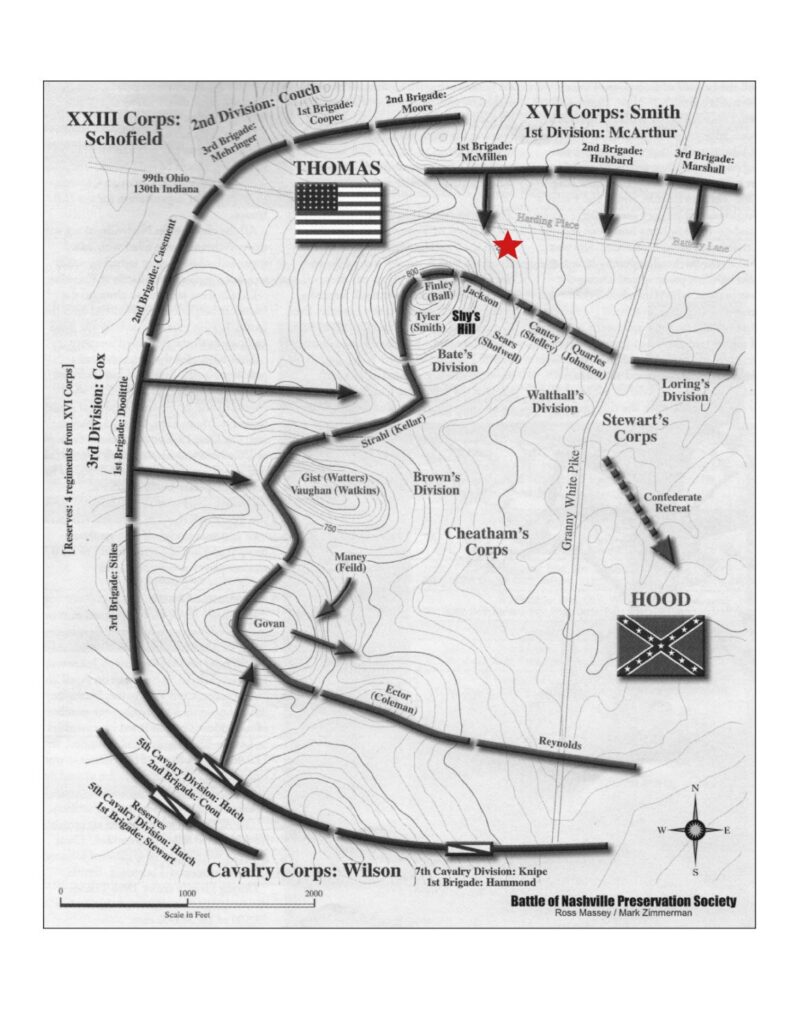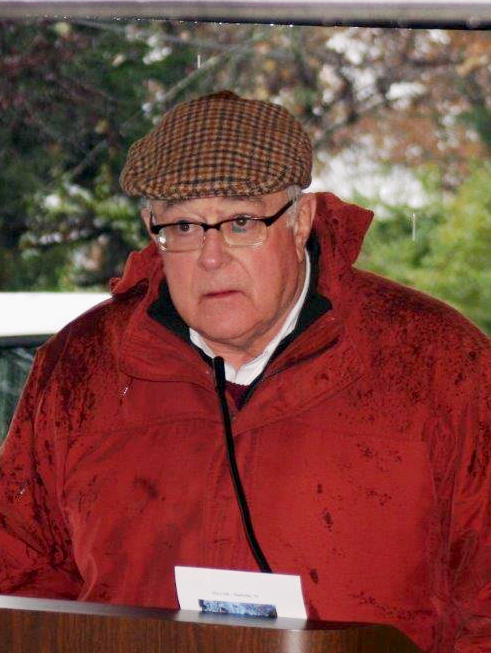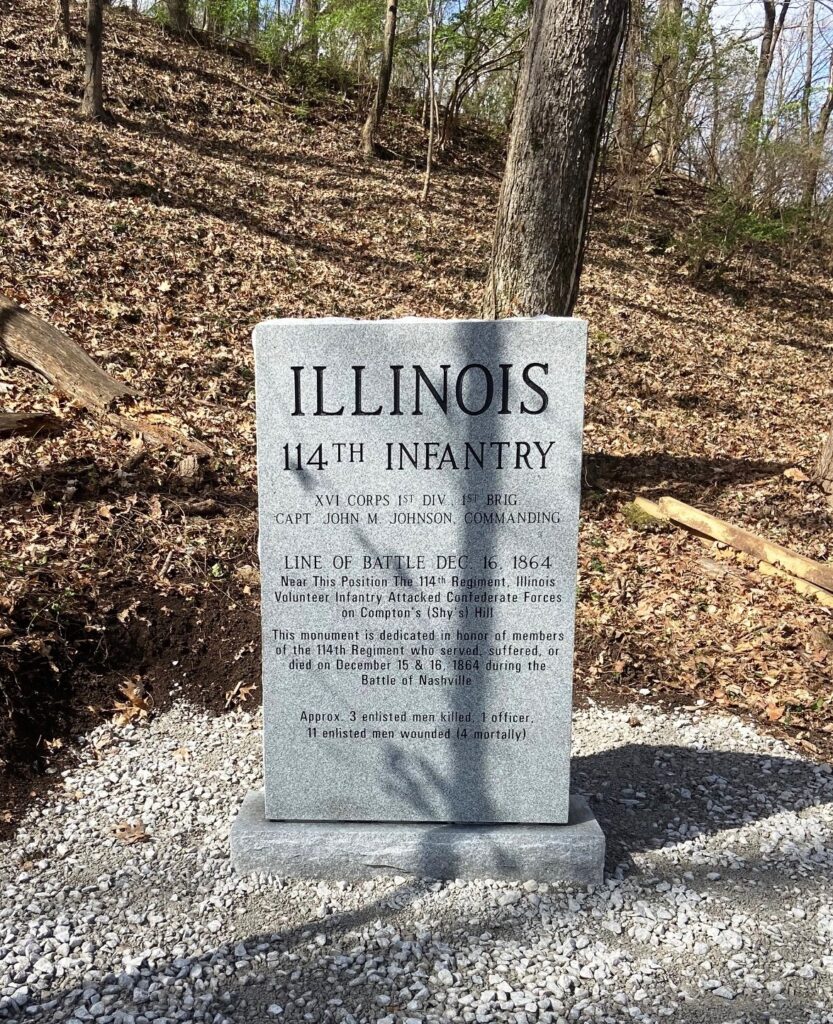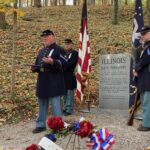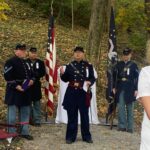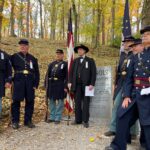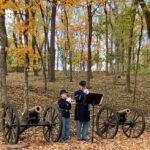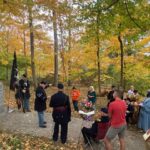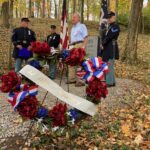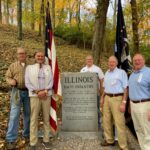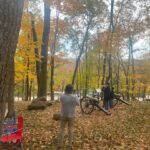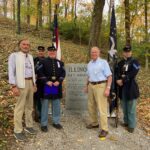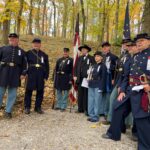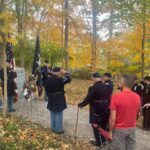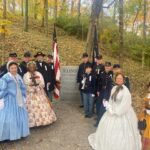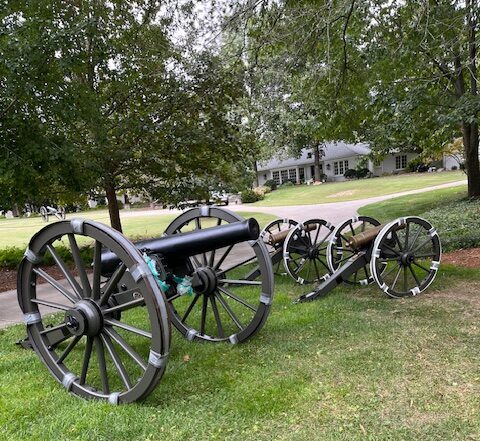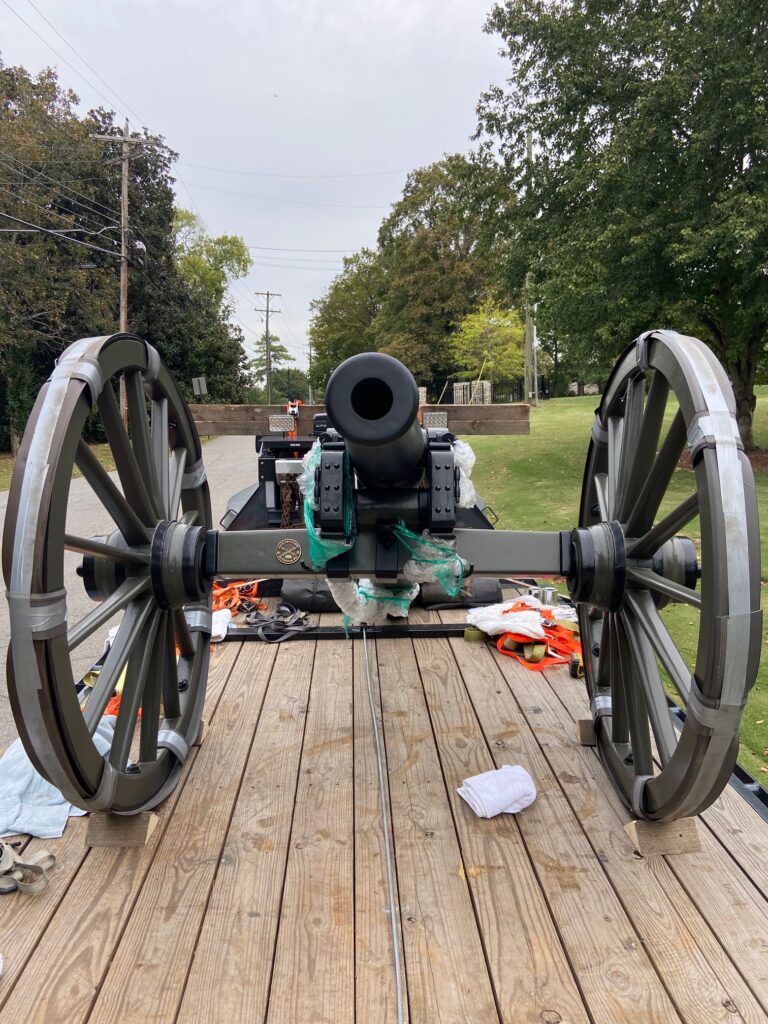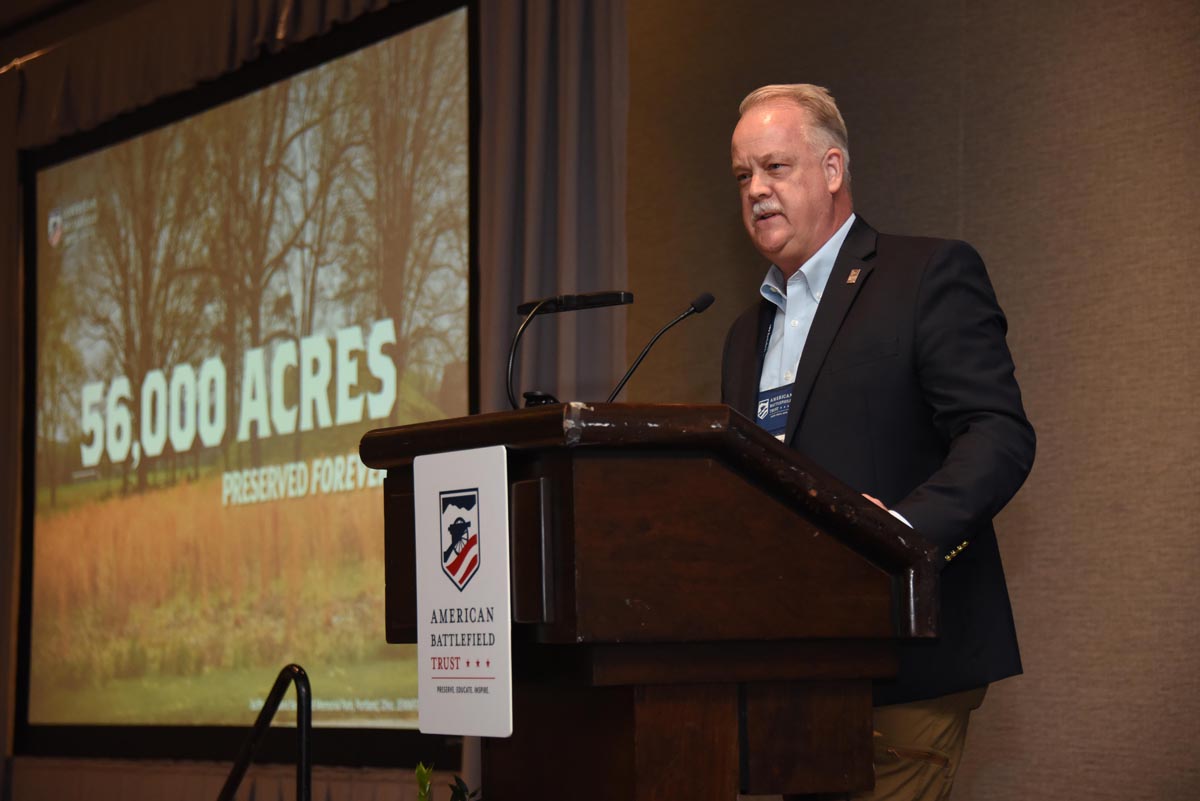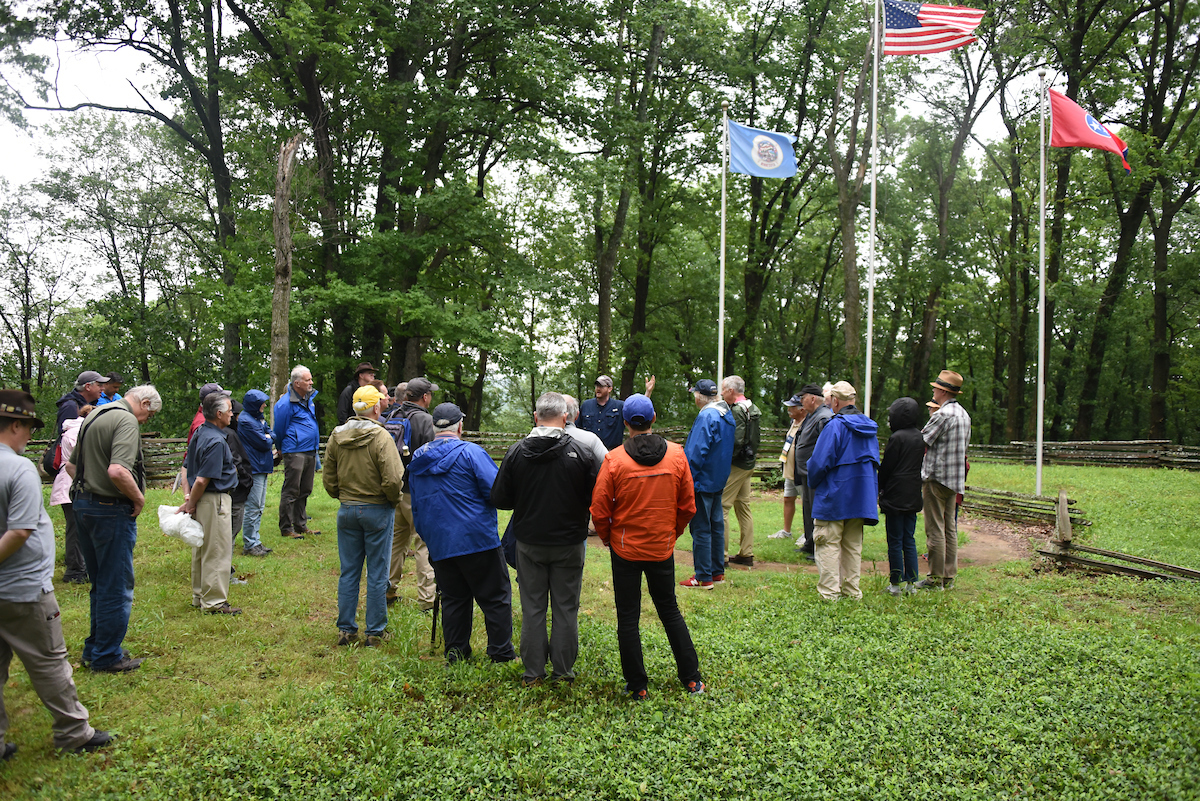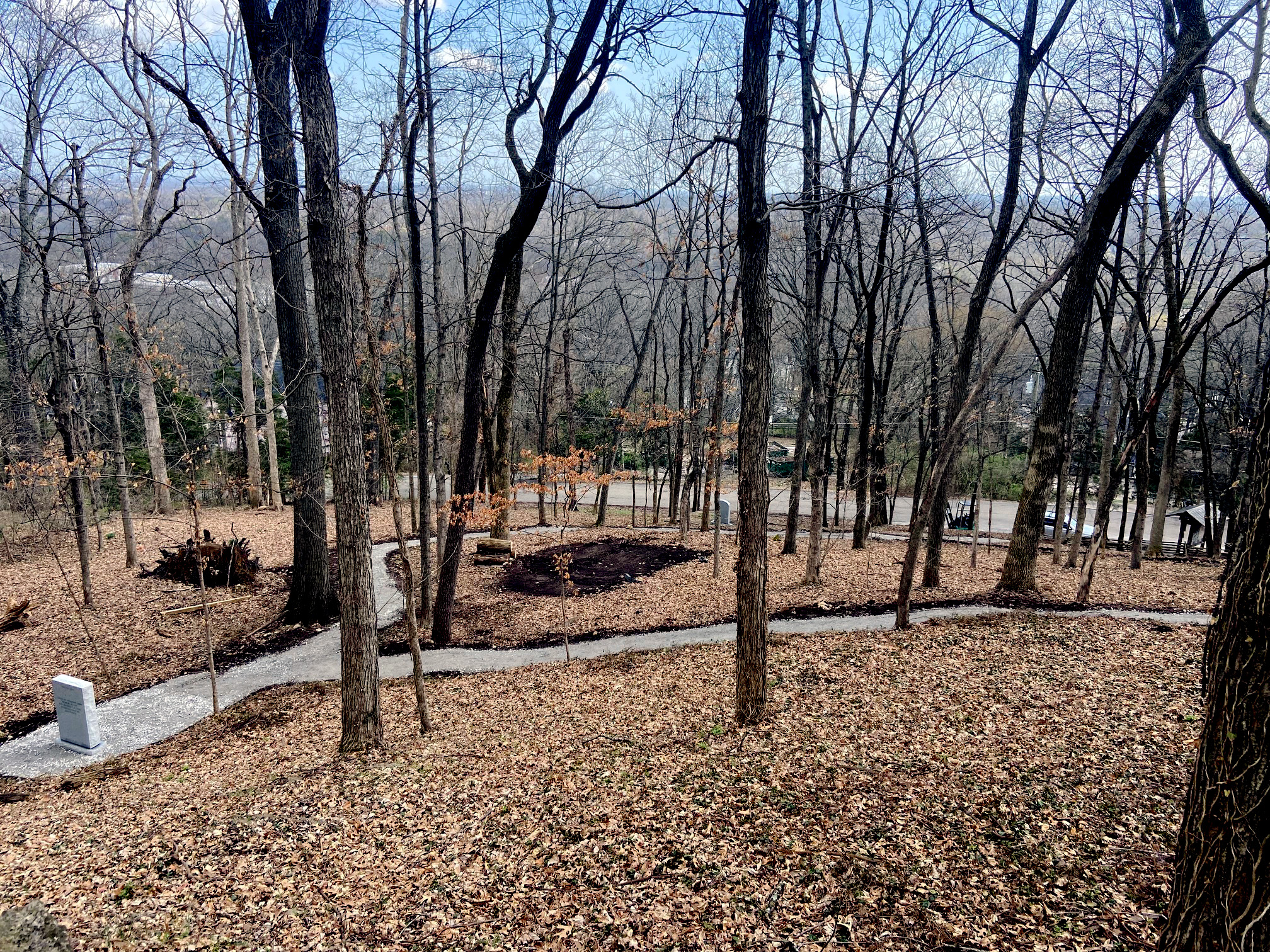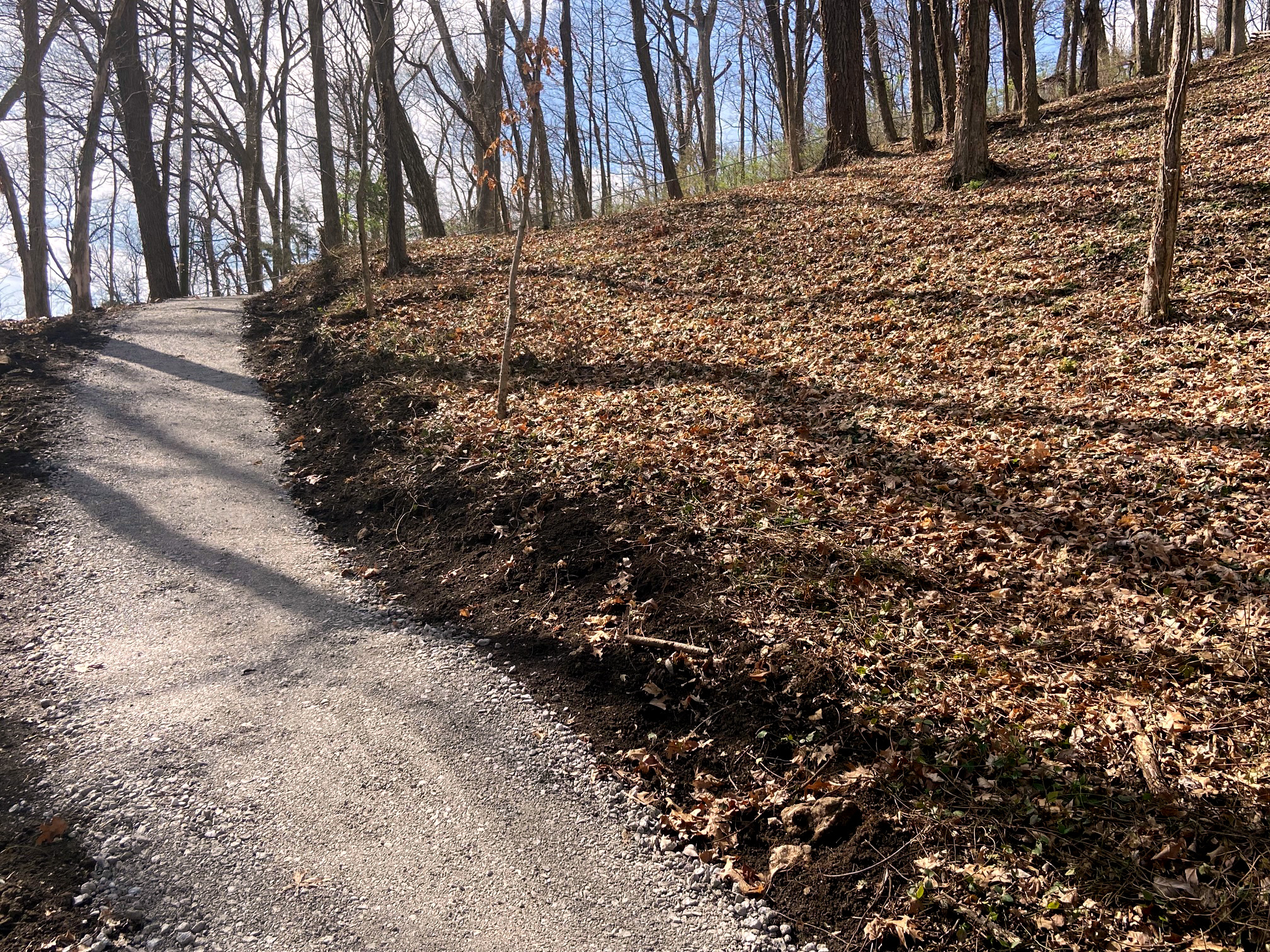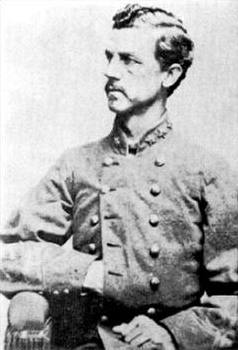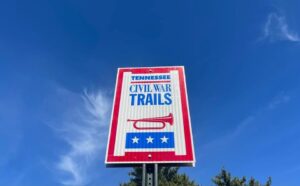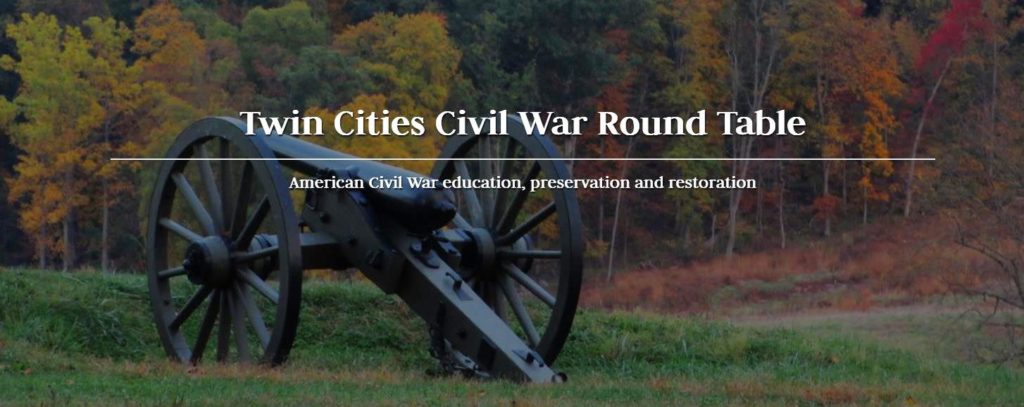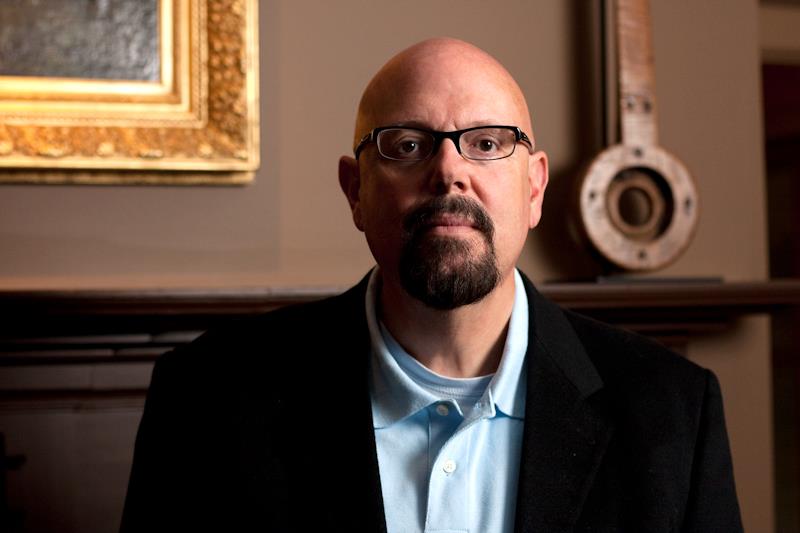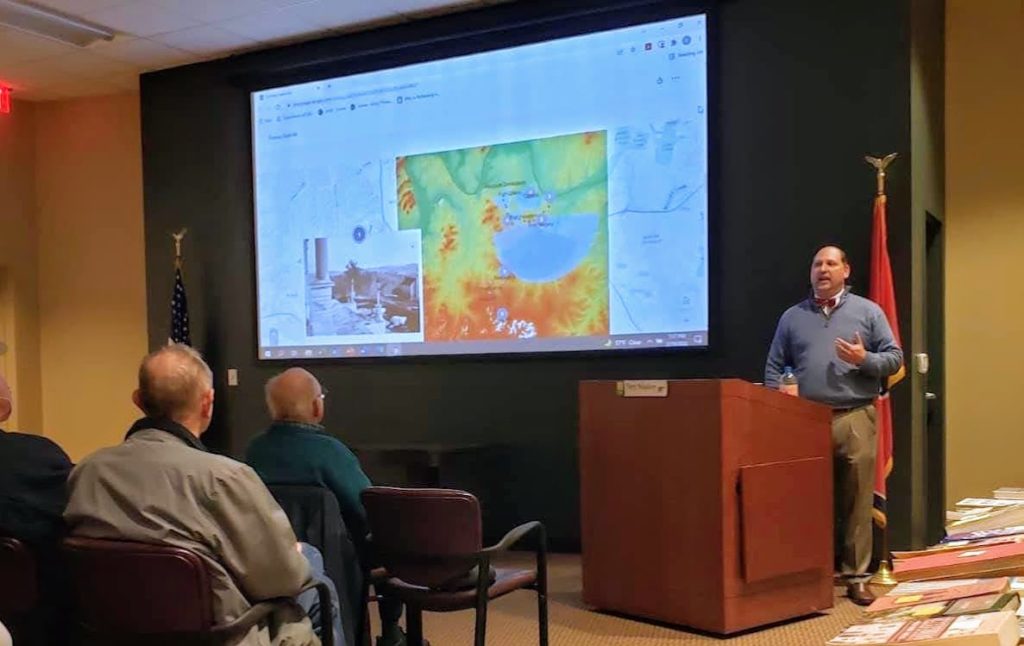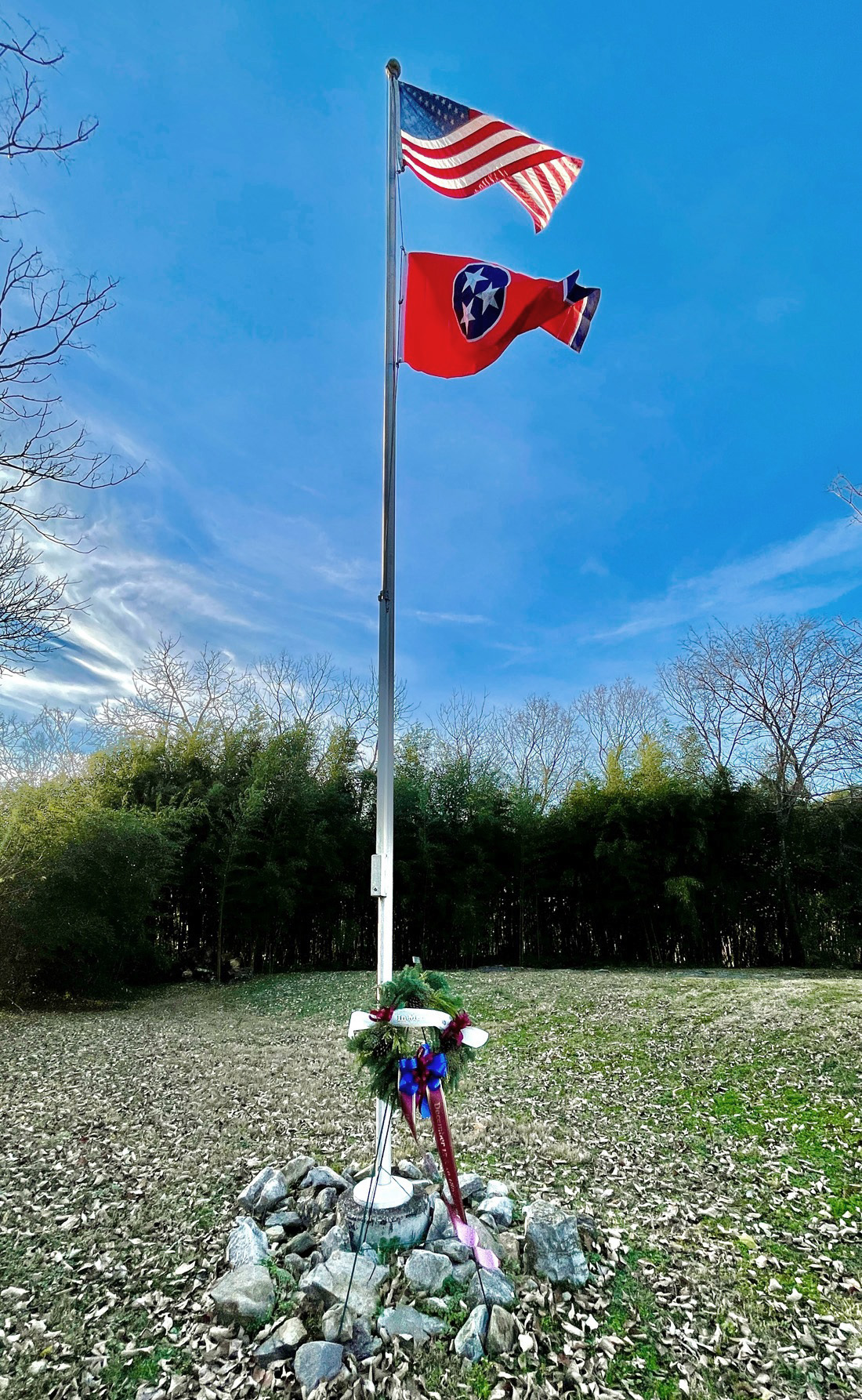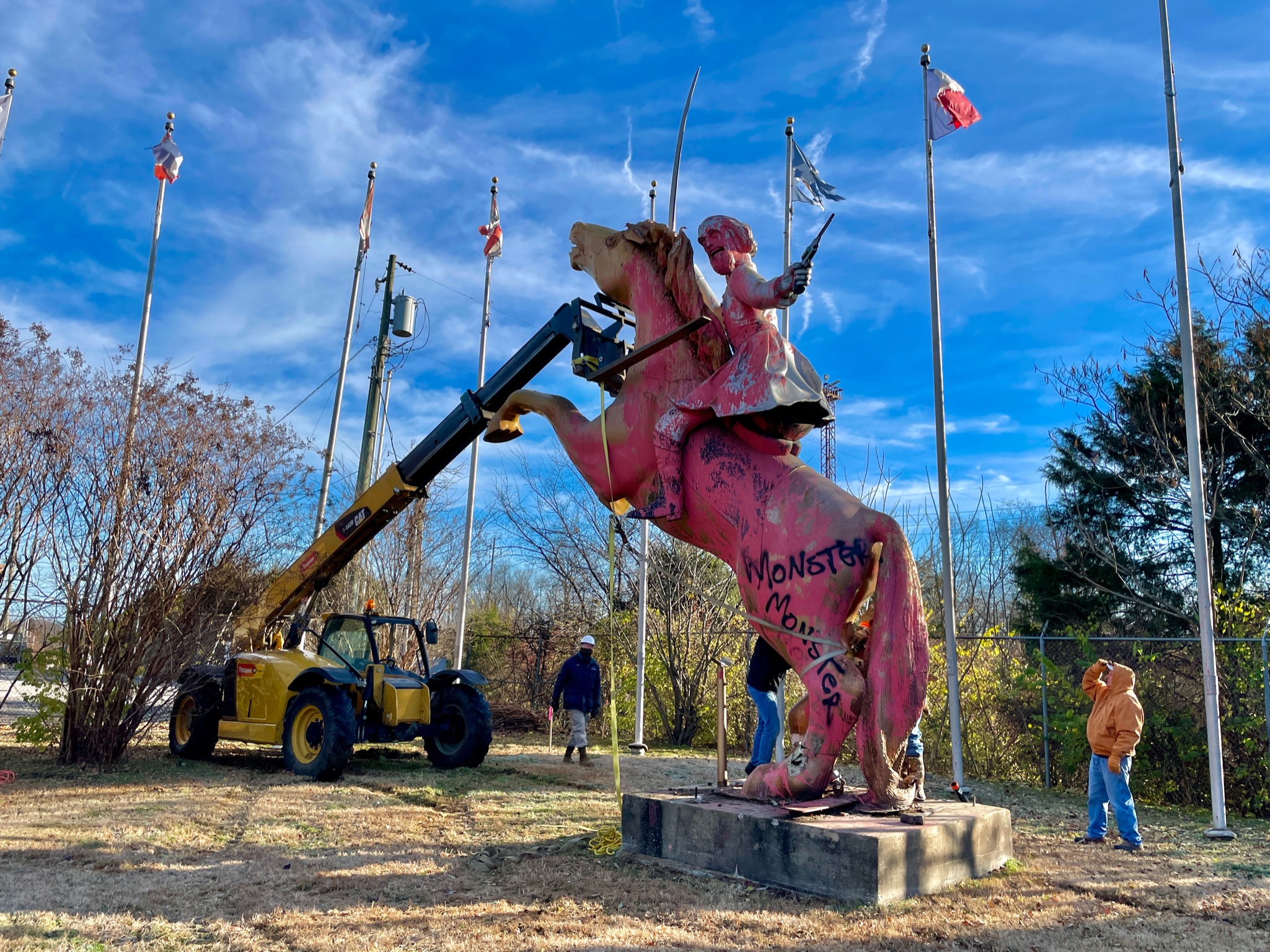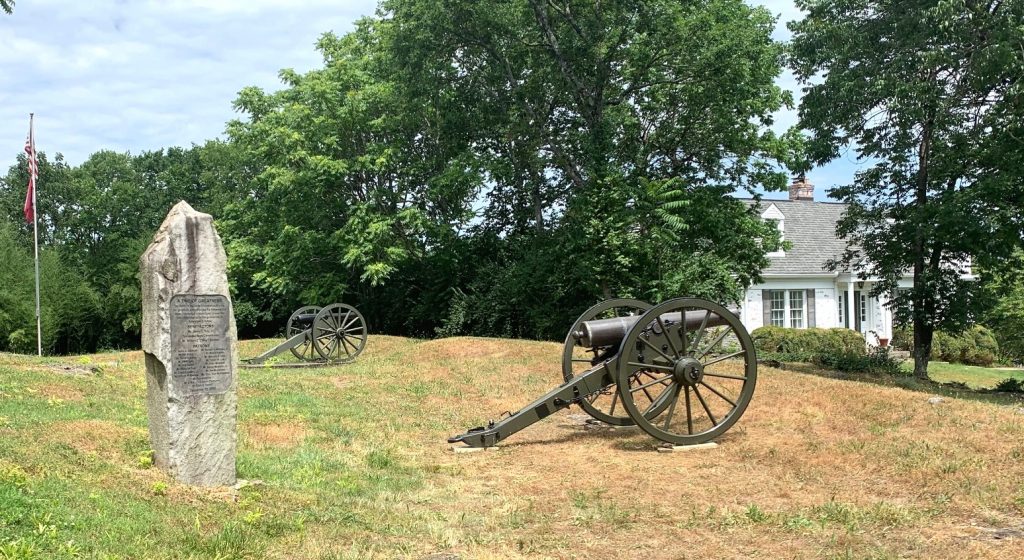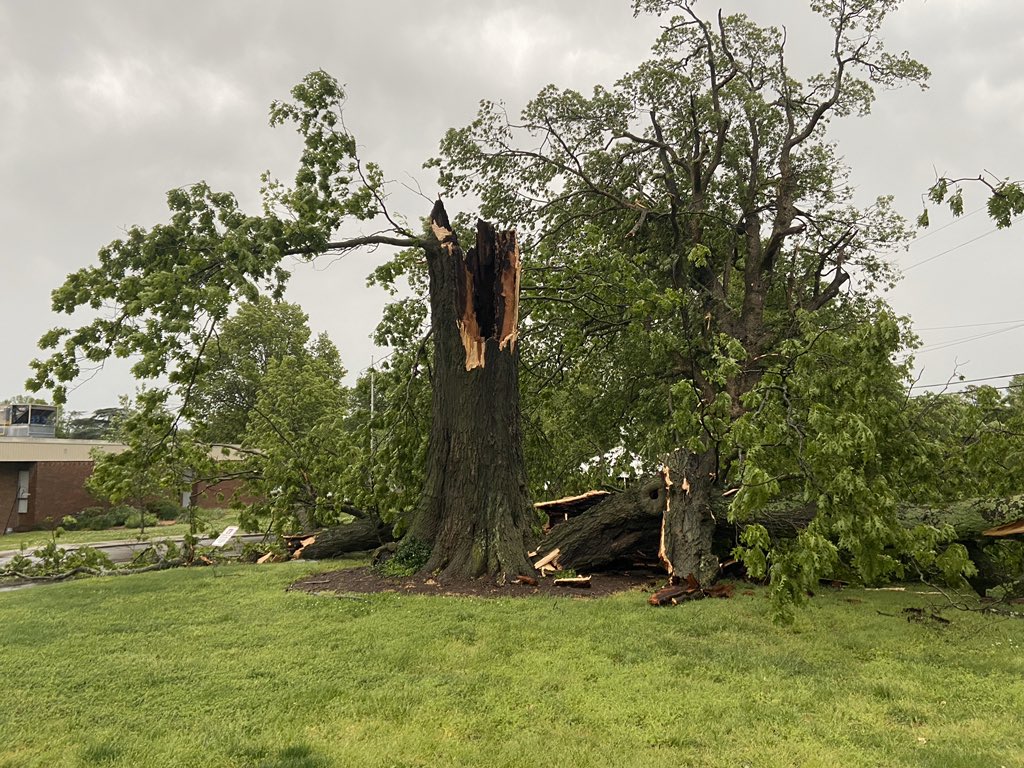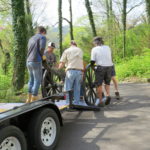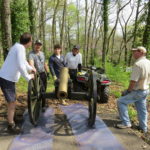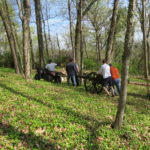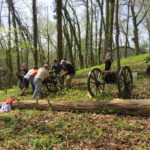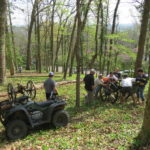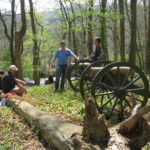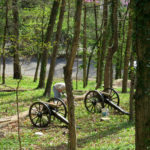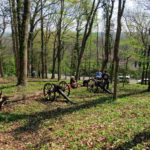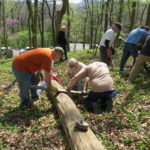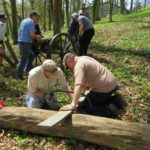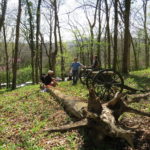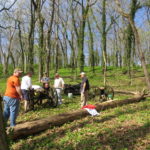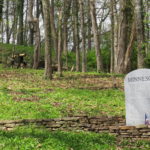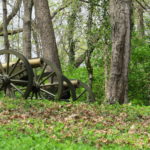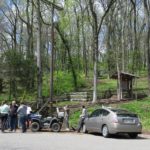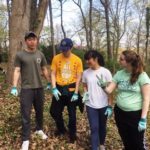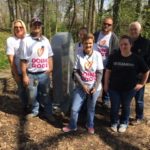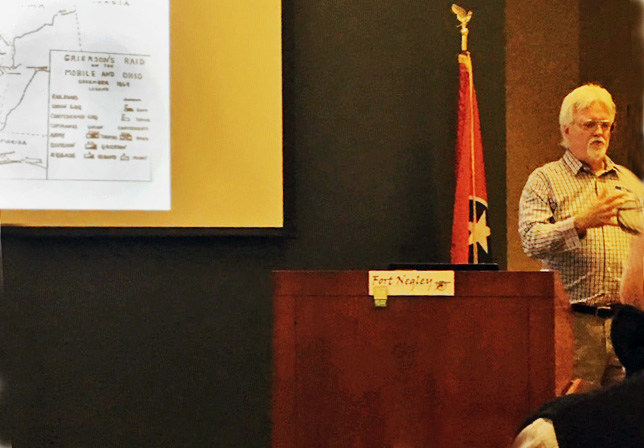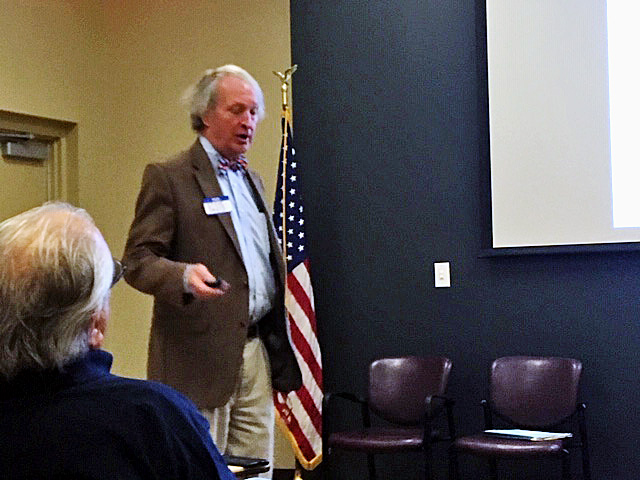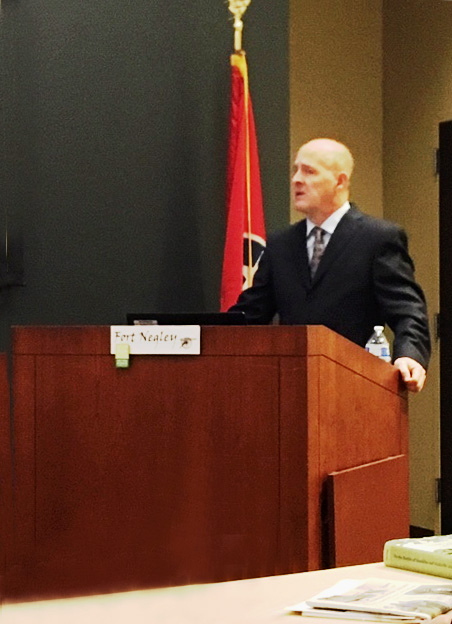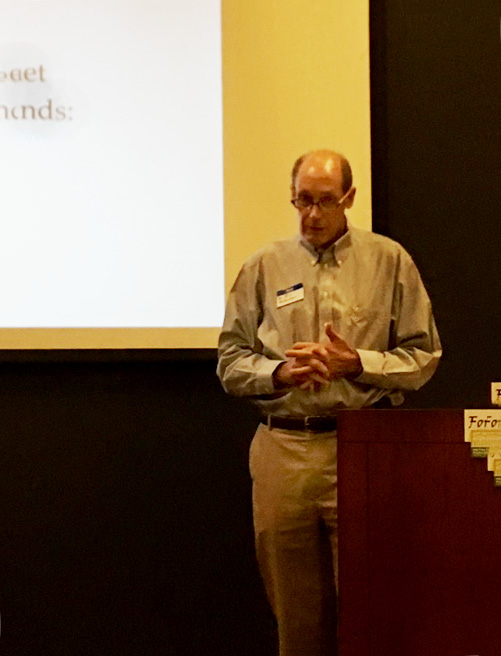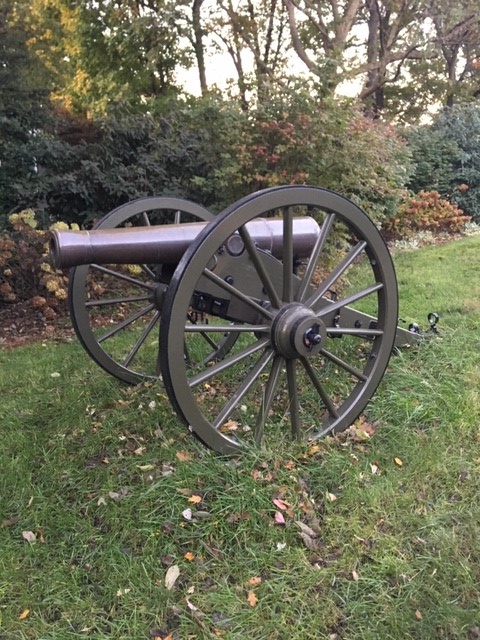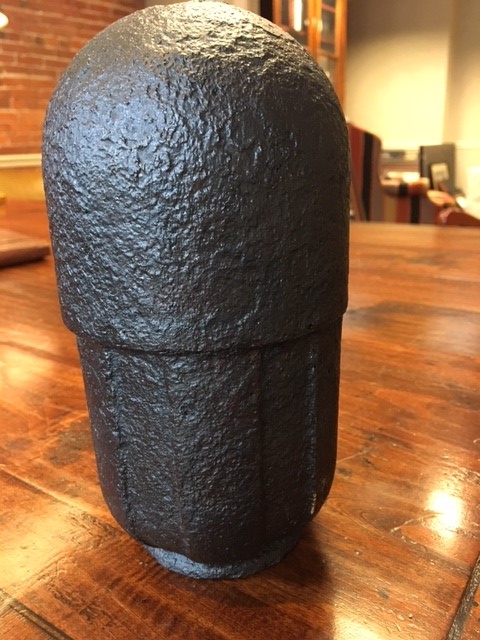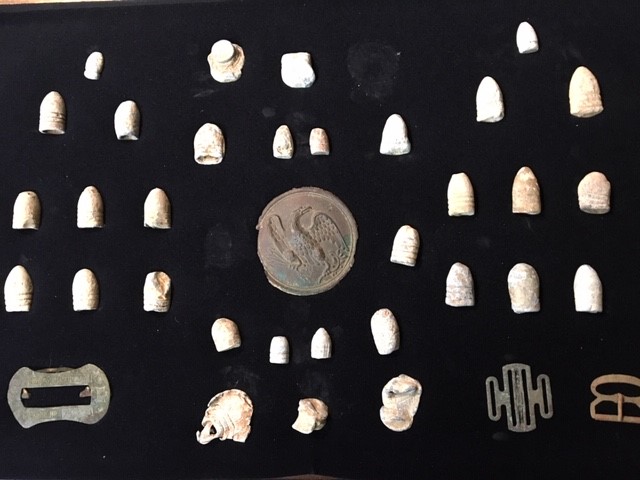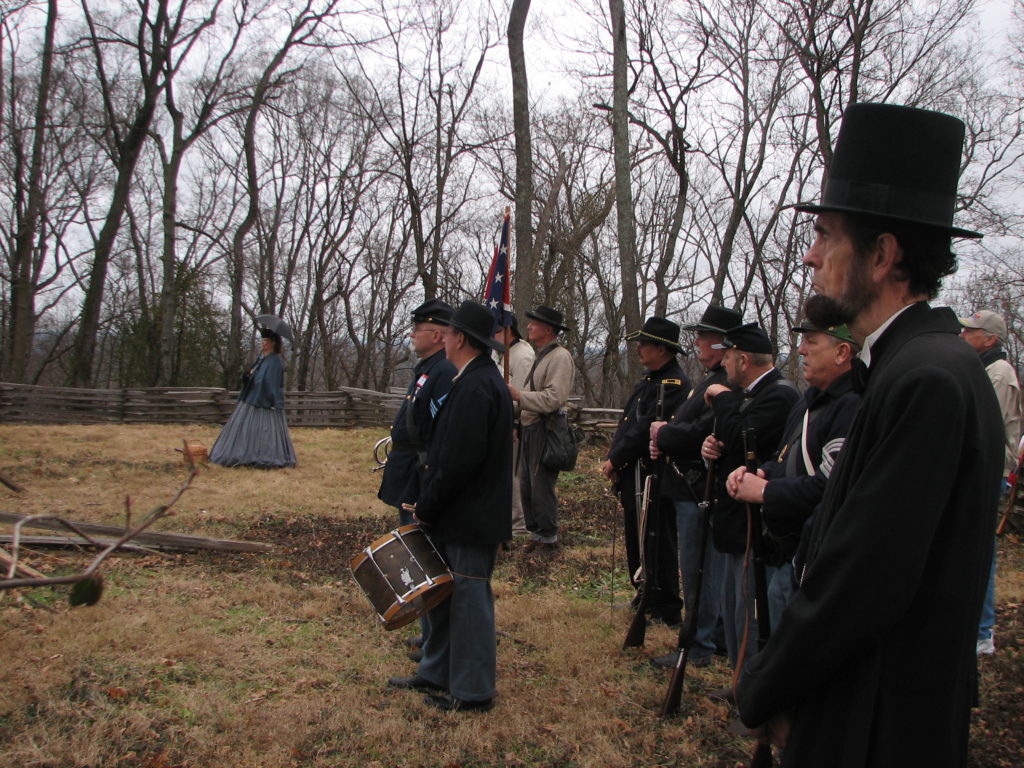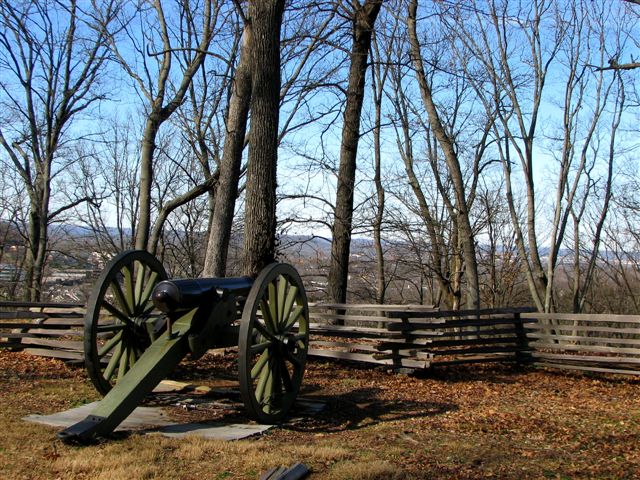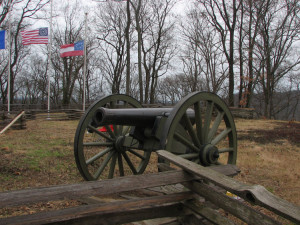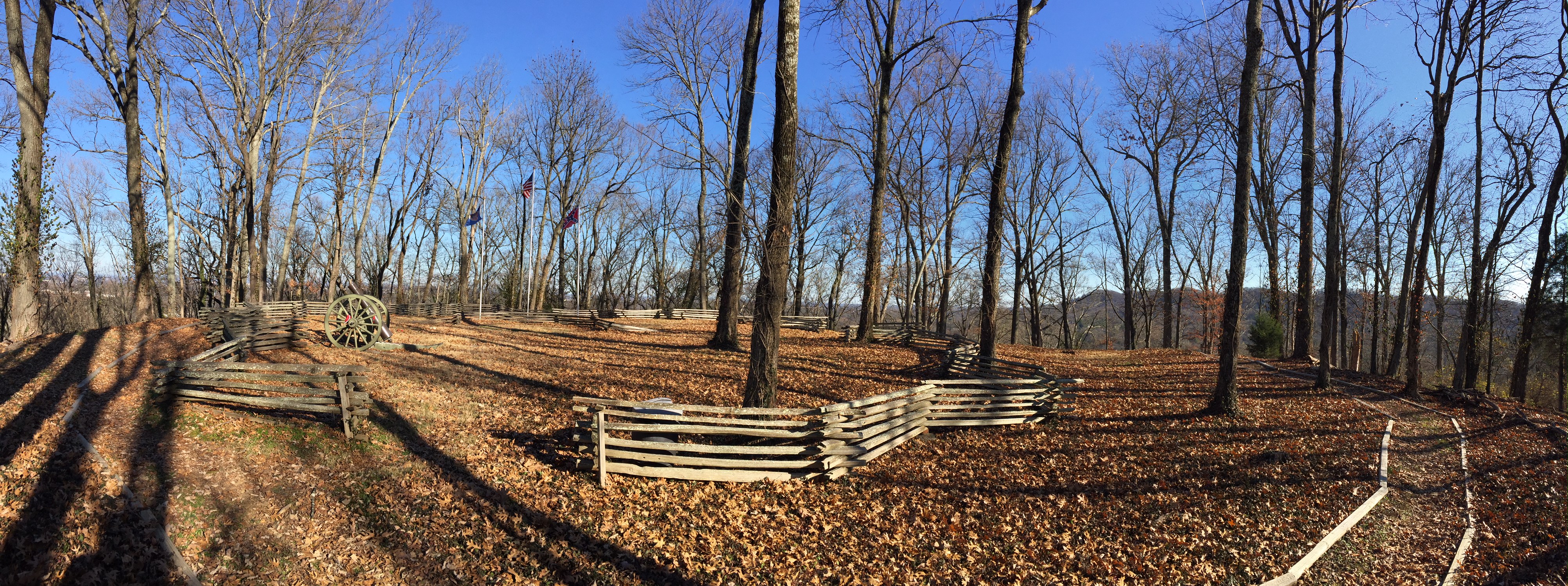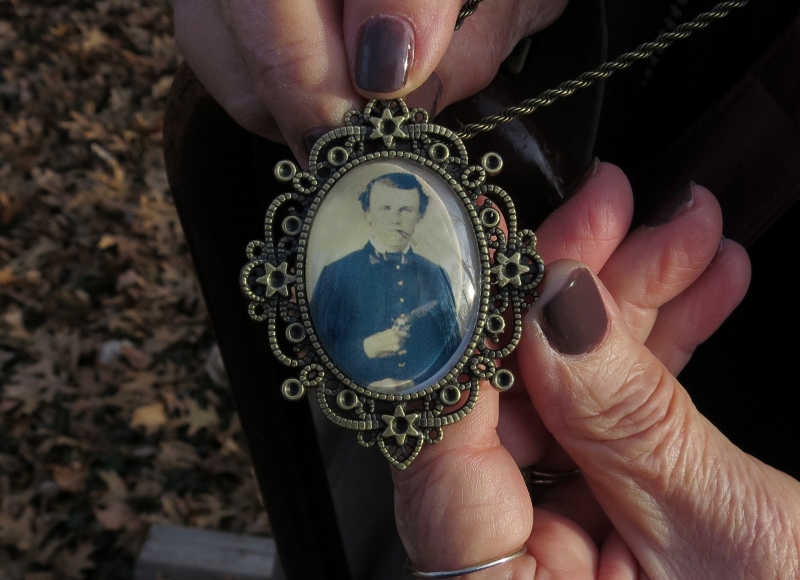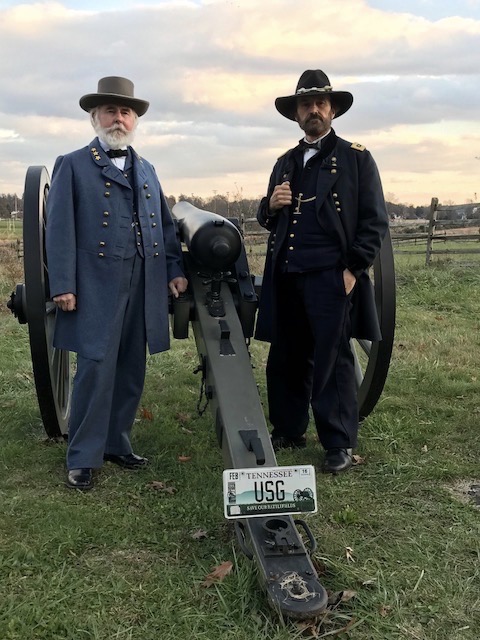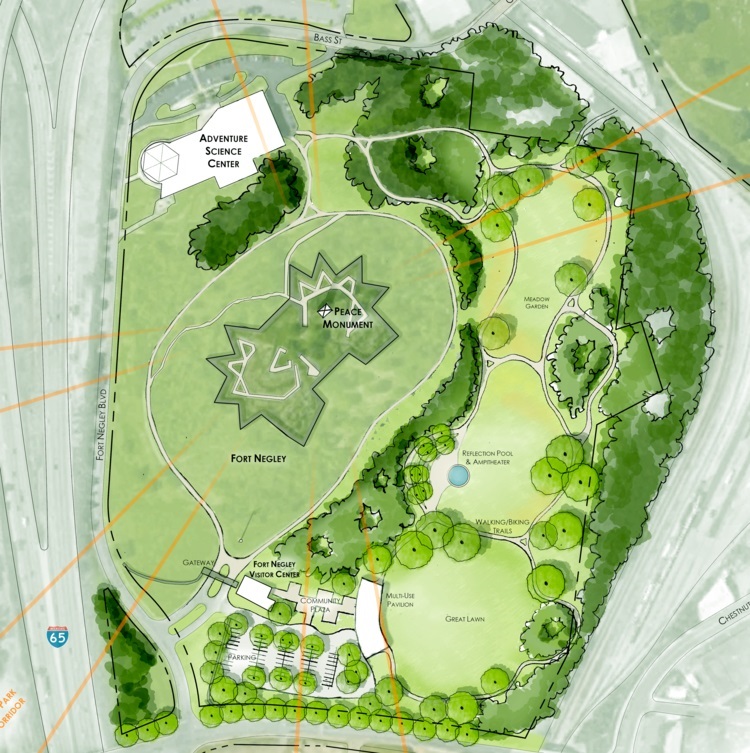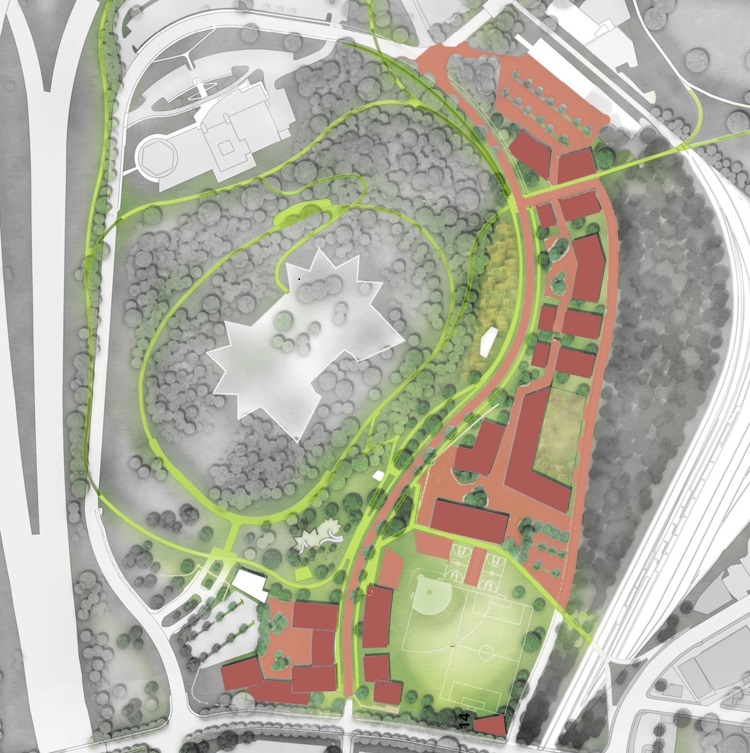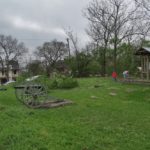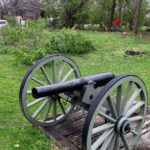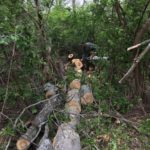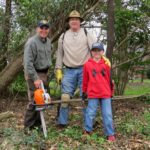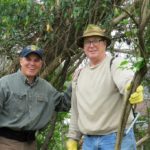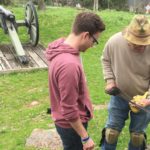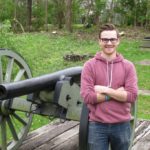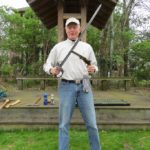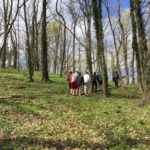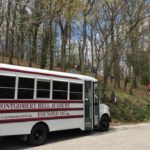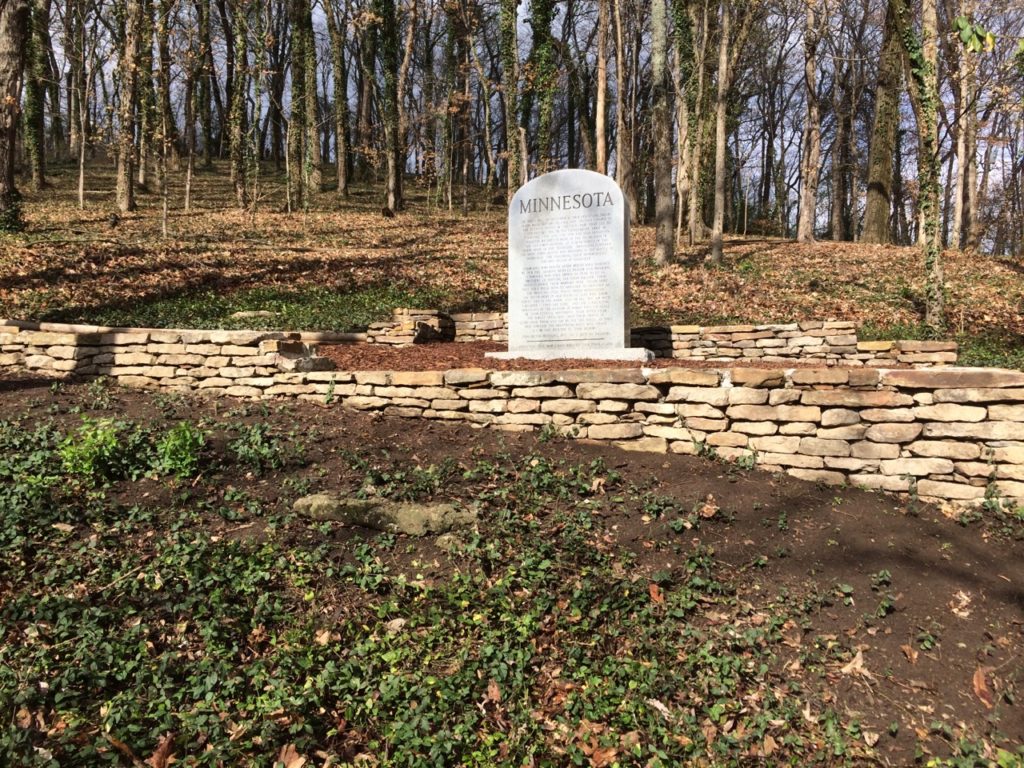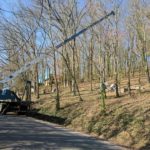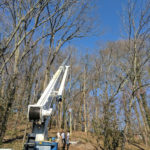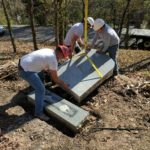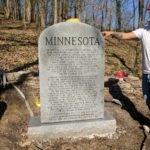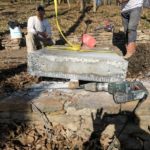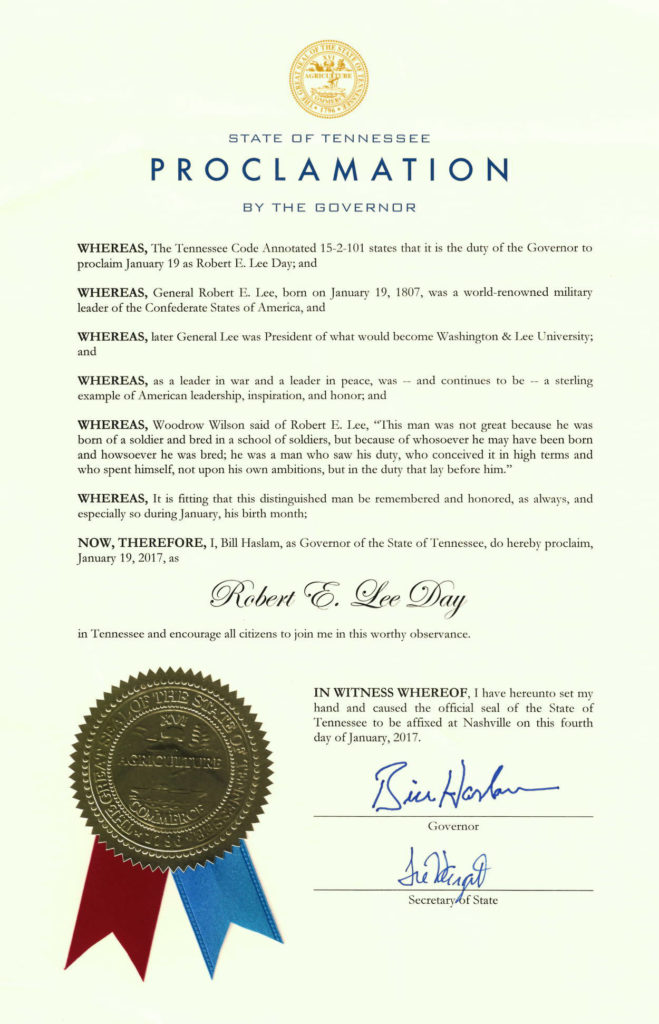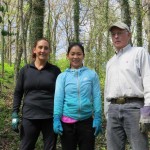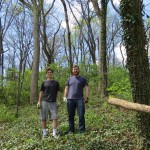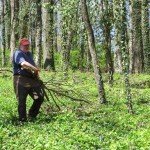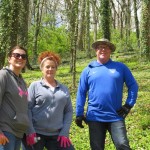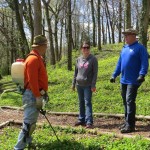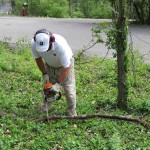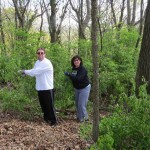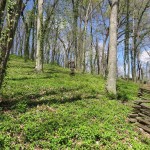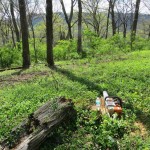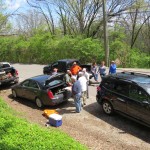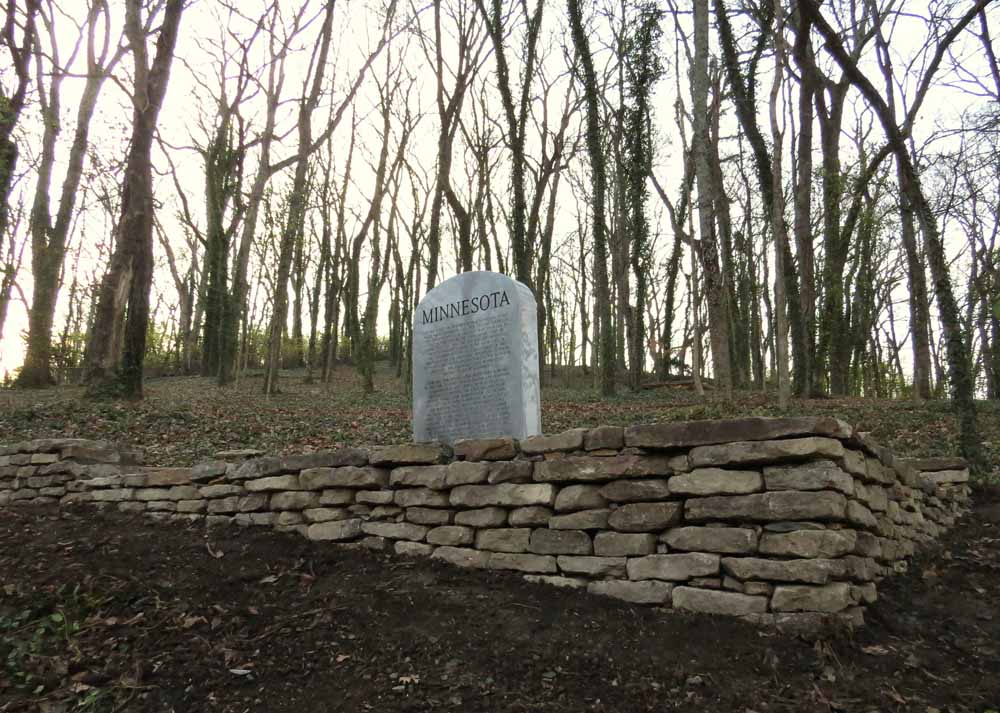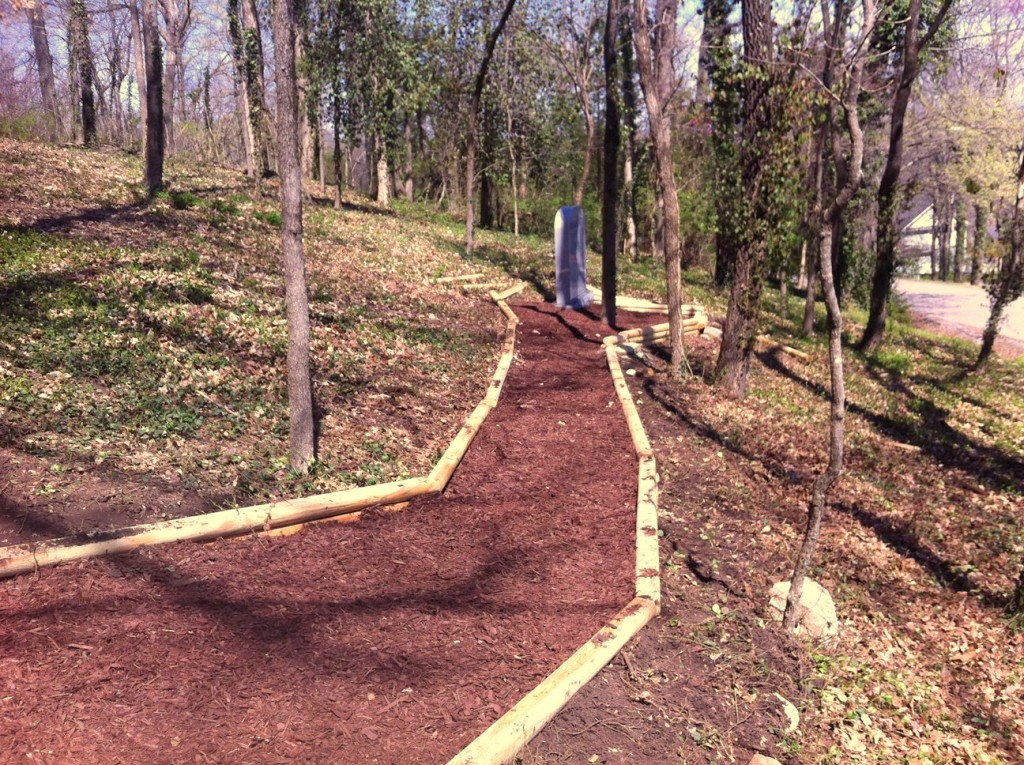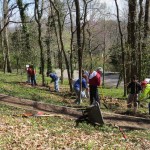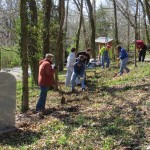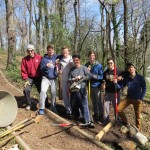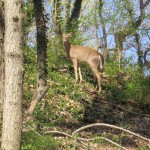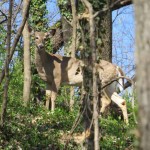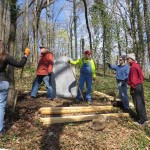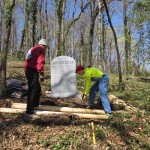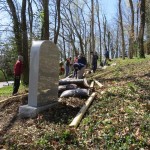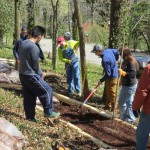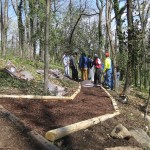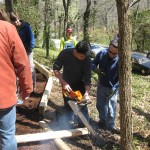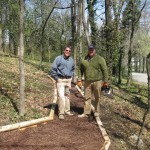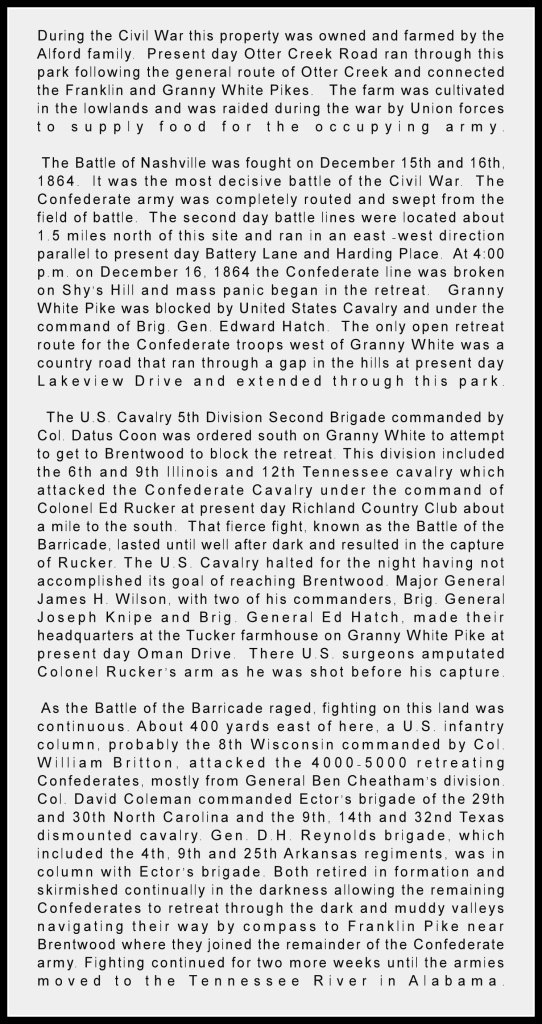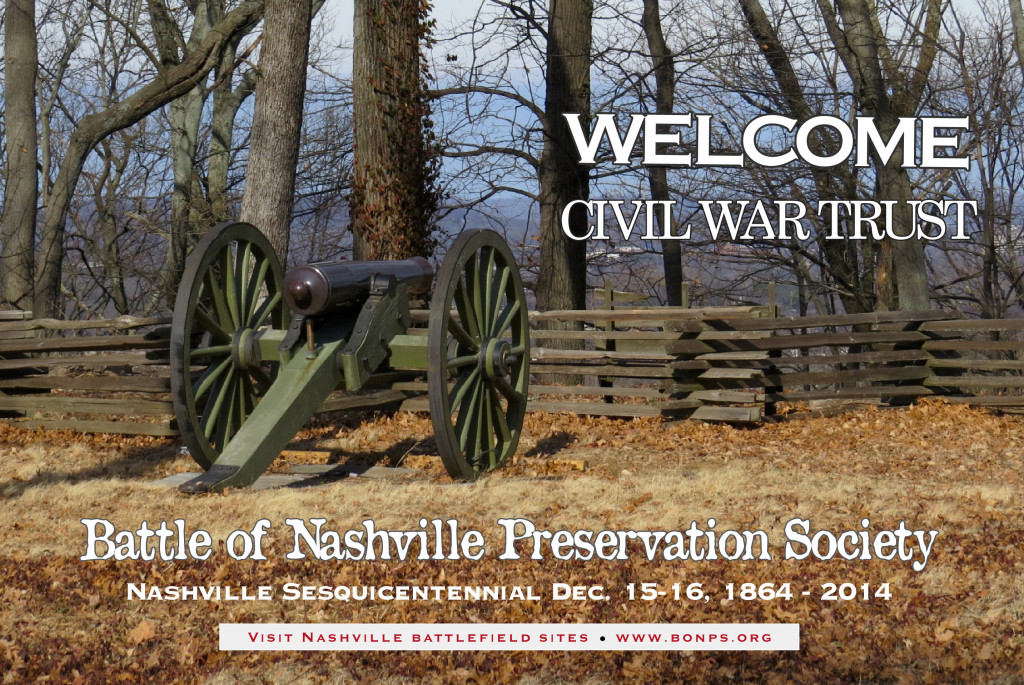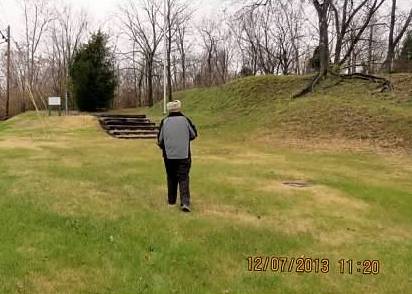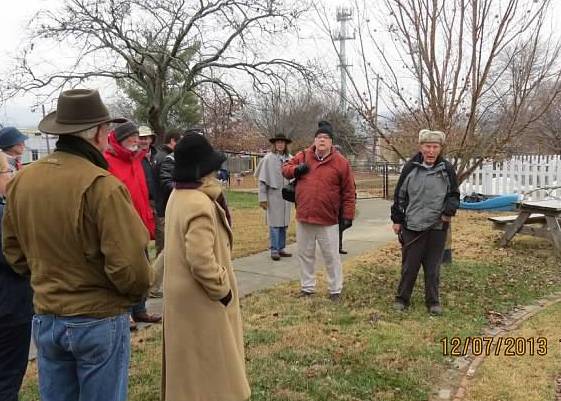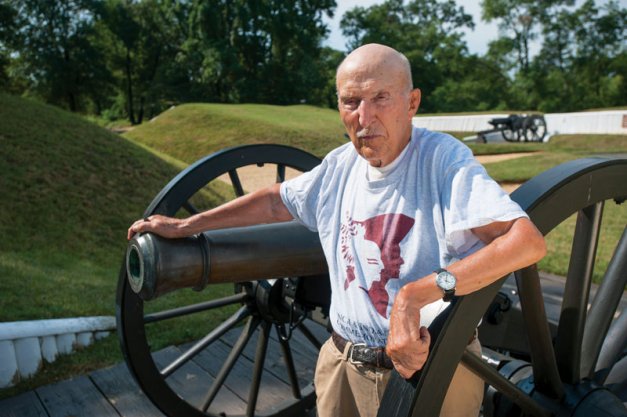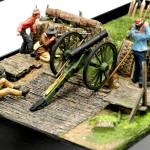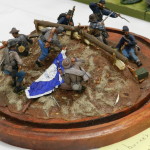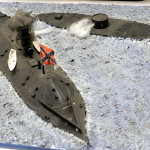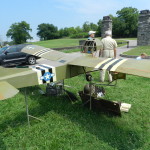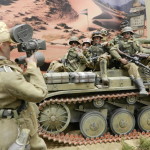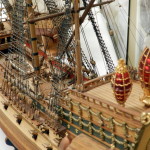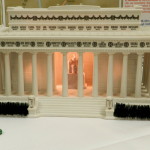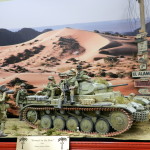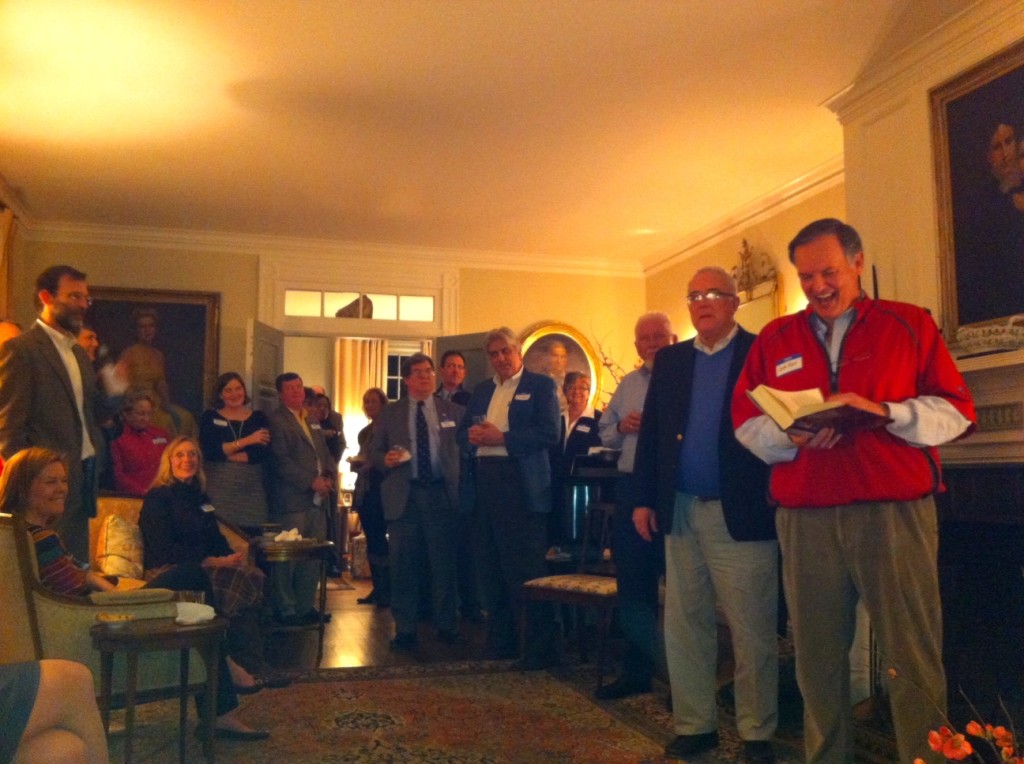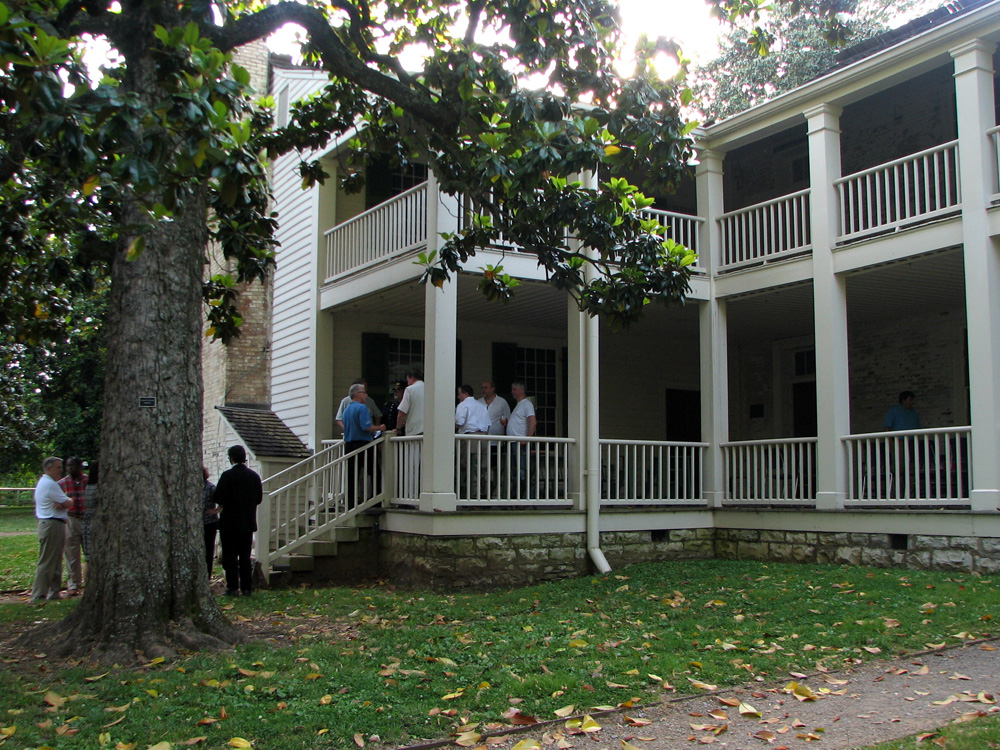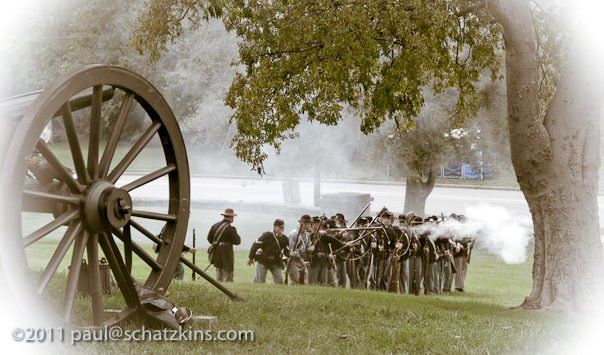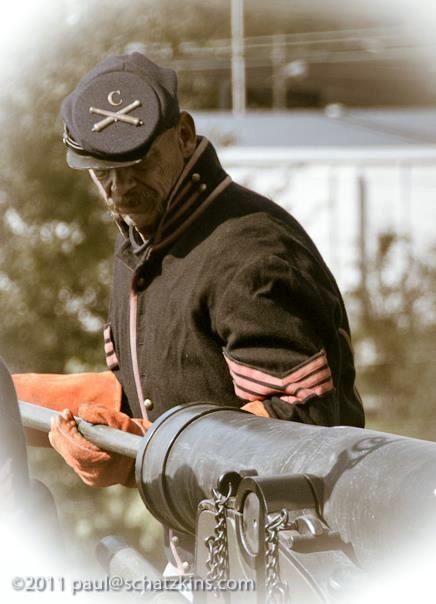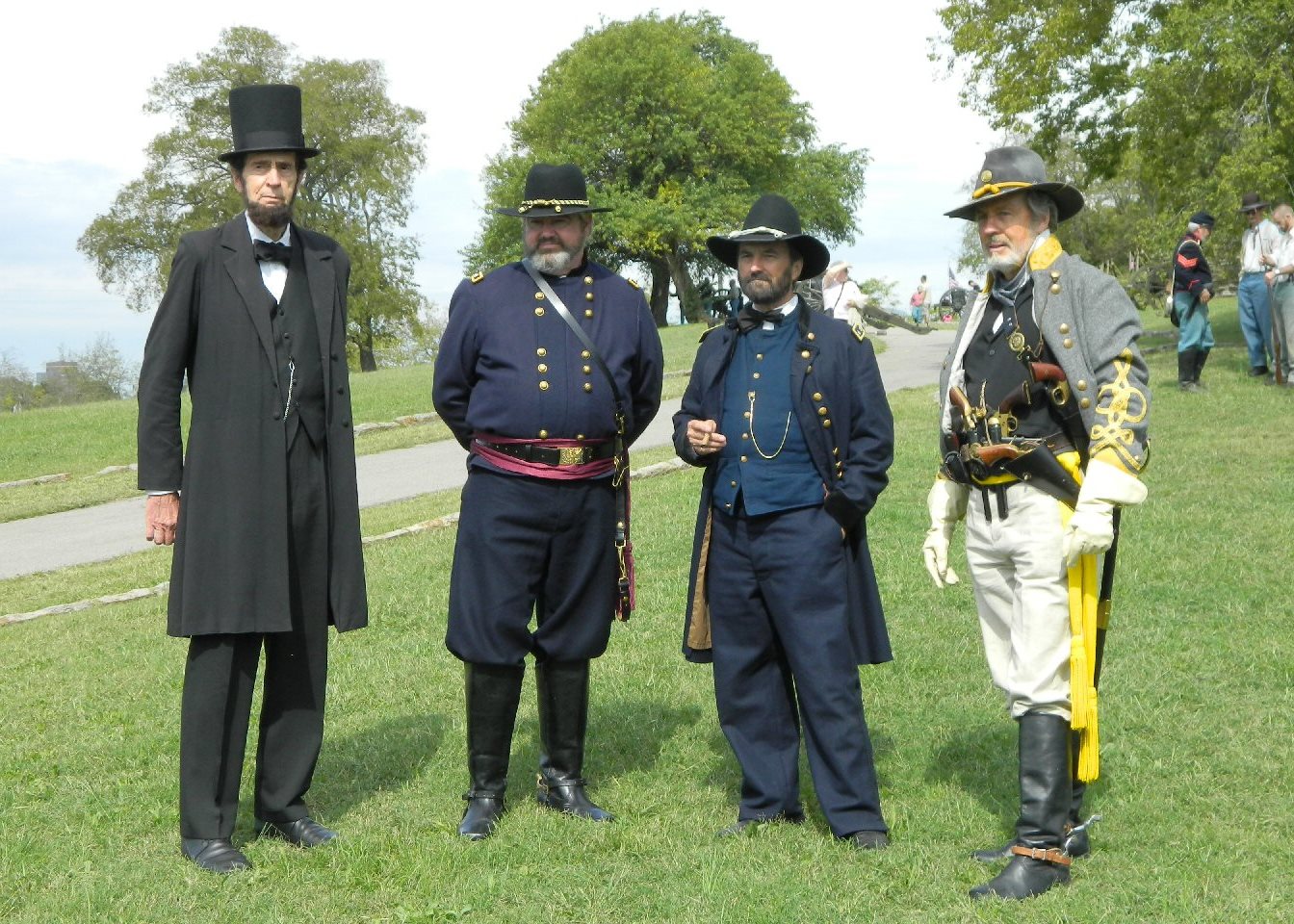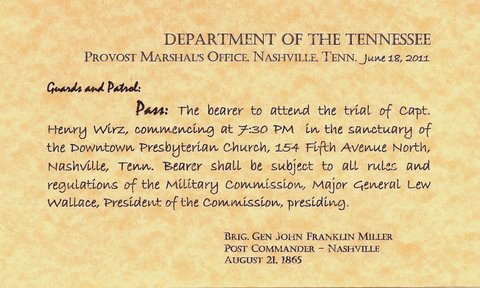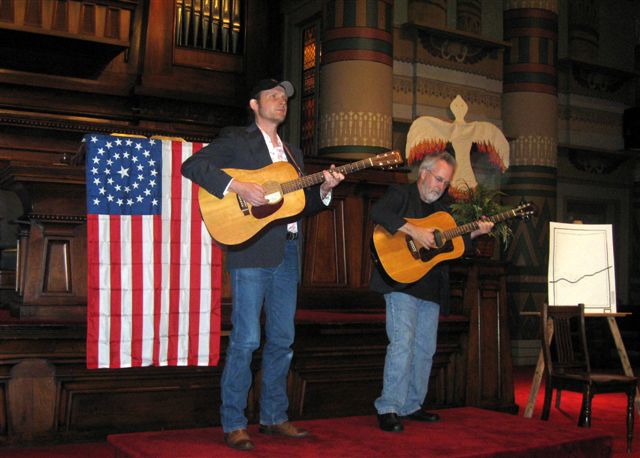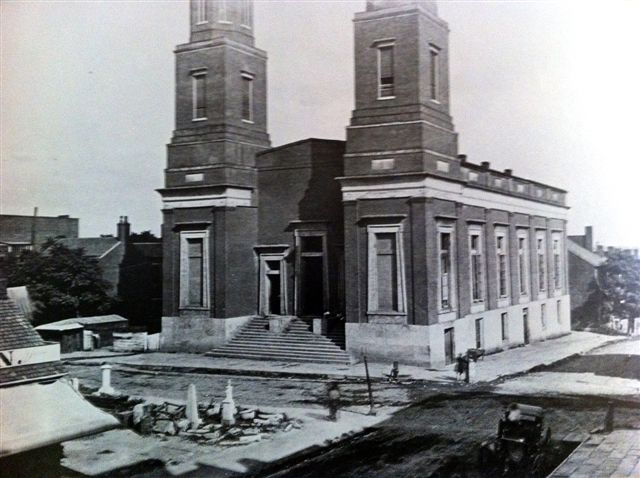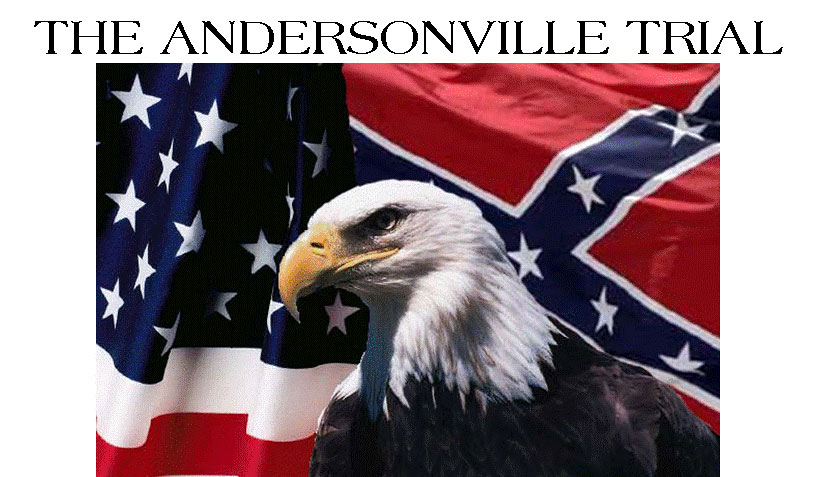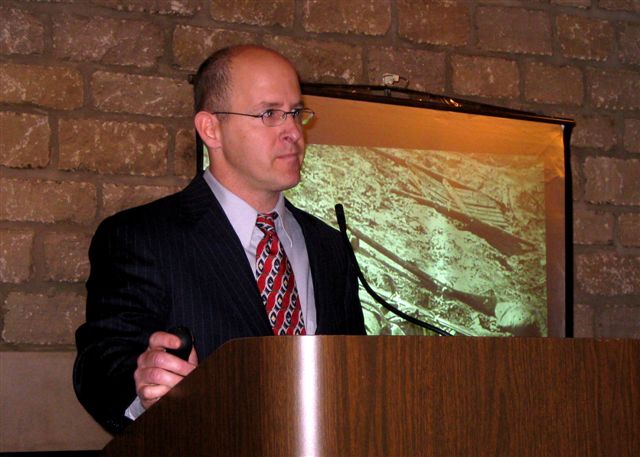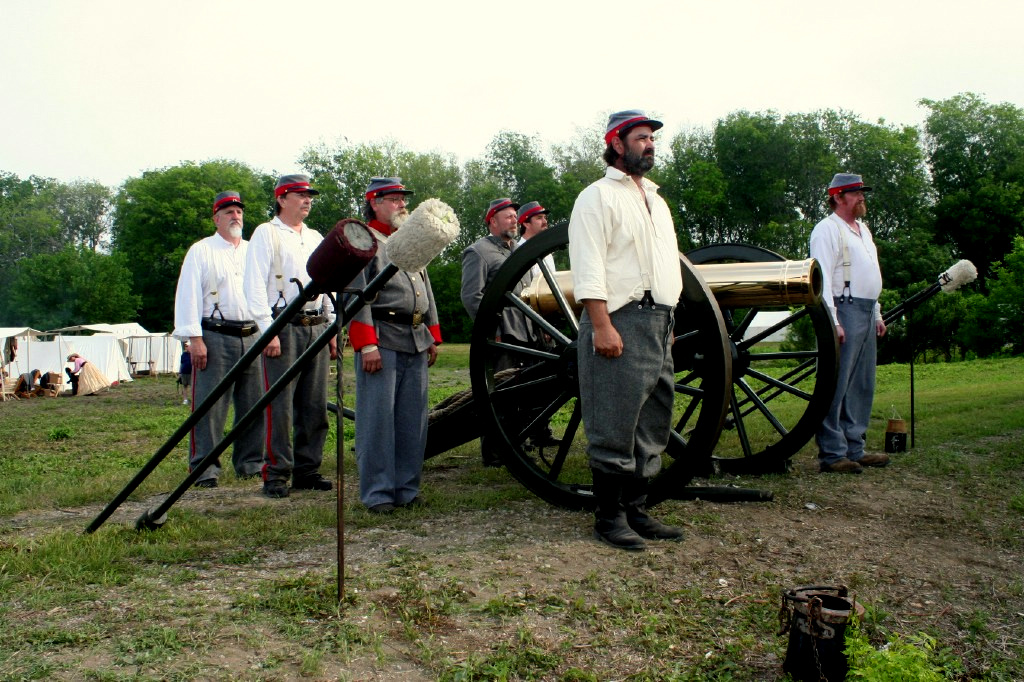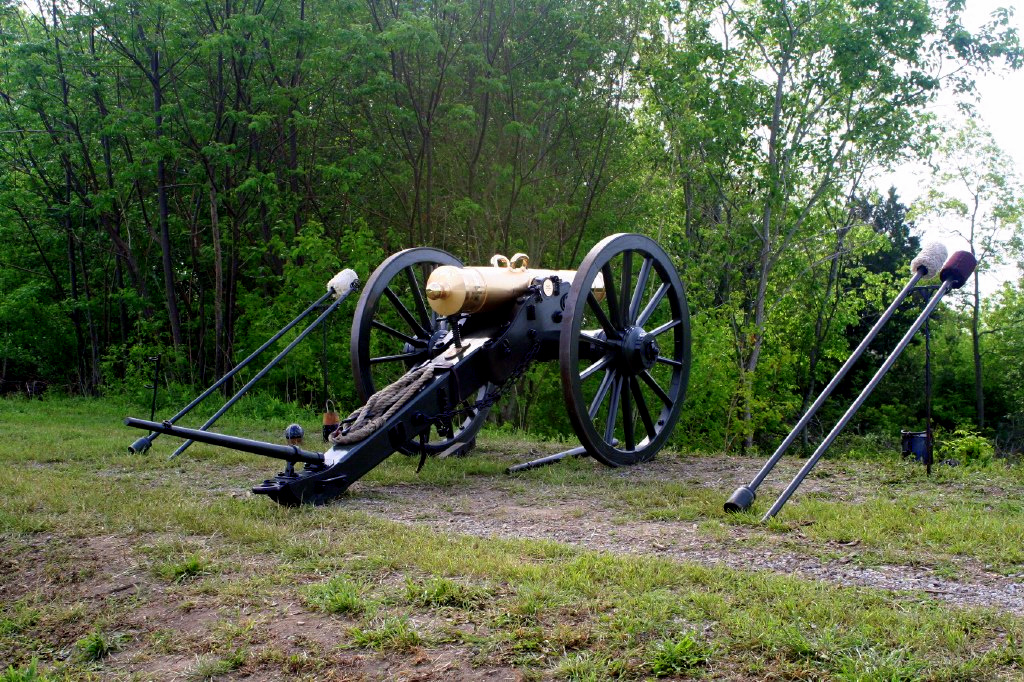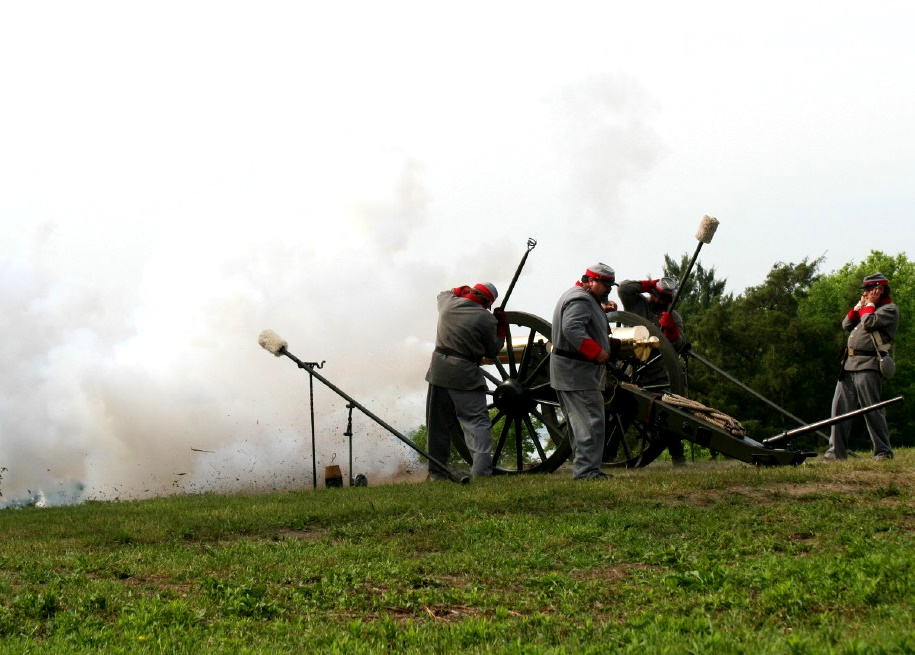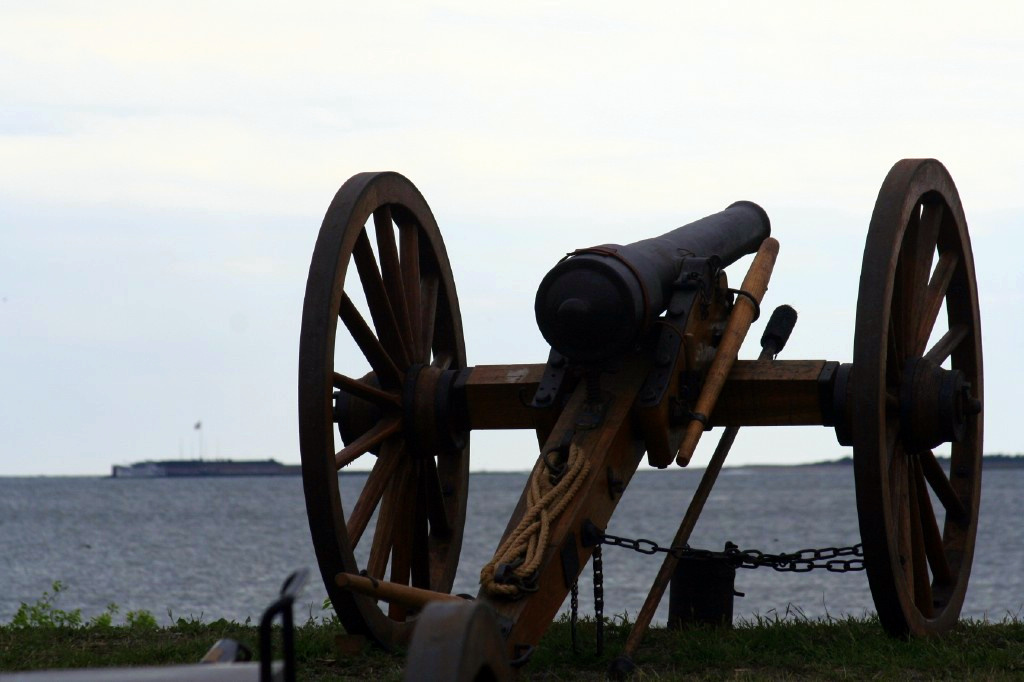BATTLE OF NASHVILLE TRUST NEWSLETTERS
BONT Newsletter, December, 2021
BONT Newsletter, December, 2022
April, 2024
BATTLE OF NASHVILLE TRUST ACQUIRES NEW BATTLEFIELD GROUND, ADDING TO SHY’S HILL PRESERVATION
An unexpected set of virtually “undreamed of” circumstances has come together to enable The Battle of Nashville Trust (BONT) to acquire a historic tract of “core battlefield” property near the base of Shy’s Hill on which Union soldiers attacked and died in the most decisive event of the Battle on Dec. 16, 1864.
The property consists of a vacant residential lot located at the corner of Harding Place and Benton Smith Road and was featured in the background of the famous painting of the Battle of Nashville by Minnesota artist Howard Pyle. It was this 1.2 acre ground over which Federal troops attacked Confederate forces occupying the summit of Shy’s Hill on the second day of the battle, routing Hood’s troops and permanently disabling the Confederacy’s military capability in the western theater of the Civil War.
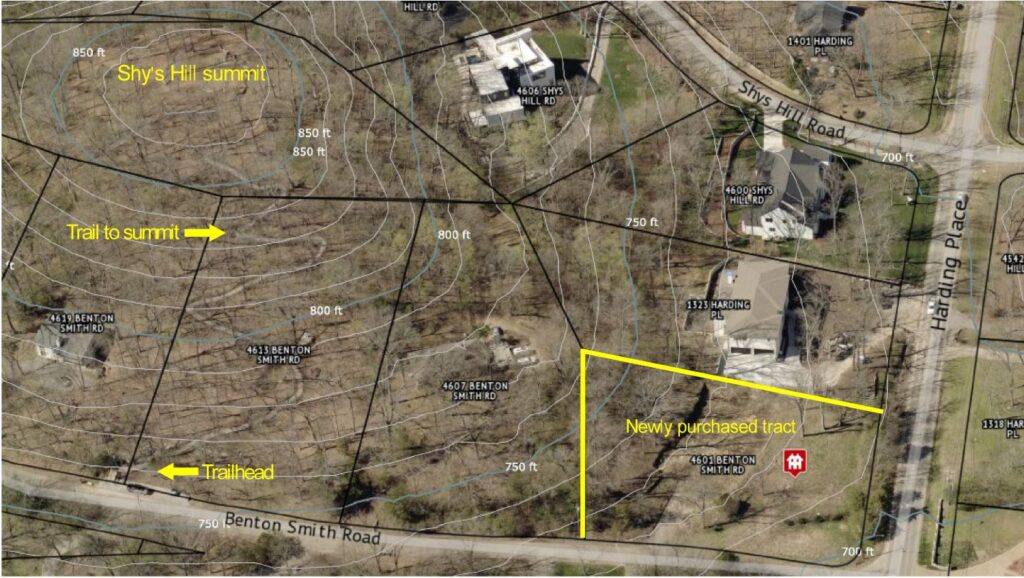
Aerial view of Shy’s Hill, showing newly-acquired core battlefield land at the corner of Benton Smith Road and Harding Place. Only a single residential lot separates it from BONT’s 3.5 acre battlefield site. Click image to enlarge.
Bill Ozier, President of BONT, stated that the Trust “never dreamed that it would be able to purchase” the historic ground because of its location in a prime area of an affluent residential development. However, several factors came together to make the purchase unexpectedly possible: in 2021, BONT became the beneficiary of a wealthy donor’s estate; then in 2023, a drop-off in Nashville’s hot residential real estate market at the end of last year prompted a developer to sell the parcel rather than build on it; and finally, BONT successfully worked with and was assisted by The American Battlefield Trust (ABT), a national preservation non-profit which works to acquire and preserve American battlefields across the country.
When those factors converged in early 2024, BONT’s Board determined that the acquisition was too historically important to pass up, and put together funds to purchase the tract at what amounted to its appraised value of $1,175,000 with the assistance of the ABT.
The tract is not immediately adjacent to, but only a short walk from, BONT’s Shy’s Hill historic site and trailhead. Plans are already underway by the BONT Board for improvements to the site, including clean-up, appropriate landscaping, future signage similar to that utilized on National battlefield parks, and potentially adding parking space.
The tract, located at 4601 Benton Smith Road, is the first acquisition of Nashville battlefield land for preservation in decades. A 3.5 acre privately-owned section of land encompassing most of the upper portion of Shy’s Hill land was originally donated by a developer to the Tennessee Historical Society (THS) in 1954. The Battle of Nashville Preservation Society (now, BONT), organized in 1992, was involved in preservation and maintenance of the tract, including construction of a switchback trail to the top, and finalized purchase of all but the summit in 2005. The THS maintained ownership of the summit, but leases it to BONT, which maintains and interprets the site for public use.
Residential development had begun around Shy’s Hill shortly after World War II. Fortunately, long before that, at a time less than 40 years after the battle, famed Minnesota artist Howard Pyle visited the area and made photographs which he used to portray, as accurately as possible, part of the Federal assault by Minnesota troops (within this page, see important articles by BONT Board members John Banks and Philip Duer, describing and analyzing the accuracy of the Pyle painting). The Pyle photos have never been found, but his massive painting completed in 1906 still hangs in the Minnesota State Capitol Building, and BONT historians agree that the newly-acquired property is depicted in the background of the painting.
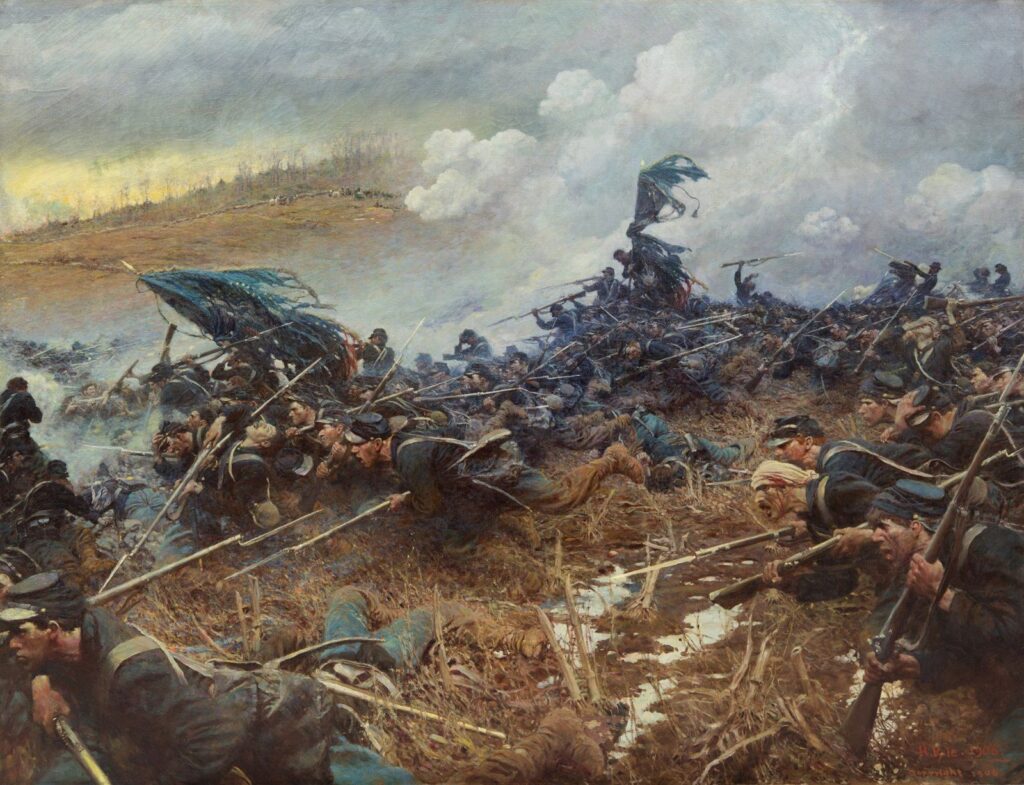
Howard Pyle’s famous mural painting of the battle at Shy’s Hill, featuring the Minnesota Second Brigade in the area of BONT’s new battlefield tract. Click image to enlarge.
The historical importance of preserving this part of the battlefield cannot be overstated. On Dec. 16, 1864, the new ground acquired by BONT was positioned between the Confederate line anchored on top of Shy’s Hill, and Federal troops amassed to the north and west poised for attack. Union Brig. Gen. John MacArthur, a division commander within the XVI Corps of Gen. Andrew Smith, became frustrated by the delays of high command and essentially forced the late afternoon assault on Shy’s Hill. In the Pyle painting, Col. Lucius F. Hubbard, commander of the Second Brigade, led the Fifth and Ninth Minnesota regiments up the northeast slope of the Hill, requiring them to cover open ground consisting of a muddy cornfield, and exposing them to devastating enfilading fire from the Confederate line to their east.
In the violent chaos of the charge, Hubbard had two horses shot out from under him and sustained a bullet neck wound, and four color bearers of the Minnesota Fifth regiment were shot down (three of them killed). The Fifth sustained 100 casualties in the charge over this ground, approximately 25 percent of its total regimental force. The 4601 Benton Smith Rd. property was also immediately adjacent to the area involving the assault of the steep north slope by Col. William McMillan’s First Brigade, which led the Federal attack beginning at approximately 4:00 p.m.
Nov. 4, 2023
BATTLE OF NASHVILLE TRUST MOURNS PASSING OF JOHN ALLYN — HISTORIAN, COLLEAGUE, AND FRIEND
The fields and stone walls around Confederate Redoubt No. 3 in Nashville would have been enveloped in a maelstrom of rifle fire, the whine of minie balls and thunder of artillery, and the thick fog of black powder smoke, as the Union army bore down from three directions on the last remaining Confederate earthworks in the late afternoon of Dec. 15, 1864.
It was therefore the perfect place for the home of Nashville attorney John Allyn to live with his family on the short dead-end street which later evolved there, Hood’s Hill Road, just over a football field’s distance from the Redoubt, the vestiges of which are now barely visible in the backyard of the nearby Calvary Methodist Church.
John, 76, passed away on Nov. 4, 2023, but he left a long and meaningful legacy of contributing to the preservation and understanding of the Battle of Nashville and other aspects of Nashville’s military and ancestral history. He served many years on the Battle of Nashville Trust board in his role as a tireless supporter of the its mission of acquiring, preserving and interpreting remnants of the battlefield.
A New Yorker by birth, John came south to attend Vanderbilt University. He majored in history, or as his family noted, he “majored in his hobby.” Afterwards, he received his law degree from Vanderbilt Law School, and decided to stay in Nashville. These decisions were fortunate for Nashvillians interested in the history of the city, especially the years of the Civil War and the December, 1864, Battle of Nashville.
His work for BONT was concentrated in the years 2013 to 2018, when he served as its president, but his work and influence spread far beyond that role. He became one of the Trust’s “go to” historians who, as an attorney, dedicated his keen mind, analytical ability and pure joy of history to understanding and interpreting every aspect of the Battle of Nashville.
John wrote a number of in-depth articles for the BONT website, including, as would be expected, contributing to the site’s page on the mayhem that had occurred in his neighborhood about 150 years earlier at Redoubt No. 3, and also on the Cumberland River naval skirmishes that preceded the main battle of December 15 and 16. In 2013, he edited massive changes to the Battle of Nashville Wikipedia page in order to clarify and amplify the factual content.
He had a special interest in the men who fought for Minnesota, a state which suffered more casualties at Nashville than at any other battle where its troops fought, and which is commemorated with a granite monument and flag on Shy’s Hill. He wrote an essay for the website on the importance of Minnesota troops in the Battle, and was later invited to present his thoughts and findings to the Minnesota Historical Society in Minneapolis.
His interest in the ancestry of those who fought in Nashville led him to contribute a website essay on Nashville’s Civil War burials, and to become involved with other Nashville historical groups, especially the Nashville City Cemetery Association for which he served as a board member and president, enjoying especially leading some of the City Cemetery’s legendary tours. In addition, he had an important role with Friends of Fort Negley, and served as a featured speaker at various historical meetings. John had an ancestral link to the Battle through his wife, Cary DeWitt Allyn, whose great-grandfather, Marcus Bearden DeWitt, was the chaplain for the 8th Tennessee posted on the down slope of Shy’s Hill on Dec. 16.
The BONT board and membership will miss John personally as well as his dedication to its mission, his time and talent as president, and his work clearing brush on the slopes of Shy’s Hill with as much zest as his time spent in the research of official battlefield records. The Trust will honor his memory at its annual Wreath Ceremony on the summit of Shy’s Hill on Dec. 16, 2023, the 159th anniversary of the Battle of Nashville.
October, 2023
MONUMENT DEDICATED ON SHY’S HILL TO COMMEMORATE 114th ILLINOIS VOLUNTEER INFANTRY
Representatives of both the “114th Regiment, Illinois Volunteer Infantry Reactivated” and the Battle of Nashville Trust (BONT) formally dedicated placement of a granite monument on Shy’s Hill on Oct. 28, 2023, in honor of the men of the 114th Illinois who took part in the assault of the Hill on Dec. 16, 1864.
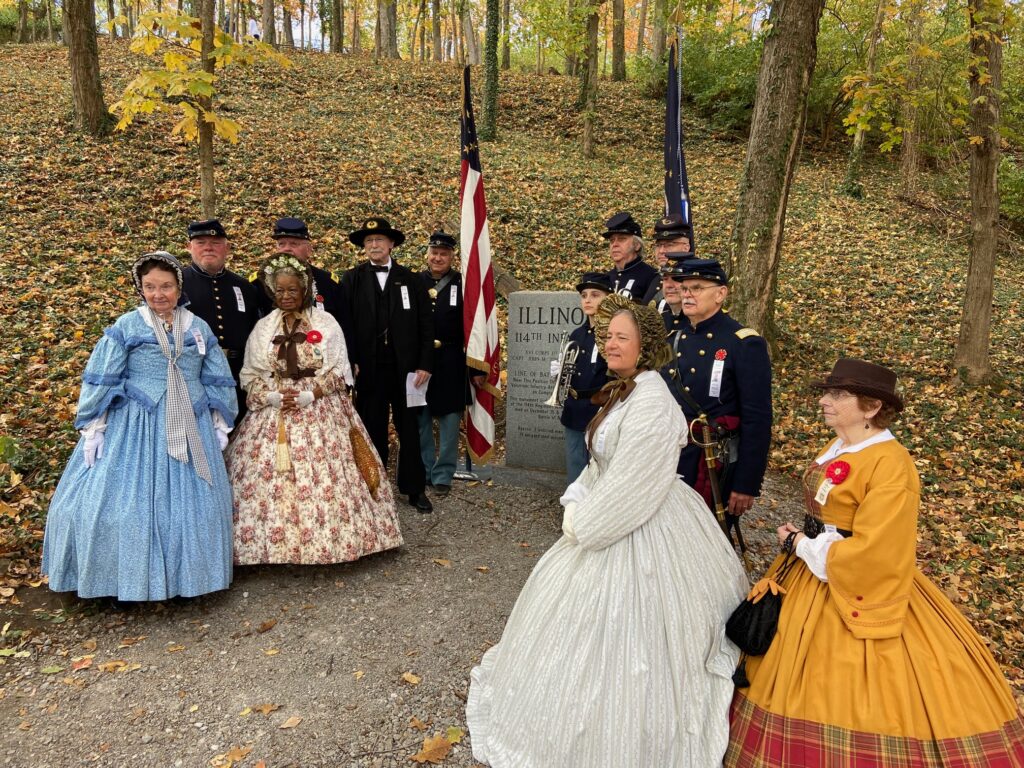 Pictured above, Left to right, women: Mary Disseler, Stephanie Thomas, Lisa McLane, and Laura Reyman. Men: Stan Buckles, Don Ferricks, Jonathan Reyman, David Jostes, Andy VanDeVoort, Violet Filipiak (in front of Andy, her grandfather), Mike Vizral, Shawn McLane, Richard Schachtsiek, Lisa McLane, and Laura Reyman. Photo by Bobby Whitson
Pictured above, Left to right, women: Mary Disseler, Stephanie Thomas, Lisa McLane, and Laura Reyman. Men: Stan Buckles, Don Ferricks, Jonathan Reyman, David Jostes, Andy VanDeVoort, Violet Filipiak (in front of Andy, her grandfather), Mike Vizral, Shawn McLane, Richard Schachtsiek, Lisa McLane, and Laura Reyman. Photo by Bobby Whitson
The Illinois monument, erected on the Hill in February, 2023, by the Illinois group with cooperation of BONT, is the second one honoring Federal troops involved in the battle at Shy’s Hill. In November, 2014, a granite monument was placed on the plateau of the Hill by the Minnesota Civil War Commemoration Task Force in memory of the 97 Minnesota troops killed in the charge up the north and northeastern slopes.

Andy VanDeVoort and his granddaughter, Violet Filipiac, sound taps in echo. To hear them, click their photo
The Federal monuments will be joined in the future by an obelisk style monument at the summit honoring the Confederate forces which held the Hill on the evening of Dec. 15 and most of the day of Dec. 16. (BONT uses Peffen Cline Masonry Group for monument installation due to the high level of expertise needed on the Hill’s challenging terrain.)
The dedication ceremony included members of the 114th Illinois Reactivated dressed in period uniforms with comments by several of their representatives including Col. Richard Schachtsiek, Stan Buckles, and Chaplain Jonathan Reyman, as well as by BONT president Bill Ozier and historian Jim Kay. In addition, taps were sounded in echo by Illinois bugler Andy VanDeVoort and his granddaughter, Violet Filipiak, and a commemorative wreath was placed at the site by Shawn McLane on behalf of the 114th, Donald Ferricks on behalf of the descendants of the original 114th, and Mary Disseler on behalf of the Soldiers Aid Society.
The Illinois contingent included Stan Buckles of Mt. Pulaski, IL, the representative of the 114th Regiment Reactivated who worked with BONT regarding installation of the monument. He has written a regimental history of the unit entitled “Not Afraid To Go Any Whare,” quoting a line from a soldier’s letter.
The original 114th Regiment was formed in the summer of 1862. The unit was unique in that most of its members, or their families, personally knew President Abraham Lincoln, causing their remarks in letters and diaries to take on a more familiar tone when writing of President Lincoln.
Most of the regiment’s early action was in Mississippi, including the Battle of Jackson and the siege of Vicksburg. However, at the battle of Brice’s Cross Roads in North Mississippi, due to poor leadership by commanding Gen. Samuel D. Sturgis, the regiment was decimated by Gen. Nathan Bedford Forrest in June, 1864. Stan Buckles noted that after that embarrassment, several members of the 114th testified in a later Court Of Inquiry against the drunken conduct of both Sturgis and their brigade commander, Col. William L. McMillen. As noted below, this name would come to play an important but dishonorable role in the Battle of Nashville, according to many historians.
The Regiment fought in the Battle of Tupelo, Mississippi in July, 1864 before arriving in Nashville as part of Gen. Andrew J. Smith’s XVI Corps, Brig. Gen. John MacArthur’s 1st Division. The 114th was one of three regiments in the 1st Brigade (along with the 93rd Indiana and 10th Minnesota) still under the command of the widely disliked and disrespected Col. McMillen.
When the Battle of Nashville began on Dec. 15, 1864, the 114th Illinois was involved in the capture of both Redoubts 4 and 5 on Dec. 15. Late in the day of Dec. 16, 1864, they were among the large surge of Federal troops who successfully participated in the charge up Compton’s (now Shy’s) Hill. They were one of the first regiments to gain the north slope works and break the Confederate line of Finley’s Florida brigade at the summit.
As the battle at Shy’s Hill came to an end, Confederate Brig. Gen. Thomas Benton Smith was forced to surrender and shortly thereafter, while in custody and defenseless, he was bludgeoned over the head with a sabre by a Union officer, causing permanent brain damage that left him disabled for life. Col. McMillen has been alleged to be the assailant, as noted by some historians, but there is no official record of the attacker’s identity. If McMillen was the assailant, he had long since lost the respect of the men of the 114th Regiment. The street that is adjacent to the eastern slope of Shy’s Hill is named “Benton Smith Rd.” in Smith’s honor.
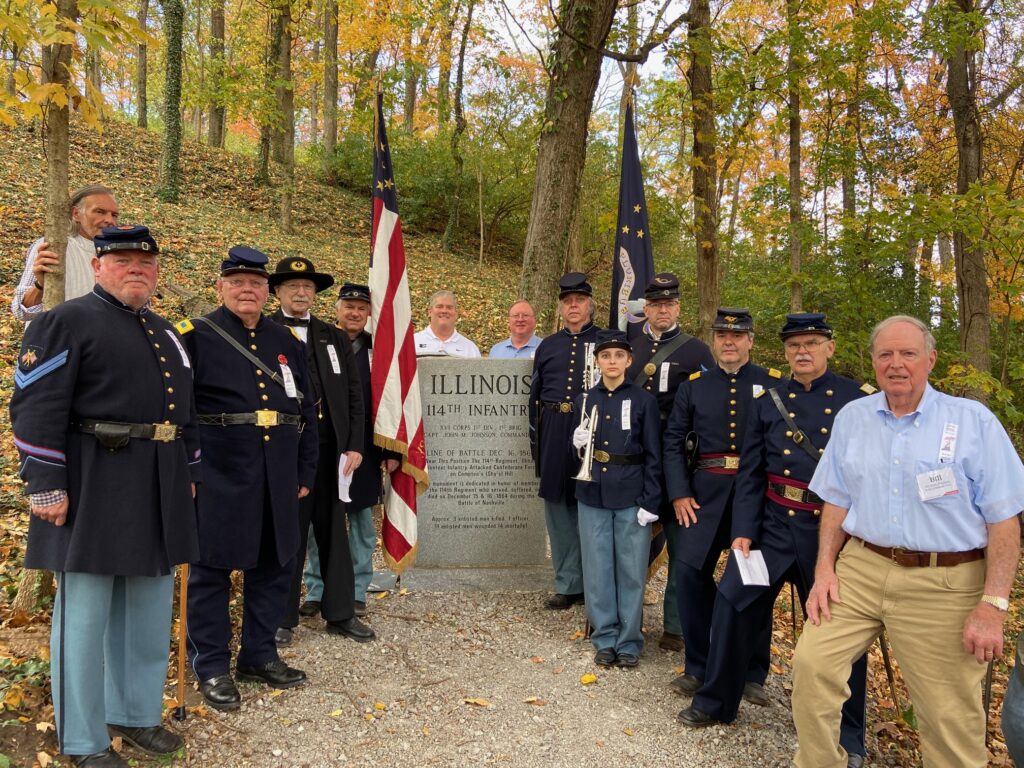
Above: Men of the 114th accompanied by members of the Battle of Nashville Trust Board, including L-R, Jim Kay, Bobby Whitson, Sidney McAlister and Bill Ozier. Photo by Bobby Whitson
The 114th Regiment, Illinois Volunteer Infantry Reactivated, was founded only three years after the Civil War Centennial in 1968, and has been continually active since its founding. It celebrated its 50th anniversary in September, 2019, making it one of the oldest reenactment/living history Civil War regiments in the country. Their goal is to place markers on all of the battlefields in which the unit saw action, and have already done so at Brice’s Cross Roads and now, Shy’s Hill.
See additional photos (courtesy of Bobby Whitson and Sidney McAlister) of the Ceremony in the gallery below (hover cursor over photo for full captions):
- Stan Buckles addresses attendees during dedication
- Richard Schachtsiek speaking
- Men of the 114th Illinois Infantry Reactivated
- Andy VanDeVoort and granddaughter Violet Filipiak sound Taps
- Dedication Ceremony in progress
- Bill Ozier remarks at wreath placement
- BONT representatives Philip Duer, Jim Kay, Bobby Whitson, Bill Ozier and Sidney McAlister
- Jim Kay watches Taps played at Howitzer battery
- Representatives of Illinois and Nashville contingents
- Group portrait of 114th
- See names in main story
October, 2023
SHY’S HILL ARTILLERY BATTERY READY FOR ACTION AS REFURBISHED HOWTIZERS RETURN TO PLATEAU
Two Mountain Howitzers that had been removed from Shy’s Hill a year ago for repair were reinstalled at their historic location on the Hill on Oct. 14, 2023, after refitting and restoration by specialists in Pennsylvania.

Mountain Howitzers return to the plateau on Shy’s Hill as Mark Martin and Bobby Whitson begin removing shipping material. Photo by Bill Ozier
The guns symbolize the howitzers that were wrangled up to this spot through darkness and muddy fields after the first day of the Battle of Nashville on Dec. 15, 1864, by the men of Confederate Capt. Rene Beauregard’s artillery battery. For a more complete summary of the acquisition and history of these field pieces, see earlier posts on the Shy’s Hill page.
The reinstallation was accomplished by Jim Kay, driving a 4-wheeler, along with BONT President Bill Ozier, Board member Bobby Whitson, and former Board member Mark Martin.
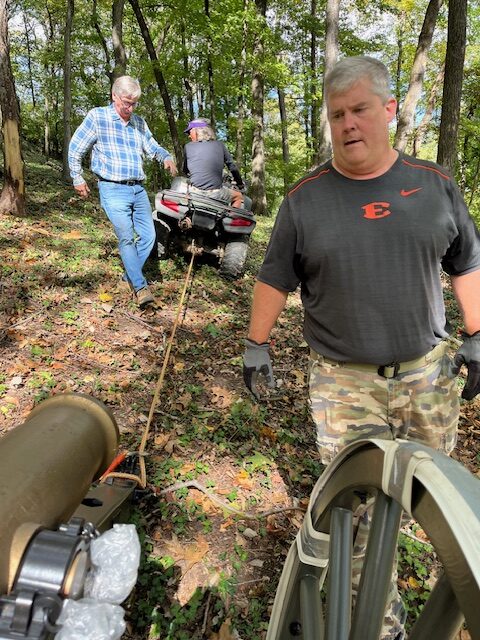
Mark Martin (L) and Bobby Whitson (R) assist Jim Kay on 4-wheeler to move howitzers into place. Mules and horses, not ATVs, were used in 1864. Photo by Bill Ozier
In addition, the 6-pounder field piece donated by the Woolwine family was also delivered back to BONT after being refitted with a new aluminum carriage. The cannon is destined to take its place on the battery line at Redoubt No. 1.
The reproduction cannon tube was donated by Ms. Graham Woolwine-Gilson, a Nashville native now living in Mamer, Luxembourg, and bears a bronze plaque stating, “Donated in memory of Porter Anthony (Tony) Woolwine.” The replica cannon tube was designed to resemble those manufactured by Noble Brothers, a large ironworks factory in Georgia producing pre-war items such as steam boat engines and locomotives but which turned some of its production to cannons for the Confederacy during the Civil War.
For a more detailed summary of the tube and its acquisition, see separate posts below on the Battle of Nashville Trust “News” page.
July 13, 2023
AFTER 159 YEARS, EXPERTS GET A FIRST-EVER PEAK AT THE BATTLE HISTORY REVEALED WITHIN “SUNNYSIDE’S” CEDAR LOGS
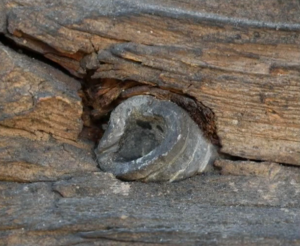 Bullets fired into the Sunnyside mansion’s log walls on Dec. 15, 1864, have been recovered, analyzed and preserved in a joint project of the Metro Historical Commission and the Metro Nashville Police Department, further clarifying initial fighting along the Confederate line on the first day of the battle.
Bullets fired into the Sunnyside mansion’s log walls on Dec. 15, 1864, have been recovered, analyzed and preserved in a joint project of the Metro Historical Commission and the Metro Nashville Police Department, further clarifying initial fighting along the Confederate line on the first day of the battle.
The joint project took place during the renovation of “Sunnyside,” an antebellum mansion which was located in the “no man’s land” between the Federal and Confederate main lines on the first day of the Battle of Nashville.
The Historical Commission requested the CSI division of MNPD to analyze the portion of the 1852 house consisting of an original log structure that formed one wing of the mansion, using an array of technology including traditional trajectory and flight path techniques, 360 degree laser scanners, drones, and photogrammetry software. The Commission reported on the findings in a public meeting at Fort Negley Visitor’s Center on July 13, 2023. To view the 53 minute presentation, click HERE.
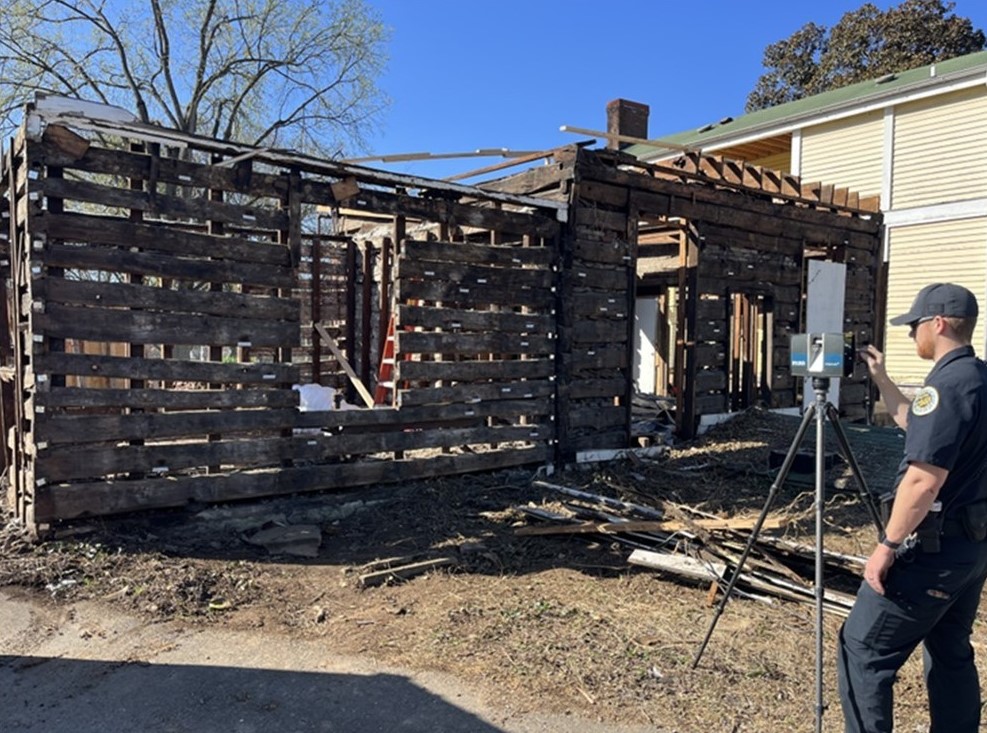
Above: 3-ring minie ball embedded in Sunnyside log; MNPD investigator using laser technology to determine trajectories of bullet hits in log wall
Preservation of the “battle history” data within the logs was imperative, since the renovation required removal of the log structure.
The findings were interesting and important, although not completely definitive. Despite this important work, historians were still not certain as to exactly what occurred at Sunnyside on Dec. 15, 1864. Even prior to this project, bullet holes had long been discovered in the porch and columns of the house, which was known to have been used as a hospital for wounded Union soldiers.
However, the MNPD work gave many more substantive clues as to events of that day 159 years ago. Among other findings, investigators discovered two embedded Federal bullets and 24 “defects” showing bullet strikes and their trajectories. Since Sunnyside was the site of the Confederate forward picket line, the bullet strikes were likely Union projectiles fired, as investigative techniques confirmed, primarily from the west and north, which was consistent with the known progression of the battle on that day. BONT strongly recommends viewing the video of the joint agency presentation (see link above) for a thorough understanding of the investigative techniques and findings.
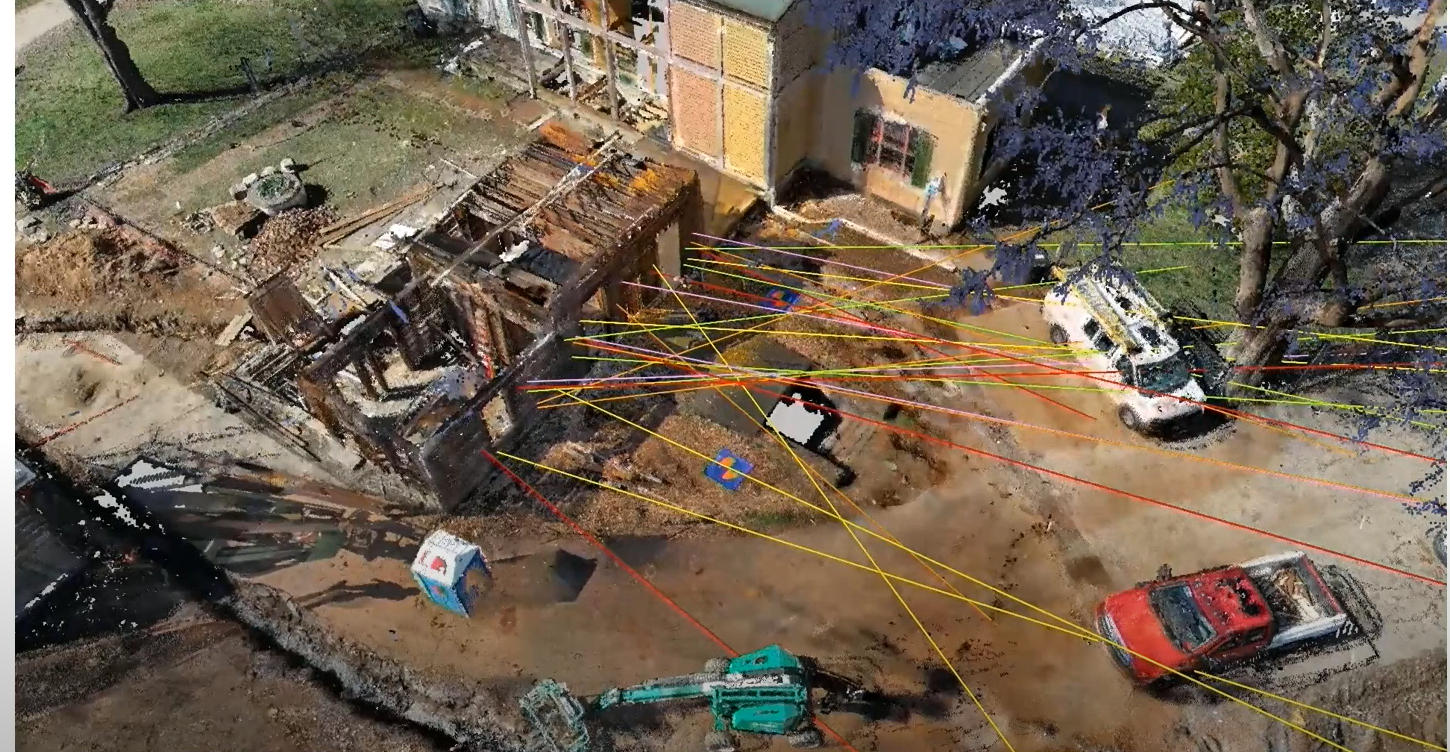
MNPD depiction of laser beams revealing flight paths of bullets that struck Sunnyside north wall; see video link above for full explanation (click to enlarge)
“Sunnyside” mansion had been built eight years before the Civil War for Mary Childress Benton, widow of Jesse Benton who had famously been involved in a pistol fight with Andrew Jackson in 1813. During construction, she had lived in a pre-existing log house, but liked it so much, she had it incorporated into the new frame house. By the beginning of the War, it was occupied by one of her relatives, Mary Douglass, and her husband Frank Sevier. After the war began, the house and grounds were bought by John Shute for his daughter, Mrs. Stephen Childress. After later ownerships by the Noel and Sevier families, the remaining 20.5 acres was sold in 1945 to the City of Nashville and in 1948, became known as Sevier Park.
Currently, the yellow mansion is the centerpiece of the Park in South Nashville and houses the Metro Historical Commission and Metro Historic Zoning Commission.
May 17, 2023
BONT HOSTS BOARD OF AMERICAN BATTLEFIELD TRUST AT “BATTLE OF THE BARRICADE” HISTORIC SITE
The Board of the Battle of Nashville Trust hosted a dinner event for the Board of the American Battlefield Trust (ABT) at the Richland Country Club on May 17, 2023, bringing the two Civil War preservation groups together at the site of a legendary battle.
The ABT was in the Nashville area for its annual meeting, being held in Franklin May 18 – 23, and joined the BONT Board at Richland, the site of which was involved in the Battle of the Barricade on the rainy night of Dec. 16, 1864 as Confederate troops attempted to buy time for their retreating comrades after the collapse of Hood’s line in the late afternoon of that day.
Welcoming remarks were made by BONT President Bill Ozier and by former BONT president Jim Kay, who is also as past president of Richland CC and who spearheaded Richland’s preservation of its historical place in the Battle of Nashville, including placement of a Barricades historical marker on the site in 2008. Both expressed BONT’s interest in working with the ABT regarding ongoing preservation matters, especially the acquisition of additional Nashville battlefield properties.
The next day, BONT Board member Brandon Hulette was a guest lecturer at the main ABT conference with his presentation, “Old Story, New Tricks: New Insights Into Battlefield of Nashville, as was Jim Kay on the topic, “Failure From The Top: Hood’s Disaster Into Tennessee.”
The American Battlefield Trust is the premier national Civil War preservation non-profit organization, located in Washington, D.C. It is dedicated to promoting educational programs and heritage tourism initiatives to inform the public about the Civil War (as well as the Revolutionary War and War of 1812) and its significance in American history. The ABT has acquired and preserved 53,000 acres of battlefield land in 24 states at more than 145 battlefields.
The site of the BONT event welcoming the ABT represents an important chapter in the story of the Battle of Nashville. As Confederate troops fled south from their broken battle line on Dec. 16 with Federal Gen. James Wilson’s cavalry in hot pursuit, Col. Edmund Rucker’s 1200 men hastily threw up a barricade of brush, logs and fence rails across the macadamized Granny White Pike in the area now occupied by Richland CC. In the rain and dark of the night, Rucker’s men held off Wilson’s cavalry in hand-to-hand fighting until almost midnight, allowing the Confederate retreat to continue south down the Granny White and Franklin pikes.
February, 2023
NEW TRAIL TO THE SUMMIT MAKES SHY’S HILL MORE ACCESSIBLE TO ALL VISITORS
The Battle of Nashville Trust has completed construction of a new, revised trail up to the top of Shy’s Hill and it is now ready for visitors.
The new design features updated steps up to the trailhead, a specialized stone surface that removes obstacles such as tree roots, and a newly plotted route up the steep slope that makes the climb easier.
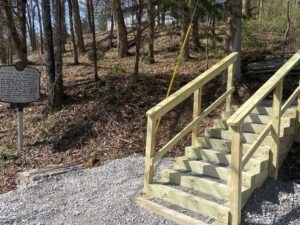 For all of the years the Trust has had ownership or control of the Shy’s Hill battleground, maintaining a safe and accessible trail to the top has always been a challenge due to the extreme elevation angle. In an attempt to finally correct that problem, BONT president Bill Ozier said the Trust retained the services of the Atlanta trail-design firm, “Tailored Trails,” which is also rebuilding the walking trails in Nashville’s Percy Warner Park. The trail surface is designed to withstand water erosion to the greatest extent possible on extreme grades like Shy’s Hill.
For all of the years the Trust has had ownership or control of the Shy’s Hill battleground, maintaining a safe and accessible trail to the top has always been a challenge due to the extreme elevation angle. In an attempt to finally correct that problem, BONT president Bill Ozier said the Trust retained the services of the Atlanta trail-design firm, “Tailored Trails,” which is also rebuilding the walking trails in Nashville’s Percy Warner Park. The trail surface is designed to withstand water erosion to the greatest extent possible on extreme grades like Shy’s Hill.
BONT also had a gravel pad built for the most recent monument addition to the Hill, representing and honoring the 114th Illinois Infantry which was involved in the battle of Dec. 16, 1864, and suffered casualties in the assault on this high ground.
President Ozier stressed that BONT’s board and Shy’s Hill team are working on plans to erect a granite monument at the summit, honoring the various Confederate units that defended the hilltop against the overwhelming Union forces arrayed below it.
February, 2023
BONT Board Member John Banks Takes You On An Amazing Civil War Road Trip With His New Book
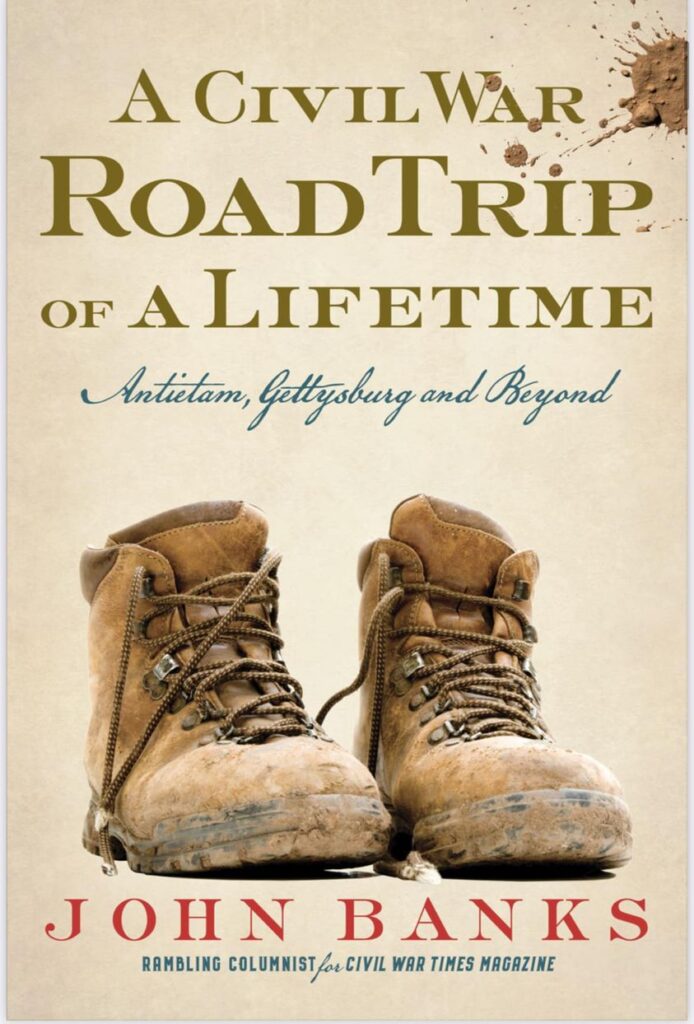 Over more than a year, Battle of Nashville Trust board member John Banks crisscrossed the country—communing with Civil War spirits, admiring a sunset at the Andersonville POW camp, riding on the back of an ATV on a Mississippi battlefield, enduring a “ghost investigation” in Gettysburg, and much more.
Over more than a year, Battle of Nashville Trust board member John Banks crisscrossed the country—communing with Civil War spirits, admiring a sunset at the Andersonville POW camp, riding on the back of an ATV on a Mississippi battlefield, enduring a “ghost investigation” in Gettysburg, and much more.
In Tennessee, he ventured into the woods with a moonshiner’s son to inspect graves of U.S. Army soldiers killed at the obscure Battle of Dug Hill, underwent hypnosis in a fort in Franklin, and eluded traffic on Granny White Pike in Nashville in a quest to learn more about a Medal of Honor recipient.
Banks writes about these adventures in his third book, A Civil War Road Trip Of A Lifetime (320-plus pages, 89 photos). It will be available in late spring. The book is available for pre-ordering by clicking HERE.
Banks is also author of Connecticut Yankees at Antietam and Hidden History of Connecticut Union Soldiers. A columnist for Civil War Times magazine, he has also written for such notable publications as the New York Times, Dallas Morning News and America’s Civil War magazine.
When he’s not submitting articles to publications and writing books, he also writes a well-respected Civil War blog, “John Banks’ Civil War Blog.”
A longtime journalist (Dallas Morning News and ESPN), Banks is also secretary-treasurer of “The Center for Civil War Photography” and a board member of the “Save Historic Antietam Foundation” in addition to his work with the Battle of Nashville Trust board.
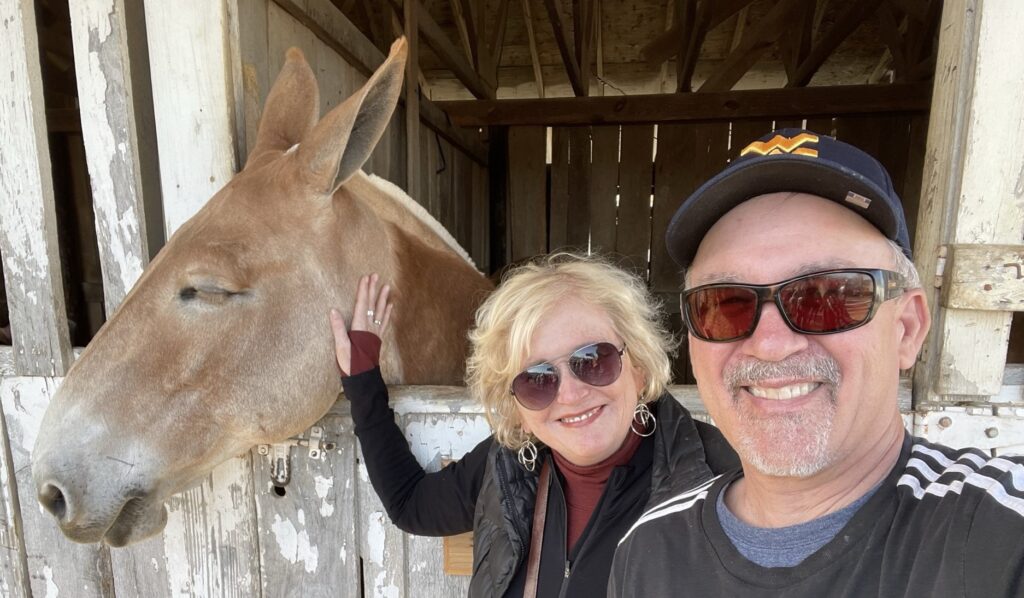
Author John Banks and wife at Mule Day Celebration in Columbia, TN. As John clarified when he submitted this photo, “I am at far right.”
February, 2023
KRISTA CASTILLO, FORT NEGLEY HISTORIAN AND CIVIL WAR PRESERVATIONIST, ANNOUNCES RETIREMENT AFTER 13 YEARS AS MUSEUM HEAD
Krista Castillo, a veteran voice in illuminating the history of the Civil War in Nashville, especially the significance of Fort Negley, has announced her retirement after 13 years as Museum Coordinator at the Fort Negley Visitors Center.
A long-time friend of the Battle of Nashville Trust, she has been a valuable and important partner in the preservation and interpretation of not only Fort Negley, but also the history of the Battle of Nashville and the city’s place in the Civil War.
 Krista obtained her undergraduate degree in history from Mount Union College, followed by a Masters in Military History from Austin Peay State University, and immediately put that background to use in helping others understand Nashville’s involvement in the War, and taking a leadership role in the preservation and interpretation of the Fort. In 2010, she became the Museum Coordinator at Fort Negley. Her role in that position has been extensive, including directing and supervising the overall operation, programming, special events, research, partnerships, management projects, exhibits, fund-raising efforts, volunteers and staff of Fort Negley Visitors Center and Historical Park to fulfill the missions of the site and the Parks Department.
Krista obtained her undergraduate degree in history from Mount Union College, followed by a Masters in Military History from Austin Peay State University, and immediately put that background to use in helping others understand Nashville’s involvement in the War, and taking a leadership role in the preservation and interpretation of the Fort. In 2010, she became the Museum Coordinator at Fort Negley. Her role in that position has been extensive, including directing and supervising the overall operation, programming, special events, research, partnerships, management projects, exhibits, fund-raising efforts, volunteers and staff of Fort Negley Visitors Center and Historical Park to fulfill the missions of the site and the Parks Department.
In addition to her professional role at Fort Negley, Krista has also served as president of the Nashville Civil War Roundtable, which she helped create in 2009. Philip Duer, former president and long-time board member of BONT, said he has known her since her early days at Negely, adding, “She was a driving force in establishing the present iteration of Fort Negley and foundational in creating the Nashville Civil War Roundtable which is based at the visitor center where monthly meetings are held. Krista, as President along with Greg Biggs of the Clarksville Civil War Roundtable and as Program Chair for NCWRT, scheduled a wide range of speakers to tell the often unknown, or in some cases, long overlooked stories of the Civil War.”
Krista has been a member of the Inter-Museum Council of Nashville (ICON) since 2014, including serving on its board and as membership chair. ICON is a professional organization “committed to encouraging the development and education of Nashville-area museums and cultural institutions.”
She was also instrumental in establishing the Friends of Fort Negley, a non-profit volunteer organization whose members and donations support and advocate for the preservation of Fort Negley and public accessibility to the surrounding Park area. The FOFN will be hosting an invitation-only farewell reception for her on Wed., Feb. 22, 2023.
Duer, speaking on behalf of the Battle of Nashville Trust board and membership, further noted that “Krista will be sorely missed. She was always generous with her time and energy in opening the fort and its wonderful facilities to BONT and many other historical groups and it is hoped that the next museum coordinator will follow her lead. They will have big shoes to fill.”
December, 2022
“NASHVILLE SITES” LAUNCHES NEW BATTLE OF NASHVILLE ON-LINE DRIVING TOUR
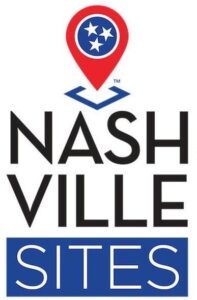 NashvilleSites.org has released a new “driving tour” that enables users to drive to several key Battle of Nashville locations while learning about the sites through narration, text, and/or images. Click on Nashville Sites Civil War Driving Tour to join the tour.
NashvilleSites.org has released a new “driving tour” that enables users to drive to several key Battle of Nashville locations while learning about the sites through narration, text, and/or images. Click on Nashville Sites Civil War Driving Tour to join the tour.
The basic tour presents an overview of 11 Battle locations, beginning with the surrender of Nashville and moving on through sites such as Fort Negley, Granbury’s Lunette, Redoubt No. 1, Shy’s Hill, Sunnyside Mansion, and the Battle of Nashville Monument. “Nashville Sites” states that the tour experience can be customized by visiting one or all of the tour stops in any order, either in-person by driving, or by visiting virtually using any device. Each stop has audio narration, a map, and historic images.
The Civil War Driving Tour was sponsored by the Tennessee Civil War National Heritage Area and the Center for Historic Preservation at Middle Tennessee State University. Nashville Sites offers more than 30 free, self-guided walking and driving tours about Nashville history that can be taken virtually or in-person.
November, 2022
BONT MAKES AVAILABLE A FAMOUS “AUTOGRAPH BOOK” FROM UNION PRISON WHICH HAS LINK TO TRAGIC EVENT IN NASHVILLE
The Battle Of Nashville Trust (BONT) has been given permission to display a rare Federal prison “autograph book“ which is historically important on its own, but which also links one of the most tragic stories of the Battle of Nashville to one of the Union’s most well-known prisoner of war forts.
During the Civil War, the Federal army established the Johnson Island Civil War prison and fort on a 300 acre island in Lake Erie, near Sandusky, Ohio, and during its three years of operation, it housed more than 15,000 Confederate prisoners of war. Initially, most of them were officers, though other ranks were added as the war progressed.
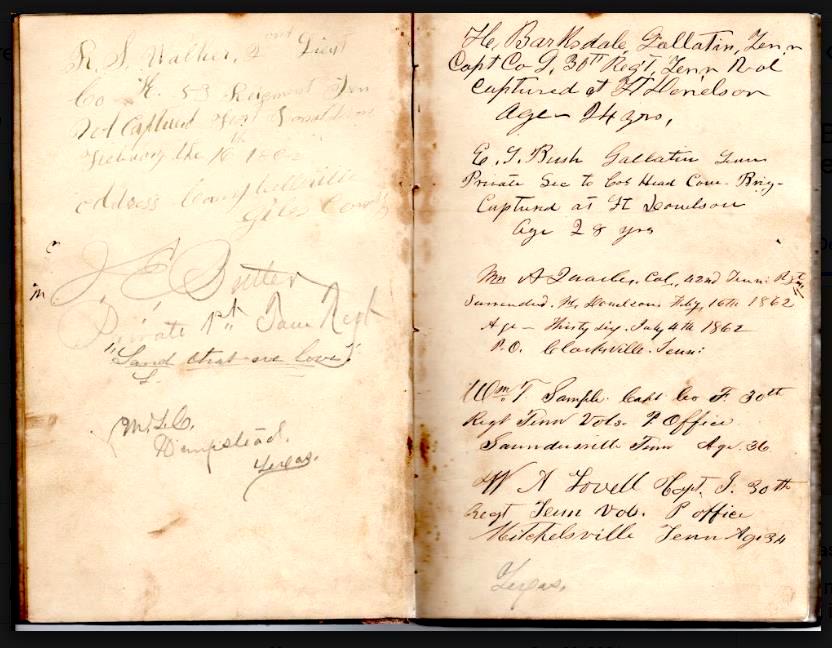
Opening pages of the Butler “Autograph Book.” Click the image to see all of the original and transcribed pages
One of its most famous Confederate POWs who spent time there was Brig. Gen. Thomas Benton Smith, whose name is associated with one of most well-known atrocities of the Battle of Nashville. Gen. Smith, a native of Rutherford County, Tennessee, had begun his military career with the 20th Tennessee Infantry Regiment. By the time of the Battle of Nashville, he had advanced to command of Tyler’s Brigade of Bate’s Division, positioned on the west side of Shy’s Hill on the second day of the Battle.
Smith was among those who surrendered on Dec. 16, 1864, but while in Union custody behind the lines, and defenseless, reports indicate that he was viciously struck in the head with the butt-end of a sword by Union Col. Colonel William L. McMillen, who had led McArthur’s First Brigade charge up the north slope. The attack on the unarmed Smith resulted in his sustaining a fractured skull and permanent, debilitating brain injury.
Gen. Smith was transported to Johnson Island prison and later to Fort Warren in Massachusetts. After his release in July, 1865, he was unable to live a normal life due to the head trauma caused by McMillan’s assault, and he spent the last 47 years of his life in Nashville’s Central State Hospital for the mentally Ill. He died in 1923 at the age of 84. In his honor, the road on which BONT’s Shy’s Hill trailhead is located is named “Benton Smith Road.”
It was a common practice at the Johnson Island prison for the inmates to procure writing materials in order to record the names of their fellow prisoners in so-called “autograph books.“ One of these extremely rare books was inherited by Nashville attorney Taylor Sutherland who, realizing its significance, donated it to a nonprofit which preserves the history and artifacts from the Island fort, “The Friends And Descendants Of Johnson’s Island Civil War Prison.” As part of the donation arrangements, the nonprofit agreed to not only scan all of the pages of the book showing the original script and notes of the Confederate inmates, but also to have all of the script transcribed for easy reading.
The Friends group, as well as Taylor Sutherland, have granted permission to BONT to post the link for the scans of original pages, as well as the transcribed pages, for review by those interested in the island and his connection with Nashville. The book was begun by prisoner William Reuben Butler during the period April 9 through Sept. 1, 1862. Gen. Smith’s name does not appear in the book because his internment occurred in 1864; the officers included here were mainly those captured at Ft. Donelson and Shiloh. To view the original scanned pages and transcriptions, click the photo above of the opening pages of the Book, or on this link: Butler Autograph Book.
October 21, 2022
INSTALLATION BEGINS ON IMPORTANT “CIVIL WAR TRAILS” SIGNAGE HONORING TRAIL-BLAZING AFRICAN AMERICAN SOLDIERS
Editor’s Note: Since the posting of this story, the Civil War Trails marker honoring the USCT soldiers in the Battle of Nashville has been erected and is available for public viewing. For more, see our story on the dedication ceremony.
The Battle Of Nashville Trust’s campaign to have two new Civil War Trails markers honoring United States Colored Troops soldiers who fought in the Battle of Nashville moved a step closer to reality on October 21, 2022, when work began on the first of the structures.
Drew Gruber, Executive Director of Civil War Trails, and his team, installed the initial directional sign and interpretive signage stand on the grounds of STEM Prep High School. USCT troops advanced into this area on the first day of the Battle of Nashville on Dec. 15, 1864.
The Battle of Nashville Trust (BONT) initiated contact in early 2022 with Civil War Trails, spearheaded by BONT board member John Banks. The plan ultimately came together after BONT received grants from the Tennessee Wars Commission to fund the marker, and BONT board member Clay Bailey secured permission for its placement on the school property at 1252 Foster Avenue, marking the USCT’s involvement on the first day of the battle. The grant also funds a second marker to be placed later in the area of the Dec. 16, 1864, battle at Peach Orchard Hill.
The historic area where the new Foster Avenue marker is being installed is only a half mile southeast of the important sites on Polk Avenue, including the preserved remnants of Granbury’s Lunette as well as the first-ever historical marker commemorating the USCT‘s role in the Battle of Nashville, erected in October, 2021, by the Tennessee Historical Commission, signifying the important and unique role played by African-American troops in the battle.

These photos show Director Gruber and his CWT assistants placing the initial structures for the marker and interpretive signage. The final story board will be placed soon, explaining the military and historical significance of the area. The Civil War Trails program works with historical groups within a six-state area encompassing major Civil War battlefields to help visitors locate and understand notable Civil War events, and “to put them in the footsteps of the generals, soldiers, citizens, and the enslaved who found themselves in the midst of this Civil War.“ Civil War Trails has erected some 1,200 interpretive signs since 1994, 350 of which are located throughout Tennessee.
BONT is continuing its efforts to locate a suitable spot for a CWT marker at Peach Orchard Hill, commemorating a battle that featured battlefield bravery by USCT troops so remarkable that it drew praise from commanders for both armies in their reports.
Sept. 17, 2022
SHY’S HILL HOWITZERS REMOVED FOR REPAIR AND REFITTING WITH NEW WEATHER RESISTANT CARRIAGES
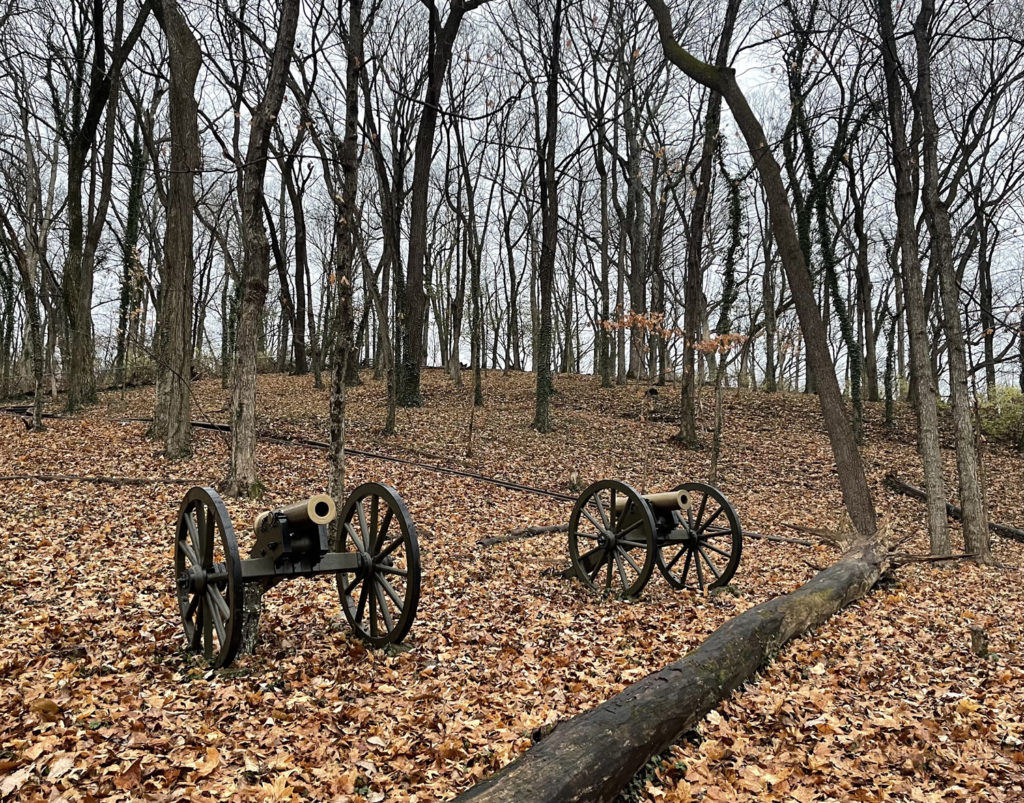 The two “Mountain Howitzers” located on the lower east side of Shy’s Hill were removed by BONT board members on Sept. 17, 2022, after the replica field pieces became too weather-damaged to be appropriate for display, and will be returned after repairs.
The two “Mountain Howitzers” located on the lower east side of Shy’s Hill were removed by BONT board members on Sept. 17, 2022, after the replica field pieces became too weather-damaged to be appropriate for display, and will be returned after repairs.
The two replica mountain howitzers were placed on the Hill in April, 2019, to demonstrate the approximate location of the only artillery pieces that were in service there on Dec. 16, 1864. However, wood used in construction of the carriages had deteriorated, requiring their removal.
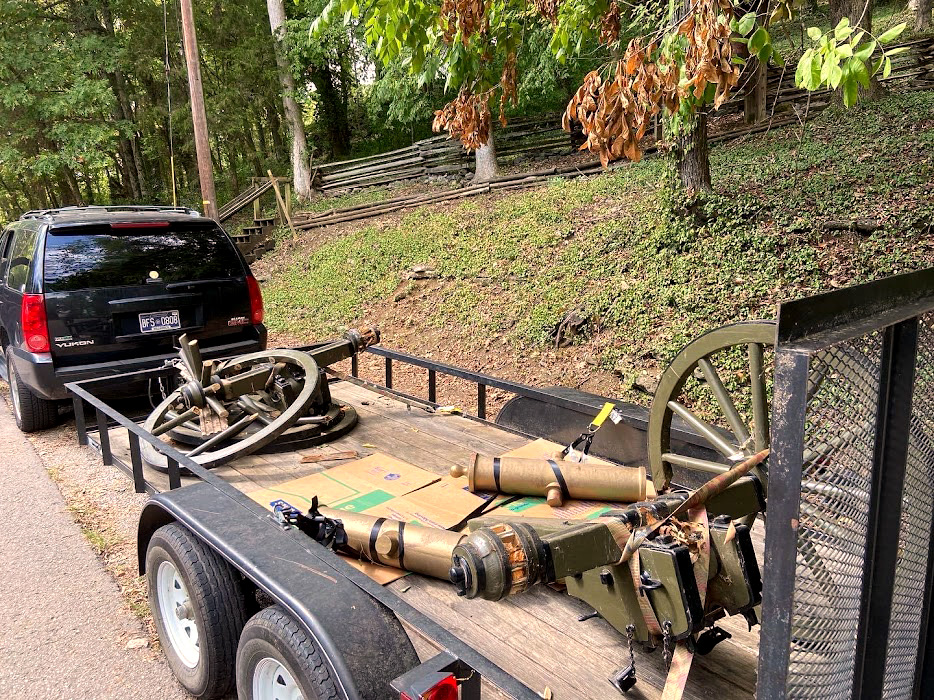
Howitzer tubes and broken carriages loaded aboard BONT board member Bobby Whitson’s much-used “ol’ warhorse Bessie” for transport to repair facility
“With the leadership of Bobby Whitson, chainsaw work by Jim Kay, strong backs of Clay Bailey, Jim Atkinson, Jimmy Pickel, and the assistance of gravity, we were able to decamp the two artillery pieces from the slope of Shy’s Hill! We look forward to their return with new carriages,” said BONT president Bill Ozier, who was also on the work detail.
BONT will have the cannon barrels refurbished and refitted with aluminum carriages, and they will be returned to the site as soon as possible. The location was determined by BONT historians to be the most likely area where Hood’s troops were able to assemble a small battery of artillery during the night of Dec. 15 and early morning hours of Dec. 16, 1864.
 After the Confederate line was forced to fall back from its initial positions on Dec. 15, 1864, Maj. Gen. Benjamin Cheatham’s corp had only 34 artillery pieces available for service for the second day of battle, and only a handful of these could be transported through the night and the boggy cornfields to a flattened plateau on the east side of the Hill. Maj. Gen. William Bate had apparently found a rough country road in this flattened area, believed to be located in the vicinity of the current Benton Smith Rd. and the Shy’s Hill trail head.
After the Confederate line was forced to fall back from its initial positions on Dec. 15, 1864, Maj. Gen. Benjamin Cheatham’s corp had only 34 artillery pieces available for service for the second day of battle, and only a handful of these could be transported through the night and the boggy cornfields to a flattened plateau on the east side of the Hill. Maj. Gen. William Bate had apparently found a rough country road in this flattened area, believed to be located in the vicinity of the current Benton Smith Rd. and the Shy’s Hill trail head.
By first light on Dec. 16, the Shy’s Hill battery, which was under the command of Capt. Rene T. Beauregard, consisted of a small number of the lighter and more portable howitzers. They were later supplemented on the plateau with four other smoothbore field pieces under the command of Maj. Daniel Truehart. Many others, especially the heavy Napoleons, could not be dragged through the thawing mud of the fields, especially under the difficult conditions of a nighttime retreat and establishment of a new line of battle.
The “Mountain Howitzer” was a bronze smoothbore 12-pounder field piece that got its name from its development in the 1830s as an easily transportable field piece for use in the western mountain terrain of the Indian and Mexican-American wars. It was much more portable than the larger artillery such as the 2,500 pound Napoleons, the workhorse artillery of the Confederate army. The howitzer was relatively lightweight and could be disassembled into three pieces for easier transportation. It fired explosive ordnance as well as case and canister, with a maximum range of about 1000 yards.
June, 2022
FLAGS AND FINIALS: NEW BOOK EXPLORES RARE CIVIL WAR TOPIC
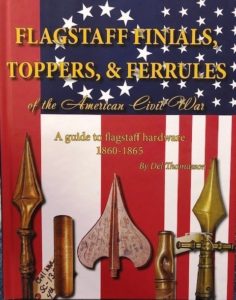 Civil War historian Del Thomasson of Ringgold, Georgia, has recently published two books with text and numerous depictions of flagstaff finials that were used during the Civil War.
Civil War historian Del Thomasson of Ringgold, Georgia, has recently published two books with text and numerous depictions of flagstaff finials that were used during the Civil War.
The first edition of Flagstaff Finials, Toppers, & Ferrules came out in July, 2021, but had sold out by December. In January, 2022, he published a second edition, which he says is selling briskly. He informed BONT that he and his wife “traveled to state archives in several states or worked with state archives to obtain pictures of several original pieces including Virginia, South Carolina, Michigan, Wisconsin, Pennsylvania, Illinois, Missouri, Alabama, etc. Several of the pictures in the book are from private collectors, ground recoveries, and my own collection.”
Thomasson’s 250-page book is self-published and self-distributed. It contains approximately 366 color pictures, and several essays on regiments, color bearers, or individuals. The book can be purchased for $45.00 (plus shipping cost) by contacting the author directly at delthomasson@outlook.com.
March 1, 2022
NEW BOOK DESCRIBES THE MASSIVE FORTIFICATION OF NASHVILLE DURING THE CIVIL WAR, AND HOW THIS SET THE STAGE FOR FEDERAL VICTORY IN THE WESTERN THEATER
Mark Zimmerman, noted Nashville Civil War historian and author, has published a new book, Fortress Nashville: Pioneers, Engineers, Mechanics, Contrabands & U.S. Colored Troops, which takes its place as the definitive work on the massive fortifications of Nashville during the Civil War.
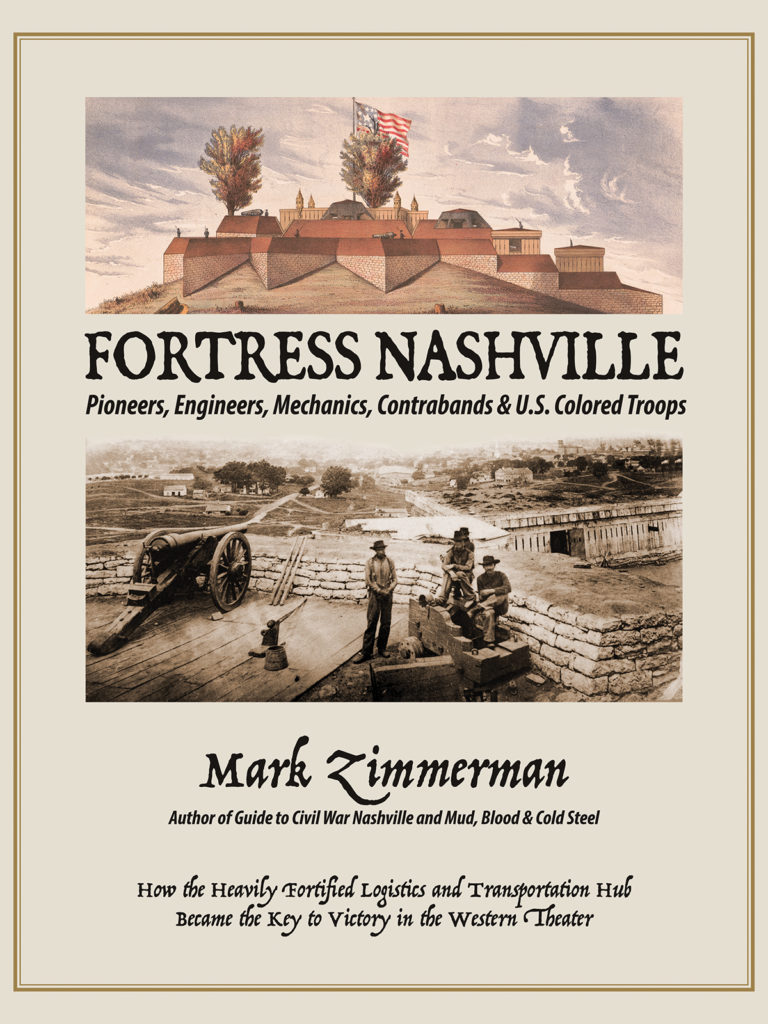 Zimmerman, a longtime member and supporter of the Battle Of Nashville Trust, is a former newspaper journalist and publications manager who has now written eight books on the general history of Middle Tennessee, four of them focusing on the Civil War, including the Battle of Nashville. Fortress Nashville follows the highly-praised Mud, Blood & Cold Steel: The Retreat From Nashville December 1864, published in 2020. He is also the author of Guide To Civil War Nashville (2nd ed., 2019), a must-have overview of all aspects of the Battle of Nashville.
Zimmerman, a longtime member and supporter of the Battle Of Nashville Trust, is a former newspaper journalist and publications manager who has now written eight books on the general history of Middle Tennessee, four of them focusing on the Civil War, including the Battle of Nashville. Fortress Nashville follows the highly-praised Mud, Blood & Cold Steel: The Retreat From Nashville December 1864, published in 2020. He is also the author of Guide To Civil War Nashville (2nd ed., 2019), a must-have overview of all aspects of the Battle of Nashville.
Fortress Nashville is the first major work in which a historian’s research has so comprehensively described the massive fortification of the city, but which also has so clearly explained why this extraordinary task was critical to the war strategy of the U.S. Army. [Note: see excellent review of Fortress Nashville in “Civil War Books And Authors,” an independent, non-fiction American Civil War book review journal, below.]
In early 1862, the Federals quickly and easily occupied the strategically important city of Nashville, and recognizing its military importance, immediately undertook all possible measures to make certain it would never lose this geographic and logistic advantage. Nashville’s network of numerous rail lines radiating out from the City, and its port facility on a significant navigable river, dominated the Federal war effort in the Western Theater. Zimmerman concludes that Federal control of the heavily fortified logistics and transportation hub enabled the successful military operations of U.S. Gens. Grant, Sherman, and Thomas.
In November, 1864, when Confederate General John Bell Hood brought his Army of Tennessee northward from Franklin, Nashville was the most heavily-fortified city in the country other than Washington, D.C. The Confederate army had no reasonable option to attack “Fortress Nashville“ because of its impenetrable defensive works. After the Confederate retreat on December 16, 1864, and Lee’s surrender to Grant in 1865, the immense defensive structures were disassembled and the materials sold off for approximately $30 million. Left standing, however, was the U.S. Army‘s crown jewel of its fortification system, Fort Negley, now serving not only as a reminder of the Federal occupation, but also as a symbol of African-American involvement with construction of the Fort, including organization of the United States Colored Troops which fought during the Battle of Nashville.
Zimmerman‘s book is a significant undertaking. Consisting of 344 pages, it not only pulls together in-depth research about Nashville’s infrastructure during the War, but also supports its analysis with 80 illustrations, charts and graphs, 204 photos, 76 maps, and numerous original artworks, including those of Philip Duer, former president and current board member of the Battle Of Nashville Trust. Other topics explored include the Pioneer Brigade, the First Michigan Engineers, U.S. Military Railroads, fortification technology and design, military hospitals, army depots and garrison towns, the Confederate river forts, fortifications associated with the epic Battle of Nashville, and antebellum pioneer forts.
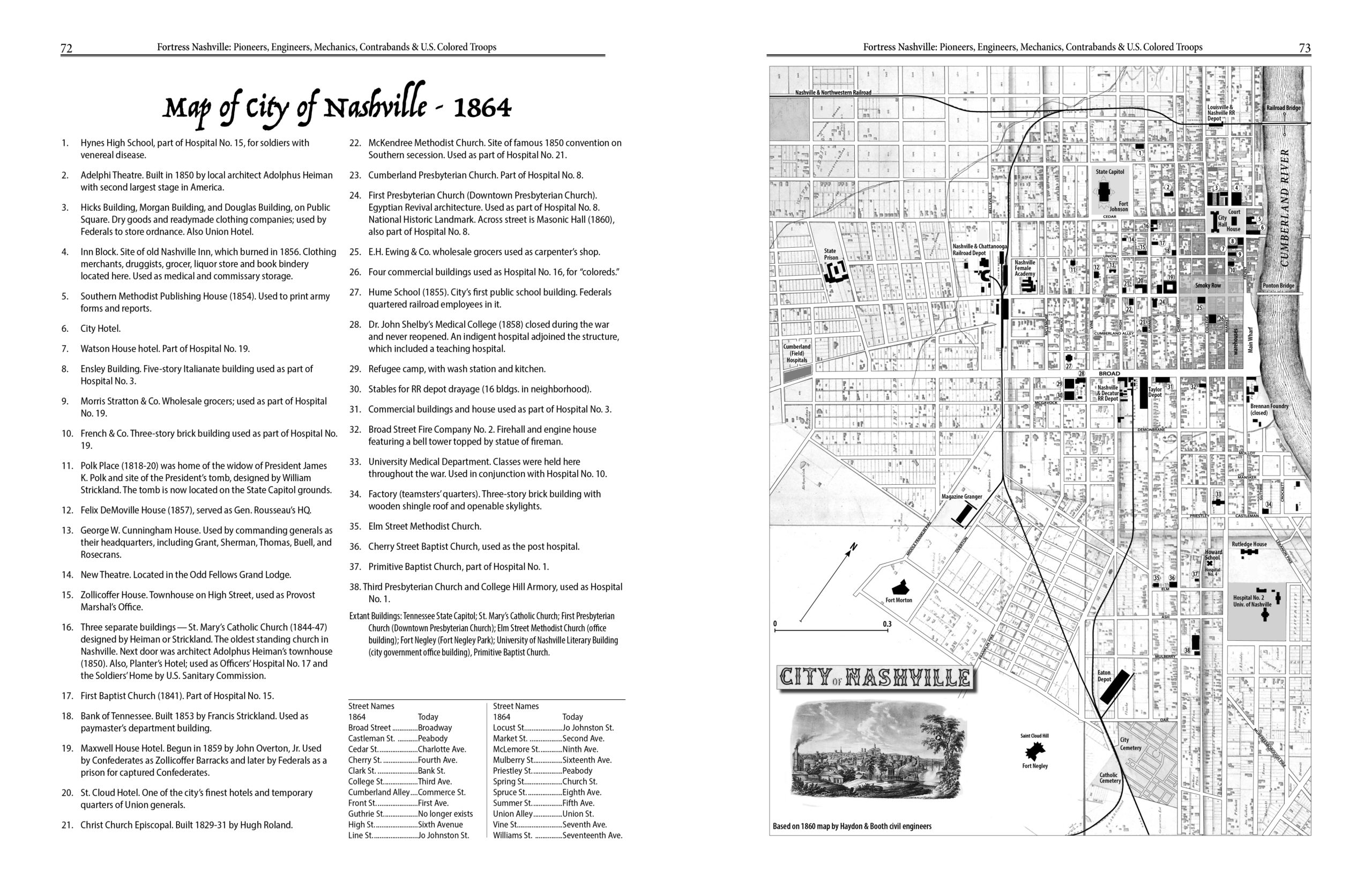
Sample page from Fortress Nashville, showing detailed fortifications map of Nashville (double click to enlarge)
The author has provided BONT with a link — Fortress Nashville At-A-Glance — showing a representative sampler of 56 pages of content, text, maps, photos, and illustrations, to give readers an idea of both the depth and range of the book. Fortress Nashville is available on Amazon. For more information about Mark Zimmerman, Fortress Nashville, and his other publications, visit his website at www.zimcopubs.com.
Review: In a May, 2022 review, “Civil War Books And Authors,” an independent, non-fiction American Civil War book review journal, noted that Fortress Nashville “ranks among the most compelling descriptive and illustrated histories of major Civil War fortification networks.” Pointing out that numerous other works have acknowledged the immense strength of the fortifications built in and around Nashville during the War, “details have always been sparse, and certainly no single volume has approached the level of comprehensiveness displayed in Mark Zimmerman’s new book.” The entire review can be read at https://cwba.blogspot.com/2022/05/review-fortress-nashville-pioneers.html.
March, 2022
MINNEAPOLIS CIVIL WAR ROUNDTABLE JOINS IN EFFORT TO RAISE PRESERVATION FUNDS FOR NASHVILLE BATTLEFIELD
Many Minnesotans both follow and support the preservation efforts of the Battle of Nashville Trust, and with good reason: Four Minnesota regiments engineered the final charge up Shy’s Hill on Dec. 16, 1864, sending the Army of Tennessee into retreat and ending the Battle of Nashville.
The exploits of the 5th, 7th, 9th and 10th Minnesota regiments came at a cost – the deaths of 98 Minnesotans — making that December 16 the deadliest day of battle for Minnesota soldiers in any battle in American history. Minnesotans made up one-third of the total casualties on the Nashville Battlefield.
Now, the Twin Cities Civil War Roundtable is putting out the word to its own membership, and others in Minnesota, to support BONT’s efforts to maintain and enhance the battlefield. Ken Flies, long-time friend and supporter of BONT and a principal in the placement of the Shy’s Hill monument honoring Minnesota soldiers, is a former president of the TCCWRT and has sent their most recent newsletter focusing on the Battle of Nashville. Read Ken’s newsletter at Twin Cities Civil War Roundtable Newsletter: Nashville , and for more information, click the photo below to visit the TCCWRT website.
February 25, 2022
ROBERT HICKS: CIVIL WAR PRESERVATION LOSES PASSIONATE CHAMPION
Robert hicks, best-selling author and acclaimed Civil War preservationist, passed away on Feb. 25, 2022, at his home near Leiper’s Fork, TN. He was 71.
Hicks was heavily involved with preserving the historic sites of the Battle of Franklin. His many achievements and accolades included his highly-praised novel, The Widow of the South, a work of historical fiction depicting the life of Carrie McGavock at her home, Carnton Plantation. The plantation house is one of the centerpieces of the preserved portions of the Franklin battlefield.
The novel, which acted as a tourist and financial magnet for the maintenance of Carnton, resulted in Hicks being named Tennessean of the Year in 2005 by The Tennessean. He was also honored as co-founder of Franklin’s Charge, a coalition of various Franklin preservation groups which resulted in the acquisition of previously commercially-developed battlefield acreage. Among his many other awards, the American Battlefield Trust presented him with the coveted Edwin C. Bearrs Lifetime Achievement Award in 2018.
The Battle of Nashville Trust joins in the tributes to Robert Hicks, not only for his work in Franklin, but also because his legacy of promoting the cause of historical preservation of Civil War sites also had a positive impact on the Battle of Nashville Trust’s mission to save and reclaim portions of the Battle of Nashville battlefield.
For further reading about his extensive contribution to keeping the battle sites secure for future generations, see the obituary of Robert Hicks and many other tributes to him, such as this one.
Feb. 15, 2022
Vanderbilt Professor Summarizes Use Of Modern Technology To Uncover Secrets of the Battlefield Which Have Been Hidden By Time
Brandon Hulette, Asst. Professor of History at Vanderbilt University and a member of the Battle of Nashville Trust board, spoke on the topic “Old Story, New Tricks” at the Nashville Civil War Round Table on Feb. 15, 2022, discussing how technological tools are revealing details about the battlefield that have been hidden by time. Below is a report on the talk by former BONT president and current board member Philip Duer:
Professor Hulette, accompanied by multiple staff and students from his recently formed Civil War classes, descended upon the Battle of Nashville last year armed with modern technology to begin a fresh look at one of the largest Civil War battlefields of the war. With grants and donations, including funds from BONT, Prof. Hulette (Lt. Col., U.S. Army Reserves) established several test sites around the exterior environs of Fort Negley and Shy’s Hill using ground penetrating radar and magnetometers investigating the historical record below the surface without actually disturbing the ground.
While the laborious field work commenced on the ground, other students and staff digitally created story-mapping overlays utilizing GIS, satellite images, contemporary photographs, and first person accounts to record, verify, and document the fortifications and battle lines.
A separate set of students and staff began digitally documenting the activities of the Union “Brown Water Navy” and in what has not been done before, pinpointing the daily locations and skirmishes of the Union military craft on the Cumberland River leading up to, during, and after the actual battle. The mapping locates, on a daily basis, the ships involved, the type of action, and the results in an interactive format.
In his discussion at the NCWRT, Prof. Hulette could not emphasize enough the importance of the Union gun boats protecting the flanks of the Nashville fortifications, especially the northeast flank past Rutledge Hill (in the old General Hospital area).
Another group of students tasked themselves with researching, locating and digitally documenting the plethora of U.S. Hospitals established in the City of Nashville during the War, as Nashville was the final care destination for all Western Theater casualties. Utilizing story-mapping technology, a detailed report for each hospital, including photographs, and locations, were digitally mapped.
Reviewing contemporary photographs, first person accounts, previous recorded battlefield maps, and satellite imagery, Prof. Hulette and his crew began the study of several test sites employing GPR and magnetometer studies, with the resulting discovery of several interesting phenomena:
- Fort Negley: Civil War period maps indicate that there had been significant entrenchments around the fort during the war, but which are no longer visible above ground. However, GPR technology has revealed parallel straight lines of subsurface disturbance which indicate the existence of earthworks, with one anomaly appearing to represent a Bomb Proof. Straight lines generally do not appear in nature and the disturbances that were found were consistent within the 2 foot depth below the ground where Civil War strata would be found. It is hoped with further funding, additional grids can be marked and searched;
- Shy’s Hill: In Prof. Hulette’s search locations, below the crest and below the assumed trench line on the north slope, the test areas denoted several areas of disturbed soil. One feature demonstrated a right angle and straight lines with both test sites posing more questions than answers.
As an assistant professor at Vanderbilt in the History Department, Prof. Hulette has established two classes with the Civil War as their topic at the University. They have been a huge success. Students who have really never entertained learning about this time in our nation’s history have developed a keen interest and are adding to the wealth of knowledge by their work with modern technology.
December 15 – 16, 2021
A REMEMBERANCE IN PHOTOS: 157 YEARS AFTER THE BATTLE OF NASHVILLE
On December 16, 2021, an approaching cold front brought a light drizzle and low skies just before dusk, not unlike the same date 157 years ago when the top of the Hill was engulfed in a violent clash of armies. Unlike that long ago day, however, the temperature was almost 70 – more than 40 degrees warmer than the day the Battle of Nashville ended. Despite the weather, the Battle of Nashville Trust continued its tradition of honoring those who fought in the two-day battle with commemorative wreathes placed at Shy’s Hill and Redoubt No. 1, and by gathering in the gloomy twilight to hear its historians recount the details of a major Civil War battle that occurred where Nashvillians now live in quiet neighborhoods. Below is a photo essay by BONT board members John Banks and Mark Martin.
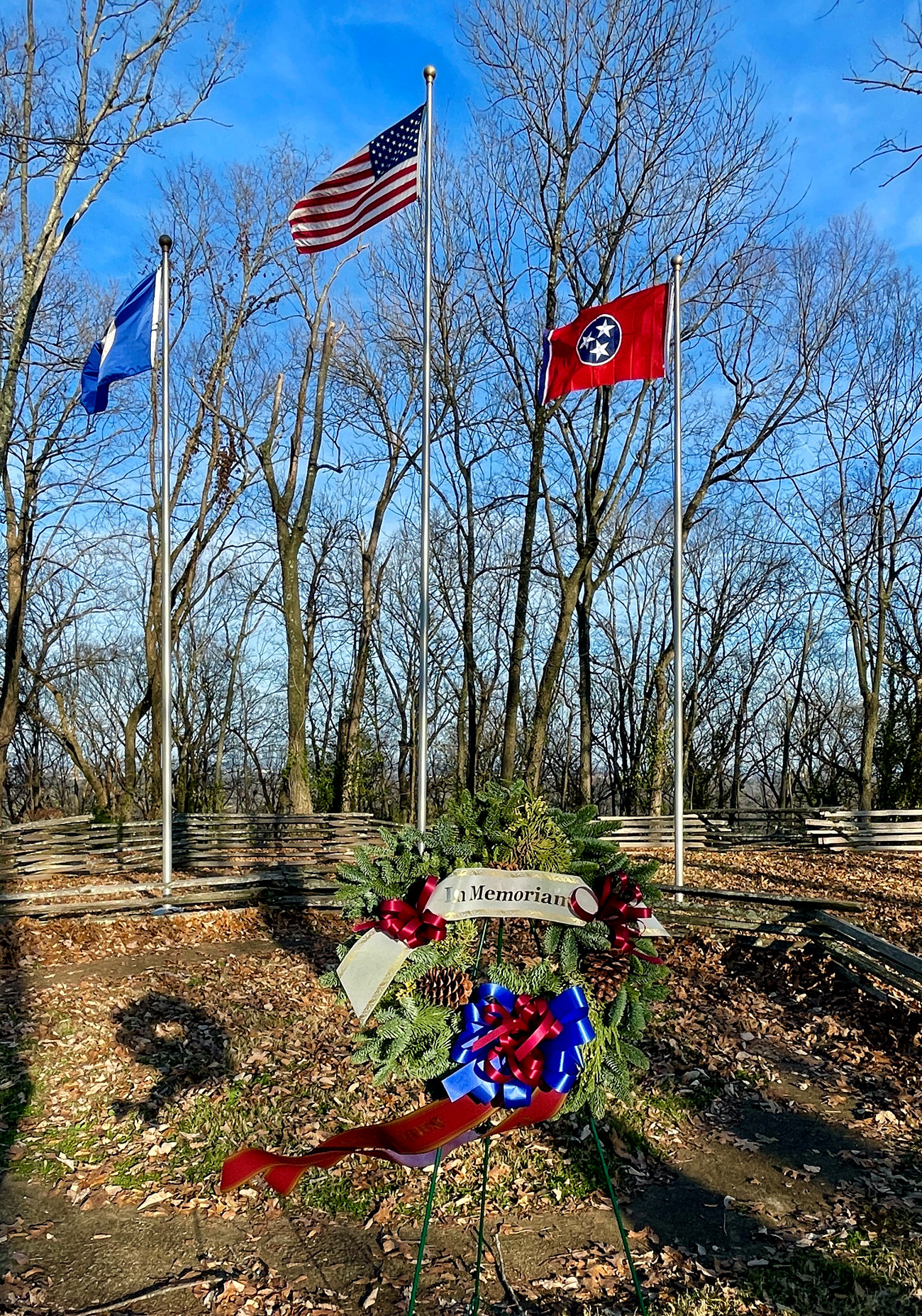
Shy’s Hill flag pavilion with commemorative wreath, with thanks to BONT board member Ellen McClanahan. Photo by Mark Martin
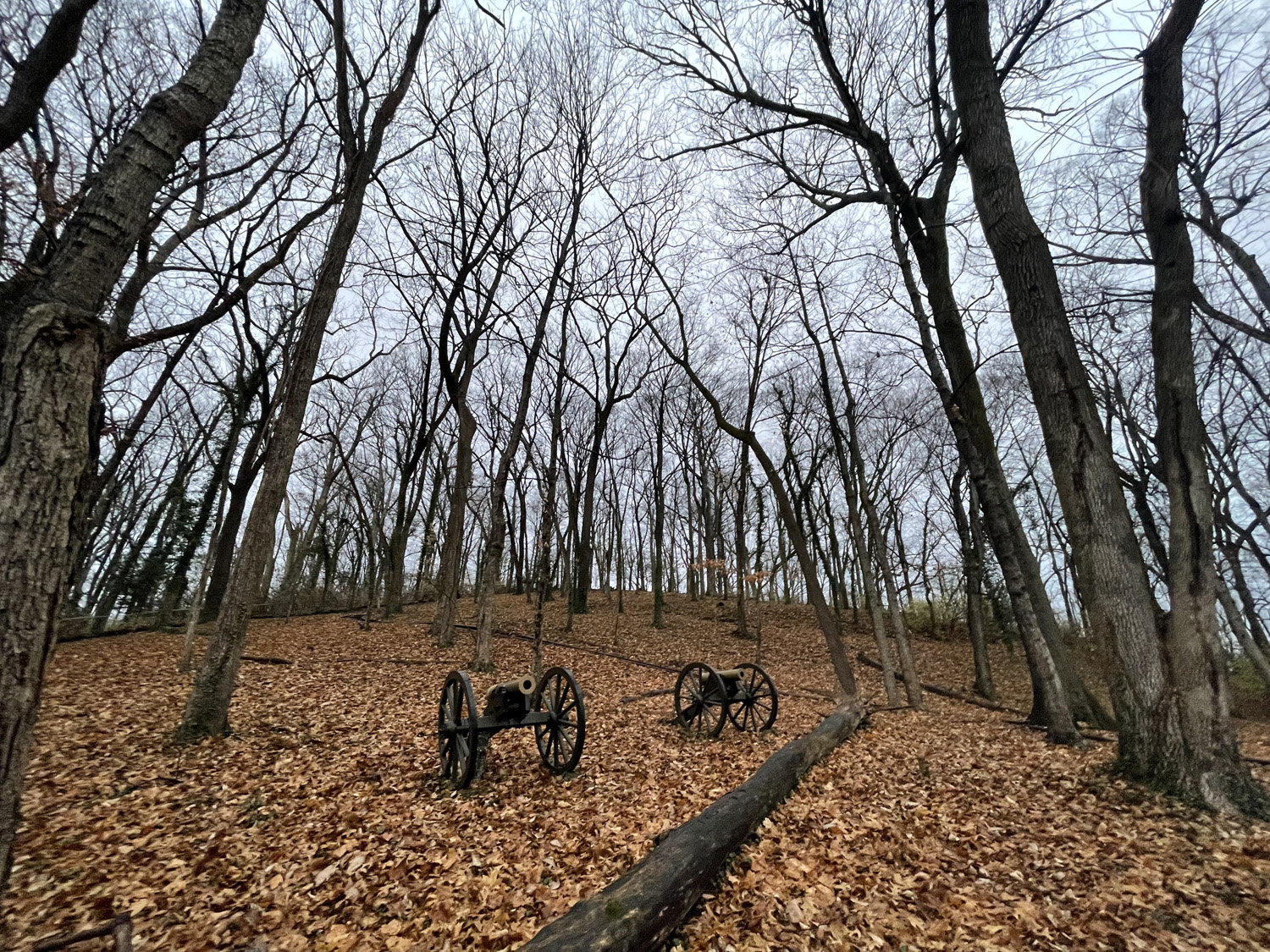
Field pieces mark the plateau of Shy’s Hill’s imposing northeast slope, the only location Hood could get an artillery battery in place on Dec. 16. Photo by John Banks

BONT President Jim Kay recounts the valor and tragedy of Shy’s Hill at wreath ceremony. Photo by John Banks
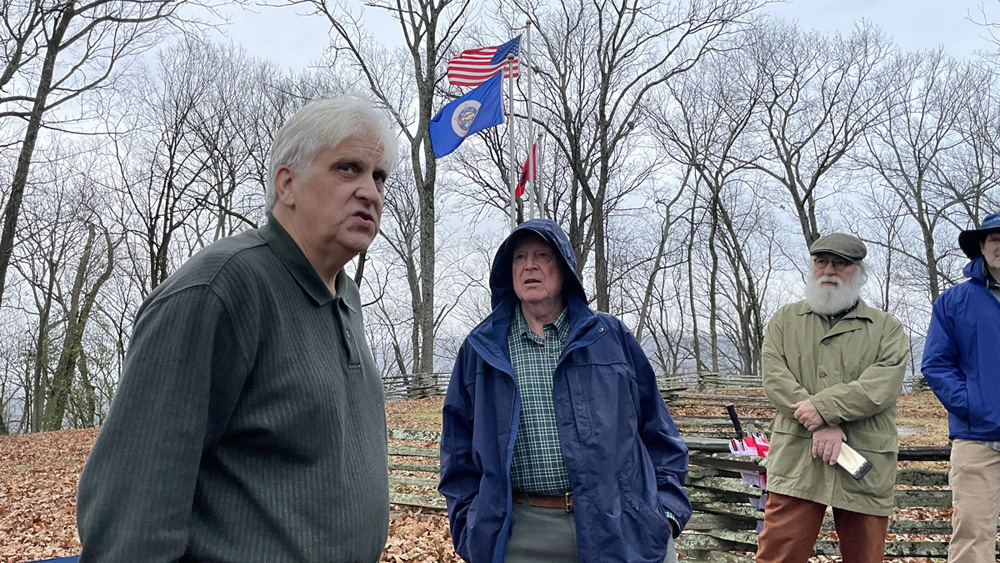
BONT historian Ross Massey, with BONT incoming president Bill Ozier, summarizes the attack at the summit. Photo by Mark Martin
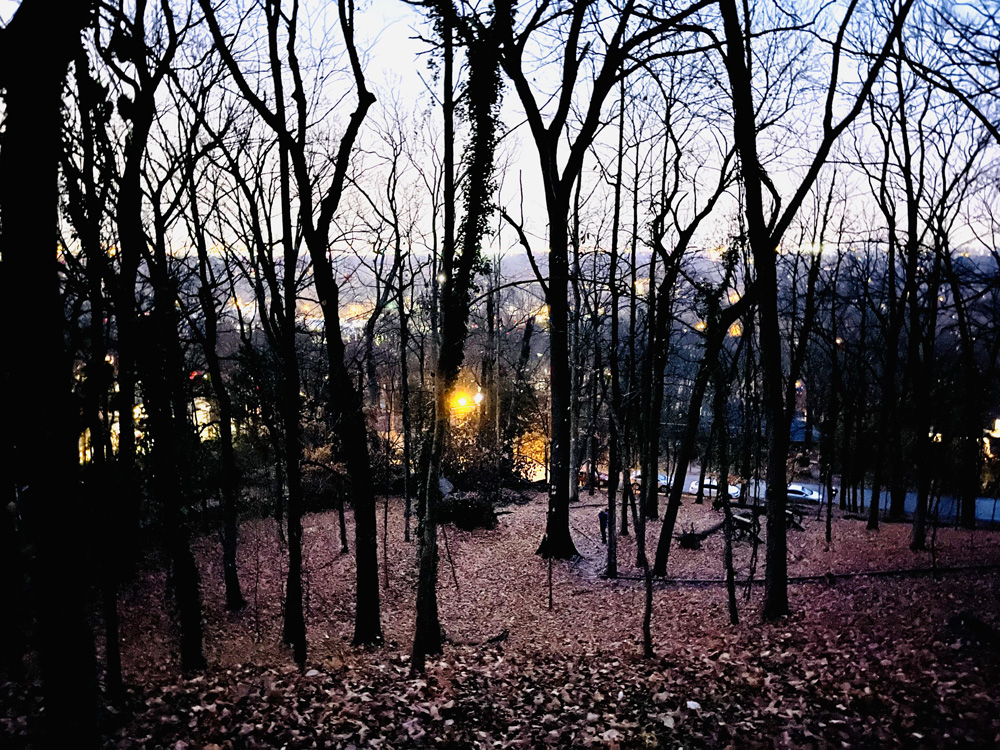
The lights of Nashville surround the solemnity of the hill on which so many died in 1864. Photo by John Banks.
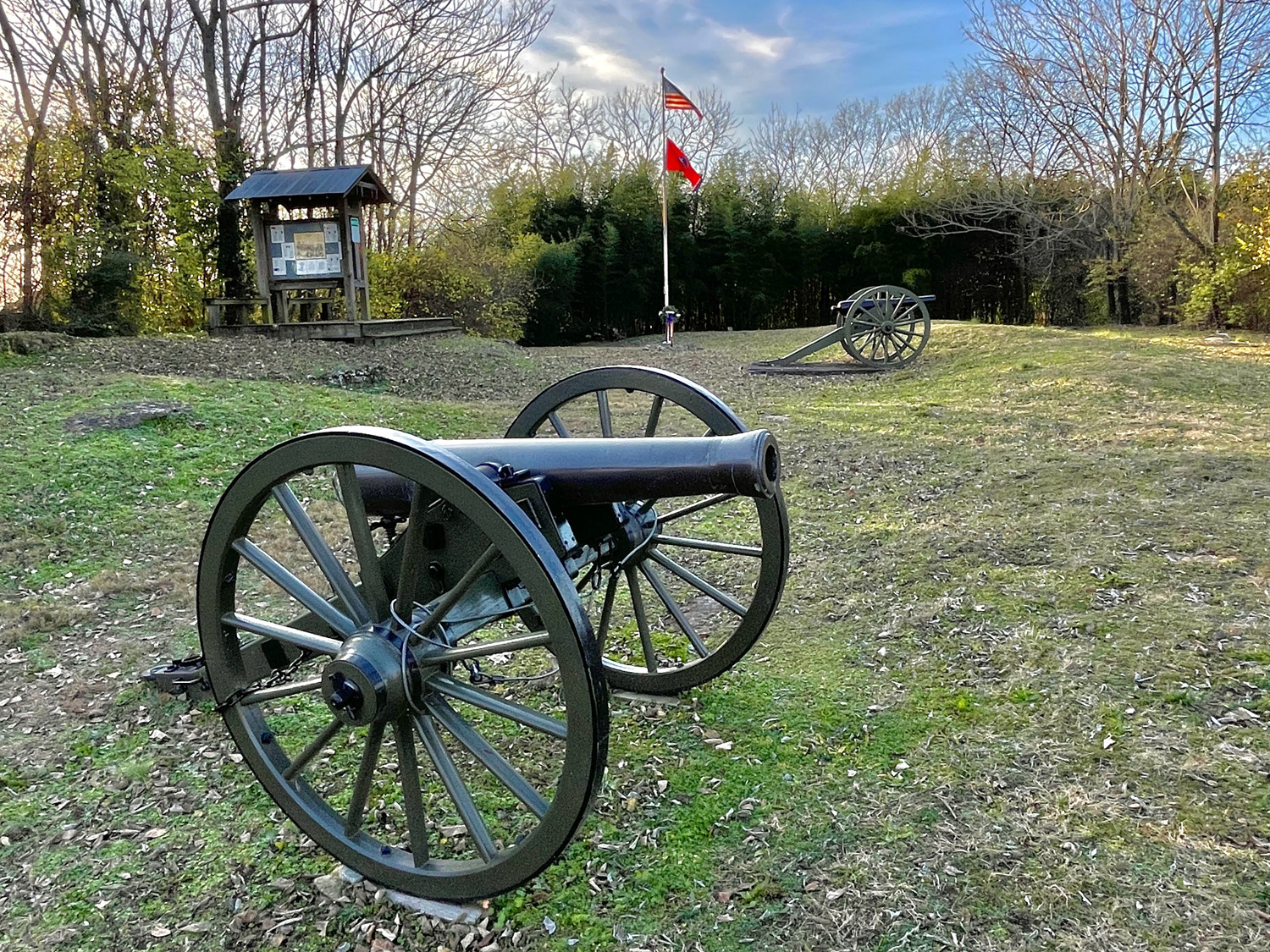
A memorial wreath stands at the flag pole of Redoubt No. 1, behind the two artillery pieces that would have had heated barrels on Dec. 15, 1864. Photo by Mark Martin
December 7, 2021
BONT RELEASES STATEMENT REGARDING REMOVAL OF NATHAN BEDFORD FORREST STATUE NEAR INTERSTATE 65 IN NASHVILLE
On Dec. 7, 2021, the Board of Directors of the Battle of Nashville Trust, Inc., in association with and approval of the Executor and legal counsel for the Estate of William Dorris, released the following Statement commenting on and explaining the disposition of the statue of Gen. Nathan Bedford Forrest previously standing on property owned by Mr. Dorris:
Statement from The Battle of Nashville, Trust, Inc., Trent Watrous, Executor of the Estate of William C. Dorris, and Todd Presnell, Counsel to the Executor
The Battle of Nashville Trust, Inc. (the “BONT”), Trent Watrous, the Executor of the Estate of Charles William (“Bill”) Dorris, and Todd Presnell, counsel to the Executor, released the following statement today (December 7, 2021) regarding the Nathan Bedford Forrest statue along Interstate 65 in Nashville, Tennessee:
Charles William (“Bill”) Dorris passed away on November 24, 2020. Under Mr. Dorris’ Last Will and Testament (the “Will”), Mr. Dorris left his property on Hogan Road in Nashville containing the Nathan Bedford Forrest statue to the BONT. Mr. Dorris had no prior affiliation with the BONT and the BONT had no idea it was a beneficiary of his Will until well after Mr. Dorris passed away.
The BONT, in consultation and with the approval of Trent Watrous, the executor of Mr. Dorris’s estate, made the decision to remove the Nathan Bedford Forrest statue from the Hogan Road property that Mr. Dorris had left the BONT in his Will.
This decision was made for several reasons-each reason sets aside the contentious debate about Forrest as a person or as a Confederate general:
1. Forrest was not present at The Battle of Nashville.
2. The statue is ugly and a blight on Nashville.
3. It has been vandalized, is in disrepair, and is dangerous.
4. Having the statue in such a prominent location in Nashville distracts from the BONT’s mission and would be and has been divisive in the city we all cherish.
The Estate of William C. Dorris remains open in the Davidson County Probate Court, and no decision has been made regarding the statue’s disposition or location.
The Will also set up a separate trust where three distinctive segments of the Hogan Road property will be held in trust. These three distinctive segments are for property containing a pre-Civil War ice house, a pre-Civil War artisanal well, and a flag display of state flags of states that joined the Confederacy. These three items (the flag display, the ice house, and the well) will be preserved in trust, pursuant to Mr. Dorris’s wishes.
We would also like to provide some additional context about the preservation of history, which is critical. The Nashville battlefield was one of the largest in the Civil War and the least protected. It spans from the Cumberland River near Charlotte Pike east to the other side of Nolensville Road and South from the hills just south of town all the way to Brentwood. The core battlefield covers most of Green Hills all the way east to I-65. The citizens of Nashville tried to protect some of the site as early as the 1920s but were unsuccessful. Development and time have made the battlefield virtually unrecognizable. However, the BONT, in conjunction with its partners including Metro Nashville, have been able to save some of the sites for all Americans. The interest in the Civil War and the battle here is huge. The BONT has had over a million visitors to our website from all over the country and the world. People want to know where their great great great grandfather fought and his roots in time and history.
The BONT is proud of what it has accomplished. The BONT’s sites are hidden gems in the community-protected forever-for all to enjoy.
The battle here was perhaps the most decisive victory for the United States during the war and it ended major fighting in the western campaign. The largest attack of the war by African Americans -the USCT-occurred here on Franklin Pike near Battery Lane and their casualties were enormous. History is important. And it is all in our backyards. The Battle of Nashville was a pivotal moment in our nations bloodiest conflict. The Hogan Road property is not core battlefield land. It is a sliver of the retreat. Given the factors outlined above, the BONT, in consultation and with the approval of Trent Watrous, made the decision to have the statue removed.
James D. Kay, Jr., The Battle of Nashville Trust, Inc.
Trent Watrous, Executor of the Estate of William C. Dorris
Todd Presnell, Counsel to the Estate of William C. Dorris
2023 Update: After its removal by the parties to the joint Statement above, the statue was disassembled and moved from the site. It will not be remounted or displayed.
September, 2021
SMOOTHBORE ARTILLERY PIECE DONATED TO BONT, TO BE OUTFITTED FOR DISPLAY ON NASHVILLE BATTLEFIELD SITE
The Battle of Nashville Trust (BONT) has been gifted with a reproduction 6-pounder field artillery piece based on those manufactured during the Civil War by the famous Noble Brothers Foundry of Rome, Georgia.
The cannon was donated by Ms. Graham Woolwine-Gilson, a Nashville native now living in Mamer, Luxembourg. When displayed by BONT, the cannon will be accompanied by a bronze plaque stating, “Donated in memory of Porter Anthony (Tony) Woolwine.”
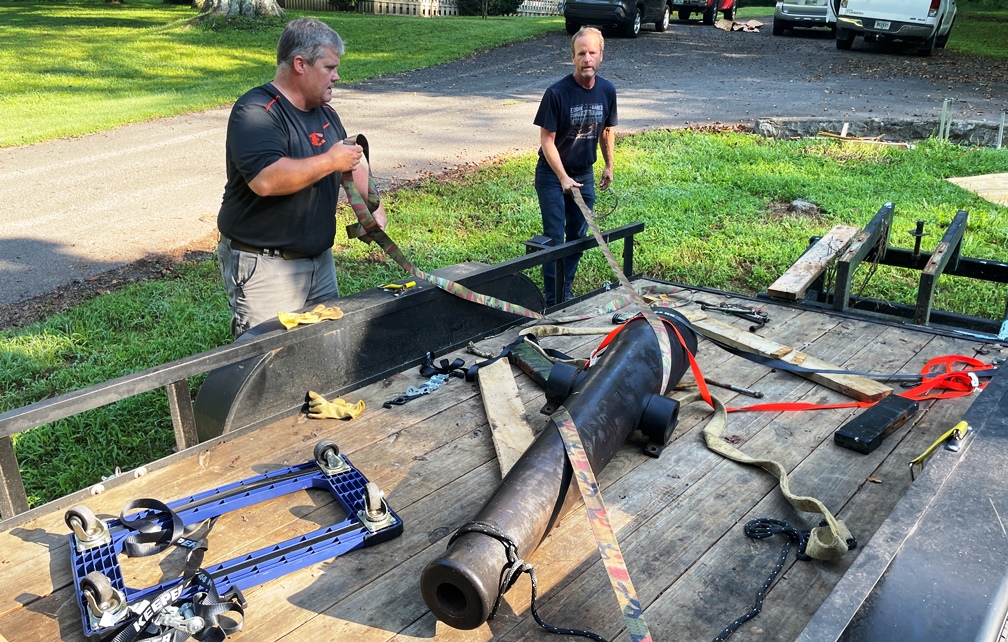
BONT Board members Bobby Whitson and Pete McAlister prep cannon for delivery to Commercial Painting Inc. Photo by Mark Martin
The gift consists of a replica 6-pounder iron cannon tube designed to resemble those manufactured by Noble Brothers, a large ironworks factory in Georgia producing pre-war items such as steam boat engines, locomotives and furnaces. During the war, it turned some of its production to cannons for the Confederacy. The factory was burned to the ground by Gen. William Tecumseh Sherman in 1864, with nothing remaining except the huge lathe machinery used in cannon production.
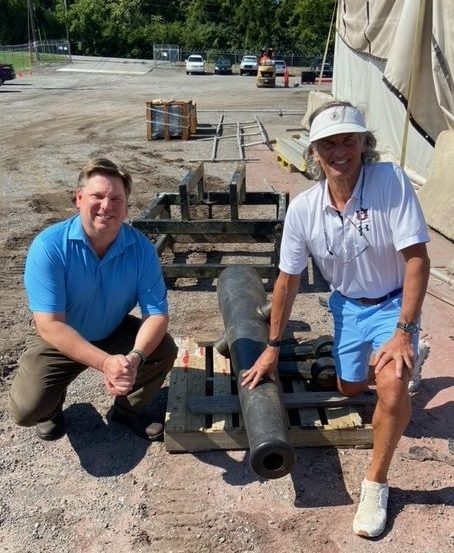
Commercial Painting CEO Jon Petty (L) and BONT President Jim Kay (R), after the Noble Brothers tube had been delivered to prepare it for display.
In his letter accepting the canon barrel on behalf of BONT, President Jim Kay expressed special thanks and noted that it would be placed on “one of the battlefield properties for all to enjoy for decades in the future,” and that “it is people like you that make a difference in what we do.”
The cannon tube, weighing close to 1,000 pounds, was transferred by BONT board members Bobby Whitson, Mark Martin and Pete McAlister from its location in Nashville to Commercial Painting, Inc., where it will be sand-blasted and re-painted.
Afterwards, it will have to be mounted on a custom-built carriage in order to be placed, according to current plans, at BONT’s Redoubt No. 1 preservation site on Benham Avenue.
The muzzle-loading 6-pounder field gun was so-named because it was designed to fire a 3.58 inch-in-diameter round shot that weighed approximately 6 pounds for a range of about 1200 to 1500 yards, depending upon the type of shot used. In addition to solid shot, it could also fire case and canister. It was largely replaced by the U.S. Army early in the war with more advanced artillery, such as the 12-pounder Napoleon smoothbore, but was in use for a longer period by the Confederate armies.
July 22, 2021
VANDY MILITARY PROFESSOR GOES “UNDERGROUND” AT SHY’S HILL
The original surface of Shy’s Hill, which has been partially obscured by 157 years of time and activity since the 1864 battle, was “x-rayed” on July 22, 2021.
The imaging occurred when Vanderbilt military science professor Brandon Hulette took his students and his ground-penetrating radar equipment to the summit to take a look below the surface. Professor Hulette was recently featured on this website because of the advanced technology he is using to explore Battle of Nashville sites, as part of his course, “Telling the Story of Civil War Nashville.”
Below is a “live video” of Hulette, produced by BONT board member John Banks, explaining the process of exploring subterranean Shy’s Hill. The results of the ground-penetrating imaging will be posted on our website.
For more details, visit NewsChannel 5 WTVF’s newscast story about Professor Hulette and his team, as well as John Banks’ Civil War Blog.
July 20, 2021
NASHVILLE CIVIL WAR ROUNDTABLE RETURNS WITH ENTERTAINING GUEST SPEAKER
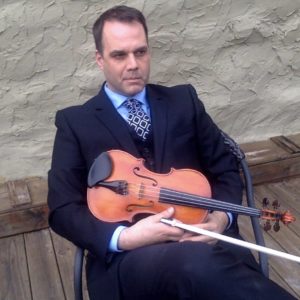 The Nashville Civil War Roundtable will resume its 12-year run of war-related presentations on Tuesday, July 20, 2021, with a unique look at the history of the Civil War through the music and legacy of fiddles. The meeting, which is open to the public, will be held in the visitor’s center of Ft. Negley Park in Nashville, beginning at 7:00 p.m.
The Nashville Civil War Roundtable will resume its 12-year run of war-related presentations on Tuesday, July 20, 2021, with a unique look at the history of the Civil War through the music and legacy of fiddles. The meeting, which is open to the public, will be held in the visitor’s center of Ft. Negley Park in Nashville, beginning at 7:00 p.m.
The guest speaker is author Cody Engdahl, whose topic “A Brief History of the Civil War Through Fiddle Tunes” will focus on the prominence of the fiddle in 19th Century in America and the role it played on both sides during the Civil War. The Roundtable noted that Engdahl, who lives in Nashville, “will be regaling us with his fiddle tunes from the Civil War as well as those written about the war. The music will be interwoven with stories of the era.”
He has published two Civil War books, Rampage on the River: The Battle for Island No. 10 and The Perils of Perryville, and currently researching and writing his third, Blood for Blood at Nashville.
December, 2020
“TENNESSEE WILD SIDE” TV SHOW FEATURES LOSS OF FAMOUS BATTLE OF NASHVILLE WITNESS TREE
In June, 2020, the Richland Country Club reluctantly removed from its golf course a 400-year-old Bur Oak that had witnessed events ranging from buffalo herds to the Battle of Nashville. In December, 2020, the history of the “Witness Tree” was featured on Tennessee’s Wild Side, the outdoor adventure program produced by The Renaissance Center in Dickson, TN, and the Tennessee Wildlife Resources Agency.
The video (see below) features host Steve Hall introducing experts who help viewers explore the amazing timeline of the Witness Tree and all that it had seen and been a part of since it sprouted around the time the Pilgrims landed at Plymouth Rock. The narration includes that of Jim Kay, president of the Battle of Nashville Trust and past president of Richland Country Club, where the tree had lived out its last years.
More facts about the Witness Tree can be found on this website in the Features Page, including an interview with Jim Kay shortly after the tree was removed.
Produced through an educational grant from TWRA, Tennessee’s Wild Side is a family oriented outdoor adventure program featuring outdoor sporting and recreation activities, wildlife conservation, and human interest stories. The program airs on Public Broadcasting Stations across Tennessee.
September 15, 2020
ED BEARSS, PREEMINENT BATTLEFIELD HISTORIAN AND FRIEND OF BONT, DIES AT AGE 97
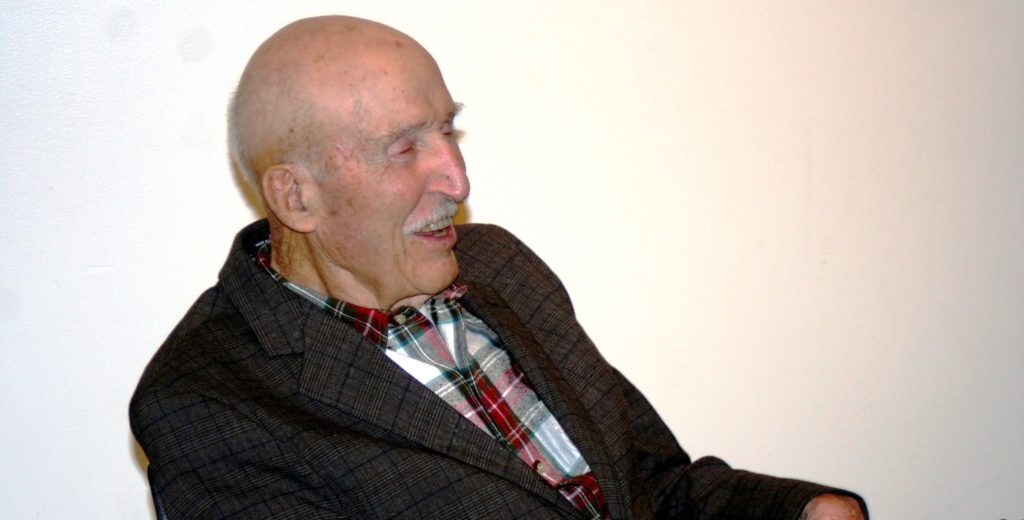
Legendary Civil War battlefield preservationist, historian and tour guide Edwin C. “Ed” Bearss, a friend of The Battle of Nashville Trust whose members well remember his captivating walks and talks on the Nashville battlefield, died on September 15, 2020, at the age of 97.
As an expert on the battlefields of the Civil War, Bearss was virtually without equal. He began a career with the National Park Service in Vicksburg, Mississippi in 1955 and rose from that position to become Chief Historian for the National Park Service in 1981, a position he held until his retirement in 1995. His extraordinary expertise and career are thought by many to have created and fueled the battlefield preservation movement involving organizations such as The Nashville Battlefield Trust.
BONT’s relationship with Ed Bearss not only included his most recent visits to Nashville in 2013 and 2014, but also the publication of the one-hour video “The Life and Times of Ed Bearss,” produced and directed by Nashville’s David Currey, with executive producer Jim Kay, president of BONT (see DVD cover with link below).
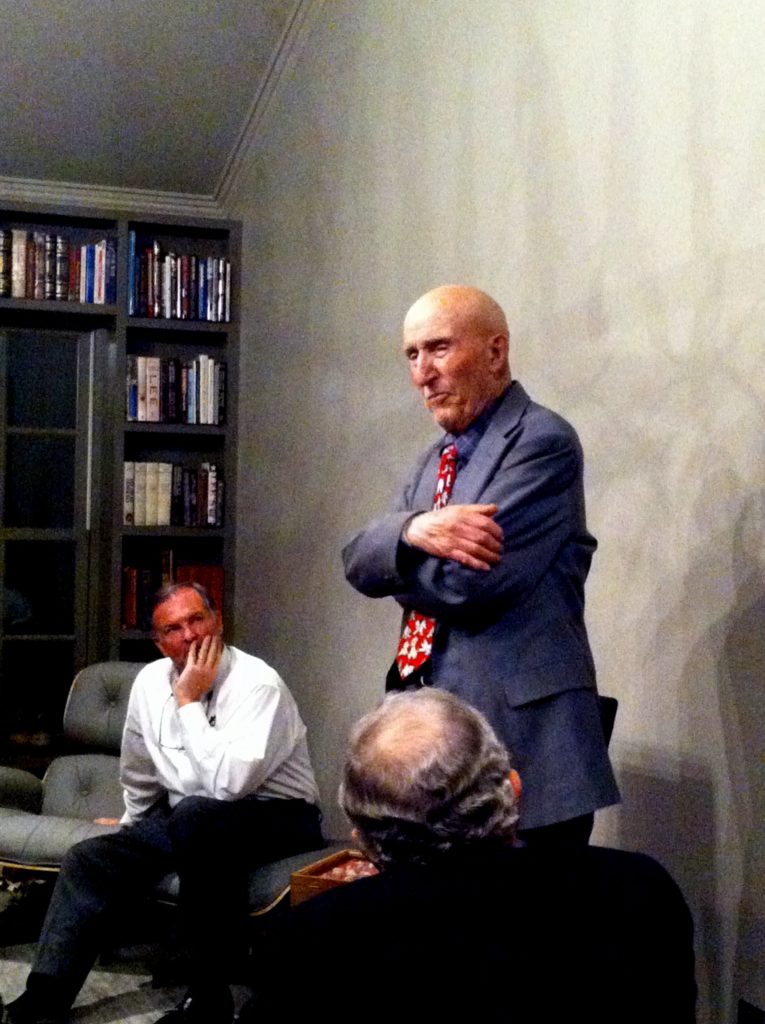
Above: Ed Bearss enthralls his audience in Nashville on December 6, 2013. Click the photo to hear him reveal which CW battlefield was the most moving to him.
On December 6, 2013, BONT and Travellers Rest co-sponsored a joint evening at the home of BONT President Jim Kay. Then 90 years old, Bearss spoke in his legendary “booming tour voice” for 40 minutes, without notes, mesmerizing the standing-only crowd with an anecdote-packed summary of Hood’s march into Tennessee in 1864. Afterwards, he signed copies of some of the 16 books that he had authored, brought along by attendees seeking his authoritative signature.
The next morning he braved the threat of a winter ice storm to lead a day-long bus tour of eight key areas of the Nashville battlefield, including Travellers Rest, Granbury’s Lunette, Redoubts 1 and 3, Ft. Negley, City Cemetery, John Trotwood Moore school, Shy’s Hill and Peach Orchard Hill. Participants said the battlefield “came alive” as Bearss displayed his expertise as a nationally-recognized Civil War tour guide. He often said that you cannot describe a battlefield unless you have walked on it.
Bearss returned to Nashville a year later when BONT commemorated the 150th anniversary of the Battle of Nashville on December 15-16, 2014. In the grand finale of the 4-day city-wide program, BONT hosted a sold-out Sesquicentennial event at Travellers Rest on the evening of December 16, 2014 – 150 years to the day after the Confederate army had retreated south along nearby Franklin Pike as the Battle of Nashville came to a close. Those in attendance that evening knew they were witnessing another kind of history, a 91-year-old legend in the annals of Civil War history and battlefield preservation, discussing the battle on its 150th anniversary, at the house that had been used by Confederate Gen. John Bell Hood as a headquarters in 1864.
Ed Bearss was born and raised in Montana, and though it was far away from the primary Civil War battlefields he later explored as no one else, he became so hooked on their history that he named his favorite milk cow “Antietam.” He joined the Marines after Pearl Harbor and was severely wounded by Japanese machine gun fire while fighting on the Pacific island of New Britain.
After returning to the States and enduring 26 months of recovery from his wounds, he continued his interest in history with a degree from Georgetown University and eventually threw himself into the world of Civil War history with his position in Vicksburg. During his lengthy career with the Park Service, Bearss was constantly traveling to all of the historic sites of the Civil War, and developed a unique ability as a guide that enabled others to “see and feel” the field of conflict.
Bearss won numerous awards during his career, and authored, co-authored or edited 30 books, most pertaining to the Civil War, along with numerous articles and other publications. He was a prominent commentator in the Ken Burns Civil War documentary film.
“For those of us who value the preservation and perpetuation of American history, few figures are more revered than Ed Bearss. His knowledge, passion and energy were without equal, and he will be missed tremendously by so many,” said James Lighthizer, President of the American Battlefield Trust.
“Ed’s decades-long commitment to protecting special places and making the stories of our past come to life laid the groundwork for organizations like ours, which will embody his legacy for generations to come.”
As noted above, David Currey and Jim Kay of Nashville produced a DVD describing the remarkable life and career of Ed Bearss. They can be purchased at the Battle of Nashville “Store” by clicking Bearss DVD cover below.
June 13, 2020
A NAPOLEON SMOOTHBORE CANNON RETURNS TO REDOUBT NO. 1 AFTER 155 YEARS
The Napoleon that once stood sentinel on the summit of Shy’s Hill is now back on duty, this time at Redoubt No. 1 — the first of its kind to guard the Redoubt since the battle there on December 15, 1864.
On June 13, 2020, a small contingent of the BONT Board moved the reproduction smooth-bore from its interim position at the home of Jim Kay, president of BONT, to the Redoubt. There, it joined up with the reproduction field piece, a 3-inch ordnance gun, that has stood at the wall for many years.
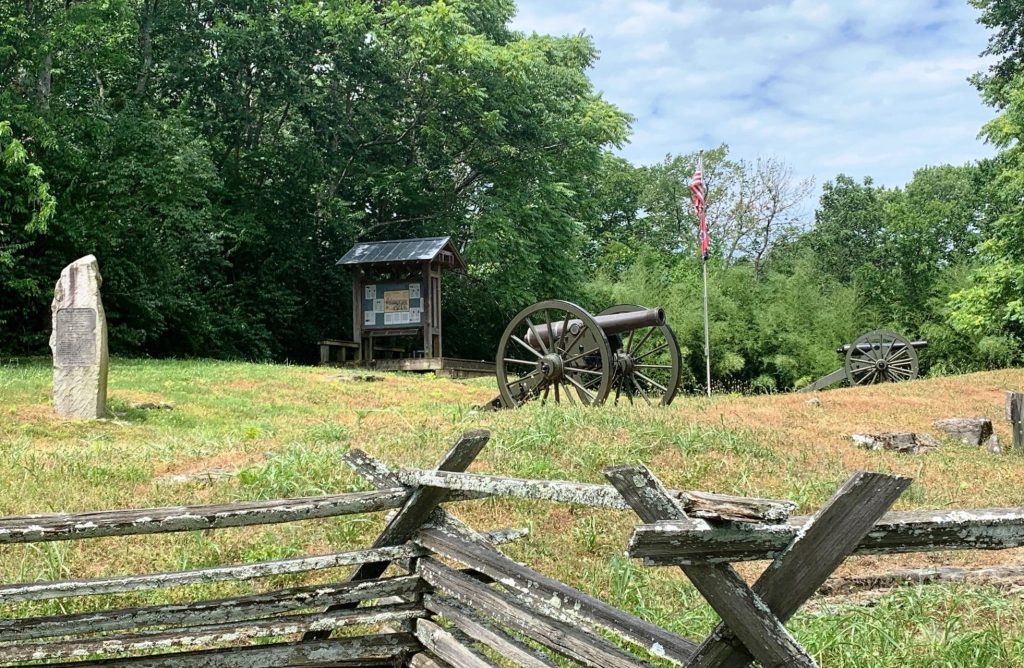 Above photos by Sidney McAlister
Above photos by Sidney McAlister
The Napoleon is more representative of actual conditions at the redoubt, which was designed to hold a battery of four of the big smoothbores. This area of the Confederate line was under the command of Maj. Gen. William Loring in Lt. Gen. Alexander P. Stewart’s Corps. The Redoubt was manned by approximately 200 troops, about half of which would have included artillerymen managing the guns. About 100 infantry were present to support the battery and defend the fort.
The Napoleon had been an important attraction at Shy’s Hill for more than a decade, but eventually deteriorated due to weather and had to be removed. It has now been rebuilt and was too heavy to replace on the summit. In addition, its original placement had been symbolic only, as there was no artillery at the summit during that battle on Dec. 16, 1864.
After the Napoleon was removed for rehab, BONT placed two replica field Howitzers on a flat “plateau” near the bottom of the eastern slope of Shy’s Hill, accurately reflecting the position of the few guns that could be readied for action on December 16. The Howitzers were part of the command of Capt. Rene T. Beauregard, son of Gen. P.G.T. Beauregard, and were later supplemented by several other field pieces.
The cannon was the inspiration behind graphic artist Elizabeth Harbin’s design of the new logo for the Battle of Nashville Trust in 2020.
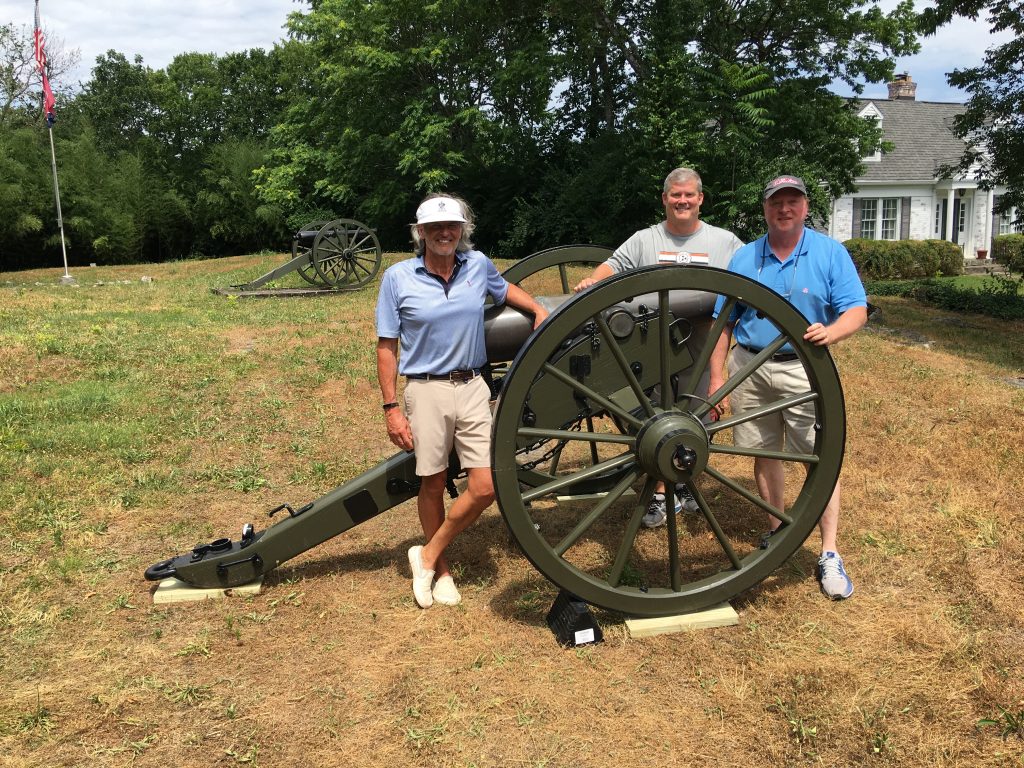 Above: BONT Board members Jim Kay, Bobby Whitson, Sidney McAlister, and Mark Zimmerman (taking photo)
Above: BONT Board members Jim Kay, Bobby Whitson, Sidney McAlister, and Mark Zimmerman (taking photo)
June, 2020
NEW BOOK FOCUSES ON 10-DAY PURSUIT OF CONFEDERATES BY FEDERAL TROOPS FOLLOWING DEFEAT AT SHY’S HILL
Battle of Nashville historian and author Mark Zimmerman has published a new book, Mud, Blood & Cold Steel, which focuses on events encompassing the retreat of the Confederate Army after their defeat on Shy’s Hill and the ensuing brutal, 10-day pursuit by Federal troops.
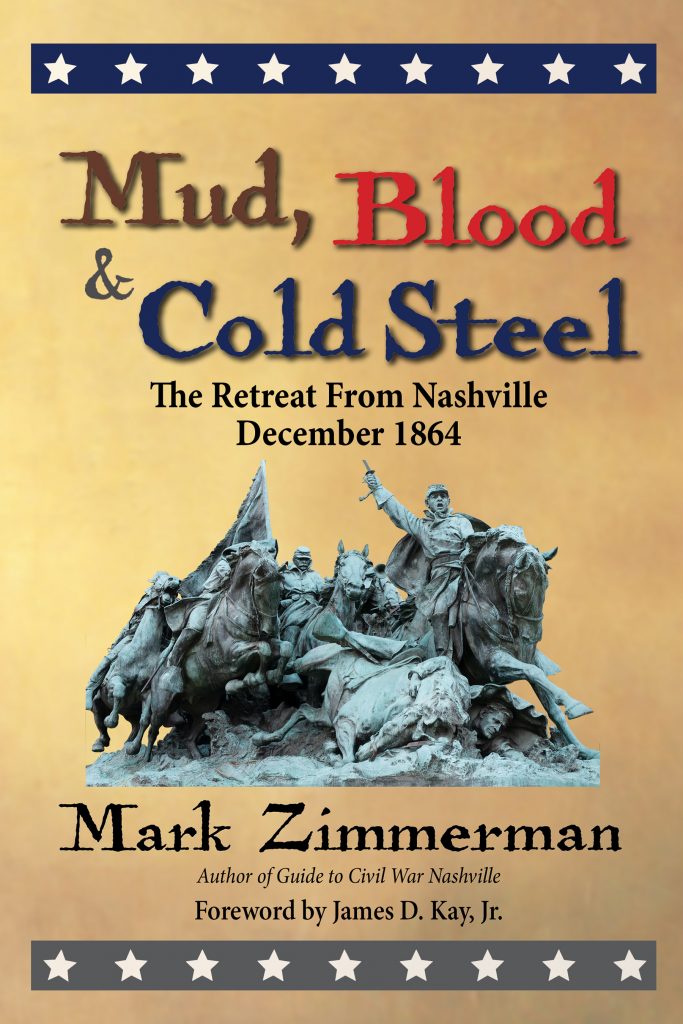 The publication announcement notes that the “non-stop action, much of it hand-to-hand combat, begins at Compton’s [Shy’s] Hill and surges 120 miles in ten days over rugged terrain and horrendous winter conditions to the final showdown between Wilson’s blue-clad troopers and Forrest’s stubborn rearguard.“
The publication announcement notes that the “non-stop action, much of it hand-to-hand combat, begins at Compton’s [Shy’s] Hill and surges 120 miles in ten days over rugged terrain and horrendous winter conditions to the final showdown between Wilson’s blue-clad troopers and Forrest’s stubborn rearguard.“
BONT president and historian Jim Kay wrote a Foreword to the book, which takes a rare, focused look at the post-battle action between the two armies which ended the foray of Gen. John Bell Hood into Middle Tennessee in November and December of 1864.
“So many books have been written about the famous Battle of Nashville but most have missed the details of the retreat down Franklin Pike, through the gap at present day Radnor Lake and the famous Battle of the Barricade on Granny White Pike that closed the fighting on December 16, 1864. Mark Zimmerman has been able to compile a concise overview of all the action, a very difficult task,” Kay wrote. Read his complete comments here: Foreword – Mark Zimmerman Book 2020.
Zimmerman is already well-known within Battle of Nashville historical circles as the author of his popular book, Guide to Civil War Nashville, a quick guide to all aspects of the Battle. An updated edition was published in 2019. Importantly, as noted by Jim Kay in the Foreword to this book (link above), the author donated all of the proceeds of the 1st Ed. of this book to The Battle of Nashville Trust.
Mud, Blood & Cold Steel, The Retreat From Nashville, December 1864 is available in paperback from Amazon for $19.95 (there is also a Kindle version). Its 192 pages include 16 maps, 8 of them featuring various aspects of the battle action.
Zimmerman is also the author of Iron Maidens and the Devil’s Daughters, and God, Guns, Guitars & Whiskey. He is president of Zimco Publications, LLC. For more information about the author, his publications and related matter, visit Zimco.Com
May 3, 2020
STORM WINDS DESTROY AWARD-WINNING “WITNESS TREE” NEAR SHY’S HILL
Nashville lost another Battle of Nashville Witness Tree on May 3, 2020, when a powerful storm known as a “derecho,” packing straight line winds of up to 80 mph, cracked the huge 200-year-old trunk of the Shumard Oak located at J.T. Moore Middle School.
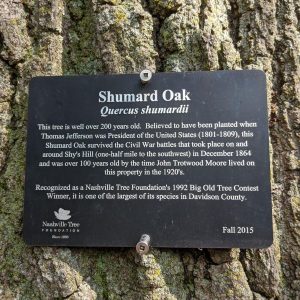 The behemoth tree was located about a half mile northeast of Shy’s Hill and would have been a witness to the fighting along the Confederate line just to its south on December 16, 1864.
The behemoth tree was located about a half mile northeast of Shy’s Hill and would have been a witness to the fighting along the Confederate line just to its south on December 16, 1864.
The massive tree was the 1992 winner of the Nashville Tree Foundation “ Big Old Tree Contest” and was estimated to be well over 200 years old. Even back in 1992, it was measured by the NTF to be 80 feet high and 205 inches in circumference. A plaque on the oak indicated that it was thought to have been planted when Thomas Jefferson became president in 1801.
According to the school’s website, “each year, this magnificent tree would reduce atmospheric carbon by ~1400 pounds and would intercept over 24,000 gallons of storm water runoff.”
J.T. Moore Middle School is a Metro public school located at 4425 Granny White Pike in South Nashville.
March 2020
BATTLE OF NASHVILLE GROUP ADOPTS NEW NAME, ANNOUNCES COMPREHENSIVE NEW PLANS FOR BATTLEGROUND SITES
The Battle of Nashville Preservation Society, protector of two of the most blood-stained sites of the Nashville battlefield, has announced a comprehensive new Master Plan to update its preservation agenda, including a new name and logo, placement of new monuments on the hallowed ground it maintains, and an aggressive membership and outreach campaign.
As of March, 2020, the 28-year-old non-profit will be known as “The Battle of Nashville Trust” (BONT). Steps are underway to begin changing the group’s identity, ranging from its website and social media presence on the internet to its interpretative signage and mailings.
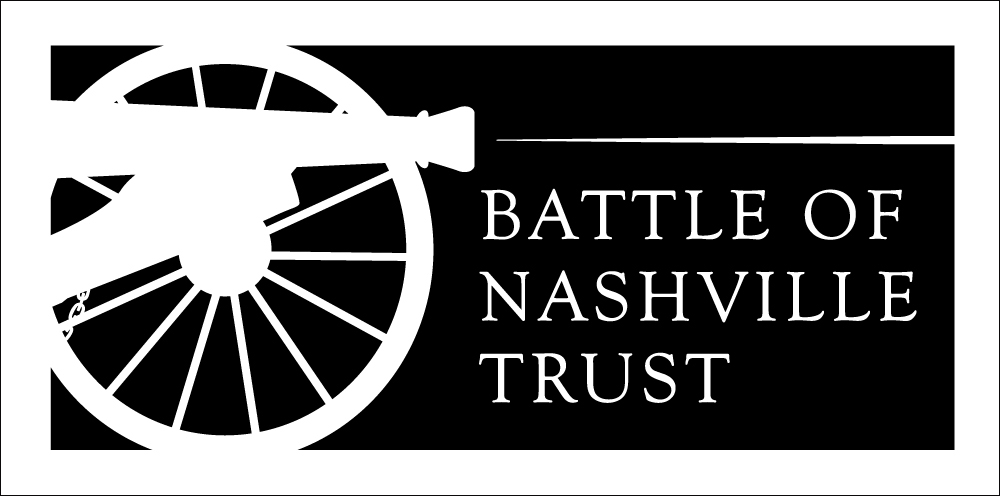
The organization was created in 1992 to acquire any remaining portions of the extensive battlefield, which encompasses most of south Nashville but which quickly underwent residential and commercial development before serious preservation of its historic landmarks could occur. It was able to secure and purchase Confederate Redoubt No. 1 as well as Shy’s Hill (the summit is leased from the Tennessee Historical Society), both of which are now maintained and educationally interpreted by BONT. The organization granted a conservation easement to the Land Trust for Tennessee many years ago to protect both properties from future development.
“The name change is more in keeping with the direction preservation groups are moving and our core agenda,” said Jim Kay, a recognized authority on the history of the battle and president of BONT. “We’ve seen this shift in other groups, such as the Battle of Franklin Trust and the American Battlefield Trust The name symbolizes our responsibility to this hallowed ground. In 1992, we preserved these places; now, we hold them in trust for future generations.”
Kay, who has been associated with the group most of its existence, emphasized that the original name will always occupy a place of honor and respect in its mission, both past and future. “The new name makes us more able to convey our mission as it has changed over the years.”
A new logo, designed by graphic artist Elizabeth Harbin, whose own ancestors fought in the battles of Nashville and Franklin, will now help identify BONT for all who are associated with or participate in BONT’s efforts to maintain, educate and interpret the history of these sites.
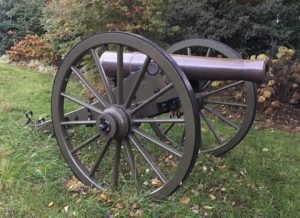 BONT is in the process of developing a blueprint for the location of monuments that will honor and memorialize both Confederate and Union units that clashed atop Shy’s Hill. In particular, early drafts of the plan include a centrally-located stone monument recognizing the Tennessee regiments which defended the hilltop, including the 20th Tennessee under the command of Col. William Shy.
BONT is in the process of developing a blueprint for the location of monuments that will honor and memorialize both Confederate and Union units that clashed atop Shy’s Hill. In particular, early drafts of the plan include a centrally-located stone monument recognizing the Tennessee regiments which defended the hilltop, including the 20th Tennessee under the command of Col. William Shy.
The Hill’s summit for many years featured a Napoleon field piece placed in conjunction with the split-rail fencing and the three poles flying the Confederate, American and Minnesota flags. The reproduction Napoleon eventually deteriorated due to weather and had to be removed. It has now been rebuilt and will be placed within the wall remnants of Confederate Redoubt No. 1 on Benham Ave. The cannon was the inspiration behind Elizabeth Harbin’s new BONT logo design.
Also underway are plans to upgrade and redesign the trail up the steep Eastern slope of Shy’s Hill, and to complete historical interpretative signage along its path to help new visitors understand the progression of the violent battle on the hill on December 16, 1864.
The master plan includes efforts by BONT to finalize its sponsorship of a historical monument recognizing the bravery of the United States Colored Troops (USCT) in the December 16, 1864 battle at Peach Orchard Hill in South Nashville, near the intersection of Franklin Road and Battery Lane.
January, 2020
BONPS Membership Newsletter
Dear Members and Friends,
Thank you for helping us have a very successful 2019.
We accomplished much but there is always more to do We overhauled our website, revamped our Board of Directors and continually improved our historic properties at Shy’s Hill and Redoubt 1. This is the year that we want to add signage and additional monuments to our properties to complete the visitor experience.
On January 30, 2020, we will host the Annual Members Meeting and a Meet and Greet with our Board of Directors. Cocktails and hors d’oeuvres will be served from 6:00 – 8:00 p.m. at 4700 Lealand Lane. We would love to have you drop by and visit. Please RSVP to Ellen Duer McClanahan at edmcclanahan79@gmail.com. Please uber if attending.
Thank you for your continued support. We are grateful for your dues, contributions and interest in preserving the historic battle of Nashville.
Sincerely yours,
James D. Kay, Jr., President
Special thanks to The Parke Company:
Parke Brown is a Nashville native and former board member. He is the owner of one of Nashville’s finest landscape and tree removal companies-The Parke Company. Parke is a direct descendant of Adelicia Acklen who was the original owner of Belmont Mansion. Parke’s company maintains Redoubt 1 and Shy’s Hill for us at no charge. We are so grateful for his donations to history.
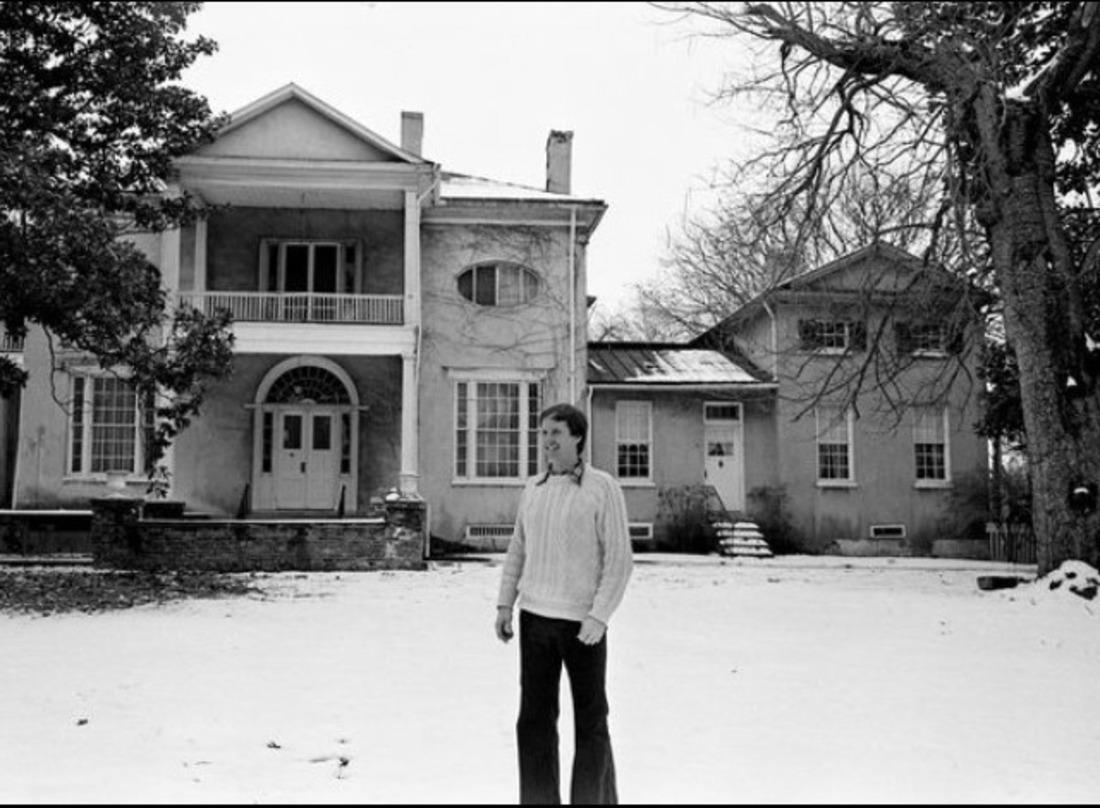
Paul Clements, who is writing on the history of the Woodmont area, stands February 20, 1979, in front of the original entrance of the Woodlawn, which was built by Capt. John Nichols in 1812. It served as headquarters for Colonel David Coleman who commanded Ector’s brigade during the Battle of Nashville. Presently the home houses the law firm of Kinnard, Clayton and Beveridge who are supporters of the Battle of Nashville Preservation Society. Photo courtesy of The Tennessean
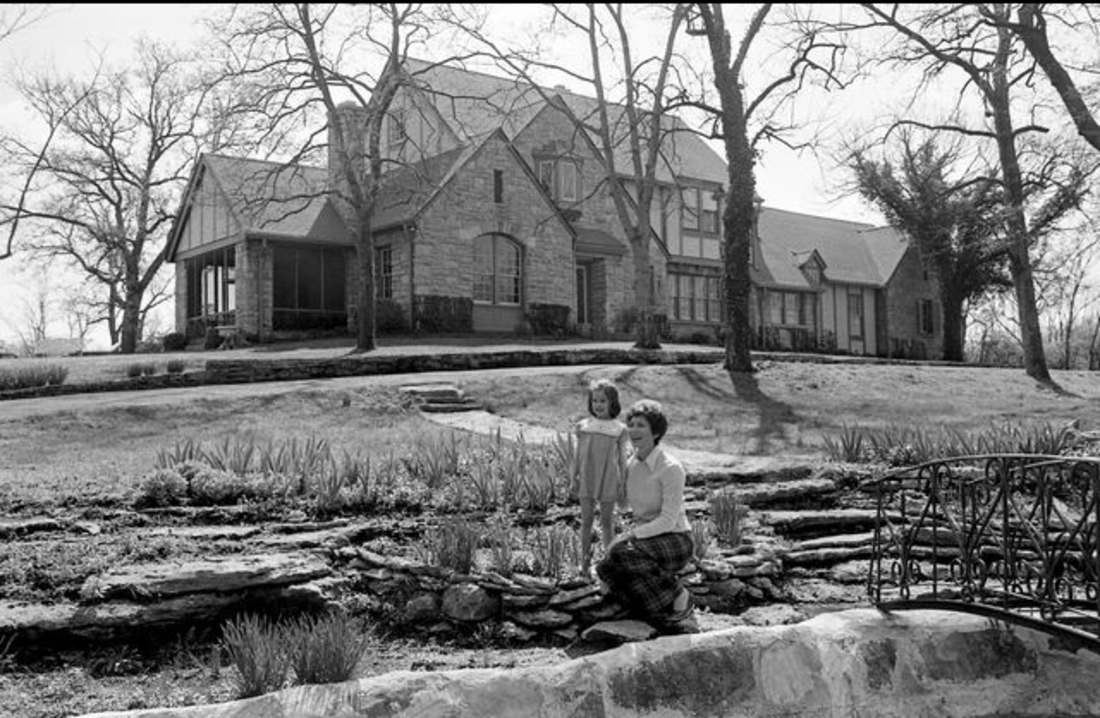
Mrs. Thompson B. Patterson and daughter Kathryn look at the spring plants April 3, 1979 in their English garden built into the original breastworks dug for the Battle of Nashville. The classic stone and timber house, Windycrest is located at 1811 Woodmont Blvd. near Redoubt 1. Photo courtesy of The Tennessean
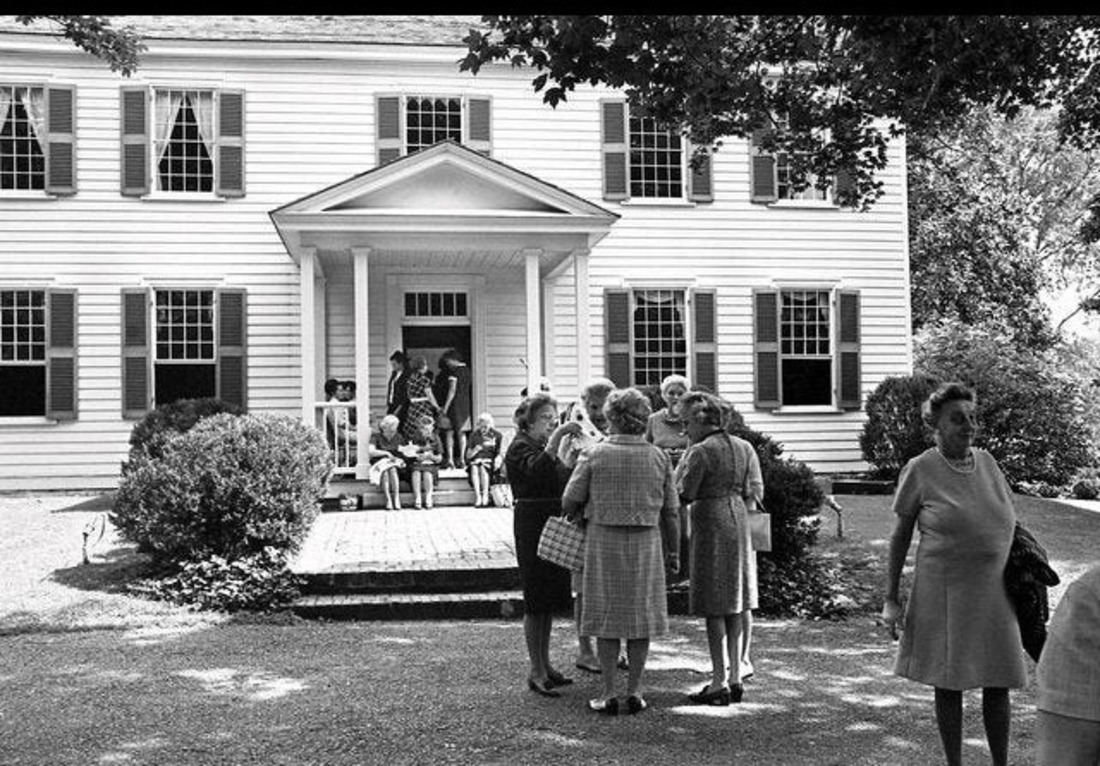
In the cool, crisp air of Fall, ladies gather on September 11, 1969 for the annual Country Fair sponsored by the Colonial Dames of America at Travellers Rest in Nashville. Photo courtsey of The Tennessean
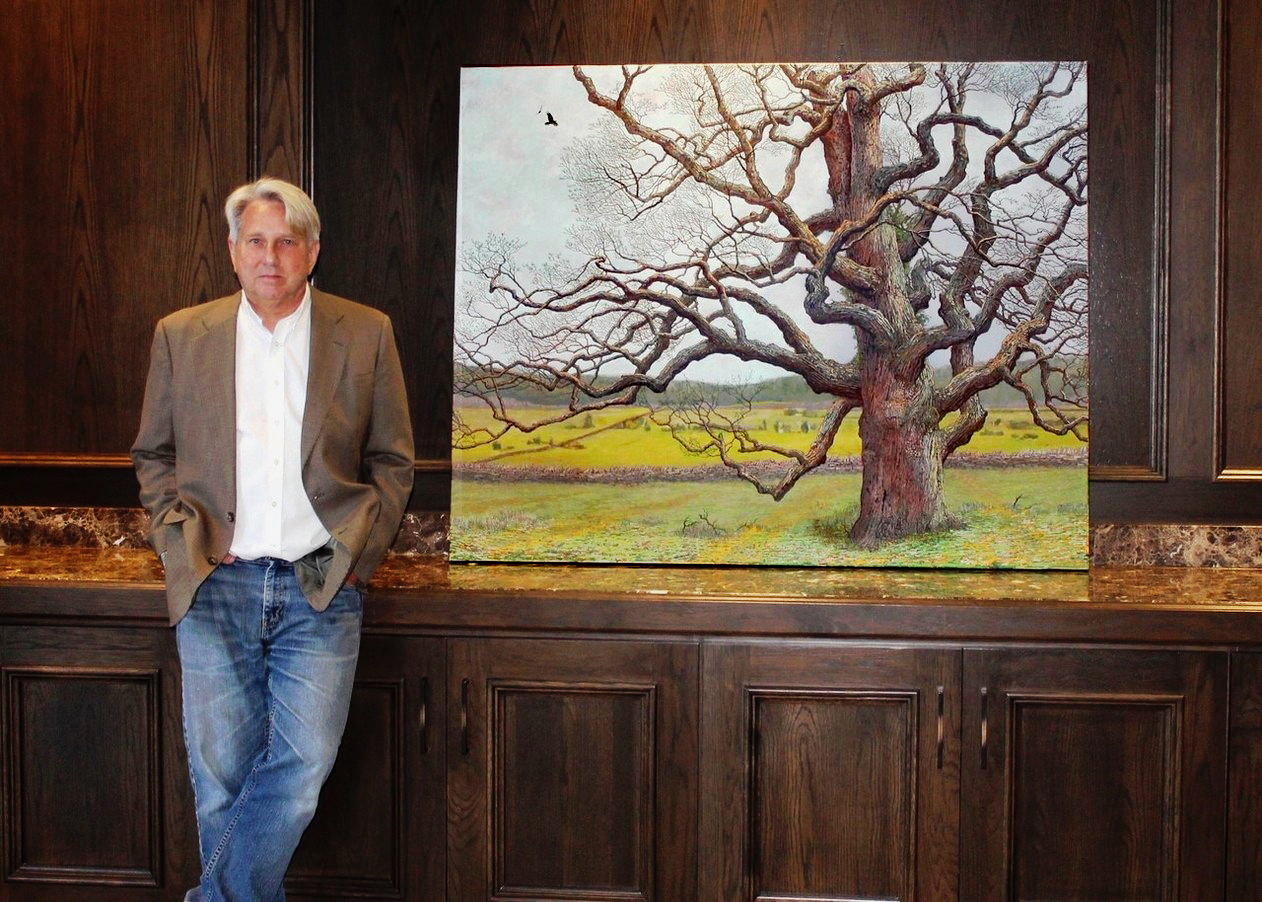 Richland Country Club is located on property where the battle of Nashville ended on the evening of December 16, 1864 This battlefield is home to a Bur Oak tree dating to approximately 1610. It has been recognized by Tennessee as one of the most important trees in the state.. Richland recently commissioned world famous artist Charles Brindley to paint the Bur Oak witness tree as it would have looked in 1850 along Granny White Pike. Across these fields-now the site of the golf course- charged the Federal Cavalry under Major General James Wilson. The Confederate cavalry, commanded by Colonel Ed Rucker, fiercely defended the pike and the access road to Brentwood which allowed General Hood’s army to escape. Rucker was shot in the arm and captured. He spent the night on this land at the Tucker farmhouse before being sent to Nashville the next morning to have his arm amputated. After the war, Rucker’s sword was returned to him as a good will gesture by the Union officer who obtained the sword in 1864. Rucker died in Birmingham in 1924 after amassing a fortune in the coal, steel and in the banking industry. Fort Rucker, Alabama is named in his honor. Wilson, a West Point graduate, later fought in the Spanish American War in 1898 and he died in 1925 with only three Union Civil War Generals living longer. Another famous person to fight in this battle for the South was Colonel David Kelley, a Methodist preacher and fierce fighter. He later became the first Secretary to the Board of Vanderbilt University.
Richland Country Club is located on property where the battle of Nashville ended on the evening of December 16, 1864 This battlefield is home to a Bur Oak tree dating to approximately 1610. It has been recognized by Tennessee as one of the most important trees in the state.. Richland recently commissioned world famous artist Charles Brindley to paint the Bur Oak witness tree as it would have looked in 1850 along Granny White Pike. Across these fields-now the site of the golf course- charged the Federal Cavalry under Major General James Wilson. The Confederate cavalry, commanded by Colonel Ed Rucker, fiercely defended the pike and the access road to Brentwood which allowed General Hood’s army to escape. Rucker was shot in the arm and captured. He spent the night on this land at the Tucker farmhouse before being sent to Nashville the next morning to have his arm amputated. After the war, Rucker’s sword was returned to him as a good will gesture by the Union officer who obtained the sword in 1864. Rucker died in Birmingham in 1924 after amassing a fortune in the coal, steel and in the banking industry. Fort Rucker, Alabama is named in his honor. Wilson, a West Point graduate, later fought in the Spanish American War in 1898 and he died in 1925 with only three Union Civil War Generals living longer. Another famous person to fight in this battle for the South was Colonel David Kelley, a Methodist preacher and fierce fighter. He later became the first Secretary to the Board of Vanderbilt University.
About the artist:
Charles Brindley lives and maintains a studio in several old Victorian structures in Adairville, a small community 35 miles north of Nashville, Tennessee. He has been represented by galleries in numerous cities, including Nashville, Memphis, Taos, Washington, DC and New York City His work appears in public and corporate collections throughout the United States and in private collections internationally. Five touring exhibitions of Brindley’s works have travelled to museums and art centers in the Southeast and Midwest. There have been three major retrospectives of the artist’s career. The Tennessee State Museum presented Landscape Vision: Works of Charles Brindley 1980-1997 and in 2007 the Evansville Museum of Arts, History and Science organized Trace and Transformation, an exhibit spanning a twenty year period. Far Hills, Images of the Tennessee Residence, an exhibit of commissioned drawings and paintings of the historic mansion of Tennessee’s Governors, completed a schedule of eight venues throughout the state in 2006. In 2015 an exhibit of Brindley’s imagery of ancient and mysterious trees spanning three decades- Trees of Myth and Legend, opened at Cheekwood Botanical Garden and Museum of Art. In August of 2018 Salient Features: Trees of Old Forests and Woodland Pastures will open at the Kentucky Museum. Charles Brindley’s drawings and paintings depict a variety of symbol-laden subjects, including giant deciduous trees, panoramic landscapes, prehistoric ruins, rock formations, architecture and still lifes. His images are highly representational but contain multi-layered abstract elements.
New Nashville Books
Author Dennis Belcher is releasing his newest book next month. The foreword below was written by Jim Kay of BONT:
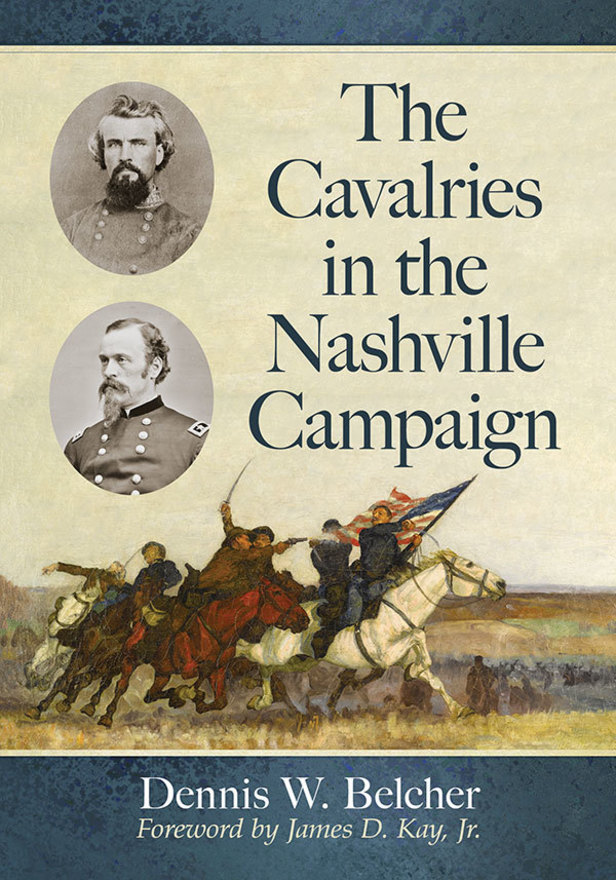
Foreword
It was August 1966. I was six years old. The war in Vietnam was escalating; riots were beginning across the United States and the world. These were times of great change. I was oblivious to all of this when my father moved us from Mt. Juliet, Tennessee to Oak Hill just south of Nashville. In our backyard on Oak Valley Lane was an old stacked stone wall that ran for miles. The wall fascinated me. When was it built? Why was it built? Why was it located where it was? Why was the trail along the wall named Kirkman Lane? I walked this bridle path almost every day to school at Robertson Academy. Others rode horses on the well worn path. I would walk to the battlefield marker showing Stewart’s Line which noted fighting at this wall. One day I found an arrowhead and a few weeks later a minie ball. In looking at old maps I discovered that our home was in the center of the second day of fighting of a great Civil War battlefield. In that month, I discovered my passion in life – The Battle of Nashville.
There have been numerous books since Thomas Hay first published his essay in 1928 on the battle. Stanley Horn’s, “The Decisive Battle of Nashville”, was the first in 1954 and many have followed. I have read and studied every publication since. I most enjoyed the writings of Wiley Sword and my Auburn friend James McDonough-who, like me, was fascinated by the Nashville battlefield at an early age. Unfortunately, none of the authors, other than McDonough, ever lived on the battlefield, to my knowledge, and many authors spent little time traversing over the hills and valleys to precisely pinpoint where the lines and batteries were located on December 16, 1864.
The Nashville battlefield today has virtually been obliterated. The Battle of Nashville Preservation Society, Inc. has preserved Redoubt 1 on Benham Avenue and the Shy’s Hill site on Benton Smith Road. Other than Ft. Negley, Travelers Rest, Granbury’s lunette and Kelley’s Point, there is really no place to go to visit any of the original sites. All have succumbed to the bulldozer and “progress”. This is even more startling when considering that Nashville was one of the largest battlefields of the war encompassing over 20 square miles. I still live today in Oak Hill approximately 600 yards from where we moved in 1966. I walk the battlefield daily. I know where each brigade was formed and where the charges were made, where the men died and where those that did not die surrendered or retreated. I know where the hidden remnants of the trenches still run in my neighbors’ back yards. On my land is a part of the old earthworks from Dent’s Alabama battery where 13 live shells were discovered in one deep hole in the seventies. There are only a handful of us left that know these little gems of the Nashville battlefield. Hank Williams, Jr., Mark Swann and Thomas Cartwright traversed these places in the 1960’s and early 1970’s as teenagers with their metal detectors. My old friend Paul Clements stood on Redbud Hill in the early eighties and wept as he watched the development of Burton Hills and the tear down of the Compton mansion where Lt. Col. William Shy was taken after his death. A few other good men also know where the treasures still lie but there are only a handful left. Soon we will all be gone. Unless others step up now, this history will be forever lost.
I am so pleased that Dennis Belcher asked me to write this forward and assist him with some technical aspects and troop positions. The author has taken the time to walk and drive with me the sites pertinent to the cavalry action during the Battle of Nashville. Unless you live in the area and walk the terrain, it is impossible to determine from the official reports which hill was occupied, fortified or attacked during the battle. There are so many tall hills in Oak Hill and Forrest Hills that unless you are on site, you simply cannot envision what positions some of the eyewitnesses were really discussing over 150 years ago. The author took the critical time needed to learn this information first hand and I thoroughly enjoyed our time together standing on the ridges and in the driveways of some of my friends who allowed us access where I could point out precisely where the troops moved, fought and died.
This work gives details that most of the prior authors either missed or did not include. Specifically, the retreat by Cheatham’s corps through the “gap in the hills”, which is present day Lakeview Drive and through the Radnor Lake State Park, and the work of Colonial David Coleman with Ector’s Brigade in protecting this retreat are finally noted. Furthermore, the author’s work on the Battle of the Barricade which sprawled over the present-day Richland Country Club and south to present day Maryland Way have really not received the depth from other authors that were necessary. I am so pleased that the author took the time to describe these encounters in detail and provide the finest Nashville action maps ever published.
Just like the 1960’s, we live in a changing time and a changing world. Political discussion in virtual reality is beyond aggressive and the American Civil War and its 620,000 American casualties is a thing of the past. Fortunately, a very few remain to protect the record for history the blood that was spilled into the Nashville dirt. The author is one of these men. I know that you will enjoy this fine work.
James D. Kay, Jr.
President, Battle of Nashville Preservation Society, Inc.
28 August 2019
Nashville, Tennessee
December 16, 2019
RAIN, MIST ADD AUTHENTICITY TO 155th COMMEMORATION OF BATTLE OF NASHVILLE
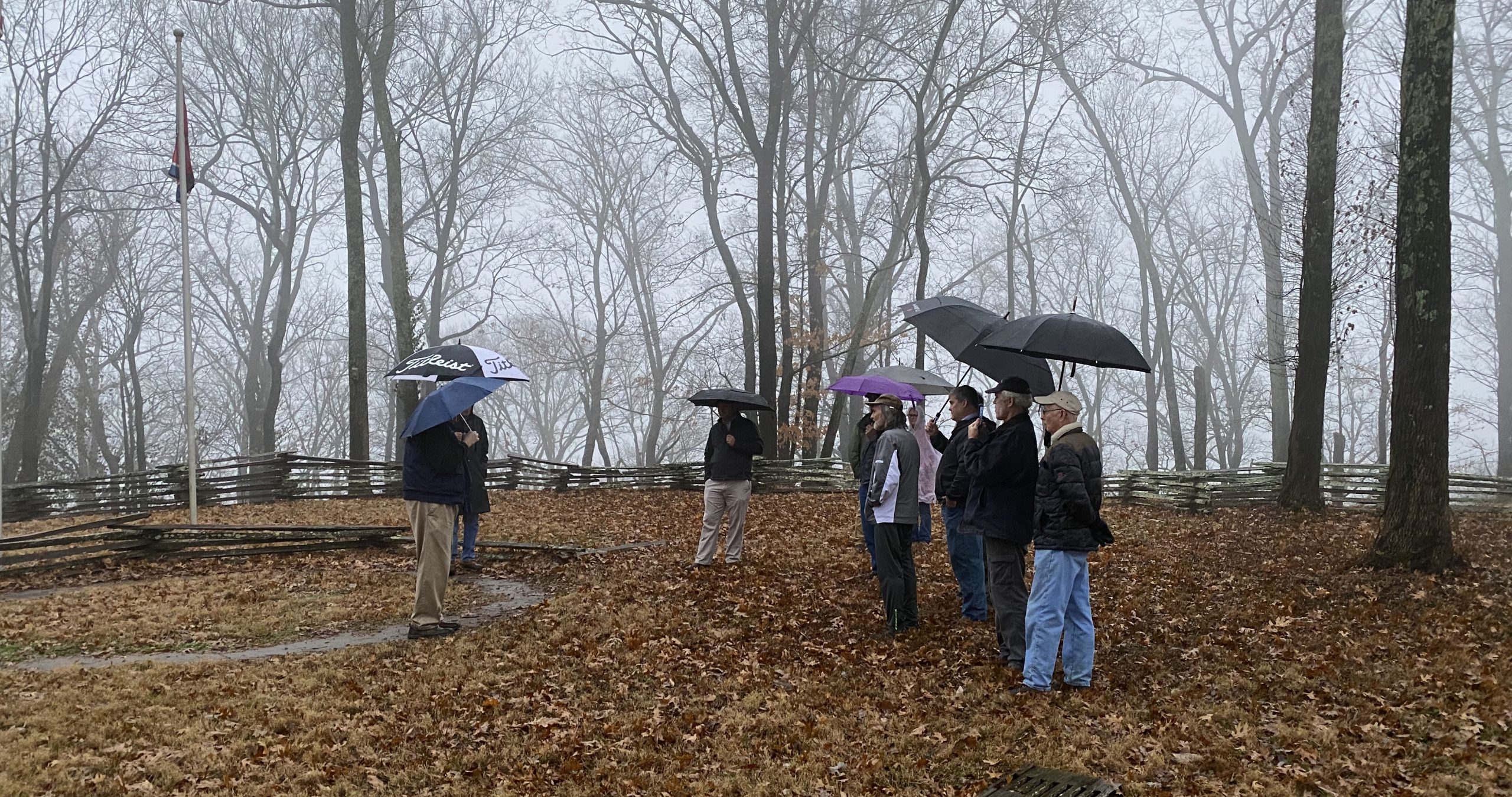
The top of Shy’s Hill was wet with rain and enveloped in fog on Monday afternoon, December 16, 2019 — just as it had been 155 years earlier at that same time, date and place — but it didn’t stop the traditional walk up the steep trail to honor those who fought there in the final struggle of the Battle of Nashville.
Various visitors slipped and skidded up the muddy slope during the day, including the group that stood on the summit in a drizzling rain to hear brief comments by historian Ross Massey and BONT president Jim Kay, beginning at 4:00 p.m., which was about the same time as Minnesota troops stormed the hill on December 16, 1864.
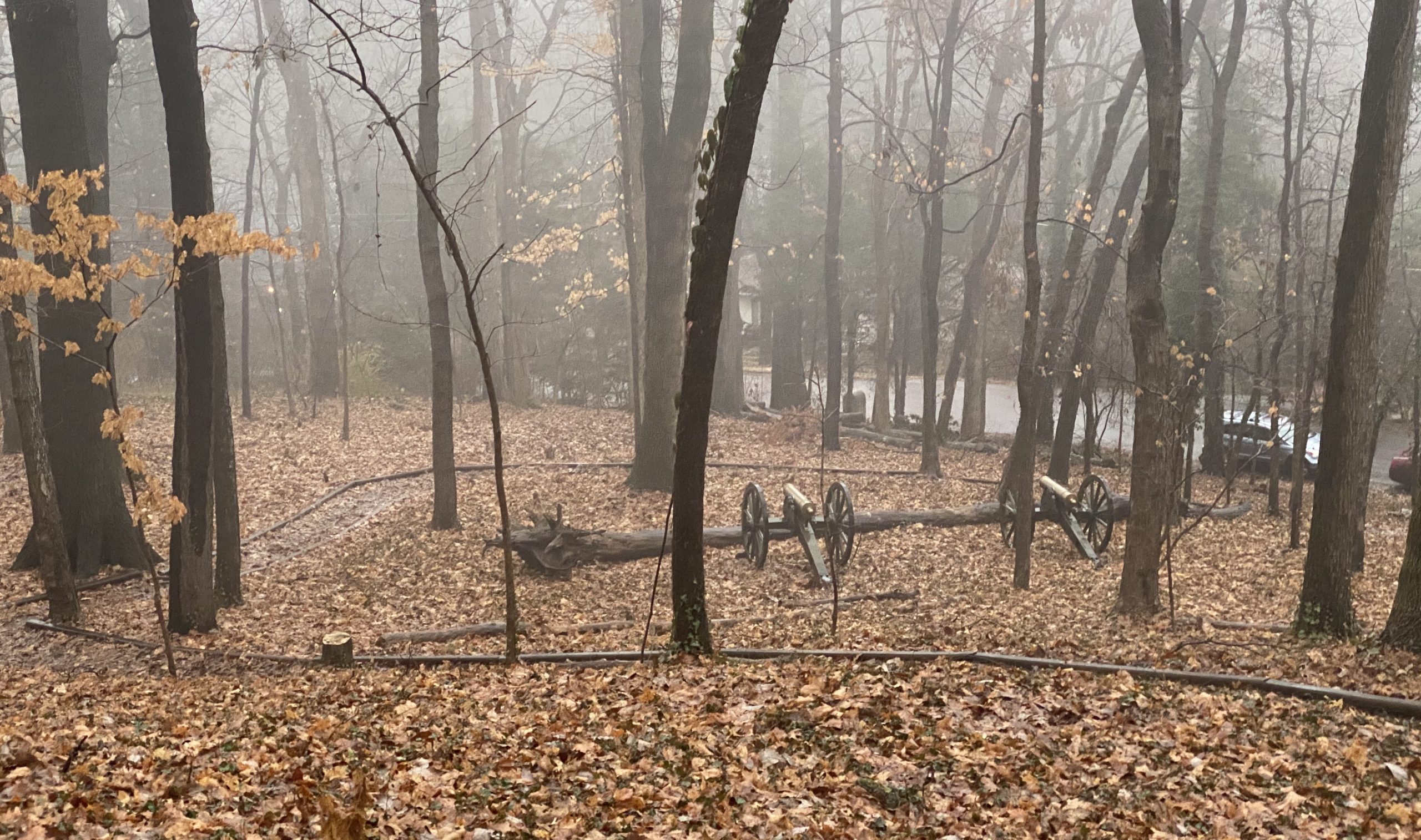
Massey said he had read numerous letters and journal entries in which soldiers described the rain as well as the heavy mist that hung over the hills of South Nashville on the day of battle, exacerbated by the smoke from hundreds of artillery explosions.
“This (walk up the hill) has probably been happening since December of 1865,” Kay said, as the brief ceremony came to a close, accentuated by thunder and lightning and the rain changing from light drizzle to downpour.
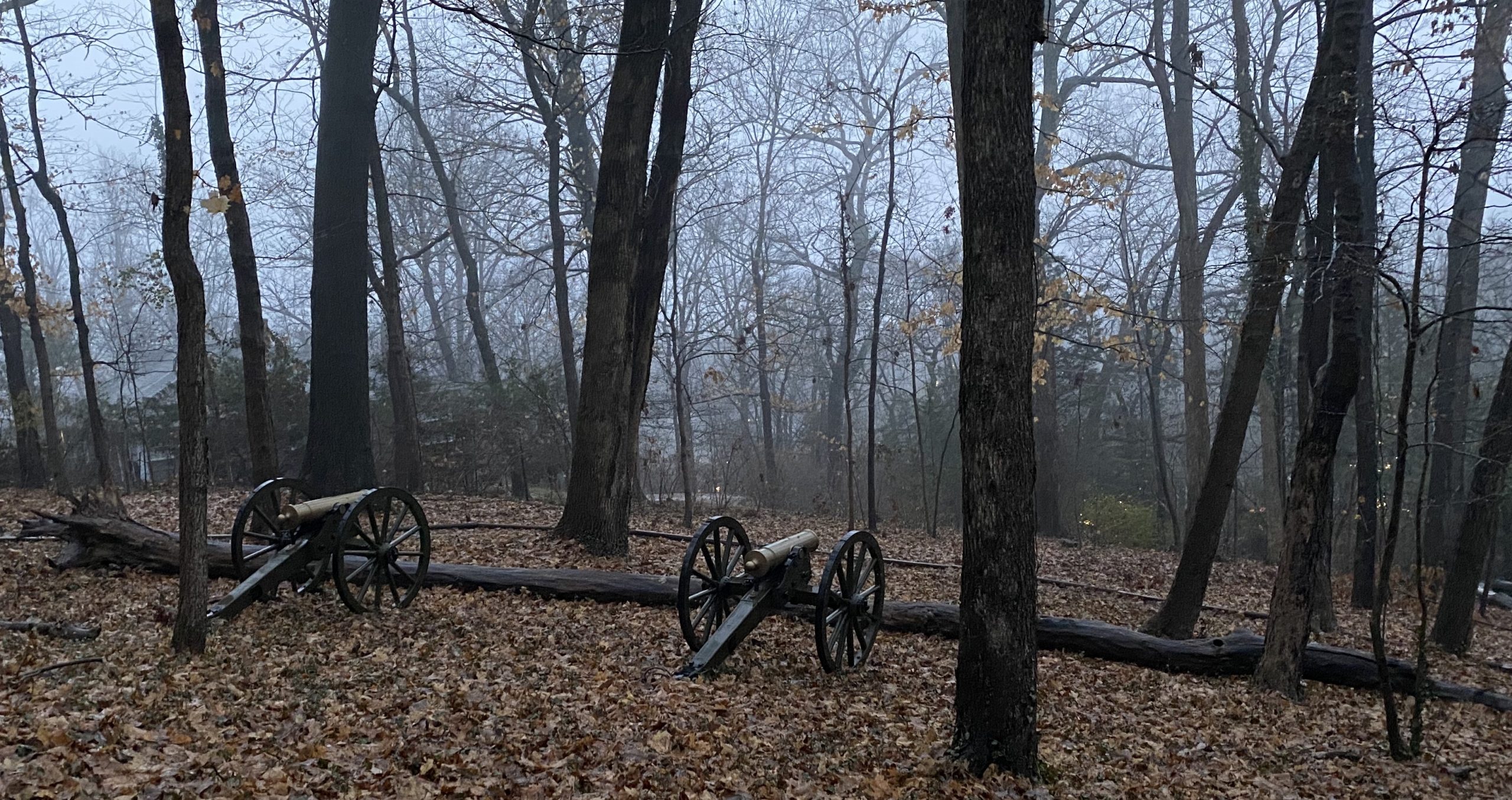
September, 2019
NEW ZIMMERMAN BOOK EXPLORES BATTLES PITTING GUNBOATS VS. CAVALRY
Mark Zimmerman, a Nashville writer and long-time BONT member known for his popular Guide to Civil War Nashville, has published a new book exploring a unique form of Civil War combat — Union gunboats against Confederate cavalry and gunners.
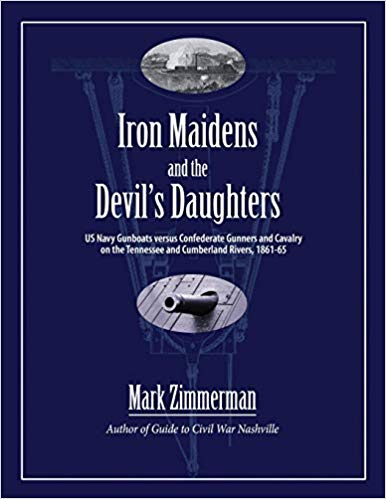 The new book, Iron Maidens and the Devil’s Daughters, is subtitled “US Navy Gunboats versus Confederate Gunners and Cavalry on the Tennessee and Cumberland Rivers, 1861-65.” It has been endorsed by numerous local Civil War historians, including BONT President Jim Kay as well as Thomas Cartwright and Greg Biggs.
The new book, Iron Maidens and the Devil’s Daughters, is subtitled “US Navy Gunboats versus Confederate Gunners and Cavalry on the Tennessee and Cumberland Rivers, 1861-65.” It has been endorsed by numerous local Civil War historians, including BONT President Jim Kay as well as Thomas Cartwright and Greg Biggs.
The book includes a description and maps of the battle at Bell’s Bend on the Cumberland River west of Nashville. Visitors can still visit the historically important areas on the banks of the Cumberland, at the area known as Kelley’s Point, where Confederate gunners challenged Union boats. Former BONT president John Allyn has explored this aspect of the Battle of Nashville in a piece written for this website. Click here for the article.
Other chapters in the Zimmerman book cover the Johnsonville campaign, Fort Henry and Fort Donelson, the Phelps Raid, the 1st Battle of Shiloh, the strange Duck River Affair, guerrilla activity and counterinsurgency operations, Dover, Paducah, Canton, and much more. Much attention is paid to the unprecedented formation of the US river flotilla and the gunboats themselves, including a special section on the USS Cairo. The flotilla included timberclads, ironclads, river monitors, and tinclads.
Published by Zimco Publications LLC, the 184-page book contains 14 original battle maps, 100 photos, and artwork by John Paul Strain and Andy Thomas. It is currently available on Amazon, and further details on this book and other Zimmerman publications are available at his website (click here).
The author is currently working on a book that will examine the results of Hood’s Nashville campaign.
September 5, 2019
KAY STRESSES NEED TO PRESERVE KNOWLEDGE OF BATTLE IN FOREWORD TO NEW NASHVILLE BATTLE CAVALRY BOOK
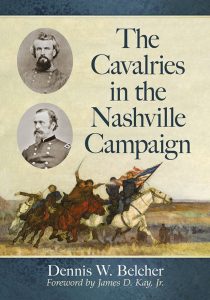 Jim Kay, president of the Battle of Nashville Preservation Society, has written a poignant Foreword to a soon-to-be-published book detailing the histories of both Union and Confederate cavalries in the Battle of Nashville.
Jim Kay, president of the Battle of Nashville Preservation Society, has written a poignant Foreword to a soon-to-be-published book detailing the histories of both Union and Confederate cavalries in the Battle of Nashville.
The new book, tentatively entitled The Cavalries In The Nashville Campaign, is written by Dr. Dennis W. Belcher of Jefferson City, MO, and is expected to be available for sale in 2020.
Jim Kay, in a brief but personal Foreword, describes his lifelong passion for exploration, research, and understanding of every minute of action in the two-day Battle of Nashville, as well as every inch of contested ground covered by the thousands of troops who waged a deadly battle in Nashville on December 15 – 16, 1864. Anyone interested in the history of this pivotal clash should read Jim’s account of how immersed he has become in understanding the Battle, and how author Belcher has also worked to understand and clarify the now-overbuilt terrain and cavalry movements that thundered over it. To read the Foreword, click link below: Jim Kay Foreword to Nashville Cavalry book September 2019
Mr. Belcher tells BONPS that his book covers both Union and Confederate cavalry operations during the entire Nashville Campaign beginning with the close of the Atlanta Campaign and concluding in late December when Hood exited Tennessee.
Those cavalry operations pitted the experience and resourceful Nathan Bedford Forrest against the young, brash James Harrison Wilson, a new corps commander. “This is a story of Forrest utilizing his finite resources and his experience to deal with the Northern horsemen while Wilson hastily drew together an effective cavalry force to meet his Southern foes,” Belcher told BONT. “These were good, experienced cavalry forces fighting while at the top of their game.”
The campaign would continue an evolution of cavalry tactics from the beginning of the War and set the stage for the final events in 1865. While mounted cavalry fights occurred in this campaign, dismounted cavalry was probably never used to this scale, and with such success.
Belcher added, “The Nashville Campaign reflected the stark realities of the war across the country in December 1864 as the Union and Southern cavalry fought for honor, glory, and their way of life in the hills and valleys south of Nashville.”
He is the author of numerous books on the Civil War, including among others: The Union Cavalry and the Chickamauga Campaign (2018); The Cavalries at Stones River: An Analytical History (2017); The Cavalry of the Army of the Cumberland (2016); General David S. Stanley, USA: A Civil War Biography (2014); “This Terrible Struggle for Life”: The Civil War Letters of a Union Regimental Surgeon by Thomas S. Hawley, M.D., edited by Dennis W. Belcher (2012).
July 16, 2019
BONPS DEBUTS NEW WEBSITE
The Battle of Nashville Preservation Society launched a newly-designed website online on July 16, 2019.
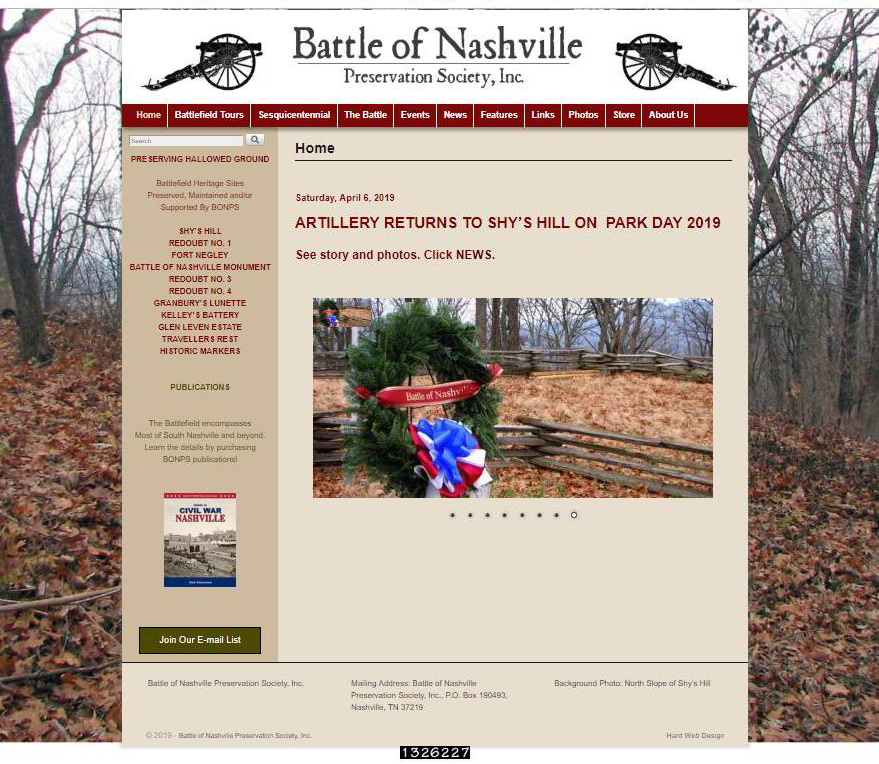
The previous website, pictured above, went online in 2011. It served BONPS and more than 1 million viewers well It was taken off-line shortly after it registered 1,326,227 hits, averaging close to 500 visitors per day over its eight year span.
The BONPS website is designed to be an internet “home base“ for all aspects of the work of the organization, which has preserved, and manages, two important landmark properties from the Nashville battlefield: Shy’s Hill and Redoubt No. 1.
The website is also designed to be a comprehensive repository of history, both text and visual, of the Battle of Nashville. In addition to numerous articles about all aspects of the battle, the website also announces events regarding the Civil War in Middle Tennessee from not only BONPS but also other organizations; makes available battlefield tours; contains a virtual store in which patrons can purchase everything from minie balls to books and maps; contains a guide to all of the major Civil War sites in the Nashville area.
It is managed in conjunction with the BONPS Facebook page.
April 6, 2019
CONFEDERATE ARTILLERY RETURNS TO SHY’S HILL AS PART OF “PARK DAY”
The heavy artillery has returned to Shy’s Hill.
Two replica Civil War Howitzer field guns were placed on the East slope of the Hill on Saturday, April 6, 2019, as volunteer workers swarmed the site as part of Park Day 2019, which is sponsored annually and nationally by the American Battlefield Trust for a “Spring cleaning” of battlefield sites. BONPS has been hosting these events at both Shy’s Hill and Redoubt No. 1 for many years. For more information, see https://www.battlefields.org/events/park-day.
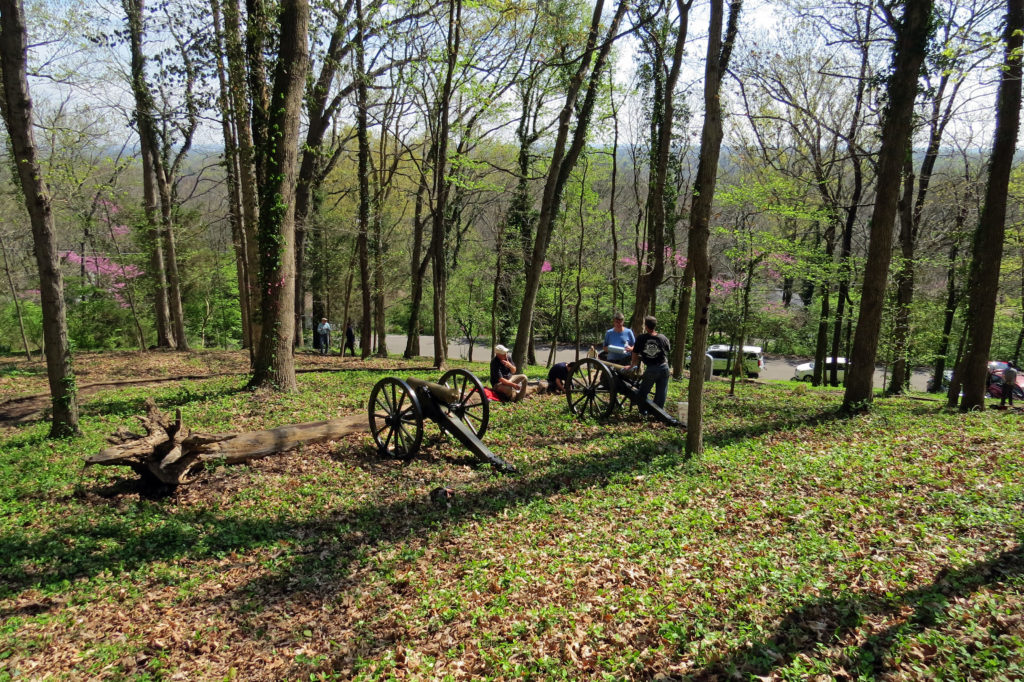 “BONPS greatly appreciates the hard work of all of the volunteers who helped us clear brush and debris from Shy’s Hill,” said Jim Kay, BONPS president. The workers who gave their time and effort volunteered primarily through Hands On Nashville, including students from Vanderbilt’s Alpha Phi Omega service organization and a group representing Capreit Residential Management LLC.
“BONPS greatly appreciates the hard work of all of the volunteers who helped us clear brush and debris from Shy’s Hill,” said Jim Kay, BONPS president. The workers who gave their time and effort volunteered primarily through Hands On Nashville, including students from Vanderbilt’s Alpha Phi Omega service organization and a group representing Capreit Residential Management LLC.
In March, 2018, BONPS had to remove the replica Napoleon smoothbore cannon from the top of the hill after more than 10 years of weather exposure had caused its concrete carriage to deteriorate and crack.
The big gun had remained in a collapsed condition for more than a year before BONPS was able to get the professional and technical help of Nashvillian Harry Peffen to move the extremely heavy cannon down the hill and ship it off for refitting with a new aluminum carriage.
Now, the cannons — not one, but two— have returned, but this time in a much more accurate depiction. Thanks to donated funds and the generosity of BONPS President Jim Kay, two new replica Howitzers have been placed on the Hill.
Above, BONPS President Jim Kay moves replica howitzer into position using manpower and an ATV, which is far different from the team of horses and soldiers that accomplished the task on a wet morning 155 years ago at this place.
The refurbished Napoleon will eventually make its way back to the Hill as well, but the display of the two smaller field pieces is more historically accurate than earlier. The placement of the Napoleon atop Shy’s Hill was symbolic only. In reality, Confederate forces defending the hill on December 16, 1864, were not able to drag a 2,500 pound Napoleon cannon along with its limber and caisson up the steep slopes of what was then known as Compton‘s Hill.
Only a handful of Maj. Gen. Benjamin Cheatham ‘s 34 artillery pieces were able to join in the action on that date. Most of them had become bogged down in the deep mud of thawing and rain-soaked cultivated fields and could not be maneuvered into position to defend the Confederate line.
Early on the morning of December 16, Maj. Gen. William Bate apparently found a rough country road along the lower, and flatter, slope of the Hill’s East side, believed to be located in the vicinity of the current Benton Smith Rd. and the Shy’s Hill trail head.
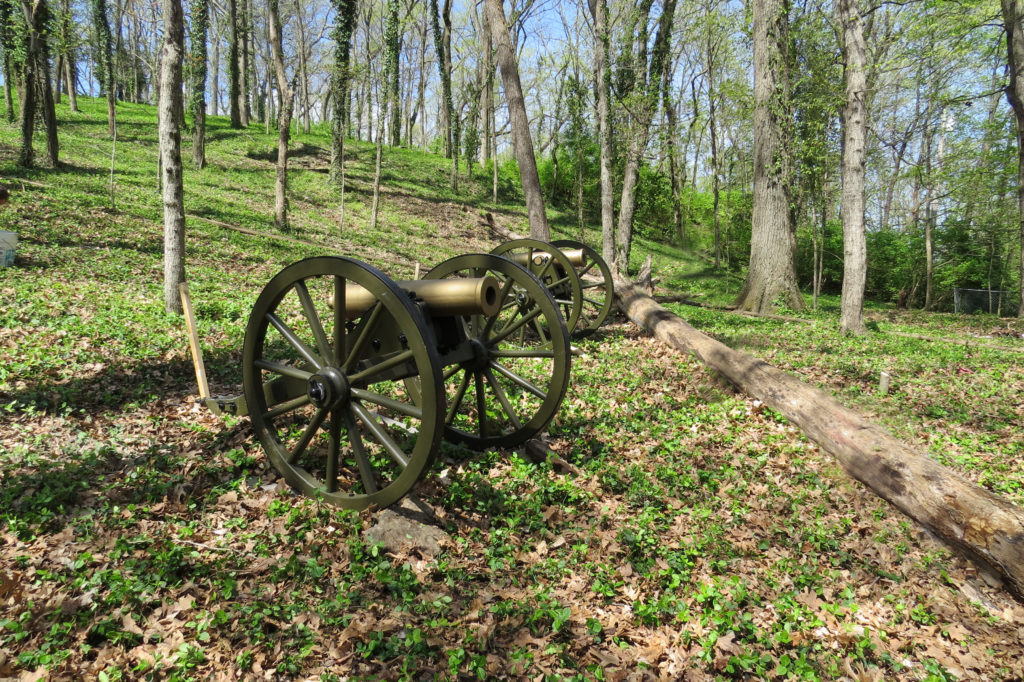
Above, twin Howitzers return to Shy’s Hill Eastern slope, replicating those placed here on the morning of December 16, 1864 by Capt. Rene Beauregard
According to Professor James Lee McDonough in his book Nashville: The Western Confederacy’s Final Gamble, the first howitzers were part of the command of Capt. Rene T. Beauregard, son of Gen. P.G.T. Beauregard, and were placed on “a small plateau” on the Eastern slope. According to McDonough, these guns were later supplemented by four others under the command of Maj. Daniel Truehart.
The two new Howitzers were placed on a flat “plateau” on the Eastern slope, slightly west and uphill from the existing Minnesota Monument, and probably within a hundred yards of the position of the guns that were brought into action on December 16, 1864. BONPS will eventually design a pavilion for the field pieces with interpretative signage.
- Howitzer being off-loaded from trailer
- Ready for transport across terrain, with help of Board members Clay Bailey, Jim Kay, Preston Bain
- Jim Kay drives ATV to move howitzer
- Placement on East slope plateau, facing North
- Both guns in place as BONPS Board members Hunter McDonald, Mark Martin and Pete McAlister take a break
- New BONPS Board members at work. L-R, Bobby Whitson, Preston Bain, Albert Austin, Mark Martin and Hunter McDonald. Also pictures, John Allen and Jim Kay
- Howitzers back in place, after almost 155 years
- Pizza lunch for volunteers at Park Day
- Vanderbilt APO Volunteers. L-R, Joseph Zhong, Cooper Achsenhirt, Rachel Fan, Morgan Fabiber. Not pictured: Jack White.
- Capreit Volunteers. Front L-R: Jamie Leezy, Oscar Leezy, Gloria McCaskill, Myranda Mateycak. Second row: Paula Evans (in shade), Mitchell Senecal. Far right: former BONPS president John Allyn
December 16, 2018
BONPS WREATHES COMMEMORATE 154th BATTLE ANNIVERSARY
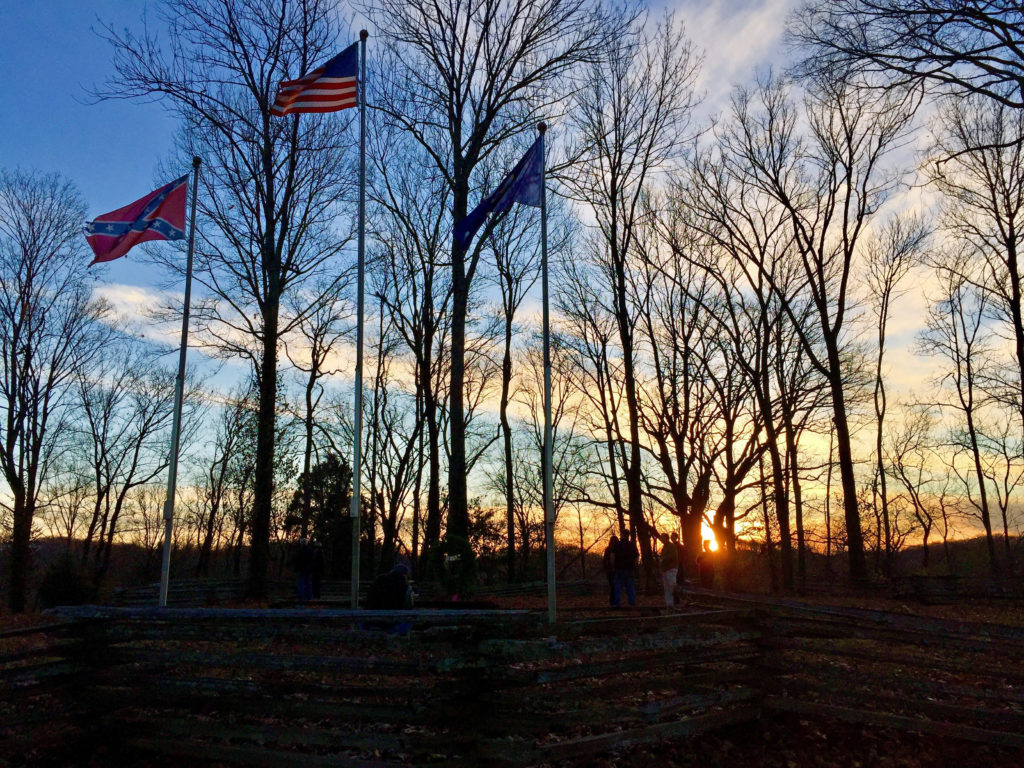
Above, Confederate and Minnesota flags flank American flag in middle at sunset, Dec. 16
As it does each year, The Battle of Nashville Preservation Society placed memorial wreathes at two of its historic sites – Shy’s Hill and Redoubt No. 1 – to commemorate the 154th anniversary of the Battle of Nashville.
Visitors kept up a day long journey up the steep eastern slope trail, as well as to the Minnesota monument, to pay tribute to those who fought on both sides of the battle atop Shy’s Hill, the result of which moved the Civil War to a much swifter conclusion.
The photos accompanying this article were taken between 4:00 p.m and 4:35 p.m. on December 16, 2018, virtually 154 years to the minute after Federal forces led by Brig. Gen. John McArthur, division commander in Gen. Andrew Smith’s XVI Corps, and consisting primarily of Minnesota troops, gave the command to attack the far-left flank of Gen. John Bell Hood’s Confederate line, anchored at the summit of what was then known as Compton’s Hill.
These photos show Shy’s Hill at sunset on a sunny day. At 4:00 p.m. on Friday, December 16, 1864, there was no Daylight Savings Time, and the day had been cloudy with intermittent rain accompanied by the cold sogginess of thawing ground. For a summary of the battle, click the Shy’s Hill link on this website.
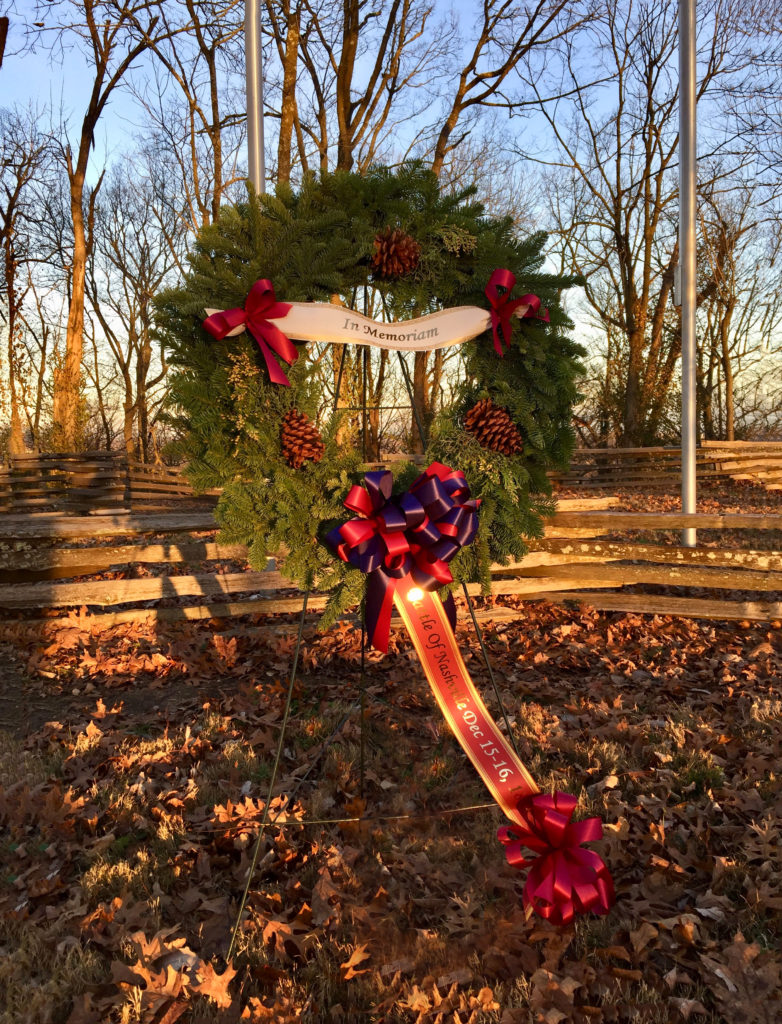
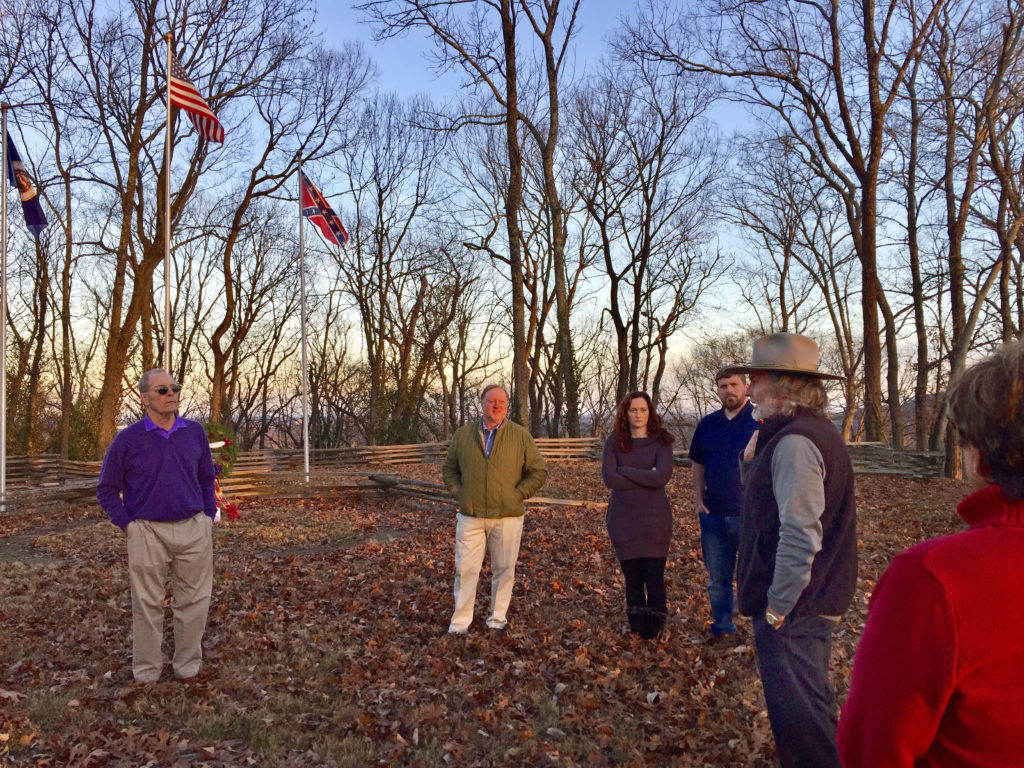
BONPS historian Jim Kay gives impromptu battle summary to visitors (accompanied by BONPS board member Sidney McAlister, in middle)
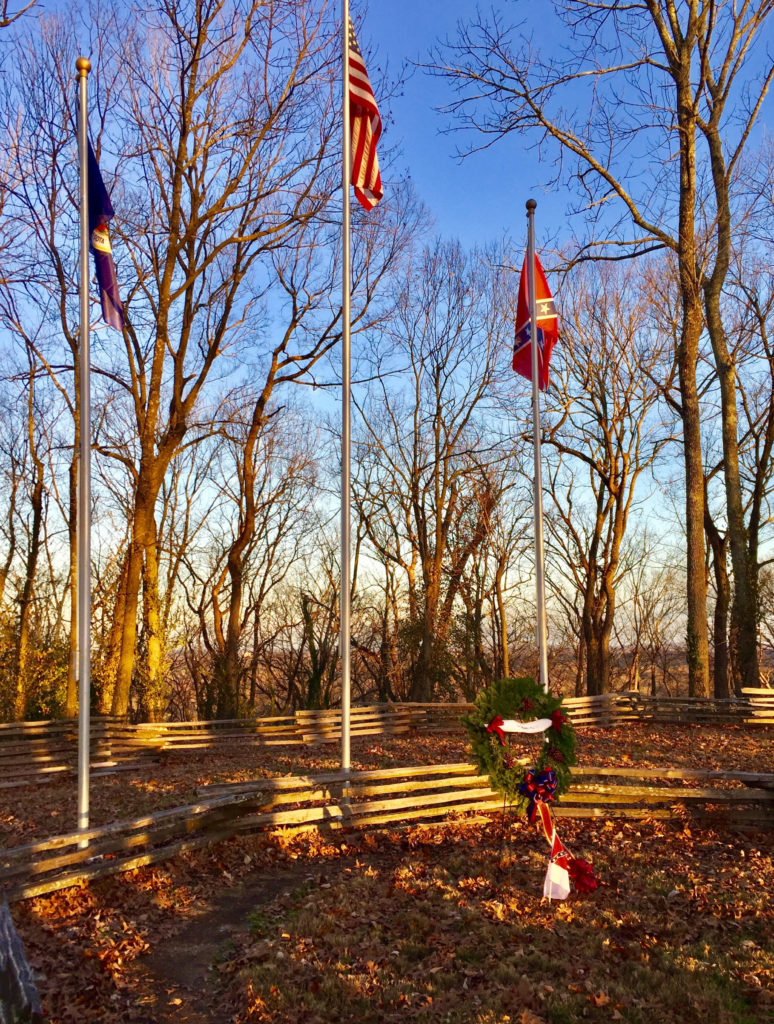
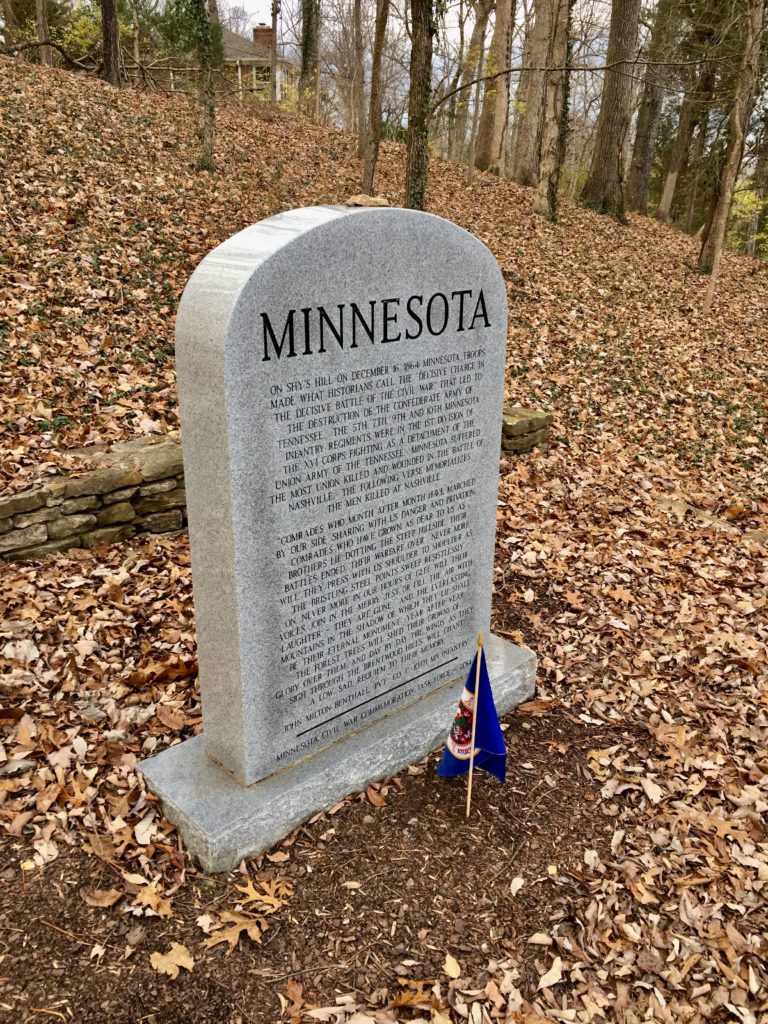
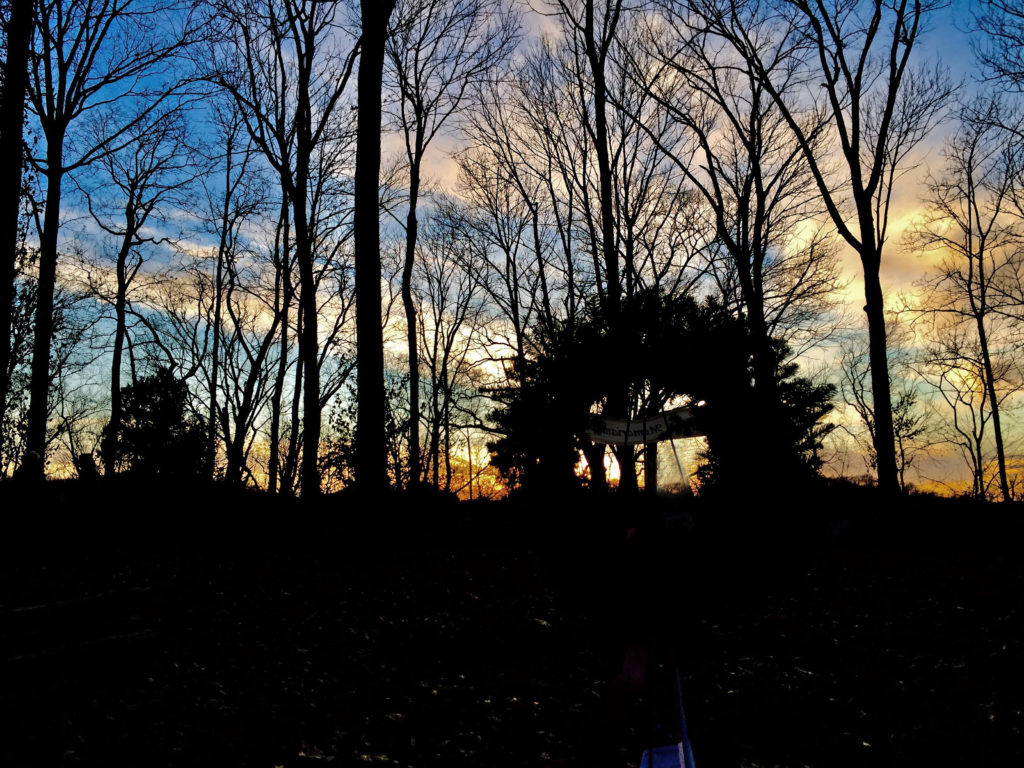
Photos by Tom & Carolyn Lawrence
December 2, 2018
BONPS Speakers Explore Varied Topics During All-Day Seminar
On Sunday, December 2, 2018, the Battle of Nashville Preservation Society in conjunction with Fort Negley hosted a one-day symposium during which four outstanding speakers explored a variety of interesting topics.
Greg Biggs, a well-known historian and Civil War flag expert who is heavily involved in the Clarksville and Nashville Civil War Roundtables, spoke on the impact of the U.S. Navy on the Civil War in Tennessee and during the Battle of Nashville.
Author and historian Steve Davis, who lives in the Atlanta area, spoke on the topic “The Bonnie Blue Flop” during which he discussed the official records and communications, and lack thereof, between Hood, Beauregard, Richmond, and others as Hood evacuated Atlanta and began to formulate his Tennessee campaign.
Columbia State Community College professor and Civil War author Thomas Flagel spoke about the impact of the Battle of Nashville and the long-lasting effects it had on the city of Nashville, even in the present day.
Dr. Jim Atkinson, a BONPS board member for many years and a Vanderbilt physician practicing and teaching in the pathology department, discussed the state of Civil War battlefield medicine during and at the end of the war. Some of his writings on this subject can be found on the BONPS website by clicking HERE.
The board and members of BONPS is greatly appreciative to all of these speakers for bringing their expertise to bear on important topics.
BONPS NEWSLETTER – NOVEMBER 2018
BONPS TO HOST SYMPOSIUM ON VARIOUS TOPICS, INCLUDING HOOD AND ATLANTA
On Sunday, December 2, 2018, the Battle of Nashville Preservation Society in conjunction with Fort Negley will host a one-day symposium from 9:30 a.m. to 3:30 p.m. in the Visitor Center auditorium during which four outstanding speakers will explore numerous interesting topics, ranging from Hood’s decisions after Atlanta to Civil War medicine.
For all details of admission, speakers, and topics, click on EVENTS.
In Memoriam
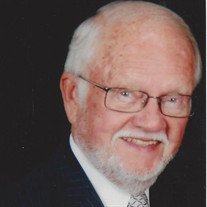 Our long time friend and supporter, Fowler Low, passed on October 13, 2018. He was a graduate of Georgia Tech and was known worldwide as a top executive in the footwear business. He was president and CEO of Johnston and Murphy when he retired in 2000.
Our long time friend and supporter, Fowler Low, passed on October 13, 2018. He was a graduate of Georgia Tech and was known worldwide as a top executive in the footwear business. He was president and CEO of Johnston and Murphy when he retired in 2000.
Fowler was a true student of the Civil War and a long time collector of artifacts. He was a member of our group and a long time financial supporter. His name is on the memorial stone on Shy’s Hill as a major donor in our campaign of 2008 when the Shy’s Hill property debt was paid in full. His obituary can be viewed at https://www.hhhfunerals.com/obituaries/Fowler-Low/#!/Obituary
Shy’s Hill Cannon RestoredFor years we have displayed a replica 12-pound Napoleon cannon on top of Shy’s Hill. The replica barrell and carriage was concrete and the carriage broke two years ago. Getting the cannon down the hill and to a repair factory was extremely challenging. Harry Peffen, who has been more than generous in donating manpower to repair our Minnesota Monument, took a crew to the top of the hill and brought the cannon down the slope. The carriage was replaced with an aluminum carriage which will require no maintenence. The carriage manfacturer was Tom Bailey at Historical Ordnance Works (www.historicalordnanceworks.com.) The cost of the new carriage was $15,000.00 and we thank donors Richard Melvin of Highlands, North Carolina and Jim Kay for their special donations. Now comes the next challenge – getting it back up the hill. Welcome New and Continuing MembersDavid Johnson Christiana, TN Looking for a Christmas Gift?If you have a friend or family member who is interested in Nashville history, please take a look at our online store at www.bonps.org. We offer books, relics and other items related to the Civil War in Nashville. We can and have filled special requests, so let us know. Battlefield ToursRoss Massey is our noted historian and former board member. His knowledge of the Nashville Battlefield is unsurpassed. He is the author of “The Nashville Battlefield Guide” which we sell on our website. Ross frequently gives private tours of Civil War sites in town and can be booked at www.bonps.org. Nashville History UnearthedThe Nashville battlefield stretched from the Cumberland River on Charlotte Pike through south Nashville to the river on Murfreesboro Pike. It is one of the largest battlefields of the Civil War and sadly, the least protected Relics still exist in virtually every yard in Nashville as well as some original earthworks. Live artillery rounds are still being uncovered. Below are recent finds – the artillery shell is extremely rare and was fired from Ft. Negley. |
______________________________________________________________
September, 2018
BONPS ADDS SUBSTANTIAL CONTRIBUTION TO FT. NEGLEY ARCHEOLOGY STUDY
The Battle Of Nashville Preservation Society has joined in the $50,000 fund-raising campaign to pay for urgently-needed archaeology work at Fort Negley and Greer Stadium in anticipation of a Metro plan to redevelop the site and restore it as open parkland.
BONPS has donated $2,000 to the project, which was initiated by the nonprofit Foundation of the Metropolitan Historical Commission in conjunction with the Commission and Metro Parks, after preliminary archeological surveys indicated that it was “highly likely” that there are human remains underneath the Civil War-era Fort Negley and the adjacent former minor league baseball park.

Photo: UrbanPlanet.org
In January, 2018, the Tennessee Valley Archaeological Research (TVAR) released a final report on its survey of the Greer Stadium parcel which, at the time, was under consideration for a private-public development. TVAR’s findings were instrumental in leading to abandonment of the plan by Cloud Hill Partnership to turn the baseball park into a mixed-use development with housing, shops and offices.
Based on historical records, the TVAR report supports the possibility that the remains could include unmarked graves of the enslaved African American laborers who helped to build the fortification.
The interim archeology work is being sought because shortly after Mayor David Briley took office in March, 2018, he announced plans to demolish the abandoned Greer Stadium and seeking funding that would be used to return the site to park space as part of the original Fort Negley Park.
“We must get to the bottom of the Fort Negley site, and time is short to get the job done,” Dr. Lea Williams, Associate Professor of African American and Public History at Tennessee State University and one of the campaign’s coordinators, said in a press release. “In 2019, Metro Parks will propose a redevelopment plan for the Fort Negley/Greer Stadium site. Before that happens, private funding is needed to pay for archaeological work that other funding could not cover.”
Tim Walker, executive director of the Metro Historical Commission, agreed, noting that “we need archaeology for better understanding of the site, including the role of African Americans in building the fort, by analyzing the areas outside the fort’s walls where the African American community that constructed and maintained the fort was encamped and where many may have been buried during the Civil War.”
September 4, 2018
WELL-KNOW LINCOLN IMPERSONATOR JOHN MANSFIELD DIES
John E. Mansfield, the tall Nashville re-enactor who portrayed the top-hatted figure of Abraham Lincoln in hundreds of Civil War historical events, passed away on September 4, 2018, in Nashville.
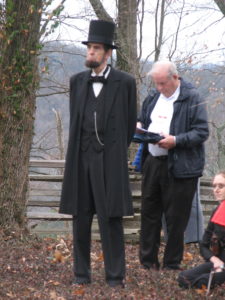 Everyone associated with The Battle of Nashville Preservation Society was deeply saddened by this news. Mr. Mansfield frequently attended BONPS events, from the laying of the wreath ceremonies on the top of Shy’s Hill to the 2014 Sesquicentennial commemoration. He was a frequent attendee, in his top hat and Lincoln suit, at many Fort Negley events.
Everyone associated with The Battle of Nashville Preservation Society was deeply saddened by this news. Mr. Mansfield frequently attended BONPS events, from the laying of the wreath ceremonies on the top of Shy’s Hill to the 2014 Sesquicentennial commemoration. He was a frequent attendee, in his top hat and Lincoln suit, at many Fort Negley events.
According to his obituary, John was born in Glasgow, Kentucky and worked in Nashville‘s real estate, housing and construction industries throughout his career.
He had a striking resemblance to Lincoln in both height and looks (he played basketball at both Georgia Tech and Lipscomb), and in 2006, began portraying Lincoln semi-professionally.
In his obituary, the family noted that he was a three-time winner of the look-alike contest at the Lincoln Days Celebration in Hodgenville, Ky., Lincoln’s birthplace, and also was a three-time winner of the Lincoln Days oratory contest. He was a member of The Association of Lincoln Presenters and, with wife Betty, was honored as the Best Abe & Mary Team in 2010. He also starred in the 2008 documentary Being Lincoln: Men With Hats.
His family noted that he “admired Lincoln’s honesty, integrity and dedication to what’s right — three qualities he exhibited in his daily life, as well.” The officers, board and members of BONPS extend their deepest sympathies to the Mansfield family.
March, 2018
DAMAGED SHY’S HILL CANNON HAS BEEN REMOVED AND SHIPPPED OFF FOR REPAIR
The iconic Napoleon cannon, which has stood sentinel atop Shy’s Hill for more than a decade and has recently been damaged due to age and exposure to weather, has been removed by The Battle of Nashville Preservation Society, and the process to repair and replace it is underway.
The cannon was a reproduction of a smoothbore 12-pounder Napoleon field gun, the most commonly used artillery piece by either side during the Civil War. The BONPS Napoleon had become damaged when its carriage, constructed with concrete, broke due primarily to exposure to harsh weather conditions.
It had been placed on the summit of the hill more than 10 years ago at significant cost and required an extremely difficult engineering feat to get it up the steep grade of the hill. It immediately became a centerpiece of the memorial pavilion at the top of Shy’s Hill, consisting of a three-pole flag display which, together with the cannon, was surrounded by a split rail fence, all of it having an expansive view of the battlefield below.
Plans are underway for reconstruction of the carriage. The“ tube“, or barrel, was salvaged and has already been shipped to Georgia for fitting onto a reconstructed aluminum carriage. Fabrication of the new carriage is performed by only a small number of reproduction artists and is as expensive as it is time consuming. BONPS is not yet able to estimate a time as to when the replacement will return to Shy’s Hill.
The Napoleon smooth-bore, named after French Emperor Louis Napoleon III because of his reliance on this artillery design, was the work-horse field piece of the war. It could fire a 12.3 pound solid shot, or other close-range ordnance such as canister, using a two and a half pound black powder charge. Solid shot had an accuracy range of about 1,600 yards. During the battle of Nashville, Union forces brought the fire of numerous Napoleons as well as other field artillery with rifled barrels to bear on Shy’s Hill and the Confederate line which stretched along modern-day Harding Place from Shy’s Hill east to Peach Orchard Hill near Franklin Road.
Confederate artillery, which was already in short supply, was for the most part unable to get into position to play a major role in defending the Confederate line on December 16, 1864. When the Confederate line fell back on the late afternoon and evening of December 15, darkness and muddy conditions resulted in the horse-drawn artillery pieces and caissons to become mired or slowed down in the fields, and much of it was parked and not in use on December 16. (Napoleons weighed nearly 2,500 pounds and required six horses for transportation.)
Due to the significant expense of the replacement gun, BONPS would appreciate the generosity of interested parties to contribute towards the fund to repair and replace this important iconic part of the Shy’s Hill historical memorial park.
January, 2018
FORT NEGLEY GROUNDS SAVED FROM PRIVATE COMMERCIAL DEVELOPMENT
After a pitched battle between the Cloud Hill commercial development team and preservationists of all stripes — ranging from Civil War historians to the champions of green space protection — the historic grounds surrounding Ft. Negley have been saved.
The Battle of Nashville Preservation Society joined with other historical groups in full support of maintaining Ft. Negley Park as an open area free from private enterprise and honoring the unique historical and archaeological aspects of the land.
Next on the agenda: How to return the embattled 22 acres, currently scarred with the remains of the abandoned Greer Stadium and its asphalt parking lots, to its original purpose: open parkland.
For more on the story, see BONPS.org stories below, as well as local news sources including this story in the Nashville Tennessean.
Saturday, December 16, 2017
VISITORS, DESCENDANTS VISIT SHY’S HILL FOR 153rd ANNIVERSARY OF BATTLE OF NASHVILLE
Dozens of people, including history buffs, reenactors, and even the descendants of Col. William Shy, climbed the steep Eastern slope of Shy’s Hill on Saturday, December 16, 2017, to commemorate, each in their own way, the 153rd anniversary of the Battle of Nashville.
Shy’s Hill was one of two focal points for the war-changing battle on its second day, which occurred on December 16, 1864 and ended late on a rainy afternoon as Confederate forces on the summit were routed by a massive Union charge up the steep hill. The remnants of General John Bell Hood‘s army retreated back to Franklin, Tennessee, and points South.
Among the Shy’s Hill visitors on Saturday were Linda and Frank Whitson of Russell Springs, Kentucky. Linda Whitson is the great, great niece of Colonel Shy, the 26-year-old commander of the 20th Tennessee which defended the summit of what was then known as Compton’s Hill. Colonel Shy was killed at the top of the hill by a close range shot to his head; the name of the hill was later changed in his honor.
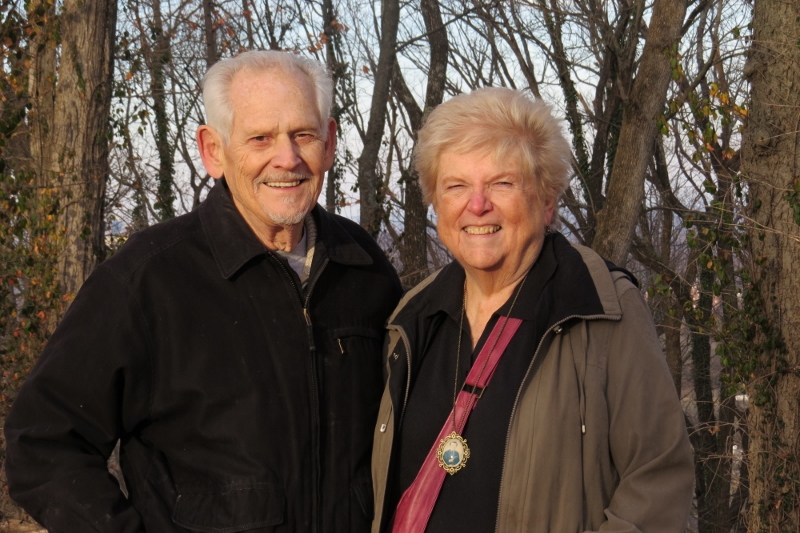
Above: Frank and Linda Whitson, who is a descendant of Col. William Shy
Col. Shy’s body was carried down the hill to a farm, where it was retrieved by his family and was laid to rest at his family home in Franklin.
Ms. Whitson was wearing a pendant which encased a seldom-seen photograph of her ancestor. In the photo, he appears to be enjoying a cigar, and is holding a pistol across his chest.
The Whitson’s had driven down from Kentucky to spend a “family history” weekend in Middle Tennessee, visiting the small family cemetery in Franklin where Colonel Shy had been interred, visiting Shy’s Hill for the battle anniversary and site of Colonel Shy‘s last stand, and visiting relatives.
Their presence lent a special aura of reality to the commemoration of the battle on the Hill, which is maintained by The Battle of Nashville Trust. The Whitsons were “celebrities“ on the Hill, being stopped for conversation and photos with many of those climbing up the trail.
January, 2018
TCWPA Renews Campaign for License Plates
To Fund Battlefield Preservation
From TCWPA:
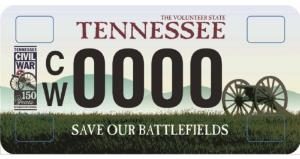 In a joint statement from the field, Generals Grant and Lee reflected on Tennessee’s 2017 battlefield preservation license plate campaign. Conferring with each other, Grant remarked, “General Lee, I have seen an impressive number of carriages and wagons, some 1200 or so, with the TCWPA license plate. I am pleased.” General Lee responded, “General Grant, I am gratified too. The 2017 campaign has been successful. So many of our soldiers and citizens want to preserve the lands that saw such courage and valor by the men of both of our armies. We thank them all.”
In a joint statement from the field, Generals Grant and Lee reflected on Tennessee’s 2017 battlefield preservation license plate campaign. Conferring with each other, Grant remarked, “General Lee, I have seen an impressive number of carriages and wagons, some 1200 or so, with the TCWPA license plate. I am pleased.” General Lee responded, “General Grant, I am gratified too. The 2017 campaign has been successful. So many of our soldiers and citizens want to preserve the lands that saw such courage and valor by the men of both of our armies. We thank them all.”
Generals Grant and Lee also announced their 2018 campaign to urge citizens to purchase or renew their license plates. Together they charged Tennesseans to double their efforts to promote more license plates on their carriages and wagons.
The license plate can be purchased at any County Clerk’s office for $36.00 plus your regular registration fees. Proceeds from the sale of the plate will help protect and interpret important battlefields in Tennessee. For more information, visit: tcwpa.org/license-plate
December, 2017
“SAVE NASHVILLE PARKS” RELEASES NEW VIDEO DEPICTING PARK WITHOUT COMMERCIAL DEVELOPMENT
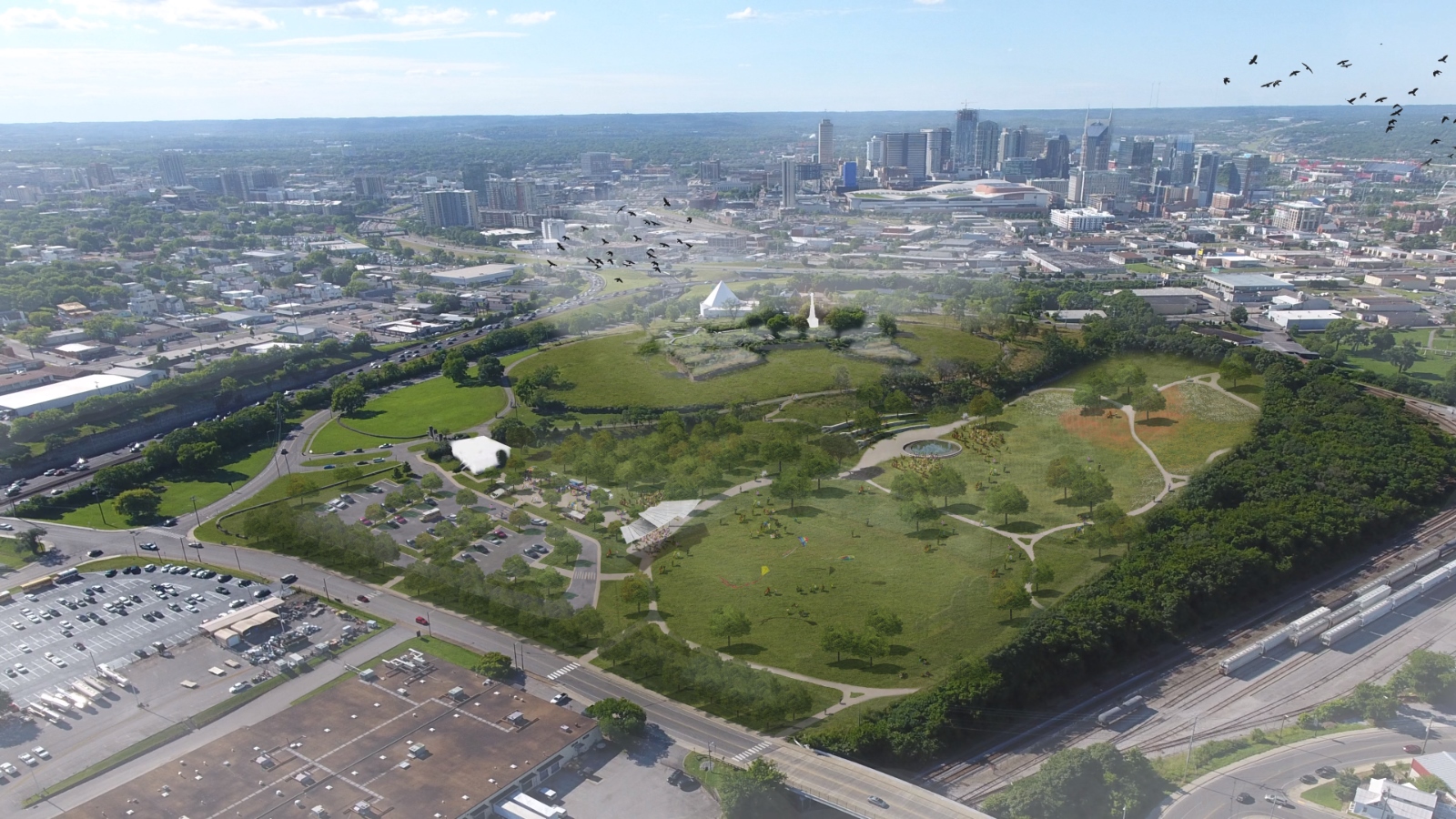 “Save Nashville Parks” has released a new video in support of the preservation of Fort Negley Park as parkland. The video, which emphasizes the historical significance of the Fort and the surrounding grounds, includes an artist’s rendering of the park as it would appear without the now-abandoned Greer Stadium, and without Metro’s tentatively-approved commercial development which would cover much of the green space and historic grounds.
“Save Nashville Parks” has released a new video in support of the preservation of Fort Negley Park as parkland. The video, which emphasizes the historical significance of the Fort and the surrounding grounds, includes an artist’s rendering of the park as it would appear without the now-abandoned Greer Stadium, and without Metro’s tentatively-approved commercial development which would cover much of the green space and historic grounds.
Click HERE to see the full video. The Battle of Nashville Trust fully supports the preservation of the unique historic site.
Negley Gains National Attention
PETITION FILED TO PROTECT FT. NEGLEY PARK
On Monday, October 9, 2017, The Friends of Fort Negley filed a petition with the Tennessee Historical Commission, pursuant to a state historical preservation statute, to prevent commercial development of Fort Negley Park.
The filing gained attention in both local and national media, including U.S. News & World Report (see below).
The Battle of Nashville Trust is one of many historical preservation groups supporting the parkland preservation and opposing the development of a part of the original park currently occupied by the defunct Greer Stadium baseball field. BONT and other citizen and historical groups are pushing Metro Nashville to preserve the area as parkland green space.
Information about the petition, its background and future proceedings are discussed in these two articles in The Nashville Tennessean and U.S. News & World Report.
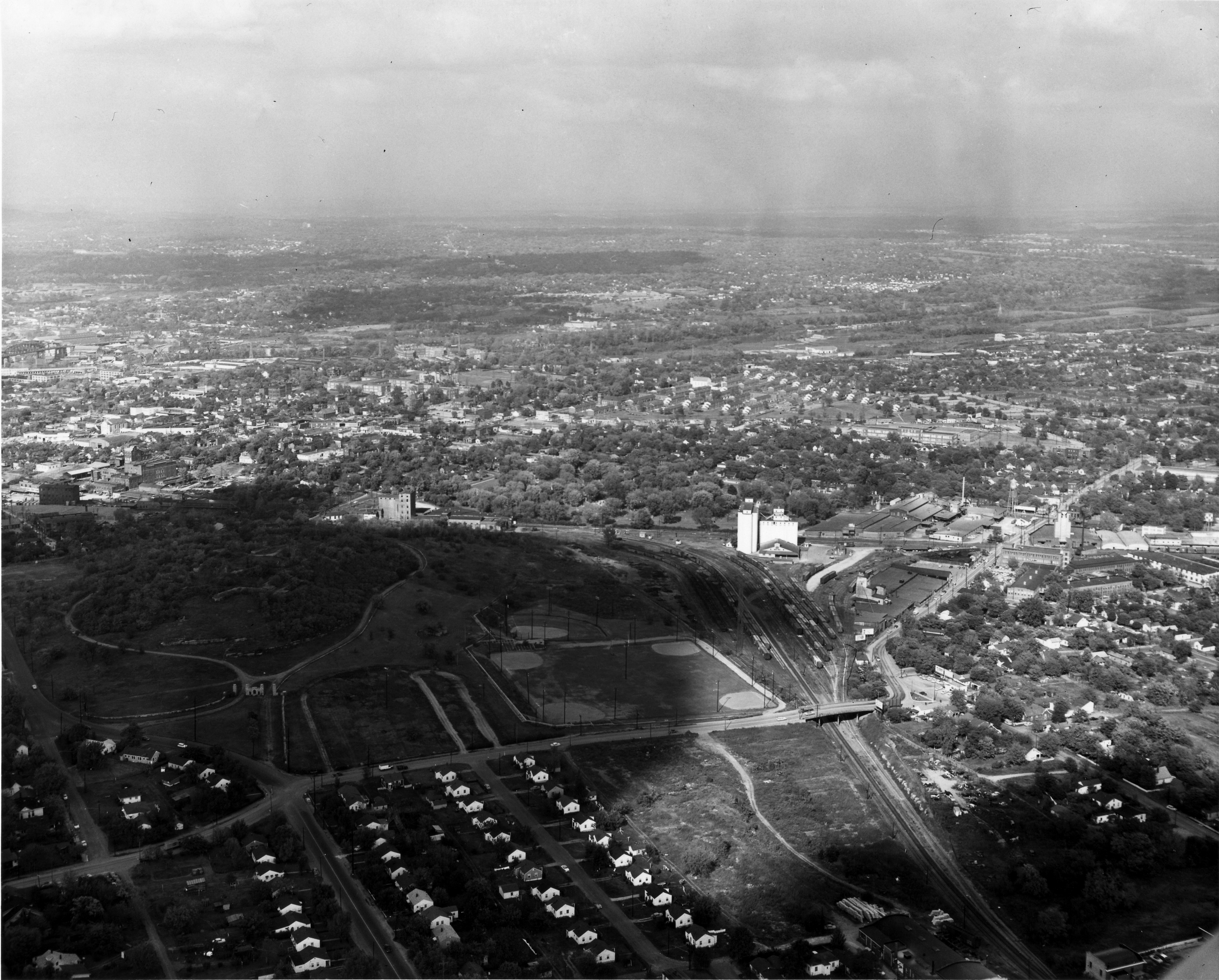 Above, Ft. Negley Park: aerial view in 1940s, before construction of Greer Stadium (click to enlarge)
Above, Ft. Negley Park: aerial view in 1940s, before construction of Greer Stadium (click to enlarge)
July, 2017
BONPS SUPPORTS PRESERVATION OF FORT NEGLEY PARK
The Battle of Nashville Trust supports the effort to preserve the vacant Greer Stadium and surrounding parking lots as green park land and recommends the resource and action website set up by Friends of Fort Negley: https://savenashvilleparks.org/ .
The effort to preserve the parkland surrounding Ft. Negley has now gained the support of The Civil War Trust, the nation’s largest and most prestigious nonprofit organization dedicated to saving the nation’s battlegrounds. CWT’s president, O. James Lighthizer, has written a letter to Mayor Barry expressing the Trust’s reasons for supporting green space over development. Here is the full text of his letter.
Nashville architect Ben Page has completed an artist’s rendering of Ft. Negley Park as it would appear if preserved as green space parkland. The photos below show a comparison of the 21 acres in question, first as green space, then as a developed track in keeping with the Cloud Hill Group proposal.
When the Nashville Sounds baseball operation vacated Greer Stadium for its new location, speculation began as to the future of the 21 acre area that once included the stadium and paved areas surrounding it, all of which is adjacent to historic Fort Negley.
On May 26, 2017, Metro completed a closed-door proceeding in which it reviewed the proposed plans submitted by five for-profit developers, and the final result was the selection of Nashville commercial developer The Matthews Company and its development team for the project, Cloud Hill Partnership. The proposal includes preserving only 8 acres in some form of open space, with the remaining 13 acres built out to include approximately 300 units of affordable, workforce and market-rate housing, a “neighborhood-scale” market, retail area with restaurants and shops, and a music and arts center.
The Battle of Nashville Trust joins the large contingent of citizens, preservationists, historians and historical associations, neighborhood associations, archeologists, and many others who advocate for the preservation of this land as green park space. For more information about the issues and proposals involved, please visit https://savenashvilleparks.org/, organized and created by The Friends Of Fort Negley as a resource for Nashvillians to understand why the City needs to avoid the loss of more priceless historical ground, and how to support the push for preservation.
New for 2017
HANDS-FREE GPS-GUIDED AUDIO TOUR OF NASHVILLE BATTLEFIELD NOW AVAILABLE AS A SMARTPHONE APP
A new GPS-guided smartphone driving tour app is now available to allow users to find — and hear information about — all 50 Battle of Nashville historical markers.
The “Battle of Nashville Driving Tour,” created by Tour Buddy, can be downloaded from the Apple App Store, or iTunes, for a cost of $9.99. It is designed for iPhone, iPad, and iPod touch and requires iOS 9.0 or later.
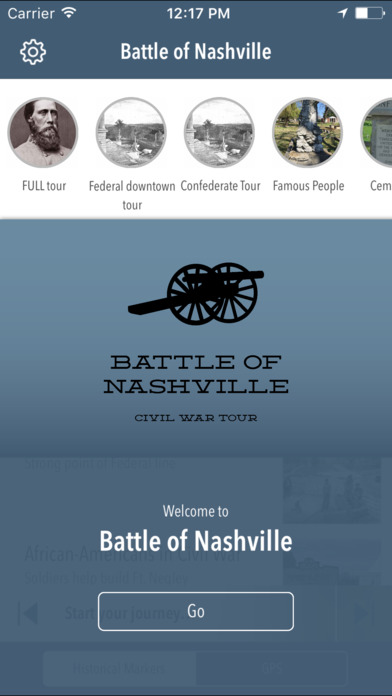 According to the development team, headed up by Rob McDonald Jr. of Nashville, the tour is “a comprehensive, hands-free, GPS-triggered tour of the largest battlefield in a metropolitan city.”
According to the development team, headed up by Rob McDonald Jr. of Nashville, the tour is “a comprehensive, hands-free, GPS-triggered tour of the largest battlefield in a metropolitan city.”
The self-guided tour is organized into 3 tours that you can take at the user’s own pace, including:
1. Full tour of all 50 stops
2. Northern tour, featuring downtown locations and Union fortresses, including Ft. Negley
3. Southern tour, featuring homes, forts, battlefields, and more.
The Battle of Nashville app also features information on local cemeteries, Federal and Army of Tennessee officers and famous people. The app is rich in content including interviews with Nashville leading historians.
The developers stress that users should not operate their smartphones or similar devices while driving, but the app is designed to avoid that problem: After download, users can press the “Allow” button, which then enables GPS to locate markers while driving and as the car approaches a marker, the App then triggers the audible content for that marker.
It can also be used manually without GPS to hear the information for each location. Complete user instructions are included in the App and can be accessed after downloading.
May, 2017
BATTLE MONUMENT GETS BADLY-NEEDED REHAB
As of May 31, 2017, the Tennessee Historical Commission has completed its program to repair and refurbish the amphitheater and the grounds surrounding the Battle of Nashville Monument located on Granny White Pike.
The site was part of the Noel Farm on the first day of the battle and was positioned on the front line of fighting on December 15, 1864, when Union forces from Nashville attacked the Confederate left flank that day, The grounds also feature a “witness tree” which was present on the first day of the battle.
The Monument had been showing the wear of the years following its dedication at this site in 1999. It was originally located off Franklin Road near I-440, but was heavily damaged by a tornado in 1974 and moved to this location to make it more accessible to visitors. According to news reports, the THC funded this much-needed rehabilitation project that was performed by The Tradesmen Group and facilitated by Tennessee Historic Sites Program Director Dan Brown.
In addition to replacing the missing letters in the metal signage on the rock wall along Granny White Pike, the work also included repairing other damaged metal, concrete blocks, and other areas around the monument, and the entire site was pressure washed.
For more information about the Battle of Nashville Monument, including the witness tree, please visit the BONPS Monument page.
The Battle of Nashville Preservation Society, in its mission to protect portions of the historic battlefield sites, is grateful to the Tennessee Historical Commission for this important rehabilitation of the monument and the grounds which stand where the first day of the battle of Nashville was fought. For visitors, the Monument park is located on Granny White Pike between I-440 and Woodmont Blvd. in South Nashville.
April 1, 2017
VOLUNTEERS ATTACK, CONQUER HONEYSUCKLE ON PARK DAY 2017
A huge volume of bush Honeysuckle and other invasive foliage and debris was cleared from Shy’s Hill and Redoubt No. 1 on April 1, which was “Park Day 2017,” the annual national Spring cleaning day for Civil War sites sponsored by the Civil War Trust.
The event was the latest in a long line of Park Days in which The Battle of Nashville Preservation Society has participated annually with the help of volunteers.
April Fool’s Day was no joke to the volunteers who wielded chain saws, loppers and muscle power to shape up the Battle of Nashville properties. At Redoubt No. 1, where honeysuckle has continued its relentless attack on the open ground of the fort, BONPS board members Parke Brown (with his son Blades, 9) and Philip Duer led the way with chain saws and stump-killers to reclaim the open ground back to the property line.
Here’s an example of their work, showing the debris pile in its early stages.
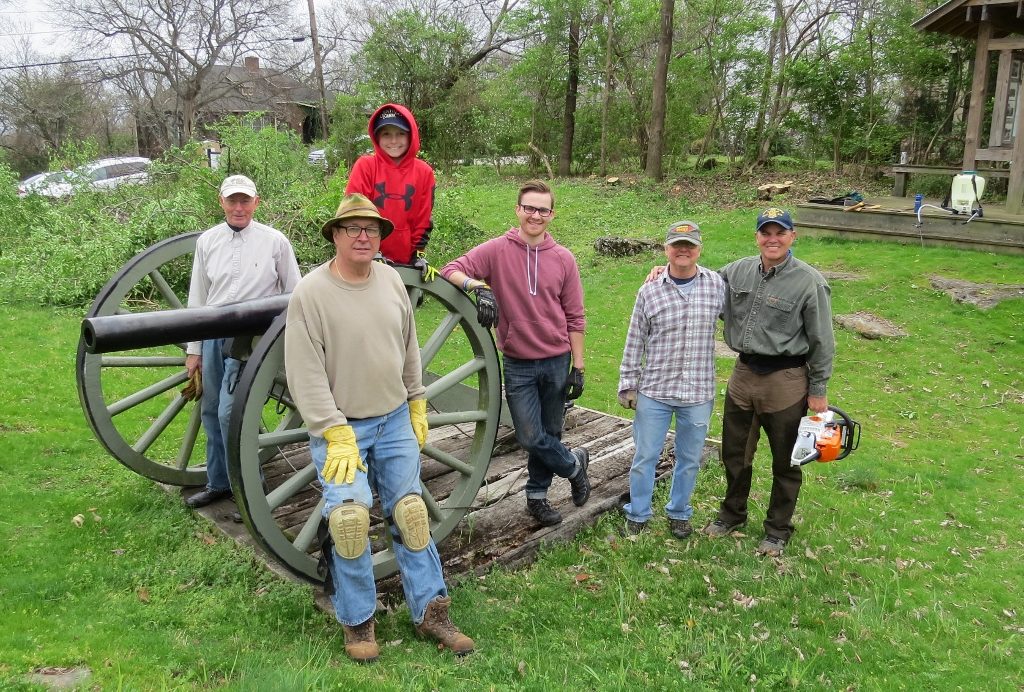
Redoubt work crew (L to R): Jim Sobery, Philip Duer, Blades Brown, Taylor Agan, Oliver McIntyre and Parke Brown
The Parke Company was set to chip the mound of honeysuckle and stacked tree limbs that had encroached on the redoubt.
Volunteers included Jim Sobery, a representative of The Tennessee Land Trust, along with his friend Oliver McIntyre, and Taylor Agan, a song-writer and entertainer who has a close connection with Redoubt No. 1 because his great-great-great-great grandfather, a Union officer, was wounded in the attack on the fort.
For more on his ancestor, see the Descendants page on this website for Capt. Jonathan Joseph Rapp of Company C, Liberty Guards, 49th Ohio Veteran Volunteer Infantry.
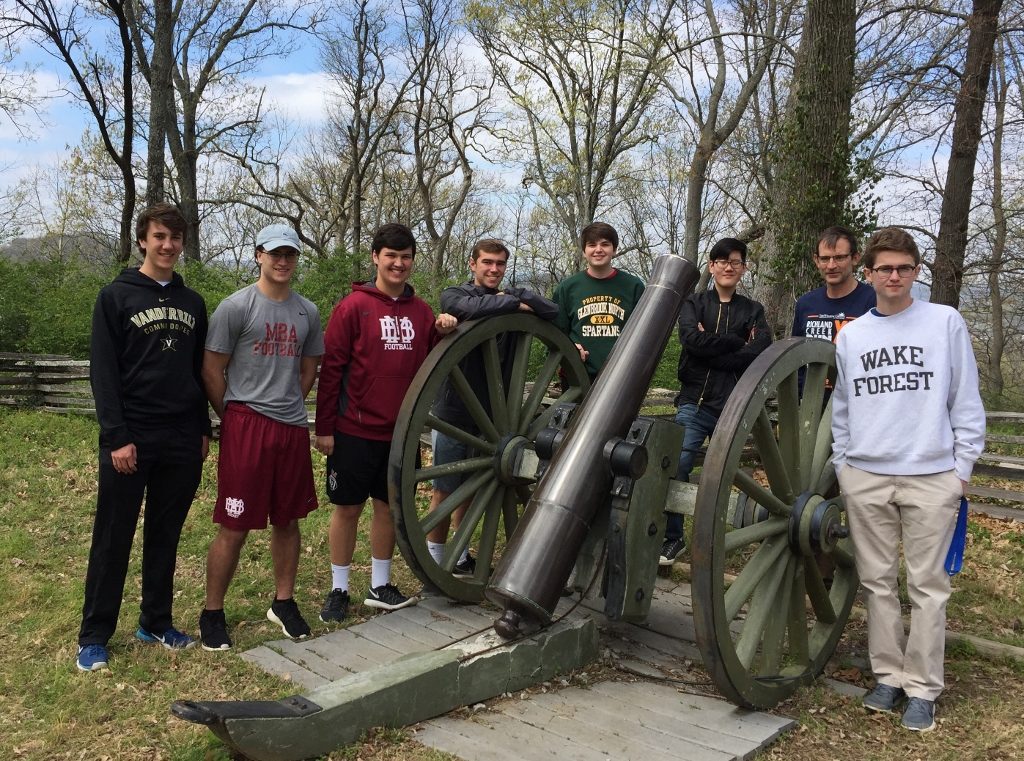
MBA workers (L to R): William Stewart, Cooper Maddox, Jackson Link, Luke Bernatavitz, William Bradford, Danny Lee, Clay Bailey (teacher and group leader), and Sam Funk
At Shy’s Hill, BONPS board members Jim Kay and Sidney McAlister took the morning shift, followed by member and friend Dr. Clay Bailey III, head of the History Department at Montgomery Bell Academy, who showed up in the MBA bus with seven sophomores, including William Stewart, Cooper Maddox, Jackson Link, Luke Bernatavitz, William Bradford, Danny Lee, and Sam Funk.
They cleared many piles of pre-cut honeysuckle from the heights of Shy’s Hill and deposited them on the roadside for chipping later by The Parke Company. The experience was also a teaching event for the students, with Dr. Bailey quizzing and teaching them during the day about various aspects of history associated with the Civil War. The MBA students earned community service points as part of their experience.
The BONPS Board and its members are extremely appreciative of the time and effort expended by these volunteers, whose commitment to history helps make the preservation of these battlefield sites possible.
- Volunteers clear Redoubt No. 1 honeysuckle
- Honeysuckle pile grows behind 3-inch Ordnance Rifle at Redoubt
- Parke Brown attacks tree that fell on Redoubt grounds
- Power trio of Parke Brown, Philip Duer and "the boss," Blades Brown
- Brown and Duer hammering the honeysuckle
- Taylor Agan and Philip Duer examine Jim Sobery's 1850 Union sabre
- Songwriter Taylor Agan
- Jim Sobery with
pistol & U.S. sword
- MBA men begin the Shy's Hill climb
- MBA crew, led by faculty member Clay Bailey, received well-earned community credits for their work at the historical site
March 9, 2017
REPAIR OF MINNESOTA MONUMENT COMPLETED
The Battle of Nashville Preservation Society, with a significant assist by The Parke Company, has completed repair of the Minnesota Monument, located on the lower terrace of Shy’s Hill. The granite structure had been damaged in late 2016.
The Monument was placed on the hillside by the Minnesota Civil War Commemoration Task Force, in association with BONPS, in November, 2014, as part of the Sesquicentennial of the Battle of Nashville. It stands in honor of the 97 Minnesota troops who died in the charge up Shy’s Hill on December 16, 1864.
Re-working of the base and re-setting of the granite monument was accomplished by Parke Brown of the BONPS Board and The Parke Company, Nashville’s elite multi-service landscaping firm. Please visit The Parke Company website for more information on the wide array of excellent services they provide.
For this project, numerous Parke personal, specialized tools and one of the company’s cranes were used in conjunction with their many years of expertise in the care and maintenance of Nashville’s residential and historic landscapes.
January 19, 2017
Haslam Declares Robert E. Lee Day In Tennessee
Below is a copy of the 2017 Proclamation by Tennessee Gov. Bill Haslam declaring, in keeping with state law, that January 19, 2017, is “Robert E. Lee Day” in Tennessee. (Click image to enlarge)
_________________________________________________________________________
OPINION: UDC FUNDS COULD BE USED BY BONPS FOR BATTLEFIELD PRESERVATION
Vanderbilt University recently announced that has entered into a $1.2 settlement with the United Daughters of the Confederacy which will result in the word “Confederate” being removed from the Confederate Memorial Hall dormitory on VU’s Peabody Campus. The following opinion piece from The Nashville Scene suggests uses for the funds, including a potential donation to The Battle of Nashville Preservation Society which could be used for battlefield maintenance and preservation. Read the entire article HERE.
Saturday, April 2, 2016
BONPS WAGES WAR AGAINST HONEYSUCKLE ON SUCCESSFUL “PARK DAY 2016“
The Battle of Nashville Preservation Society, in conjunction with The Civil War Trust and volunteers from Hands On Nashville (HON), utilized Park Day 2016 to attack the persistent encroachment of honeysuckle on the hallowed ground of Shy’s Hill.
BONPS again requested – and received — the assistance of enthusiastic volunteer workers through Hands On Nashville, who answered the call to “restore this battlefield by clearing non-native vegetation as well as renovating trails, removing brush and deadfalls, and clearing entrenchments.”
 Above: Former BONPS President Philip Duer (left) and Board Member Parke Brown, thin out the honeysuckle jungle on the Hill’s eastern slope
Above: Former BONPS President Philip Duer (left) and Board Member Parke Brown, thin out the honeysuckle jungle on the Hill’s eastern slope
The April 2 work day was created for preservation organizations like BONPS to utilize members and volunteers to help maintain Civil War sites. As a result, hundreds of honeysuckle shrubs were cut and dragged down the hill, opening up the northern trench line and clearing the field of view on all sides of the summit. A number of dead trees were also removed during the day.
The brush piles and debris will be chipped and hauled away by The Parke Company, Nashville’s preeminent landscaping firm owned by BONPS board member Parke Brown.
BONPS President John Allyn praised the hard work of the HON volunteers, two Civil War Trust members, and Jim Sobery of the Tennessee Land Trust. Photos by Tom Lawrence
 Above: A fresh breeze was flying the memorial flags on Park Day, the banners representing the United States, the Minnesota State Flag in honor of the lead attack force which overtook the Hill, and the Confederate Battle Flag representing the forces defending the Hill
Above: A fresh breeze was flying the memorial flags on Park Day, the banners representing the United States, the Minnesota State Flag in honor of the lead attack force which overtook the Hill, and the Confederate Battle Flag representing the forces defending the Hill
- HON volunteers Jennifer Dorsett & Marcel Martinez chat with Jim Sobery of the Tenn. Land Trust
- (L to R) Johnny Murphy and Jack Allyn taking a break from the action
- Board member Sidney McAlister
- HON volunteers Nicole Holling, Jacque Prentice, and Mark Holling
- Phil Duer chats with Nicole and Mark Holling
- Board member and former BONPS president Jim Kay takes down another sapling
- Civil War Trust members Wayne Huff (L) and Bonnie Seay helping clear the eastern slope
- "Master Sawyer" Parke Brown descends the hill after clearing multiple fence lines
- A cooling chainsaw faces south from the summit
- BONPS served pizza lunch to the volunteers after the successful work day
Saturday, December 12, 2015
NEW STONE WALL, WALKING TOUR, HIGHLIGHT 151st ANNIVERSARY OF BATTLE
The 151st anniversary of the Battle of Nashville was held at the summit of Shy’s Hill on Saturday, December 12, 2015, featuring a summary of the battle by historian Jim Kay and the new stonework at the Minnesota monument.
Visitors to the hill were surprised to see that BONPS board member Parke Brown and his professional crew from The Parke Company, continuing their generous tradition of helping to preserve the historical sites of the battle, had completed a dry-stack stone wall around the Minnesota Monument which was dedicated in December, 2014, at the Sesquicentennial event.
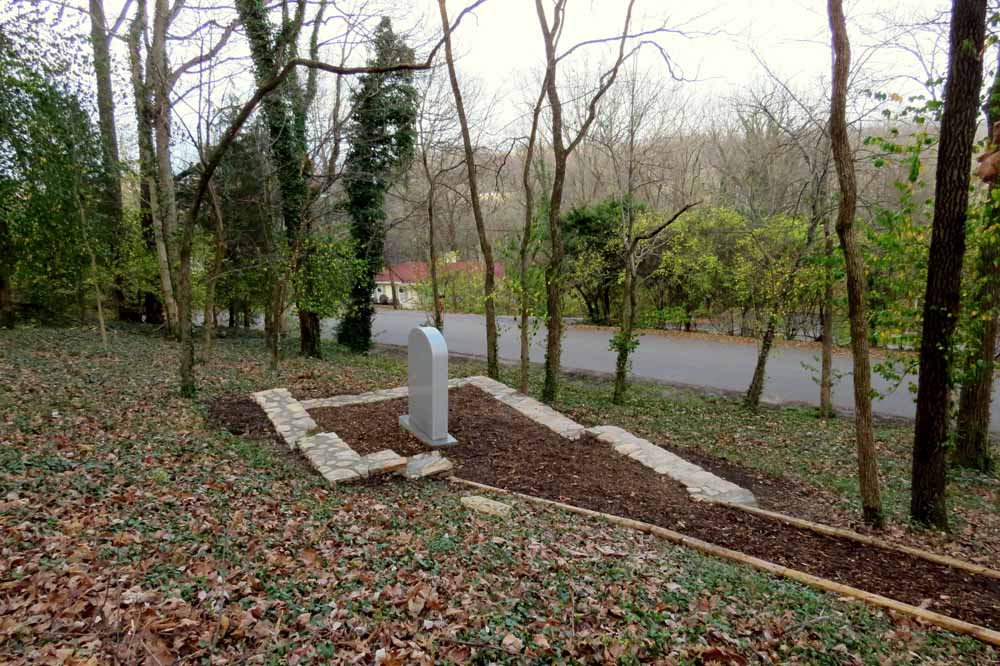
Above: The Parke Company, courtesy of BONPS board member Parke Brown, designed and constructed a stone plaza around the Minnesota Monument.

Above: BONPS board members Jim Kay and Sidney McAlister inspect the new stone work around the Minnesota Monument
The State of Minnesota lost more soldiers than any other state during the violent clash at the top of Shy’s hill on December 16, 1864. For more information on the Monument, see the Sesquicentennial page on this website.
Various visitors commented that the new stone plaza is reminiscent of stone work often featured in national battlefield parks. Ken Flies, who headed the Minnesota commission responsible for funding and placing the Monument, said that the new wall was “absolutely incredible what Parke has done. The stone is so symbolic and appropriate. A million thanks to all of you from Minnesota for your tremendous efforts.”
Former BONPS president Jim Kay lead a group of visitors on an informative tour of the Hill, from the Minnesota monument to the hilltop, stopping along the steep trail to show the remaining few feet of the original Confederate earthworks, and at the summit presenting his usual fact-filled and descriptive summary of the battle that occurred on December 16, 1864.
 Above: Sidney McAlister and Philip Duer listen as Jim Kay (R) describes the Confederate retreat from the southeastern slope of Shy’s Hill
Above: Sidney McAlister and Philip Duer listen as Jim Kay (R) describes the Confederate retreat from the southeastern slope of Shy’s Hill
 Above: Kay shows visitors the remnants of the original Confederate earthworks, marked by tree limbs, on the north slope of Shy’s Hill.
Above: Kay shows visitors the remnants of the original Confederate earthworks, marked by tree limbs, on the north slope of Shy’s Hill.
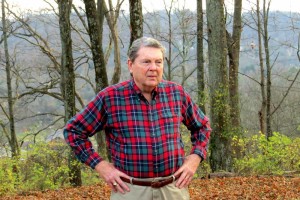 One of the highlights of Saturday’s event was an impromptu commentary by Nashville architect Wally Pilkinton, who told of his efforts to prevent the historic property now preserved as Confederate Redoubt No. 1 on Benham Avenue from being included in a subdivision development many years ago. One of his ancestors fought in the battle of Nashville and his family is in the process of gathering the materials to be included on the Descendants page on this website.
One of the highlights of Saturday’s event was an impromptu commentary by Nashville architect Wally Pilkinton, who told of his efforts to prevent the historic property now preserved as Confederate Redoubt No. 1 on Benham Avenue from being included in a subdivision development many years ago. One of his ancestors fought in the battle of Nashville and his family is in the process of gathering the materials to be included on the Descendants page on this website.
BONPS has begun an expensive project to replace the replica Napoleon artillery piece at the top of the Hill, which was damaged during the summer months.
October 17, 2015
SHY’S HILL, REDOUBT, GET AUTUMN FACELIFT
Spearheaded by former BONPS president Jim Kay along with Board member Sidney McAlister, a much-needed Fall clean-up at Shy’s Hill and Redoubt No. 1 got underway in mid-October, with a huge boost from students at Montgomery Bell Academy.
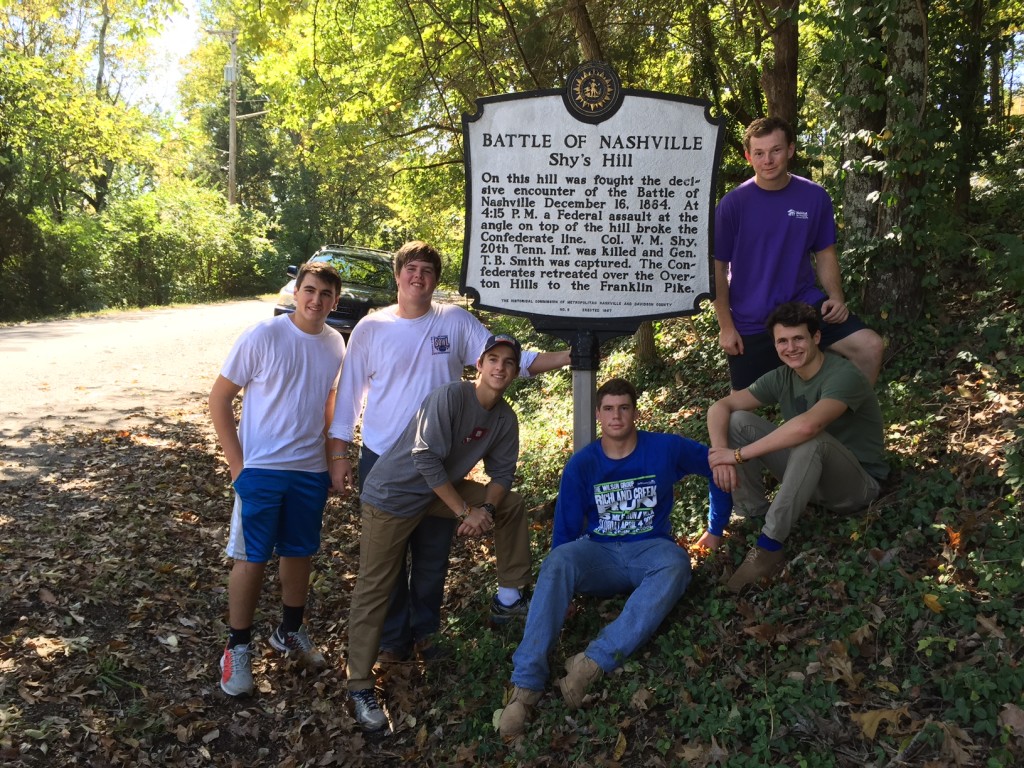
Above: LR– Boaz Kelner, Turner Johnson, Will Gray, Brett Starr, John Foiravanti (seated), Warner Lamar (standing)
“We had a big workday with MBA kids,” Kay said. The work resulted in remulching of most of the winding trail up to the Shy’s summit, clean up of trash, and cutting of honeysuckle foliage around the earthworks.
In addition, the volunteers cleaned and polished the Metro Historical Marker and donor monument at Shy’s Hill (as well as two others located at Lealand Lane and Granny WhiteKay said BONPS has ordered new flags for the monument on top of Shy’s, ordered two new park benches, and made improvements to the stairs leading up to the Shy’s Hill interpretative kiosk.
Over the summer months, the reproduction Napoleon cannon on Shy’s summit was severely damaged and BONPS is planning to move the artillery piece down the hill with a probable temporary resting place on the flat lower section where some Confederate artillery was positioned on December 16, 1864.
Kay said new cedar rails are being added to the Hill improvements. Chipping and other clean up at Shy’s and the Redoubt have been handled by BONPS board member Parke Brown and The Parke Company .
June 20, 2015
Historians Discuss Green Hills Area of Nashville Battlefield
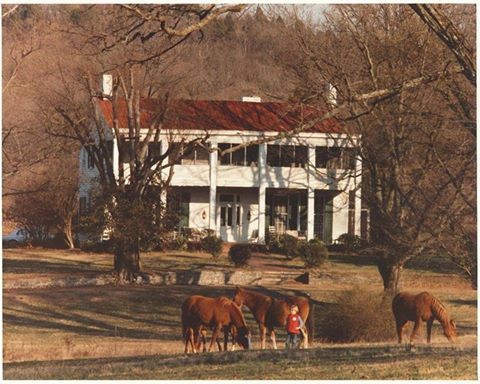
Above: “Seven Hills,” built in 1840 on what is now Burton Hills
On June 20, 2015, three historians and long-time residents of the Green Hills area of Davidson County recounted the history of the area, including discussions of the Battle of Nashville and the battlefield itself, as part of the annyal Green Hills Historic Homecoming event.
To watch a video of the event, click here.
The guest panelists were well-known local authors Paul Clements, Tom Henderson and George Spain. The Green Hills Library and The Green Hills Action Partners (TGHAP) presented the annual Green Hills Historic Homecoming panel discussion at the Green Hills Library. This is the 12th year of the event.
May 23, 2015
Fort Negley Hosts Memorial Day Event
On Saturday, May 23, 2015, Memorial Day was commemorated at Fort Negley with emphasis on the roles played by newly freed slaves and African-American Federal soldiers in the construction and defense of the fort.
According to the article published in the Nashville Tennessean, an estimated 600 – 800 local and newly-freed slaves died during construction of the fort prior to the battle of Nashville in December, 1864.
Krista Castillo, Fort Negley museum coordinator, pointed out that it is largely assumed that “because Fort Negley was never attacked that no one died here, and they often forget that battle deaths aren’t the only deaths.” She added that Fort Negley is “sacred ground” because of the sacrifices made by those involved in its construction under harsh circumstances.
In attendance at the ceremony were Civil War reenactors Bill Radcliffe and Gary Burke, dressed in Federal uniforms to commemorate the observance. Gary Burke Is a member of the Board of Directors of the Battle of Nashville Preservation Society. In the Tennessean article, he was quoted as pointing out that he wears the Federal uniform “to honor those who cannot be here to be honored themselves,” adding “that’s our battle today, to make sure that they are recognized, not us.” His great – great grandfather served in the Battle of Nashville as a member of the United States Colored Troops who saw intense action in the battle on both December 15 and 16, 1864.
For a complete report on the commemoration event, see the Tennessean’s article written by Tennessean writer Collin Cjarnecki with photos by Tennessean photographer Shelley Mays.
March 28, 2015
PARK DAY 2015: BONPS AND VOLUNTEERS CONSTRUCT TRAIL TO NEW MONUMENT
The Battle of Nashville Preservation Society again hosted “Park Day” on Saturday, March 28, 2015, at Shy’s Hill.
This year’s goal was construction of a timber-and-mulch trail to the new Minnesota Monument which was placed and dedicated just prior to the Battle of Nashville Sesquicentennial event in December, 2014.
In addition to BONPS board members, the trail was created with help from Clay Bailey of Montgomery Bell Academy and a group of MBA students: Charlie Bailey, Clay Cavallo, Davis Cavallo, Alex Stevens, Jeremy Choo, and Matt Miccioli. Also assisting were three volunteers from Hands On Nashville, including Nashville engineers Andrew Southern and Justin Twyford, and Heather Richards, who drove all the way from Shelbyville to participate.
“Park Day was successful because of the hard work and commitment to volunteer services by Clay Bailey and his MBA crew as well as the Hands On Nashville volunteers. BONPS is extremely appreciative for their participation in helping to preserve this part of the battlefield,” said John Allyn, president of BONPS.
Final work including some “professional tweaking” will be done by BONPS Board member Parke Brown and his crew from The Parke Company.
Park Day, sponsored by The Civil War Trust, is now in its 19th year. According to the CWT, it’s an annual hands-on preservation event to help maintain Civil War — and now Revolutionary War — battlefields and historic sites across the nation.
History buffs, community leaders, preservationists and other volunteers fanned out across 108 historic sites in 29 states for the annual spring cleanup at America’s battlefields and historic sites. In 2014, nearly 9,000 volunteers converged on 104 sites across the country, where they donated more than 35,000 service hours.
- Work begins on new trail to Minnesota Monument
- BONPS president John Allyn overseeing work
- Clay Bailey (far left) with MBA students (From L to R, Alex Stevens, Davis Cavallo, Jeremy Choo, Charlie Bailey, Clay Cavallo, Matt Miccioli)
- Interested onlooker
- Viewing area shaping up
- Clay Bailey with engineer Andrew Southern
- Taking shape
- BONPS Board members Parke Brown and Sidney McAlister
Fall 2014
NEW HISTORICAL MARKER DESCRIBES IMPORTANCE OF RADNOR LAKE STATE PARK’S INVOLVEMENT IN CIVIL WAR
A new historical marker is being planned for Radnor Lake State Park to explain the park area’s involvement in the Civil War, especially the Battle of Nashville.
The marker is part of a grant funded by the Department of Tourism for Civil War markers to be installed in various Tennessee State Parks. The Radnor Lake marker will be located at the Visitor Center off of Granny White Pike along the main entrance sidewalk.
The text of the marker, which was written by former BONPS president Jim Kay and approved by the BONPS Board of Directors, emphasizes the role of the Radnor area during the retreat of the Confederate army through the gap in the Brentwood Hills following their defeat on the second day of the Battle of Nashville — December 16, 1864.
The marker is expected to be placed and dedicated in the late Fall of 2014, just in time to be a part of the Battle of Nashville Sesquicentennial commemoration. It will read as follows:
May, June 2014
BONPS PLAYS ROLE IN HOSTING CIVIL WAR TRUST ANNUAL CONFERENCE IN NASHVILLE
The Battle of Nashville Preservation Society was heavily involved in Nashville’s hosting of the annual national conference of the Civil War Trust — “Twilight In The Western Theatre” — on May 28 through June 1, 2014, in Nashville.
BONPS held a reception for the Board of Directors of CWT at the home of Jim and Elaine Kay, located less than 100 yards from the stone wall which was defended on December 16, 1864, by Maj. Gen. William Loring’s Division of Stewart’s Corps. About 50 Board members and their spouses attended the event, which was highlighted by a concert by Nashville songwriter and recording artist Tim Nichols, who has written songs for numerous major country artists and won a Grammy award for Best Country Song in 2004.
BONPS also sponsored an exhibit booth at the Renaissance Hotel and Convention Center where the conference was held. Board member Jim Kay submitted an article on the history of Nashville’s battlefield preservation for the CWT program.
In addition to books and other items for sale at the BONPS table, the featured items were bowls and other artistic works fashioned from a 400-year old Burr Oak “witness tree” which stands within sight of the “Battle of the Barricade” where Confederate cavalry blocked Union troops in pursuit of the retreating Confederate army on Granny White Pike. Proceeds will be used by BONPS for the continued maintenance of battlefield sites.
The CWT convention was a significant success, attended by numerous advocates of battlefield preservation and Civil War history from all over the country. They came to hear the series of lectures by well-known Civil War historians on the battles in Middle Tennessee, and to attend battlefield tours which included the Battle of Nashville, Spring Hill and Franklin, Tullahoma, Ft. Donelson, and historic homes in Middle Tennessee.
July, 2014
Monuments Dedicated to Minnesotans Killed At Shy’s Hill
New markers are being dedicated in Plainview, Minnesota for three 10th Minnesota soldiers, including the only two Minnesota soldiers killed on the same day in the Civil War and buried together in the state. A third is located in another small nearby cemetery.
The three soldiers were all in Co. C, which was on the extreme left of the 10th Minnesota which was on the left of the Brigade that made the assault on Shy’s Hill.
On July 19, 2014, dedications were held for three other soldiers killed in combat in Nashville, including a captain and lieutenant in the 9th and a corporal in the 10th. Major General Rick Nash of the 34th Division (Red Bull Division) will be the keynote speaker at the dedications in Plainview.
See Flyer for Plainview Minnesota Dedication
2014
Shy’s Hill Gets New Trail For Sesquicentennial
The first “official” preparations for the Battle of Nashville Sesquicentennial year began in February as BONPS Board member Parke Brown and his professional landscaping crew from The Parke Company, Inc. (http://www.theparkecompany.com/) rebuilt the winding trail up the East slope and gave the summit a facelift with weedeaters and chain saws.
The result: Shy’s Hill and its topside memorial plaza look like a well-manicured state park, just in time for the commemoration of the 150th anniversary of the battle on the hill on December 16, 1864.
“It’s a good time to experience the uphill walk and contemplate the sacrifices made during battle,” Parke said. His crew spent 100 man hours in February, 2014, installing the 150 8-foot beams which are laid out end-to-end to line the winding three-foot-wide trail. Each beam was drilled and then anchored into the hillside with three 24-inch iron rebar rods. The trail surface was then filled with 12 cubic yard of hardwood mulch.
In all, the project resulted in the installation of 1,200 linear feet of 4×4 beams (purchased and delivered up the hill by Board member Sidney McAlister, Parke noted) and 420 pieces of rebar. Up top, the trails and debris were trimmed out and cleaned up, mud and debris removed from the concrete circle forming part of the memorial flag plaza, and the battle against honeysuckle continued.
“Parke’s contributions of manpower, materials, time and expertise have made Shy’s Hill ready for the Sesquicentennial in grand style. It shows what a difference professionals can make and gives the hill the park-like appearance it needs in order to honor the men who fought up there,” said John Allyn, BONPS president. “BONPS and everyone who visits the hill greatly appreciates Parke’s work. Now, if I could just get up the hill without stopping!”
December 6, 2013
ED BEARSS BRINGS BATTLE TO LIFE IN VISIT TO NASHVILLE BATTLEFIELD
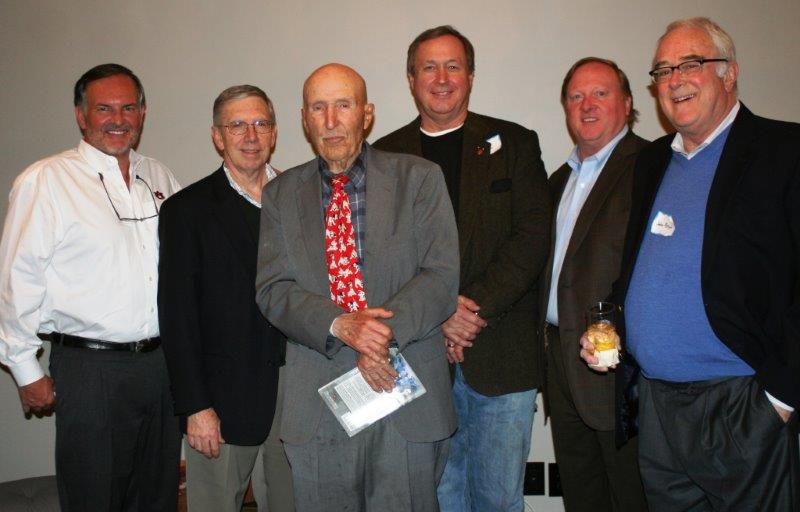
Ed Bearss with BONPS board members (L-R) Jim Kay, Tom Lawrence, Philip Duer, Sidney McAlister, and John Allyn (Photo by Elaine Kay)
A crowd of about 60 braved serious threats of an icy winter storm warning on December 6, 2013, to hear Civil War historian Ed Bearss give his insights into General John Bell Hood at the home of Jim and Elaine Kay, which rests on the battlefield within sight of the stone wall marking “Stewart’s Line.”
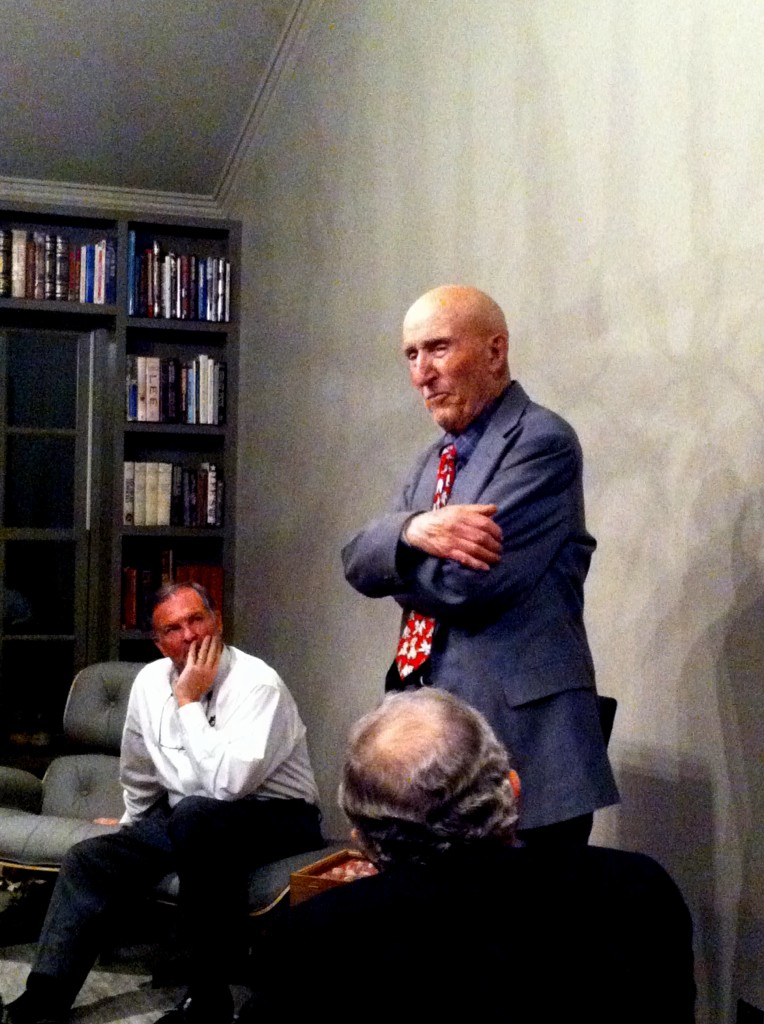 Mr. Bearss (pronounced “bars”), as eloquent and entertaining at 90 as ever, flew in the night before from his home in Virginia to give yet another of the thousands of presentations he has made in his career as a National Parks and Smithsonian Institute Civil War historian. (See the link at the end of this post for a recent article on his career dating back to his days as Director of the Vicksburg Civil War Park.)
Mr. Bearss (pronounced “bars”), as eloquent and entertaining at 90 as ever, flew in the night before from his home in Virginia to give yet another of the thousands of presentations he has made in his career as a National Parks and Smithsonian Institute Civil War historian. (See the link at the end of this post for a recent article on his career dating back to his days as Director of the Vicksburg Civil War Park.)
The evening at the Kays’ house was co-sponsored by both Traveler’s Rest and the Battle of Nashville Preservation Society and occurred only a week before the 149th anniversary of the Battle of Nashville.
Mr. Bearss chose as his topic a story-filled review of General Hood’s march into Tennessee in late 1864. With the booming voice that has made him the consummate battlefield guide, he spoke without notes for nearly 40 minutes as he traced Hood’s journey from Florence, Alabama, into Tennessee, spicing his history with anecdotes involving Hood during the highlights of the march including Spring Hill, Franklin, and finally Nashville.
Among his many points was his apparent approval of the conclusion reached in the new book about General Hood from his distant relative, Stephen Hood, which criticized the oft-printed conclusion that Hood’s mind was adversely affected by a combination of laudanum and whiskey.
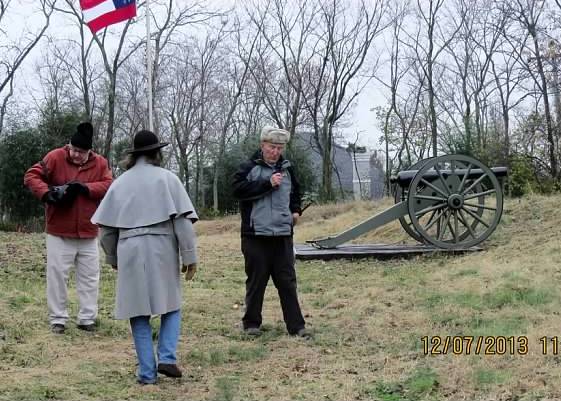
Bearss at Redoubt No. 1 (Photo by Fred Crown)
Along the way, Mr. Bearss told stories about General George Thomas and his political and personality skirmishes with Gen. John Schofield, revisited the classic story of General Earl Van Dorn and his demise at the hands of Dr. George Peters over an affair with his wife in Spring Hill, and many other vignettes told as only a professional storyteller like Ed Bearss can.
In taking questions from the rapt audience, he was asked by Jim Kay which of the hundreds of battlefields he has visited in his lifetime as a Civil War historian and field guide was the most moving to him. Without hesitation, he answered: Franklin.
Before Mr. Bearss’ presentation, Jim Kay introduced and showed a video trailer for a documentary film being produced in Nashville by David Currie and others entitled, “American Journey: The Life and Times of Ed Bearss.”
Despite the warnings of sleet and accumulating snow, the crowd reconvened the next morning at Traveler’s Rest for a day-long bus tour of sites depicting the Battle of Nashville.
Again, the frozen precipitation held off, and the bus tour hit its spots with Mr. Bearss in the front of the bus, and at the head of the line at each battlefield stop, interpreting the battle sites with fresh insights from his extraordinary experience and knowledge.
For an excellent article summarizing the highlights of Mr. Bearss’s career as a Civil War historian and battlefield guide, see the recent article in Arlington Magazine by Kim O’Connell by clicking on the photo below:
Below is the 2013 Battle of Nashville bus tour itinerary.
Itinerary
Start. Travellers Rest Historic House, 636 Farrell Parkway, Nashville, Tennessee 37220. Group will park their cars here and take a tour of the home. The bus can park in the large gravel parking lot in front of the home. Bus arrives at 9:30 am; plan on 10:00 am departure.
Stop 1. Granbury’s Lunette, located adjacent to 190 Polk Avenue, Nashville, Tennessee 37210. Suggested route: Right on Farrell Parkway, right on Lambert Drive, right on Franklin Pike, right on Harding Place, north on I-65, east on I-440, exit Nolensville Pike, north on Nolensville Pike, right on Polk Avenue, cross railroad overpass, park on very wide shoulder or in parking lot. 5.6 miles, 15 minutes. 20 minute stop, passengers disembark.
Stop 2. Redoubt # 1, 3422 Benham Avenue, Nashville, Tennessee 37215. Suggested route: backtrack on Polk to Nolensville Pike, left on Nolensville Pike, right (west) on I-440, exit Hillsboro Pike (south), left on Woodmont, left on Stokesmont Road, left on Stokes Lane, left on Benham Avenue. The redoubt is at the crest of the hill. 8.5 miles, 20 minutes. Park on shoulder; the road is not very wide but wide enough for a car to get by the bus. Passengers disembark, 15 minutes.
Stop 3. Redoubt # 3, located in parking lot at Calvary United Methodist Church, 3701 Hillsboro Pike, Nashville, Tennessee 37215. Suggested route: south on Benham, left on Woodmont, left on Hillsboro, right into church parking lot. Surviving piece of the redoubt is at the very back of the church property. Ample parking in the church parking lot. 5 mile, 15 minutes. Passengers disembark, 15 minutes.
Stop 4. John Trotwood Moore Middle School, 4425 Granny White Pike, Nashville, Tennessee 37204, located at the intersection of Lone Oak Drive and Granny White Pike. Suggested route: there is an exit from the church parking lot on to Crestmoor Road. Take this exit and take a right on Crestmoor and a left on Abbott Martin. Zigzag across .Hillsboro at the light and proceed on Richard Jones Road to its intersection with Lone Oak Road. 2 miles, 15 minutes. Go right at Lone Oak Road which will curve to the east. Pull into the parking lot at John Trotwood Moore Middle School. There will be ample parking. Passengers disembark, 20 minutes
Stop 5. Fort Negley, 1100 Fort Negley Boulevard, Nashville, Tennessee 37203. Suggested route: Left on Granny White, proceed on Granny White/12th Avenue South to Edgehill Avenue, right on Edgehill, cross 8th Avenue South, left on Fort Negley Boulevard, right into park entrance. 4 miles, 15 minutes. Ample street parking. Lunch stop, 1 hour. We will have a box lunch for the driver. If the weather is nice we will eat lunch in the fort at the top of the hill. The gates will be removed so that the bus can drive up to the top. If it is not nice we will have lunch in the auditorium in the visitor center.
Stop 6. Nashville City Cemetery, corner of Oak Street and 4th Avenue South, 1001 4th Avenue South, Nashville, Tennessee 37203. Enter by gate on 4th Avenue North, not the gate at the intersection. Buses are not allowed in the cemetery. Suggested route: Right on Fort Negley Boulevard, pass Adventure Science Museum, continue across railroad overpass onto Oak Street, turn right at 4th Avenue South, stop at gate near the southeast end of the cemetery. .8 mile, 5 minutes. Bus can park on the street. Passengers disembark. 20 minutes.
Stop 7. Shy’s Hill, 4617 Benton Smith Drive, Nashville, Tennessee 37215. Suggested route: South on 4th Avenue South, veer right on Rains Avenue, right on Wedgewood, south on I-65, exit Harding Place, right on Harding place, continue on Harding Place/Battery Lane to Benton Smith, left on Benton Smith Drive. 8.5 miles, 20 minutes. Passengers disembark. Road is too narrow for bus to remain; park in parking lot of St. Bartholomew’s Episcopal Church (proceed south on Benton Smith, left on Burton Valley, proceed into parking lot at the intersection with Belmont Park Terrace. 1 hour. We will call the driver when we come back down the hill.
Stop 8. Peach Orchard Hill. Upper parking lot, Franklin Road Academy, 333 Franklin Pike, Nashville, Tennessee 37220. Suggested route: Belmont Park Terrace to Battery Lane, left on Battery Lane, left on Benton Smith, embark passengers. Proceed south on Benton Smith, left on Burton Valley, right on Belmont Park Terrace, left on Tyne Boulevard, proceed on Tyne Boulevard to Lealand Lane, left on Lealand Lane, right on Battery Lane, right on Franklin Pike, left at southernmost entrance to Franklin Road Academy, proceed to uppermost back parking lot. 3.6 miles 20 minutes. Passengers disembark. 30 minutes.
Return to Travellers Rest. 1 mile, 5 minutes
October 19, 2013
13th USCT Veterans Honored in Maury County
On October 19, 2013, a special ceremony was held at the Maury County Court House in honor of 54 members of the 13th United States Colored Troops who fought from that county in the Civil War. A contingent of USCT reenactors participated in the ceremony in full dress uniforms; among them was Gary Burke, a member of the BONPS Board of Directors whose ancestor fought in the Battle of Nashville in 1864.
Nashville’s WTVF Channel 5 reporter Aundrea Cline-Thomas was present at the ceremony and posted the report below on the Chan. 5 website:
By Aundrea Cline-Thomas
COLUMBIA, Tenn. – African American soldiers who fought during the Civil War have been honored in Maury County.
The names of the men who fought in the 13th United States Colored Troops Regiment were added to a memorial at the county courthouse in Columbia. Many historians feared the often untold story of the regiment would be forgotten. Although some of the men who fought were free men, many were slaves who served in the Union Army and fought for their freedom.
More than 200,000 African American soldiers were members of the United States Colored Troops during the Civil War. Until recently, their stories have widely gone untold.
“All history is important,” George Smith, 13th United States Colored Troop Living Association reenactor said. “If you leave out any aspect then it’s not complete.”
Five men dressed in uniforms resembling those worn during the Civil War reenacted the bravery of both freemen and slaves. “They left these plantations,” historian and reenactor Norman Hill explained. “They left their portions of servitude and joined the Union army.”
The soldiers joined the 13th U.S. Colored Troops Regiment that started in Murfreesboro. “What goes through the mind of a man who’s been in bondage for over 200 years, his people, to pick up a rifle and say I’m willing to fight for my own freedom,” Smith asked “That gives me a chill when I think about that..”
150 years later it’s up to the members of the Living History Association to share the sacrifices that are often untold; or worse forgotten.
“I am a descendent of one of those soldiers,” reenator Gary Burk explained. “Peter Bailey of Company K of the…United States Colored Troops that fought….in 1864.”
On Saturday, the names of 54 African American Civil War soldiers from Maury County are now etched in stone. “I wish that more of a young generation was here so they could see this historic moment,” attendee Johnny Armstrong said.
The names of the Civil War soldiers are now next to the names of their fallen comrades from other wars like Armstrong’s brothers.
“Generations…can come here and look and see where they came from and say…not only did the white(s) participate in the civil war but we also had those who were slaves at the time,” Armstrong said. Four white soldiers who fought for the Union Army were also added to the memorial.
July 27, 2013
2013 Civil War Model Show Held At Fort Negley
A model show with emphasis on the Civil War was held at Fort Negley on July 27, 2013. There were 7 exhibitors and an exhibition of a war game of the Battle of Stones River. Show director Philip Duer, former president of BONPS, reported that “although not completed at the end of the Model Show, the results came close to what happened during the actual battle!”
Model displays varied from a 2nd Century B.C. diorama of a barbarian ambush of a Roman legion detachment to a 1/6th scale WWII glider built by an actual pilot (Ret. Col. Al Hulstrunk) who flew combat missions into Germany during the war. The People’s Choice Award went to Todd Jackson for his stunningly realistic Afrika Korps (“Rommel on the Hunt”) diorama in 1/6th scale. John Mansfield won for his beautiful French 17th Century wooden warships and Jamison Gorrell for his Monitor and Merrimac battle diorama.
The following were the award categories and winners:
People’s Choice Award: “Rommel on the Hunt” Todd Jackson
Civil War Infantry: 1st & 2nd Place (1) “Cleburne’s Div.” & (2) “Zouaves” Jeff Williams of Murfreesboro
Civil War Ships: 1st Place “Monitor & Merrimac” Jamison Gorrell
Toy Solder Collection 1st Place “Burnside’s Bridge” Jamison Gorrell
Open – All Eras: 1st Place WWI Glider Display Col. (Ret.) Al Hulstrunk
2nd Place 17th Century French Warships John Mansfield
3rd Place Mine Displays (to Infinity) Col. Al Hulstrunk
Modelers below age 15: 1st Place Titanic (wooden ship model) Eric Lindelof
Certificate of Appreciation: Railroad Display John Allyn
War Game-Battle of Stones River Al Gaiser & Company
“I would like to thank Krista Castillo, Director at Fort Negley, and her staff for their help in putting this show on; it was very much appreciated. I would also like to thank Paul Smith for his great photographs which we have placed on our website,” Duer said. “This is the second year BONPS has supported a model show. We expect to have another show next year at Fort Negley in July, and I would encourage you to participate as a spectator, model builder, or to spread the word to children of all ages to compete and learn about history.”
For information about next year’s show, contact Philip Duer at (615) 301-4800 or pwduer@gmail.com.
Saturday, April 6, 2013
Civil War Park Day: Shy’s Hill
The Civil War Trust and History™ annually sponsors “Park Day,” an opportunity for volunteers to converge on nearby Civil War preserved areas to help maintain the grounds and improve the appearance and interpretation of the site. The Battle of Nashville Preservation Society participated with a Battle of Nashville Park Day 2013 work session on April 6, 2013, at Shy’s Hill.
Nationally, the Civil War Trust has sponsored Park Day since 1996. It was designed to be “an annual hands-on preservation event to help Civil War battlefields and historic sites take on maintenance projects large and small. Activities are chosen by each participating site to meet their own particular needs and can range from raking leaves and hauling trash to painting signs and trail buildings.” For more details, see the CWT website on Park Day at http://www.civilwar.org/aboutus/events/park-day/
Here is BONPS President John Allyn’s report on the day’s work:
“The Civil War Preservation Trust designated April 6 as the 2013 Park Day, an occasion at which volunteers would work to upgrade and maintain significant Civil War sites. We were no exception. Although our usual pool of college fraternity labor was missing due to out-of-town parties (priorities, you know) members and parents from the Children of the Confederacy (high school kids for the most part) came and did their part on Shy’s Hill, a key part of the Nashville battlefield. The major effort was devoted to unloading 150 landscape timbers and placing them alongside the steep and tortuous trail up the hillside. Following that the group cut up fallen trees on the site and used the branches and logs as “abatis” and “head logs” to mark the Confederate trench line. BONPS board members Sidney McAlister, John Allyn and Philip Duer also provided assistance.”

Above: Deanna Bevels. Nashville, Tennessee and Sidney McAlister, Vice President of the Battle of Nashville Preservation Society, take a short break after unloading landscape timbers at Shy’s Hill.

Above: What to do next? Philip Duer, Past President of the Battle of Nashville Preservation Society speaks with Kristie Welch, Cookeville, Tennessee and Susan Harris, Nashville, Tennessee about the next task.
BONPS ANNUAL MEETING REPORT 2013
More than 60 members of the Battle of Nashville Preservation Society convened for the groups’s Annual Meeting on January 31, 2013, at the home of John and Cary Allyn, which sits within the range of a minie ball fired from the sites of Confederate Redoubts 2 and 3.
The event was highlighted by the installation of John Allyn, a Nashville attorney known for his scholarly writing on the Battle of Nashville (much of which is published on the BONPS website), as the new president of BONPS.
Unfortunately, outgoing president Philip Duer was ill and unable to attend. In comments during the program, former BONPS president Jim Kay praised Philip’s outstanding two-year tour of duty, including ramping the group up for the Civil War Sesquicentennial which began in April, 2011 and will progress toward the 150th anniversary of the battle of Nashville on December 15, 2014.
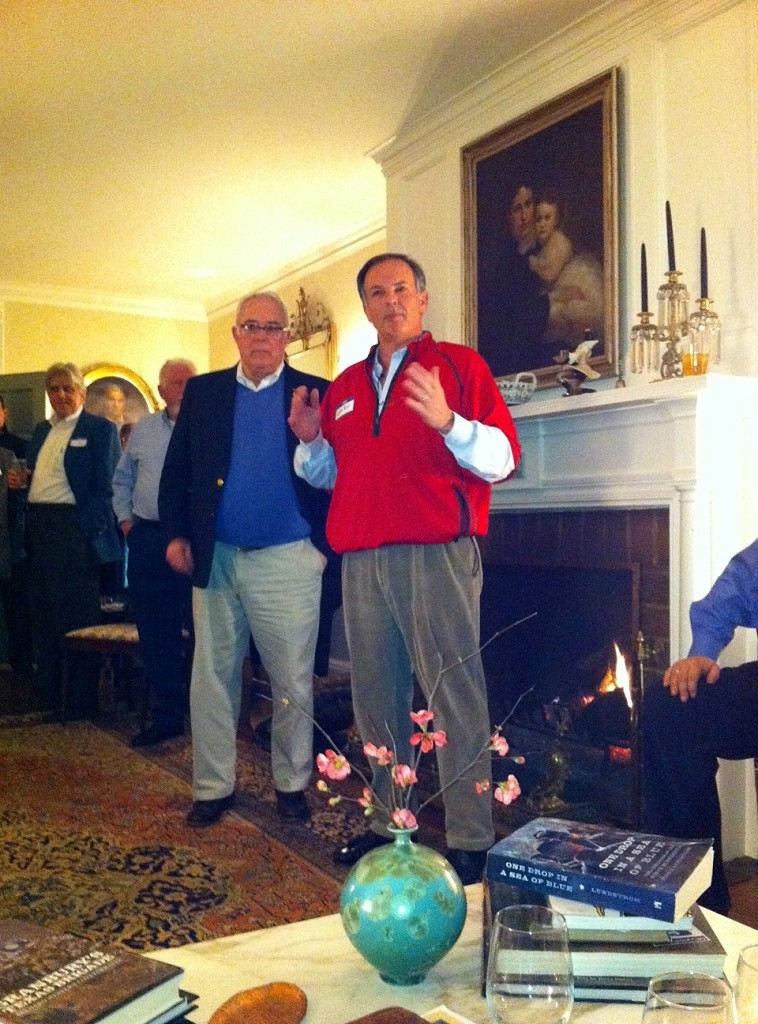
Above, incoming BONPS president John Allyn, left, and former
president Jim Kay speak at the group’s Annual Meeting
Philip’s energetic presidency included a wide array of activities sponsored by BONPS, ranging from historical lectures at Belmont Mansion to the Civil War play “The Andersonville Trial” at the Downtown Presbyterian Church. On the preservation front, he continued the Board’s drive toward locating and putting strategies in place to acquire additional pieces of the battlefield and maintaining those which are already owned by BONPS. He also pushed for reactivation of the website and methods for honoring descendants of the battle’s soldiers including the 2012 December 16 Shy’s Hill Memorial wreath-laying event.
In his opening comments, Jim Kay recognized these accomplishments and thanked Phil on behalf of the Board and the membership. He gave a brief status report on the continued growth of BONPS, which is now in possession of preserved Land-Trust protected battlefield sites valued at more than $1 million, carries no debt, has established an email mailing list of more than 1,000 names, and continues to expand its website which, since its reconstruction in March of 2011, has logged more than 160,000 hits and is being developed into a key resource on all aspects of the battle.
As a non-profit historical organization, however, BONPS continues to need and seek private contributions to enable it to preserve and maintain what remains of the battlefield. In that regard, Jim pointed out that BONPS owns a large inventory of books and DVDs which it sells on the website, the profits of which are used for battlefield upkeep and acquisition expenses. In addition, donations can be made by using the PayPal button on the website.
To commemorate Philip’s two-year service, the Board presented him with an original collector’s edition of The Twelve Decisive Battles of the War by William Swinton. The colorful author was a war correspondent for the New York Times who was known for aggressively pursuing his stories on the front lines — a tendency which almost cost him his life. At one point he was accused of eavesdropping on the conversations of Generals Grant and Meade. Grant let him off with a reprimand, but Gen. Burnside, still smarting from a story written by Swinton, pushed for a more ultimate punishment. Grant, thinking Burnside intended to have Swinton shot, expelled him from military access
Using these and other interesting experiences at the front, Swinton penned several books on the War including The Twelve Decisive Battles of the War, which was published in 1867 and was based largely on interviews with the participants, among whom was Union Gen. George Thomas.
In another highlight of the evening, a new collector’s item was made available by BONPS for the first time – ink pens crafted from a branch that fell from The Witness Tree, the large Basket Oak that stands sentinel over the Battle of Nashville Monument on Granny White Pike near the site of the original Confederate breast works on the first day of the battle. The pens sold out quickly but the few remaining will be made available on the BONPS website in the future. For more on the Witness Tree, click here.
The Board also presented BONPS webmaster Tom Lawrence with an autographed copy of Wiley Sword’s Embrace an Angry Wind, which was published in 1992, the same year BONPS came into existence. The book was later published with the title The Confederacy’s Last Hurrah — Spring Hill, Franklin & Nashville.
A 2012 YEAR-END MESSAGE
Philip Duer, Out-going President, Battle of Nashville Preservation Society, Inc.
Dear Membership:
I want to thank each of you for your support, encouragement, help and participation during the last 2 years that I have had the privilege of being president of the Battle of Nashville Preservation Society. As of the end of this year, however, I will be stepping down as President.
It was Doug Jones that encouraged me to join years ago and I want to personally thank him for opening the door to an organization I did not know existed. If you will bear with me, I want to explain what this organization has meant to me and how it transformed my view of the Civil War.
I had always been a history buff, but my interest in the Civil War started Christmas day, 1960. That Christmas morning I received the two volume set, “The American Heritage Picture History of the Civil War”. It was a present from my great uncle. From my parents I got the Marx Centennial Civil War play set. I cannot tell you how many hours I poured over those books and played with those Civil War soldiers, positioning them in imaginary charges and battle lines. I still have the books and I have acquired re-casts of the soldiers, but my play set is long gone. My great uncle, Uncle Phil, for whom I was named was born in Virginia though when I knew him, he lived in Bronxville New York. He was an avid CW buff tracing our CW roots to Col. Aylett of the Army of Northern Virginia. My grandmother Nana’s father was Julius Gordon Miller, a graduate of VMI, the class of 1860. The first duty of that class was to provide security while John Brown was hung. Julius Gordon Miller was in the 5th Virginia Cavalry and later on Fitzhugh Lee’s staff. As a teenager I had been to Appomattox with my father on a sales trip. So, as you can see, my CW roots were deep in Virginia and my CW eye was turned to those eastern campaigns.
Then late in high school, I read for the first time Sam Watkins’s classic. I started to turn toward the western theatre. I read “Company Aytch” over and over. I got my mother to take me to the Battle of Nashville re-enactment during the Centennial at Percy Warner Park watching the battle lines move over the field where the Iroquois steeplechase is run. I remember to this day a bearded Union officer on a white horse with a drawn saber. I have few CW artifacts, mainly bullets but one of my treasured CW items I bought 30+ years ago is a reproduction cavalry guidon which was used during the Centennial re-enactment. I went to the Carter House and pondered those bullet holes in the outbuildings. My mind was turning west but it was 15 miles south of Nashville –from Winstead Hill to the Carter House. Gettysburg and Pickett’s Charge had been replaced by Winstead hill and the Carter House.
What I am trying to say in a windy way is that it was my introduction to this organization, the Battle of Nashville Preservation Society, that opened my eyes fully as to what happened here and how Nashville played such a pivotal part in the Civil War from start to finish. I am hooked. My Civil War mind is now fully focused on Nashville, from Fort Negley to Shy’s Hill, from Traveler’s Rest to Peach Orchard hill, from Granbury’s Lunette to Kelly’s Point. What a great story we have to tell of our city and the role it played. I have many people to thank for that, past presidents and board members, and many of you who I have met and who have contributed to my evolving knowledge. I have met many great people including those members of the NCWRT and FCWRT. I would not have been a member of those organizations had it not been for BONPS. I particularly want to thank my Board members, Jim Kay, John Allyn, Jim Atkinson, Gary Burke, Parke Brown, Tom Lawrence, Sidney McAlister, and Ellen McClanahan. I had a great working Board who each brought diverse skills and ideas to the table and were always there to help. I hope I have added to the foundation of this organization and feel that the next president will have a solid, loyal membership to advance the mission of BONPS as we move toward the 150th anniversary.
Sincerely, Philip W. Duer, Pres. BONPS (2011 – 2012)
In Memorium: John K. Rau
The Battle of Nashville Preservation Society lost a good friend upon the passing of John K. Rau, 66, of Nashville. John’s keen interest in the Civil War and the Battle of Nashville led him to become a supporter of BONPS and to make many friends in the organization. He died on November 26, 2012. Below is his obituary from The Nashville Tennessean:
John Keller Rau, 66 of Nashville, passed away on November 26, 2012. Preceded in death by his parents, E.L.A. and Frances Pangborn Rau, his brother Jim and his son Taylor. Survived by his daughter, Leslie and his son Dan; friend and mother of his children, Lynn Rau; nephew, Patrick Rau; nieces, Kathryn Maskow and Karen Parsons. He was a graduate of Peabody Demonstration School and Florida Southern College, where he was a member of Sigma Alpha Epsilon fraternity. After serving in the Army on the general’s staff in Taegu, Korea, John joined Southern Oil Company, his family’s business. A memorial service will be held on Friday, December 28, 2012, at 3 p.m. at First Presbyterian Church in Nashville. Visitation will be held one hour prior to the service. In lieu of flowers, memorial contributions may be made to Mission Scholarships at First Presbyterian Church.
July, 2012
Military Model Show
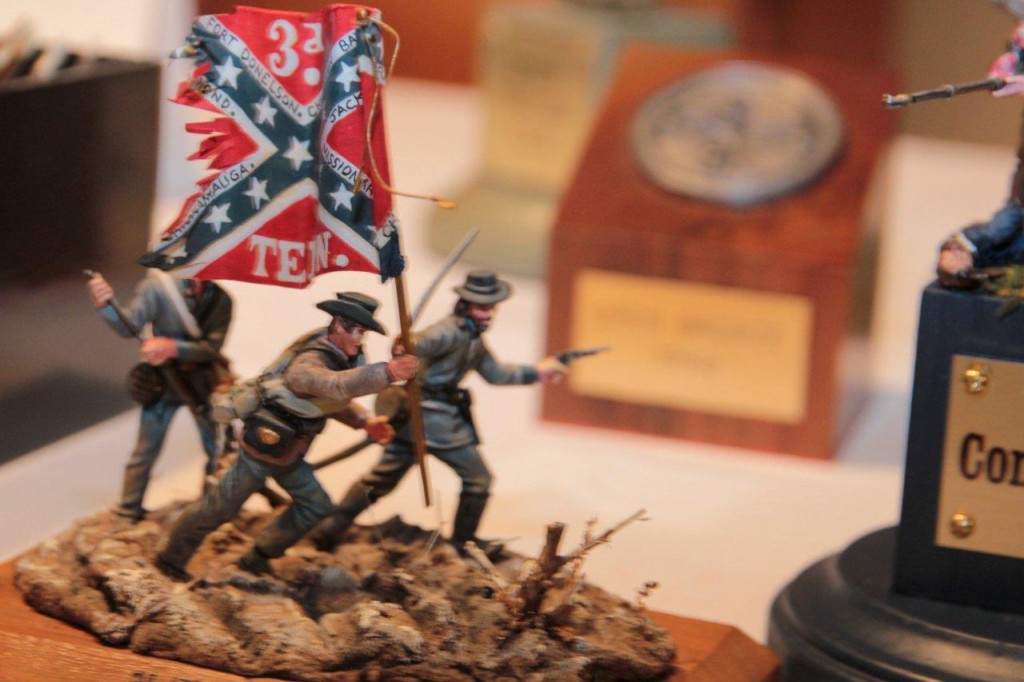
Third Tennessee Volunteers charging, by Philip Duer
On July 28, 2012, The Battle of Nashville Preservation Society sponsored the Civil War, Model and Toy Soldier Show at Travellers Rest Plantation and Museum. The show featured intricate hand-made models of not only Civil War soldiers and equipment, but also World War II and other era soldiers, ordnance, armor, weapons and vehicles.
Philip Duer, president of BONPS, stated that the organization expects to put the Show on again next year as news of its success spreads. Those in attendance marveled at the precise detailed work in miniature by model builders Todd Jackson, Roger Tenney, Carter Todd, Jamison Gorrell, Al Gaiser, and Phil Duer.
For a look at more of the excellent artistry and craftmanship on display at the show, see the photographs by Nashvillian David Raybin at this link.
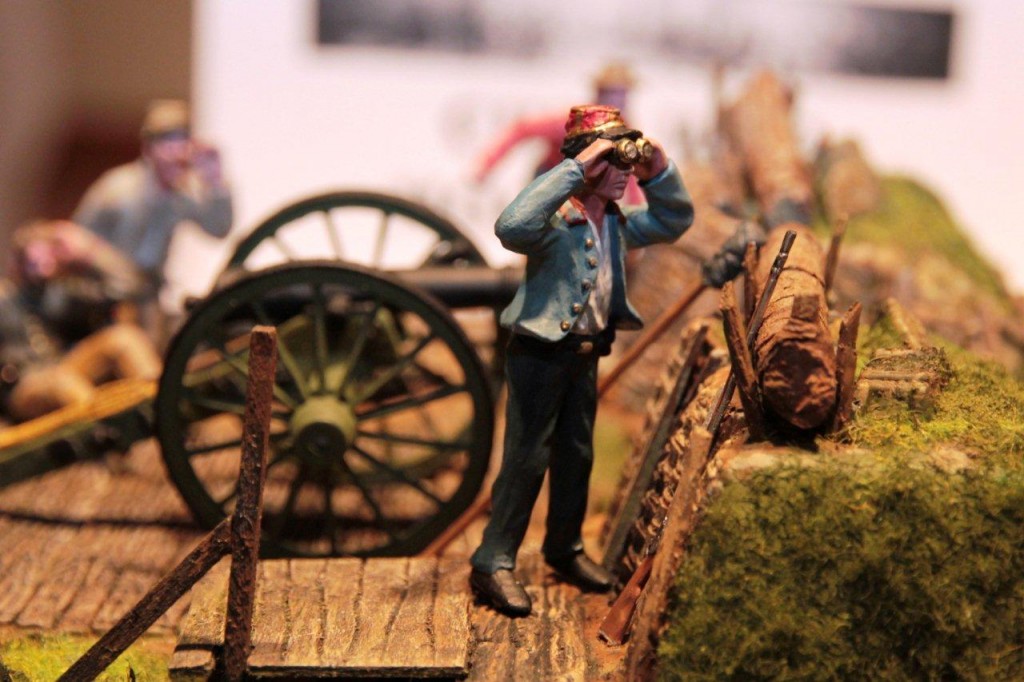
Confederate officer with binoculars on redoubt, by Philip Duer
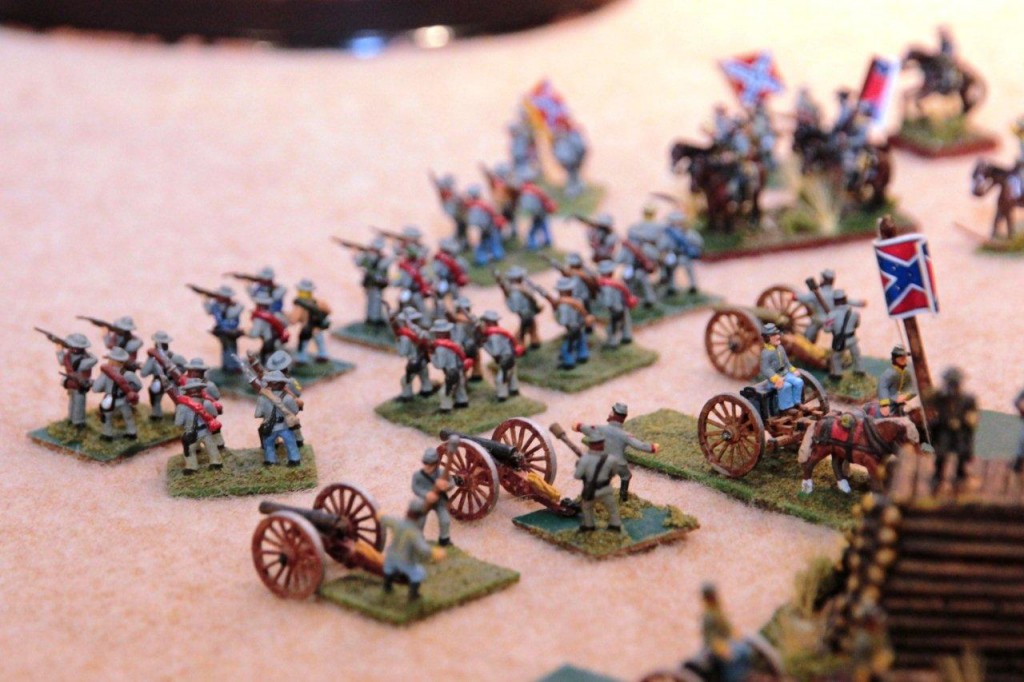
Miniature Civil War infantry and artillery, by Roger Tenney
July, 2012
In Memoriam: David R. Logsdon
 David Logsdon was the author of a series of “eyewitness” books, including Eyewitnesses at The Battle of Nashville, and was a special friends of BONPS. He will be missed by BONPS and all who seek to understand the personal stories of those who fought in the Civil War. Below is a portion of his obituary which appeared in The Nashville Tennessean:
David Logsdon was the author of a series of “eyewitness” books, including Eyewitnesses at The Battle of Nashville, and was a special friends of BONPS. He will be missed by BONPS and all who seek to understand the personal stories of those who fought in the Civil War. Below is a portion of his obituary which appeared in The Nashville Tennessean:
David Russell LOGSDON. Age 67 of Little Lot, TN, died Saturday, July 14, 2012 at St. Thomas Hospital after a short-term illness. He was a Columbia native, a former editor of The Daily Herald in Columbia, TN and a retiree of The Tennessean. In recent years, he began a company, Kettle Mills Press, under which he published a series of books featuring first person accounts of the Civil War. He received a Bronze Star for serving under combat conditions in Vietnam during his September 1967 to June 1969 enlistment as an Artillery Sergeant in the U. S. Army. He was a May 1975 graduate of the University of Alabama, and was a high school teacher in both Huntsville, AL and Centerville, TN. His newspaper work began in March 1978 as a reporter for the Huntsville News in Alabama. In 1980, he became news editor of The Mt. Pleasant Record in Maury County and in 1984, became city editor for The Daily Herald in Columbia. Shortly afterward, he became editor of The Herald. In February 1987, he went to work for the Nashville Banner. After the Banner closed in 1998, he spent a short stint as a public affairs officer for FEMA’s Disaster Services before joining the staff of The Tennessean. He retired in May 2011. … Memorials may be made to Old Well Cemetery Fund, c/o Clyde Farris, 1204 WKRM Lane, Columbia, TN 38401.
May 1, 2012
British Visit Middle Tennessee Civil War Sites
The Battle of Nashville Preservation Society and Travellers Rest co-hosted six members of the American Civil War Round Table UK (ACWRT-UK)on May 1, 2012, as part of the British trip to Middle Tennessee for the Civil War Sesquicentennial.
The ACWRT-UK was one of the first “round table” organizations begun in the 1950s to study the American Civil War. Its members have made numerous trips to various Civil War locations in the U.S., including previous trips to Tennessee.
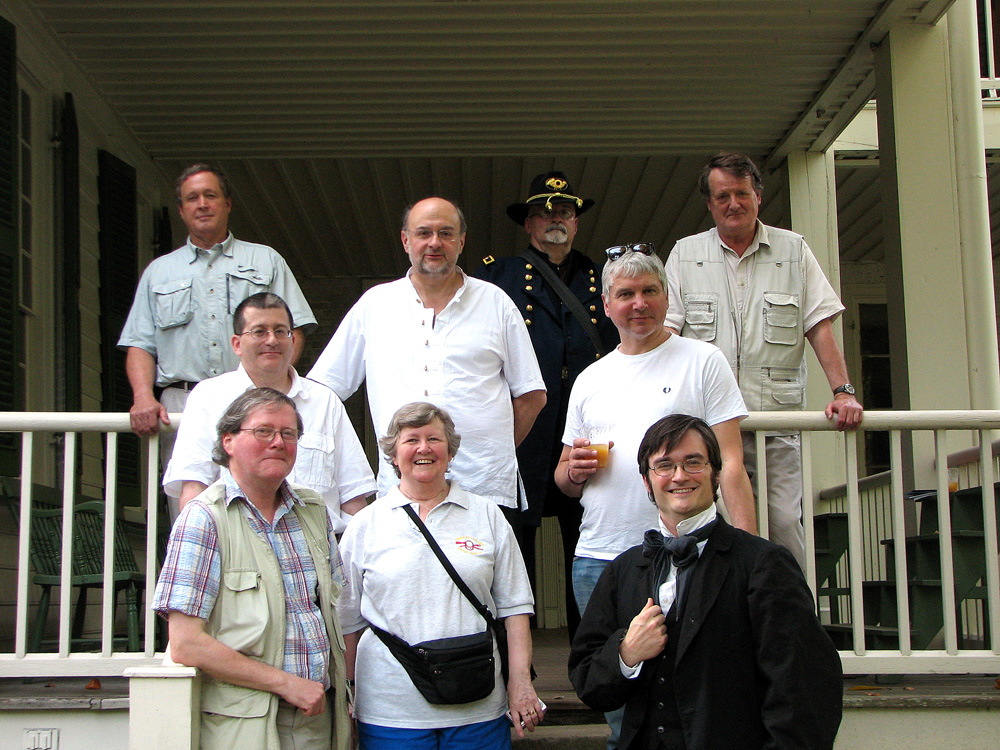 Pictured above: Front Row: John Murray, Marjorie Ward, Brian Allison of TR; Second Row: Nigel Butler, Keith Bright, Paul Sims; Third Row: Philip Duer, Roger Tenney, Peter Gasgoyne-Lockwood
Pictured above: Front Row: John Murray, Marjorie Ward, Brian Allison of TR; Second Row: Nigel Butler, Keith Bright, Paul Sims; Third Row: Philip Duer, Roger Tenney, Peter Gasgoyne-Lockwood
The group’s 10-day Civil War tour began for the six Brits with a two-day stay in Nashville, after which they were treated to a reception on the veranda of Travellers Rest, the famed 1799 manse of Judge John Overton, as the guests of the TR staff and BONPS. Brian Allison of TR led the group through a fact-packed tour of the house, recounting the stories of the famed mansion that occurred during the battle ofNashville. Reminding them that this was the HQ of Confederate Gen. John Bell Hood, he pointed out the rooms in which the Confederate officers planned the battle, and where they slept and ate, in the run-up to the December 15-16, 1864 battle.
The tour group was led by Peter Gasgoyne-Lockwood, a former president of ACWRT-UK and operator of Old County Military History Tours, Inc. Their CW tour will end in Atlanta on May 10, covering a wide variety of CW battlefields such as Ft. Donelson, Shiloh, Chickamauga and Kennesaw. The 2012 tour schedule also includes Texas & the Alamo, Custer & the Little Big Horn, and The First & Second World Wars. Mr. Lockwood is also personally interested in saving what remains of the American 8th AAF WWII airfields in East Anglia; the Friends of Rougham Airfield have already restored an 8th Air Force control Tower at Rougham and turned it into a museum. For contributions, contact www.rougham.org.
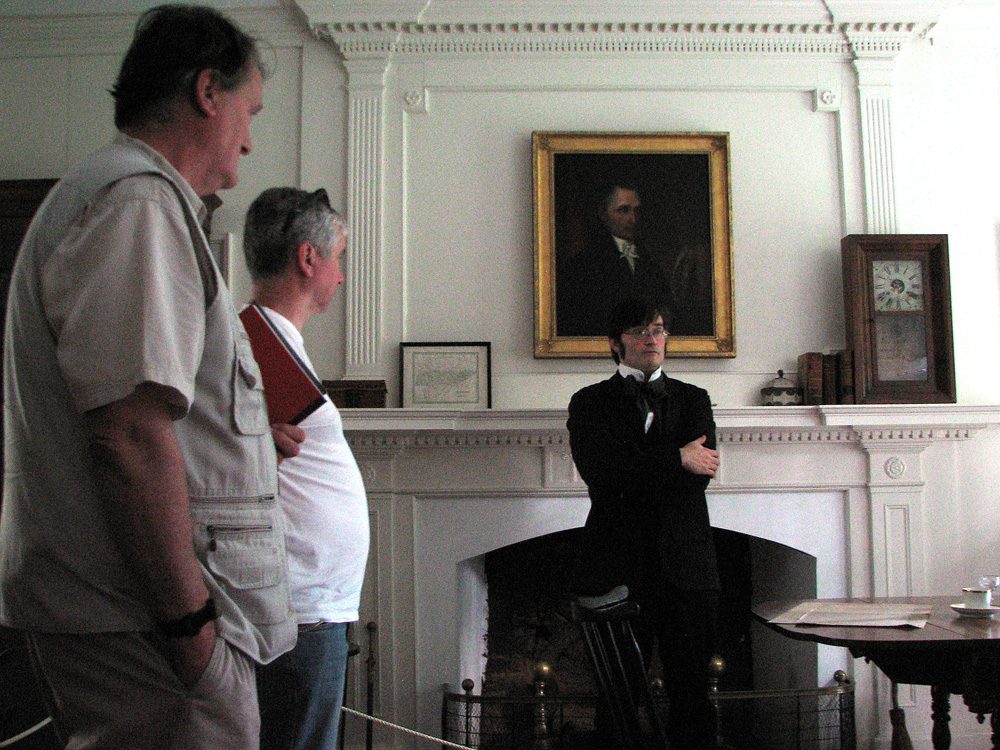 Above: Brian Allison of Travellers Rest explains events surrounding the Battle of Nashville to British visitors
Above: Brian Allison of Travellers Rest explains events surrounding the Battle of Nashville to British visitors
In attendance from their various locations in England were tour leader Peter Gasgoyne-Lockwood of Old Country Military & History Tours Inc.; John Murray; Marjorie Ward; Paul Sims; Keith Bright; and Nigel Butler.
On hand to greet the visitors were Philip Duer, president of BONPS, along with many members of the BONPS board of directors, and Mary Kerr, executive director of Travellers Rest, along with other TR staff and board member Fred Crown.
ACWRT-UK was created in recognition of the British involvement in the American Civil War, in which both the North and South sought support from Great Britain. According to the group’s website, the War resulted in both intense interest and division in England and the islands because on the one hand, the country was opposed to slavery, and on the other, it had a keen interest in the cotton industry which required slave labor. For more on the UK Round Table, visit their website.
December 10, 2011
Shy’s Hill: A History Walk With The Mayor
A throng of history-loving Nashvillians hiked to the summit of Shy’s Hill with Nashville Mayor Karl Dean on Saturday, December 10, 2011, as part of the Sesquicentennial commemoration of the Civil War. The hike occurred just days before the 147th anniversary of the vicious fighting that occurred on the hilltop and its surrounding area on the afternoon of December 16, 1864. At the summit, Battle of Nashville expert Jim Kay, past-president of BONPS, described the historic battle and its place in Nashville, Tennessee, and American history. [Photos by Elaine Kay]
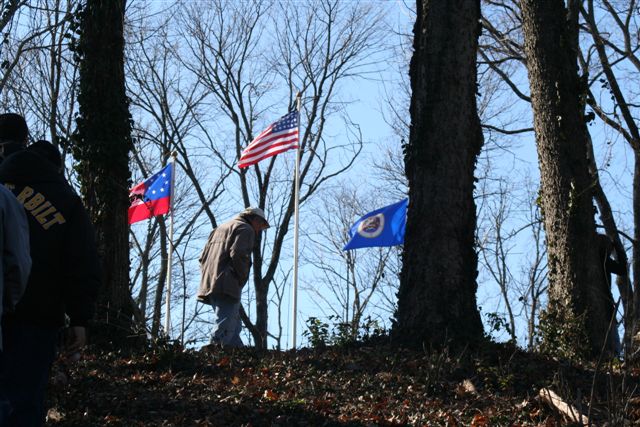
Hikers join Mayor Dean in his “history walk” to the summit of Shy’ Hill, under the shadow of the site’s commemorative flags and a brilliant blue sky.
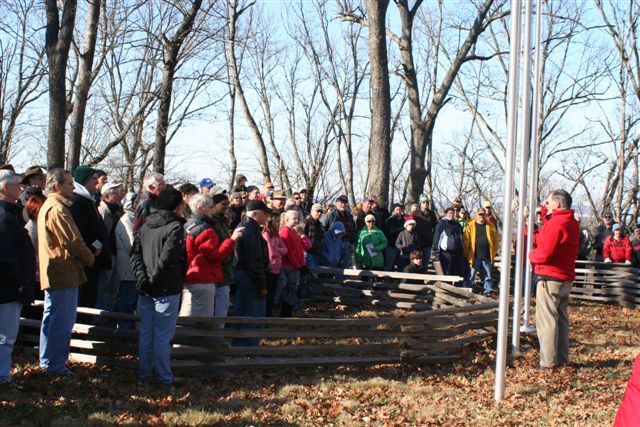
BONPS battle expert Jim Kay explains Shy’s Hill’s significance in the battle of Nashville and its place in history
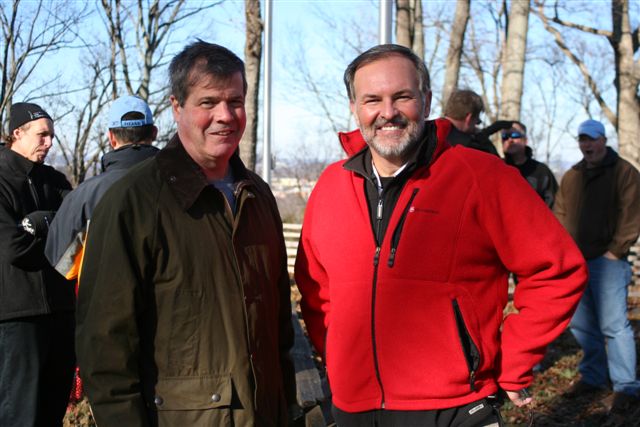
Mayor Dean and past BONPS president Jim Kay commemorating the history of Shy’s Hill, the summit of which was preserved by and is owned by the Battle of Nashville Preservation Society
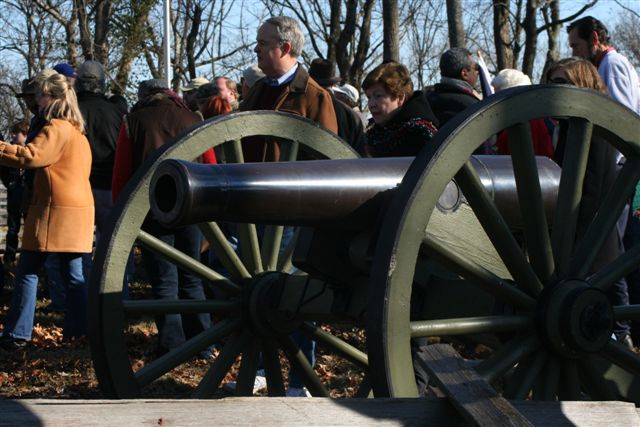
Visitors congregate around a replica of one of the Napoleon field guns purchased and installed by BONPS on the Shy’s Hill Summit
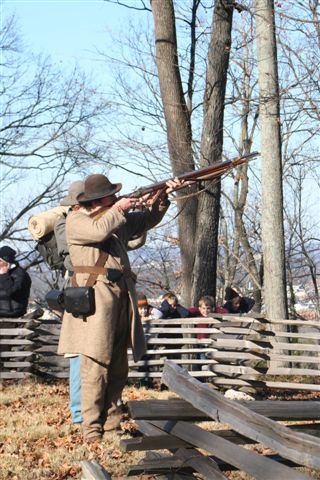
The loud report from the commemorative firing of this rifle as part of the Mayor’s Day ceremony would have been magnified by the thousands at the height of battle on December 16, 1864
November 11 – 12, 2011
“The War Comes to Tennessee” — A Sesqui-Symposium
The Battle of Nashville Preservation Society (BONPS) joined with Belmont Mansion and the Lotz House to bring a significant Sesquicentennial symposium on the Civil War in Middle Tennessee on November 11 and 12 to further commemorate and explore the 150th anniversary of the start of the War.
The symposium began with an opening night reception at the Lotz House in Franklin, Tennessee on Friday, November 11, 2011. Attendees were led on a fact-filled and inspiring tour the historic Lotz House Museum by its director and former BONPS president, J.T. Thompson.
The formal Symposium kicked off the following morning at Belmont Mansion at 8:00 a.m. Six guest speakers focused on unique perspectives regarding the Battle of Nashville, Ft. Donelson and Shiloh. The event was moderated by Thomas Flagel, assistant professor of American History at Columbia State Community College. Panelists included:
- Thomas Cartwright – Franklin-based historian, one of the nation’s leading authorities on the Battle of Franklin
- Tim Johnson, professor of history at David Lipscomb University, who has appeared on the History Channel,C-SPAN and NPT.
- Carole Bucy, professor of History at Vol State Community College and the newly appointed Metro Historian.
- James McDonough, noted author of Five Tragic Hours and Nashville: The Western Confederacy’s Final Gamble.
- Doug Richardson, Park Ranger and Chief of Interpretation at Fort Donelson.
- Dr. Bobby Lovett, long-time professor of History at Tennessee State University and authored several books on African American history, most notably “African American History of Nashville, Tennessee, 1780-1930.”
Ancestor Videos. In a unique feature of the Symposium, guests were able to videotape their personal stories of ancestors who fought in the Civil War. Click on the link below to access the videos from the Lotz House website
http://www.youtube.com/user/LotzHouseVideos?feature=watch
September 24, 2011
“Living History & Skirmish” At Fort Negley Visitors Center
Friends of Fort Negley hosted its annual “Living History & Skirmish” on Saturday, September 24, 2011. More than 400 visitors attended and were treated to reenactors displaying campsites, fighting skirmishes, firing cannons and related events. Below are photos including “antique” photos shot by professional photographer Paul Schatzkins of the “1861 Project” and others by Mrs. David M. DuBrucq.
June 17 – 18, 2011
Presentation of “The Andersonville Trial” by The Battle of Nashville Preservation Society, Inc. and Lamplighters Theatre
As part of the Sesquicentennial Commemoration of the Civil War, BONPS and Lamplighters Theatre sponsored three performances on June 17 and 18, 2011, of “The Andersonville Trial,” the time-tested play by Saul Levitt that explores the legal and moral conflict between military orders and human conscience.
Levitt based his play on the official records of the actual trial of Captain Henry Wirz, the commander of the Confederate prison camp at Andersonville, Georgia. During the 14 months of the prison’s operation, more than 40,000 Union prisoners were kept there, and nearly 13,000 died. Clara Barton assisted with the processing and identification of bodies at Andersonville at the end of the war and realized the need for an organization to assist in cases of dire need. She founded the American Red Cross as a result 16 years later.
The play dramatizes the Union court martial of Capt. Wirz, presided over by Gen. Lew Wallace, who later became famous as the author of the novel Ben Hur.Captain Wirz was the only officer, North or South, tried and convicted for war crimes during the Civil War. He was sentenced to death by hanging.
As audiences arrived at the church, they were treated to performances of original period 19th Century music written by numerous Nashville songwriters as part of the 1961 Project. For more information, see http://1861project.com/, and to sample the music, go to http://www.youtube.com/watch?v=rl8yyfZNh0U&feature=player_embedded#at=76.
In addition, preliminary remarks giving perspective to Civil War POW camps, including Andersonville, were made by historian and author Thomas R. Flagel.
The performances occurred at the Downtown Presbyterian Church, once the church of Andrew Jackson. The church was present at the corner of 5th and Church Streets during the Union occupation of Nashville. During the war, it was used as a hospital for wounded soldiers and was known as Hospital No. 8 containing 206 beds. For more details of the church’s history, see The Church.
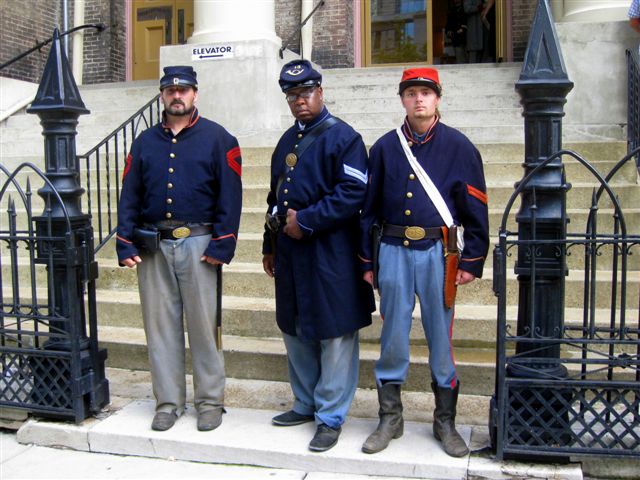
Above, official “guards” included re-enactors Larry Carter, Gary Burke, John Mertz, Richard Baker, Gerald Williams, Roger Tenney
March 26, 2011
BONPS HOSTS ANNUAL BANQUET WITH GUEST SPEAKERS
On the evening of March 26, 2011, BONPS hosted its annual gathering at Travellers Rest, headquarters of Confederate General John Bell Hood during the pivotal Battle of Nashville in 1864. The program was highlighted by two sought-after speakers. Dennis Boggs, a renowned impersonator of President Abraham Lincoln, convincingly brought the President to life from the pages of history as he spoke of the burdensome problems which Lincoln struggled with during the days of secession and its aftermath.
Noted speaker and professor of history Thomas Flagel of Columbia State Community College gave an impassioned overview of the Civil War, using a slide show and shocking statistics to illustrate his explanation of the enormity of the war and its impact on the split country in which it occurred.
TENNESSEE BATTERY FIRES ON FORT SUMTER TO OPEN SESQUICENTENNIAL
A Tennessee Civil War artillery battery was on the firing line in Charleston, SC on April 12, 2011, exactly 150years from the day the Civil War started with the firing of heavy guns on Fort Sumter. B.F. White’s Battery of Tennessee Artillery was the only Tennessee artillery unit present. The Battery’s brass-barrelled 24 pound Howitzer was among 21 guns positioned at the Patriot’s Point location to commemorate the Civil War Sesquicentennial.
At Patriots Point, South Carolina
From 9 April 2011 to 12 April 2011
Tuesday 12 April 2011
The men of White’s Battery were at full strength with 17 men on the field at 4:00 AM in anxious anticipation of the day’s activities. The men let out a mighty cheer as the light at Fort Sumter split to two separate rays. As the dark of night lifted to expose the fort, the men finished preparations and at the command began an artillery assault that continued for 90 minutes firing 28 rounds. Men were swapped out to keep them fresh. The men averaged three minutes and 21 seconds per round sent down range during this time.
A cease fire was called. The men were ordered to begin firing again at 8:00 AM. In the next 15 minutes 4 rounds were sent before a cease fire was called. At 8:30 the men were ordered to begin fire again and 5 rounds were sent before a cease fire was called. A total of 9 rounds were sent during this barrage.
Summary:
The men of White’s Battery considered the event a success with 47 total rounds being fired with no mishaps, misfires or injuries.
December 12, 2009
CANNONADE COMMEMORATES 146th ANNIVERSARY OF BATTLE
On December 12, 2009, BONPS invited a number of Civil War artillery companies to set up their field pieces on the lawn of St. Bartholomew’s Episcopal Church, in the shadow of Shy’s Hill. Nearly a dozen guns were present with full crews of reenactors. The rumble of guns across Green Hills was only a hint of the din of noise and smoke that accompanied the attack here at Shy’s Hill on December 16, 1864. BONPS is greatly appreciative of the St. Bartholomew’s Church and the neighbors who live on this part of the battlefield for permitting this unique rememberance of the Union and Confederate men who fought on this ground 146 years ago.
November 6, 2008
BONPS Presents “The Battle Through Green Hills” to Large Crowd
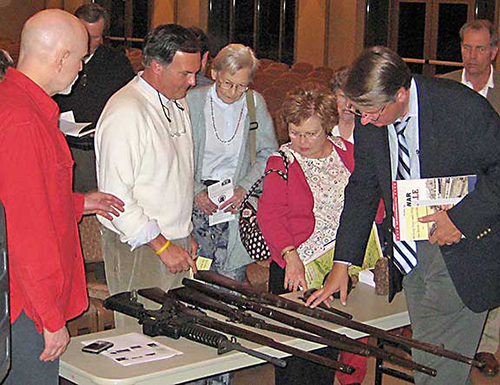
Attendees examine various types of shoulder arms during the BONPS meeting of Nov. 6, 2008 in which Jim Kay and Doug Jones presented the topic “The Battle Through Green Hills” at the Covenant Presbyterian Church. Approximately 135 people attended. The one-hour program, which was free and open to the public, covered the battlefield through present-day Green Hills and Burton Hills as well as the history of the Compton Farm.
Opportunity for Landowners and Conservation Passes Congress
On May 23, 2008, Congress passed legislation to renew the enhanced tax incentives for private landowners conserving their land through conservation easements. The legislation, included in the Farm Bill, provides farmers, historic land owners, wildlife enthusiasts, recreational sportsmen and owners of lands with a variety of other benefits for conserving our state with an opportunity that is set to expire December 31, 2009. This critical achievement would not have been possible without the hard work of The Land Trust Alliance and its coalition colleagues or without the support of Tennessee’s delegation, the majority of whom voted to renew these enhanced deductions. This is a great victory for conservation in our state. We cannot afford to miss this window—so please help spread the word.
For more information please visit The Land Trust for Tennessee’s website at http://www.landtrusttn.org/news_taxbenefits.html or contact The Land Trust at (615) 244-LAND.
BONPS Loses Long-Time Friend and Supporter Devereaux Cannon

It is with great sadness that we announce the passing of Devereaux Cannon, a friend, member, and supporter of BONPS and historic preservation. He passed away suddenly on Dec. 29, 2007.
Services were held Jan. 2, 2008 at St. John Vianney Catholic Church in Gallatin, Tenn. Devereaux was a friend and the creator of the TaxFreeTennessee web site that was so helpful during the State Income Tax protests. He was an extraordinary father to Devereaux III and Katherine, grandfather to Devereaux IV, political activist, historian, prominent Nashville Attorney, and husband to Nora. The picture is Devereaux teaching people about the history of flags. He wrote several books on the subject.
December 16, 2007
Shy’s Hill Ceremony Draws Record Crowd for Two Flags Event

A record crowd attended anniversary ceremonies by the Battle of Nashville Preservation Society atop Shy’s Hill the afternoon of Dec. 16, 2007.
“Two Flags Across Tennessee,” a preservation awareness program of the Tennessee Civil War Preservation Association, were planted on top of Shy’s Hill as the program concludes its journey across the state. The flags are reproductions of the 1861 Stars and Stripes and the 1861 First National Confederate Flag. The flags have traveled to about 40 significant battlefield sites in Tennessee.
It was at Shy’s Hill on the afternoon of Dec. 16, 1864 that Union troops broke the Confederate lines, sent Gen. John B. Hood’s troops into retreat, and produced a major victory for US Gen. George Thomas.
Work projects by BONPS to enhance the visitor’s experience at Shy’s Hill continue.
September, 2007
Preservationists Meet in Nashville

Jim and Elaine Kay of BONPS meet with Jody Powell, second from right, a Civil War Preservation Trust Board Member, and author/historian Frank O’Reilly at the Powell Farm in Maryland in September 2007. Mr. Powell served as the White House Press Secretary during the Carter Administration. CWPT is America’s largest non-profit organization (501-C3) devoted to the preservation of our nation’s endangered Civil War battlefields.
Fort Negley Visitors Center Nears Public Opening

Above: Attending the advanced opening of the new Fort Negley Visitors Center are, left to right, BONPS President Jim Kay, museum curator, historian and author Jim Hoobler, and Mayor Bill Purcell. The fort itself opened to the public for the first time in 60 years in November 2004.
Metro Parks offered residents a sneak peak of the new Visitors Center at Fort Negley, before its official opening.
The tour offered visitors a chance to preview the 4,605-square-foot facility, which includes a small multipurpose theater, exhibit space, meeting room, staff space and outdoor plaza.
The $1 million upgrades complete phase two of the project. Metro Parks is partnering with Traveller’s Rest Plantation and Museum to create educational opportunities and programs for group tours, as well. The Fort Negley Center will feature exhibits, monthly activities, monthly events and self-guided tours.
The exhibit gallery will include touch-screen displays and other interactive elements that tell the story of Fort Negley and the Civil War in Nashville. Topics addressed will include the War in the West, Armies of Invasion, Fighting for Freedom and Occupied Nashville. To commemorate the event, outgoing mayor Bill Purcell sealed a time capsule containing items such as copies of news publications, photographs of Nashville and a list of political personnel. The items in the capsule will remain encapsulated until the 200th anniversary of the Battle of Nashville, December 2064.
May, 2007
BONPS Loses Good Friend And Supporter Bob Brown

BONPS advisory board member, Bob Brown, died Sunday after a long fight with cancer. He loved our group and Shys Hill. We will miss him.–BONPS President James Kay
Statement from Ann Toplovich, Executive Director, Tennessee Historical Society:
Bob Brown, a retired banker and Nashvillian, played a key role in the preservation of Tennessee wildlands and was a co-founder of the Tennessee Trails Association. He was also a lay historian with a particular interest in the Civil War and the roads of early frontier Tennessee. Mr. Brown served on the boards of the Tennessee Parks and Greenways Foundation, the state chapter of the Nature Conservancy, and the Metro Greenways Commission. Bob was also a major supporter of the Battle of Nashville Preservation Society and the Tennessee Historical Society. He designed the new trail that now leads to the top of Shy’s Hill, one of the few remaining sites from the Battle of Nashville. A lifelong bachelor, Mr. Brown planned legacy gifts to the organizations to which he had already given so much. He will be missed by many devoted friends.
The following article appeared in the Nashville Tennessean on May 15, 2007:
Bob Brown Was Friend of Nature
By ANNE PAINE
Staff Writer
Bob Brown, remembered as a noble and gentle man who spread his interest in saving natural areas to others, died at his Nashville home Sunday night, May 13, 2007, of cancer at age 77. Brown, who never married, worked before retirement as a trust official at what
was then Third National Bank.
He became best known, however, for his quiet pursuit of protecting the state’s
hills, wildflowers and streams. He is known for that and for his dog Trouble. Trouble, who died in September of cancer, was by his side for 16 years — on hikes and in boardrooms. The pair, icons in the local conservation movement, received the “Best Friend” award last year from the Friends of Warner Parks.
“Bob Brown was one of the most noble men I’ve ever known,” said former Gov. Winfield Dunn. “He had an inquiring mind and an appreciation of nature’s gifts to all of us — in the fields and woods and flowers and natural areas. “And he shared it. He took great joy in raising the level of appreciation of other people in this wonderful gift.”
Brown co-founded the Tennessee Trails Association and helped inspire and plan the 300-mile Cumberland Trail that will stretch from the Tennessee River Gorge near Chattanooga to the Kentucky-Virginia border.
An “amateur” botanist who provided Latin names of plants with ease, Brown was honored recently by a 315-acre donation on Brady Mountain in his and a colleague’s name. It is now part of the Cumberland Trail State Park.
“He was an unbelievably good man in so many ways …,” said John Eddie Cain, a friend since first grade at Parmer School. “He was a forerunner on just about every issue you could think of that’s really worthwhile.”
Boards on which he served included those of the Tennessee Parks and Greenways Foundation, the Tennessee Chapter of the Nature Conservancy and the Metro Greenways Commission. Tennessee Environment and Conservation Deputy Commissioner Paul Sloan described him as “soft spoken, always courteous, always curious to learn more.”
He was a “virtual encyclopedia” of the state’s trails and historical and natural features, Sloan said. “Bob wasn’t a member of a political party,” he said. “He never wavered from just a straight, honest love for conservation and he understood how important it was and gave his whole life for it.”
April, 2007
Annual Park Day Volunteers Enhance Shy’s Hill Summit, Walking Trail
By Lacy Broemel
On Saturday, April 7, 2007 many dedicated preservers of Shy’s Hill turned out to clear brush and improve the trail. This important battle site, the place where the Union troops broke through the Confederate line on December 16, 1864, is being preserved by a group of Battle of Nashville enthusiasts, the Battle of Nashville Preservation Society. This local group carried out “Park Day,” a national day of cleaning and restoring battlefields, in our community.
The summit of Shy’s Hill has previously been cleared, except for five large brush piles on the top. Starting at 8 a.m. Saturday morning, a group began to clear these piles and bring them to the side of the hill, creating a screen from the neighbors. The group successfully cleared three of the piles from the summit in four hours.
While one group was clearing brush, another group was improving the trail to the summit. A visible trail has already been made, but Mr. Bob Slaydon, a pioneer in making trails, led a group in flattening and improving the trail. These workers dug out roots and made the trail easier to walk on.
Prior to this workday, two supporters, The Parke Company and Vermeer, donated equipment to help this day go more smoothly.
Shy’s Hill, a key battlefield in the Battle of Nashville, is alive and well, thanks to dedicated workers. Improving the site is no easy job, but on Saturday everyone at the site felt the importance of the job at hand. All the workers made a huge improvement on the hill, clearing brush from the top and making the trail more accessible.
Plans for Fort Negley Visitors Center proceed
Waiting for Sounds, Metro proceeds with Fort Negley
By Bill Harless,
Nashville City Paper,
bharless@nashvillecitypaper.com
March 13, 2007
Despite some fretting in the city over the future of the proposed Nashville Sounds ballpark downtown, Metro is proceeding with plans to build a visitors center for the Fort Negley park atop a portion of Greer Stadium’s parking lot.
The Sounds play at Greer Stadium and have said they hope to open their new ballpark in time for the 2009 baseball season.
Metro Parks Department spokeswoman Jackie Jones said Tuesday that construction of the $2 million, 4,500-square-foot visitors center will likely begin in early spring and said the center is scheduled to open in September.
“I think the Parks Department will compensate for any impact it has on the parking,” said Metro Finance Director David Manning when asked what Metro would do with the visitors center if the new Sounds stadium does not materialize. Manning noted that construction of the center would not affect the stadium itself in any way. “I’m sure that in a construction situation, they will provide a reasonable solution for the Sounds to the extent that there’s any kind of overlap there.”
“… It’s something that will continue even if the Sounds do stay at Greer Stadium,” said Molly Sudderth, Mayor Bill Purcell’s spokeswoman, when asked the same question.
Jones said design of the visitors center, by Buchart-Horn, Inc, is complete. Meanwhile, the construction contract for the center was awarded in November to the Powell Building Group of Goodlettsville, according to Metro. The contract calls for the building to include exhibit space, a small theater, a meeting room, public restrooms and an outdoor plaza.
Metro in 2003, under Purcell’s leadership, undertook a $2 million preservation-restoration effort to re-open Fort Negley Park, the site of what was the largest inland stone fortification built during the Civil War. The park, opening in 2004, had been closed for 60 years. It sits between Greer Stadium and the Adventure Science Center.
The Sounds and Baltimore Developer Struever Bros., Eccles & Rouse have until mid-April to complete financing and design work for the new downtown ballpark and also the $200 million retail-hotel-office-residential development that would surround it, and they must submit any proposed amendments to their agreement with the city for developing the site — between the Gateway and Shelby Street bridges — to the Metro Council office by March 23.
BONPS co-hosts successful symposium on Civil War cavalry

The featured speakers for the symposium were, left to right, Eric J. Wittenburg, Brian Steel Wills, Myers Brown, and Greg Biggs.
Approximately 50 Civil War cavalry enthusiasts attended the Third Annual Civil War Symposium, Sat., March 10, 2007, at Travellers Rest Plantation and Museum, co-hosted by BONPS and the Tennessee Civil War National Heritage Area. In addition to tours of the Travellers Rest property and lively panel discussions, the four main speakers at the symposium were:
- Myers Brown, a curator at the Tennessee State Museum, who spoke on Fightin’ Joe Wheeler, one of the major cavalry leaders in the Western Theater. A diminutive man, Wheeler performed in a variety of roles associated with the Army of Tennessee. Mr. Brown was well informed on Gen. Wheeler, being the former curator of Pond Spring, the Wheeler home in northern Alabama. Wheeler, who also fought in the Spanish-American War, is the only former Confederate general buried at Arlington Naitonal Cemetery. Mr. Brown also displayed an exhibit, “Hoofbeats in the Heartland: Civil War Cavalry in Tennessee,” which is a traveling exhibition of the State Museum.
- Brian Steel Wills spoke on the exploits of famed cavalry leader Gen. Nathan Bedford Forrest, having written one of the best biographies of the controversial general. Professor Wills teaches history at the University of Virginia’s College at Wise. Forrest was a fearless warrior who personally killed 30 of the enemy but he was also satisfied with bloodless victories. He liked to win. He was also an expert at psychological warfare, a master at getting his enemies to doubt themselves. Forrest admitted defeat only once, to Gen. James H. Wilson at Selma, Ala. in April 1865, and stated that he was afraid of only one man–his brother William.
- Greg Biggs, the founder and president of the Clarksville Civil War Roundtable, spoke on the Union cavalry action at Shelbyville, Tenn. during the Tullahoma Campaign of Summer 1863. In about ten days of rainy weather and miserable mud, making full use of his cavalry, Union Gen. W.S. Rosecrans drove the Confederate Army of Tennessee from Middle Tennessee. The U.S. suffered only 569 casualties while capturing 1,600 Confederates. The first use of lightning cavalry was at Hoover’s Gap by Col. John Wilder’s mounted infantry armed with Spencer repeating rifles. Lincoln praised the campaign as one of the most successful strategic operations of the war but the campaign received little recognition, coming at the same time as Union victories at Vicksburg and Gettysburg and involving relatively little bloodshed.
- Eric Wittenburg of Columbus, Ohio, an attorney, publisher, and author of 13 books on Civil War cavalry, talked about a variety of Civil War cavalry commanders, many of whom served poorly in the East and were transferred to the West. He noted that JEB Stuart, for all his performances, represented the cavalry of the past using Napoleanic tactics, while Gen. James H. Wilson, US cavalry leader at the Battle of Nashville, represented the future of cavalry. Bested by Forrest at Spring Hill and the Nashville retreat, Wilson led his troopers in the spring of 1865 on a highly successful cavalry raid through Alabama and Georgia, overrunning Forrest’s men at Selma and nearly capturing their leader.
BONPS Banquet guests hear Hicks speak on Widow of the South;
J.T. Thompson hands gavel to incoming president James Kay

Robert Hicks, author of the best-selling historical novel Widow of the South, autographed his book for attendees at the Battle of Nashville Preservation Society’s Annual Banquet held Feb. 8, 2007 at the Travellers Rest auditorium.
Battle of Nashville Monument Vandalized; Reward Offered for Information
The Tennessean; Tuesday, 12/12/06
Vandals deface Civil War statue
Police suspect teens did graffiti
By KEVIN WALTERS
Staff Writer
Vandals struck the city’s Battle of Nashville statue during the weekend, splashing graffiti on three sides of its base.
The spray-painted symbols were first found on the Civil War memorial Sunday morning. Other graffiti was discovered on a concrete wall near Granny White Pike as well. The granite obelisk, which features a bronze statue depicting a young man as the “Spirit of Unity” flanked by two horses representing the North and the South, stands along Granny White Pike near Battlefield Drive.
Metro police believe the vandalism is the handiwork of local teenagers and not organized gangs, said Don Aaron, Metro police spokesman. They have no suspects. There are teens that are known to hang out in that area and at the park,” Aaron said.
Perhaps coincidentally, the defacement comes on the week marking the 142nd anniversary of the Battle of Nashville, which was fought Dec. 15-16, 1864. “I will personally offer a $1,000 reward for information leading to the arrest and conviction of these thugs,” said Jim Kay, president elect of the private nonprofit Battle of Nashville Preservation Society Inc.
He said he was “disgusted” by the damage to a statue that is considered among the first in the nation to commemorate the unity of the country in the wake of the Civil War. Nashville preservationists worked for years to raise money for the statue’s 1999 rededication.
The statue was created by Italian master sculptor Giuseppe Moretti, who also cast the city of Birmingham’s Vulcan statue, and was dedicated on Armistice Day, 1927. Its base and the angel atop the obelisk were replaced after a tornado destroyed them in 1974. The statue was later relocated from Franklin Road to its current site.
“It’s a monument to preserve the memory of the men who fought and died at the Battle of Nashville,” said Wes Shofner, a Battle of Nashville Preservation Society board member. “The entire city should be incensed.” Spray-painted graffiti has previously been removed from the statue, which is owned by the state Historical Commission, said Richard Tune, acting executive director.
Battle at Barricade Program Attracts Overflow Crowd

BONPS Vice-President Jim Kay presented a program on The Battle at the Barricade at the October 19th BONPS meeting at Richland Country Club which attracted a large crowd of 125 attendees. The battle occurred Dec. 16, 1864 on Granny White Pike near the present-day site of Richland C.C. between Union and Confederate cavalry forces. The delaying action by Col. Rucker’s men quite possibly saved Gen. John Bell Hood’s Army of Tennessee from complete destruction.
Mr. Kay also discussed the early history of the area around Granny White Pike and the adventures of Lucinda “Lucy” White, the brave pioneer woman who operated a traveler’s inn on the site and for whom the pike is named.
__________________________________________________________________
Donelson 2012 Review
The Clarksville Leaf Chronicle reviews the Battle of Fort Donelson with Sesquicentennial story and photo essay. Click here.
_______________________________________
The Fall of Fort Donelson
“You cannot overstate the advantage the Union gained with the capture of Nashville,” said James Jobe, Park Historian at Fort Donelson National Battlefield.
And the Confederate defeat at Fort Donelson in February 1862, along with the fall of Forts Heiman and Henry, led directly to the surrender of Tennessee’s capital city.
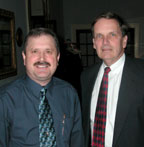
James Jobe, left, Park Historian at Fort Donelson National Battlefield, spoke about the fall of the river fort and the subsequent capture of Nashville. He is pictured with BONPS President Doug Jones.
The Federal authorities then used Nashville as the major supply center in the Western Theater, supporting invasions against Chattanooga in 1863 and Atlanta in 1864. Jobe spoke to the BONPS membership and public January 15th at historic Belmont Mansion in the first of many special events planned this year, the 140th anniversary of the Battle of Nashville.
At the beginning of the war, Tennessee faced the daunting task of defending its lengthy east-west border. The Confederacy placed more emphasis on holding and defending Bowling Green, Ky. and the Mississippi River than it did in defending the Tennessee and Cumberland rivers.
The first fort to fall was Fort Henry on the east bank of the Tennessee River, just south of the Kentucky border. The fort had been poorly situated, and was partially flooded when the Union gunboats approached on Feb. 6 and opened fire at nearly point-blank range. By the time the Union army arrived at the scene, Fort Henry had been captured, along with its commander.
The Confederates had built a fort on the west bank of the Tennessee River called Fort Heiman, directly across from Fort Henry, but apparently no big guns had been positioned there and the fort served little use.
Men fleeing from Fort Henry, along with reinforcements, had swelled the Confederate forces at nearby Fort Donelson from 3,000 to approximately 15,000 men.
On Feb. 14th, Valentine’s Day, the Union gunboat flotilla, now on the Cumberland River, approached to within 400 yards of Fort Donelson’s river batteries. Flag-Officer Andrew Foote believed that victory would come as easily as at Fort Henry. He was wrong. The Confederate gunners, firing from a lofty elevation, severely damaged many of the gunboats, which were forced to withdraw.
The next day, however, a breakdown in the Confederate high command led to the failure of an attempt to break out of the encircling Union forces, which now numbered about 27,000 men. A little-known Confederate colonel, Nathan Bedford Forrest, did manage to escape and lead his men to Nashville.
Gens. Floyd and Pillow fled the scene, and it was left to Gen. Simon B. Buckner to surrender Fort Donelson to Gen. U.S. Grant, who demanded “unconditional surrender.”
Grant was promoted to a two-star general and became a hero in the North. Thousands of Confederate soldiers became prisoners of war and were transported by river to Northern POW camps. Later in the year, most were “paroled” in exchange for Union prisoners.
The fall of Fort Donelson threw Nashville officials and citizens into a panic, fearing the destruction of the Union ironclad gunboats. Fort Zollicoffer, located west of Nashville on the Cumberland River, was abandoned and did not contest the gunboats. Within ten days, Union troops entered the city and held it for the remainder of the war.
The river batteries at Fort Donelson National Battlefield (931-232-5706), and many of the large cannons, can be seen today by visitors to the park, located near Dover, Tenn. The location of Fort Henry now lies beneath the waters of Kentucky Lake (Tennessee River).
